This time last week we were still reeling from the excitement and stimulation of the first Beth Chatto Symposium. Originally intended to celebrate Beth’s 95th birthday this year, following her death in May the event became both a memorial to her and a celebration of her influence on a generation of gardeners, designers and nurseries, both here and overseas.
The symposium was the idea of Amy Sanderson, a Canadian gardener and florist who has spent some time working at the Beth Chatto Gardens in recent years, and was organised by Amy, Garden and Nursery Director, Dave Ward and Head Gardener, Åsa Gregers-Warg. When the symposium was announced early this year they anticipated in the region of 150 attendees, and so were thrilled when over 500 people from 26 countries bought tickets. Åsa told me that they could have sold many more.
The theme of the symposium was Ecological Planting in the 21st Century, and the line-up of international speakers included gardeners, garden designers, academics, nursery-people and growers, all with their own take on the subject, although a number of key themes became apparent over the two days. The talks were recorded and will be posted on the symposium website as soon as they have been edited.
In the main image above are, from left to right, James Hitchmough, Dave Ward, Taylor Johnston, Olivier Filippi, Marina Christopher, Peter Janke, Dan Pearson, Midori Shintani, Keith Wiley, Andi Pettis, Peter Korn, Åsa Gregers-Warg, Cassian Schmidt and Amy Sanderson.
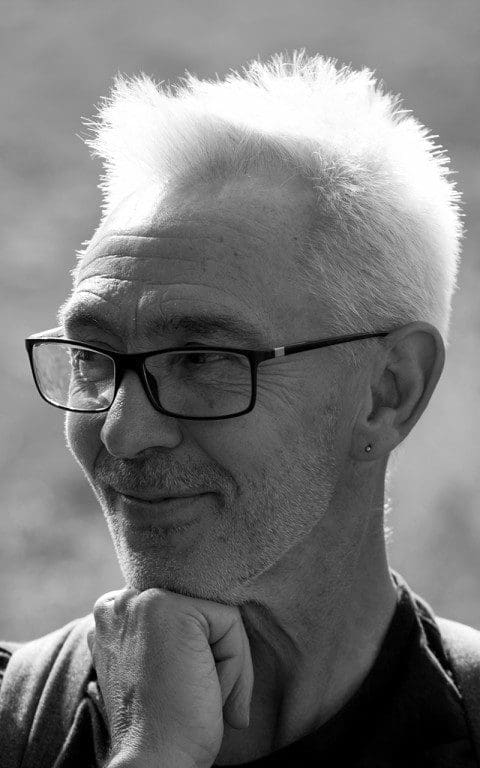 James Hitchmough
James Hitchmough
Opening and closing the symposium were presentations by James Hitchmough, Professor of Horticultural Ecology in the Department of Landscape Architecture at the University of Sheffield. James has done a huge amount of research into seeded naturalistic plantings over the past 30 years and, as an academic and researcher, was generous and instructive in the information he shared. He was very clear in communicating the ecological value and function of designed landscapes, but explained that the highest value and most stable functioning of a planting is achieved through its ability to persist – its longevity. This is directly linked to biomass, since the denser a planting is both above and below ground, the less unwelcome weed species are able to invade it. The layering of foliage above ground, from groundcovers through to tall emergents, also shades out weed species, creating a more stable planting. He advised that the biggest challenge in dynamic naturalistic plantings is identifying what they are to become and how to manage them with this guiding vision in mind. All of these observations rang true.
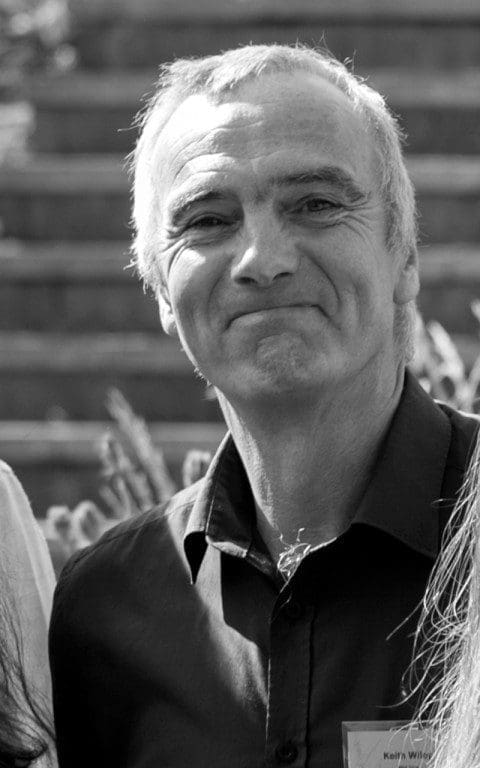 Keith Wiley
Keith Wiley
All of the speakers spoke about the inspiration they have taken from observing native plants in the wild, and both Keith Wiley and Peter Korn spoke passionately about their travels to Crete and South Africa, Kyrgyzstan, Armenia and North America, respectively as being hugely influential on the ambitious private gardens they have both created in Devon and Sweden. Keith was, for 25 years, the gardener at The Garden House at Buckland Monachorum, one of the most influential gardens of the 1990’s in bringing naturalistic planting to the attention of a wider audience. His talk focussed on the aesthetic possibilities of combining plants as they appear in nature, and he illustrated it with lush images of highly colourful, exuberant plantings.
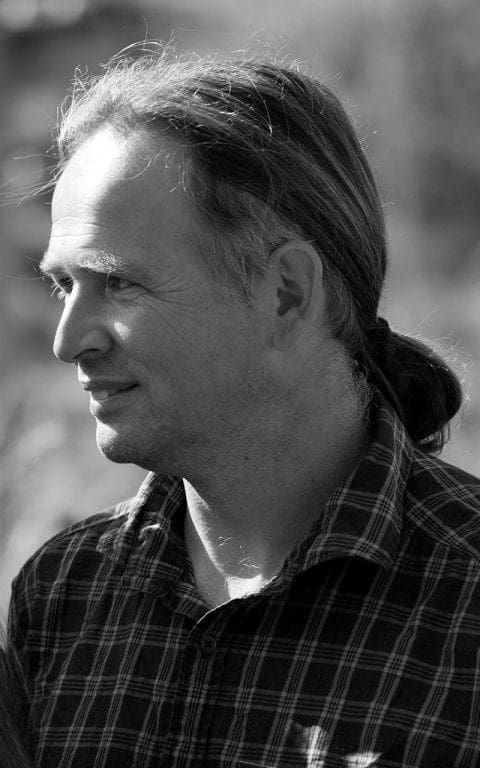 Peter Korn
Peter Korn
Peter explained the challenges he had set himself by wanting to grow as wide a range of dry-climate plants as possible from all over the world, in an inhospitable climate and with the added difficulty of high rainfall and sub-zero winter temperatures. Both explained in detail the lengths they had gone to in order to create specific microclimates and soil conditions to allow them to grow some of their favourite species. Of great interest was Peter’s method of growing plants in deep sand, which both encourages the formation of stronger mychorrhizal communities and presents a hostile environment for self-seeding weeds.
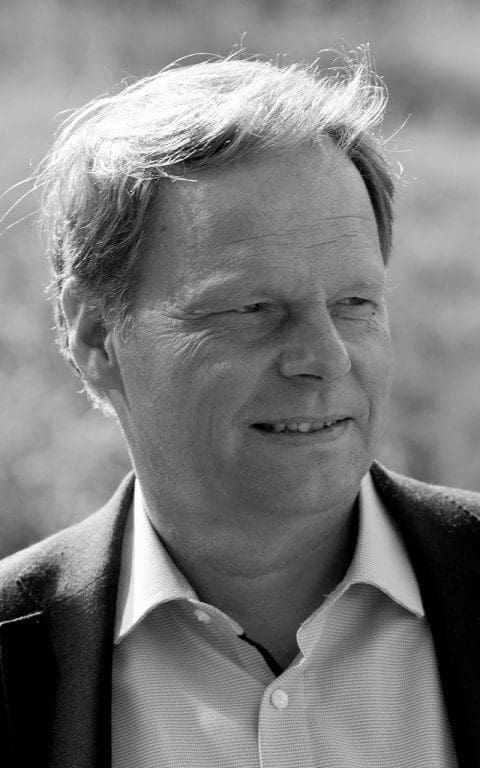 Cassian Schmidt
Cassian Schmidt
Similarly, Professor Cassian Schmidt, Director of Hermannshof Garden described the creation of a large number of habitat types to showcase a wide range of plants in this public garden located in Weinheim, near Heidelberg. Originally based on the ecological principles of Professor Richard Hansen, Hermannshof now has in excess of 18 habitat areas from North American Prairie to East Asian Woodland Margin and European Dry Steppe. In tune with James Hitchmough, Cassian also described the importance of plant ‘sociability’ when planning plantings, choosing plants with compatible growth habits and cultural requirements to build persistent, self-regulating communities. His experiments with dense plant layering, and the use of primroses as an early-season, weed-supressing groundcover encouraged us in our own thoughts about these as a means of closing the ecological gap in our own plantings.
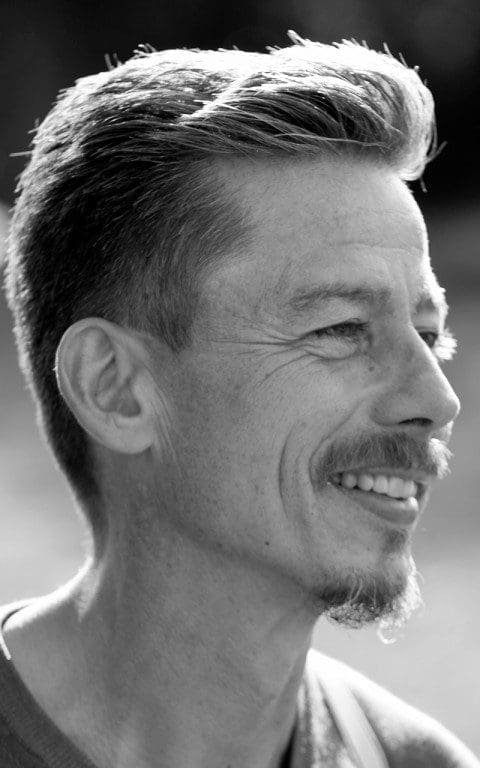 Peter Janke
Peter Janke
Fellow German, nurseryman and garden designer, Peter Janke, worked at the Beth Chatto Gardens as a young man in his 20’s, and was hugely inspired by Beth’s experiments and success in the Gravel Garden. After returning home he introduced her teaching of using plants best suited to the habitat conditions in one’s garden to an audience of German gardeners. Peter spoke about the challenges posed by the recent high summer temperatures, which have been especially extreme where he lives in central Germany, and described how he created his own garden, based on many of Beth’s planting principles, in particular a gravel garden of his own, which has performed remarkably well this year.
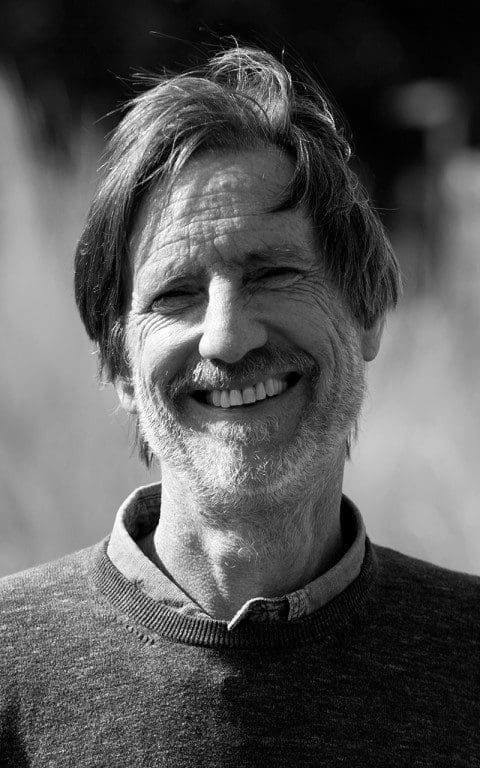 Olivier Filippi
Olivier Filippi
French nurseryman, Olivier Filippi, spoke passionately about planting palettes for Mediterranean and dry landscape plantings, the development of which he is at the forefront of, supplying projects all over the mediterranean. Although many of the speakers talked of striking a balance between aesthetics and function, Olivier was very clear that, in a dry climate, a functional landscape is, by necessity, a beautiful one. He described the use of cushion-forming, evergreen sub-shrubs as key in his work, and flower as the least important aspect in making plant choices, leading to an appreciation of the ‘black and white garden’ where rhythm, form, texture and contrast are the primary considerations. He also spoke vigorously about the need for water conservation and encouraged the audience to regard maintenance as one of the most enjoyable parts of gardening. He was also dismissive of current trends for using only native species in plantings, arguing that, in relation to the scales of planetary time and geographical change, such a stance was limiting and myopic.
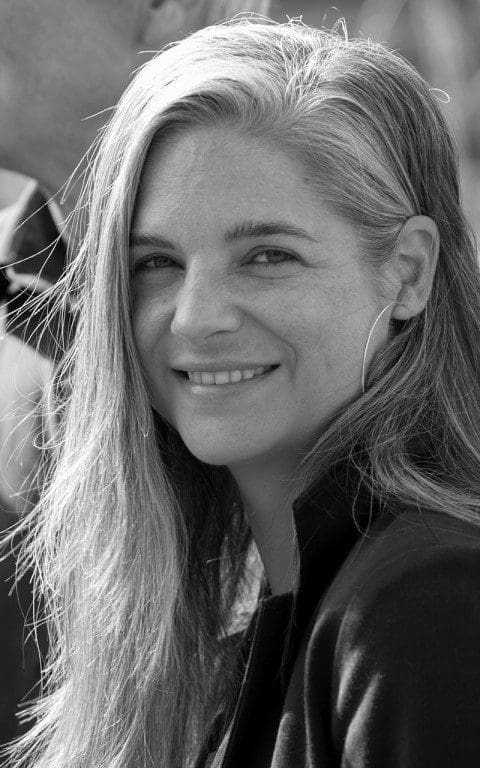 Andi Pettis
Andi Pettis
As a complete contrast Andi Pettis, Director of Horticulture at The High Line, spoke of the very particular challenges of gardening in an extreme urban environment. As well as the technical and organisational difficulties of maintaining a podium garden high above the ground. She also focussed on the relationship between the public and plants, and the fact that people are also a part of landscapes and their associated ecosystems, whether natural or designed. Like Cassian Schmidt she also spoke passionately about the educational benefit of a public park where horticulture is paramount, and how, even in the centre of one of the busiest cities in the world, it is possible to get people to engage with and appreciate natural cycles and rhythms and ecology.
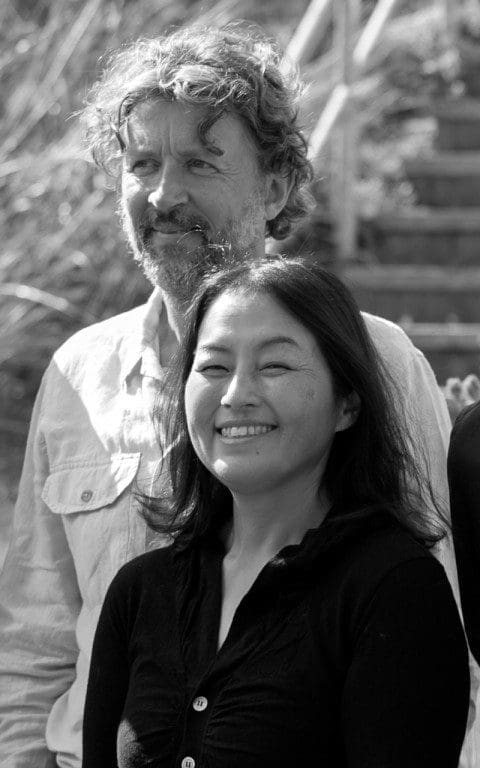 Dan with Midori Shintani
Dan with Midori Shintani
Dan had also been invited to speak, and he did so primarily about his work at the Tokachi Millennium Forest, although he too illustrated the fundamental impact that Beth Chatto had had on his early understanding of plant habitat requirements, and the importance of creating planting schemes that are culturally balanced and in context with their surroundings.
His talk was followed by one given by the Head Gardener at the Millennium Forest, Midori Shintani, and her first public presentation in English. Midori talked of the ancient Japanese belief in animism, the power of all natural things, of the landscape, and of nature worship. She also explained the importance of satoyama, the term used to describe the territory formed by the intimate relationship between man and the productive agricultural landscape at the boundary of the wild. These ideas were then developed as she explained how she and her team of gardeners approach the work of maintaining, not just the designed landscapes at this public park in Hokkaido, but the very forest itself. She spoke beautifully and with great tenderness about the fact that everything is connected, and the importance of taking great care and making close observation of natural processes. She expressed the deep interconnections between people, landscapes, natural habitats, plants and fauna with immense simplicity and lightly worn wisdom. It was no surprise to find that, as she delivered her final words and the hall filled with applause, many in the audience were crying.
Words & photographs: Huw Morgan
Published 8 September 2018
Lucy Augé is a Bath-based artist who has an passionate interest in the variety of flower and plant forms which she paints with Japanese inks on a wide range of specialist and vintage papers. Her intention is to capture the ephemeral and fleeting moment. We met last year and, after introducing her to the Garden Museum, she showed some of her new tree shadow paintings there earlier this summer. Since June, Lucy has been coming to the garden at Hillside to capture a range of the plants here on paper.
How did you come to be an artist ?
I always wanted to be an artist, even from being a child. For my tenth birthday I didn’t want a party, but wanted to go to Tate Modern, as it had just opened. I think my mum thought, ‘Oh God. Choose another career path !’. I had always been creative at school, I was never really academic, so I got funnelled down a channel into being ‘artistic’. That then followed me through to college, but I thought I couldn’t be an artist, so I did graphics, and thought I’d go into magazine design, as I had a passion for French Vogue at the time as it was so well art directed.
Then I had a really bad brain injury from a fall, and that left me very, very ill, at home. I couldn’t go back to university. I couldn’t do much, as I was having four seizures a day, and thought, ‘OK, life’s over’, but then I started gardening with my father, and that’s where I started noticing – I was going at such a slow pace, because I was so ill, I’d have to be carried down to the garden – and I started noticing things more, because I didn’t have any distractions. I didn’t have a phone for two years. Not that I was cutting myself off, I just didn’t need it. So I just started looking at nature all the time, and then I just started painting it. Repetitively. Or I was watching gardening programmes on repeat, because I wanted to know more, all the time. So, that’s where, through the illness, I got the passion for gardening and my painting.
When I finally went back to university I just felt it was very redundant for me. I went back to the graphics course as I was already a year in and because I don’t really like to give up, but I knew the tutors didn’t really like my work. They were looking for a very graphic, computer-generated style of work, and I then generally only worked in felt tip, keeping it hand drawn, but still trying to fit in with the current look that was around at the time.
So what happened after university ?
I got picked up for projects while still at university and, when I graduated, I did packaging design and worked with Hallmark, but I quickly knew I wasn’t an illustrator, as I can’t draw just anything and my passion lay with nature and studying that, rather than drawing a family of badgers eating cake. No joke, that was an actual commission.
The 500 Flowers exhibition came about after a month I spent in LA in 2015, where I had a meeting with the art director at Apple of the time, who had offered to mentor me. He set up a meeting with a carpet designer who I was supposed to do collaboration with. However, when he met me he told me that I wouldn’t be an artist unless I married someone rich, and that he would only work with me if I got someone to buy one of his rugs.
I was enraged by this and thought I was tired of waiting for someone else to launch my career for me. So I came home determined to make an impression alone, booked a rental gallery space in Bath and put on my first show on my own. The idea originally was to paint a thousand flowers, but that was near impossible in the time frame I had set myself. My brother calculated I would have to complete one every ten minutes ! So I painted five hundred, with the aim of painting every species that I came into contact with.
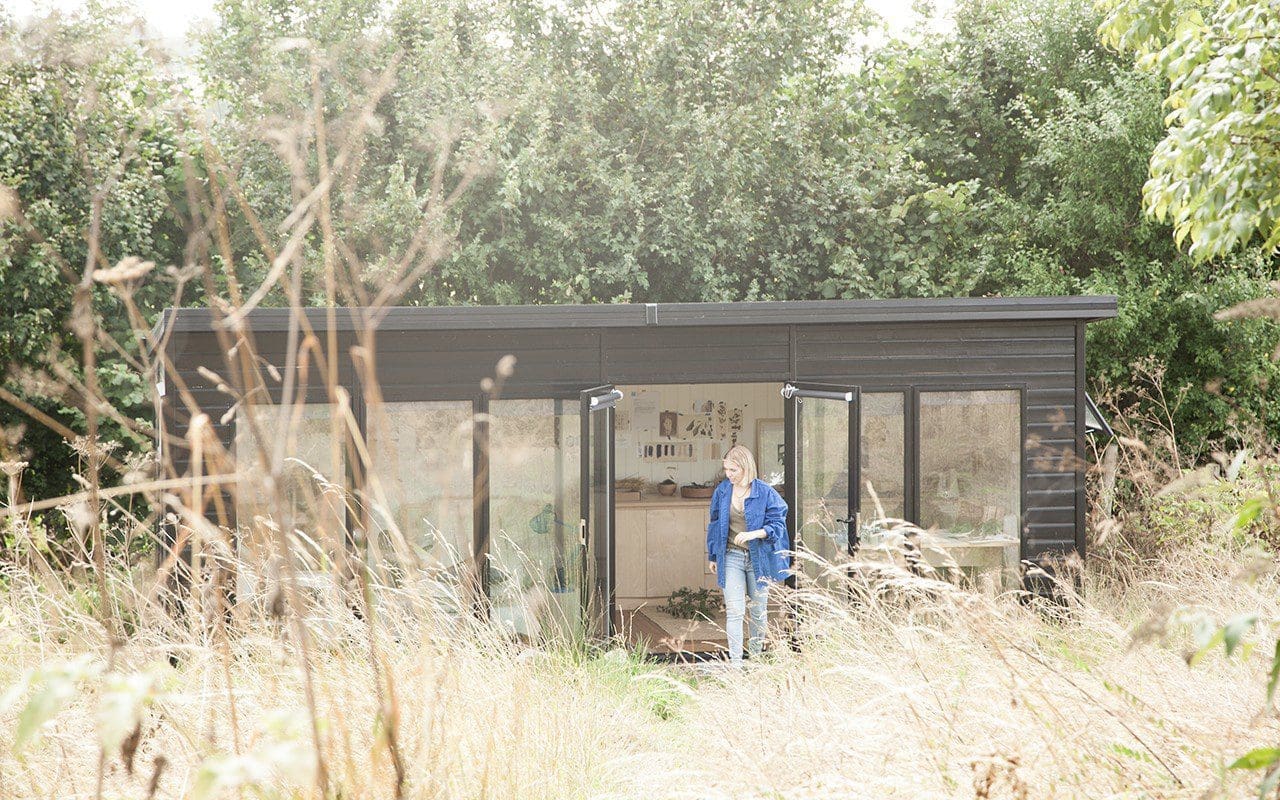
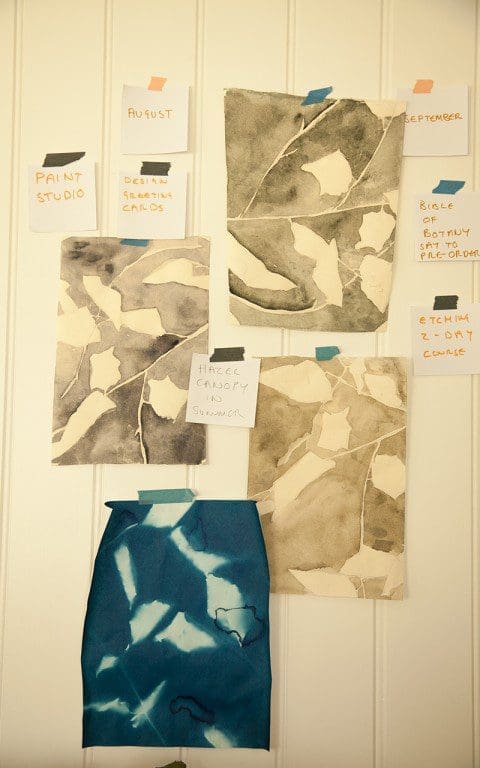
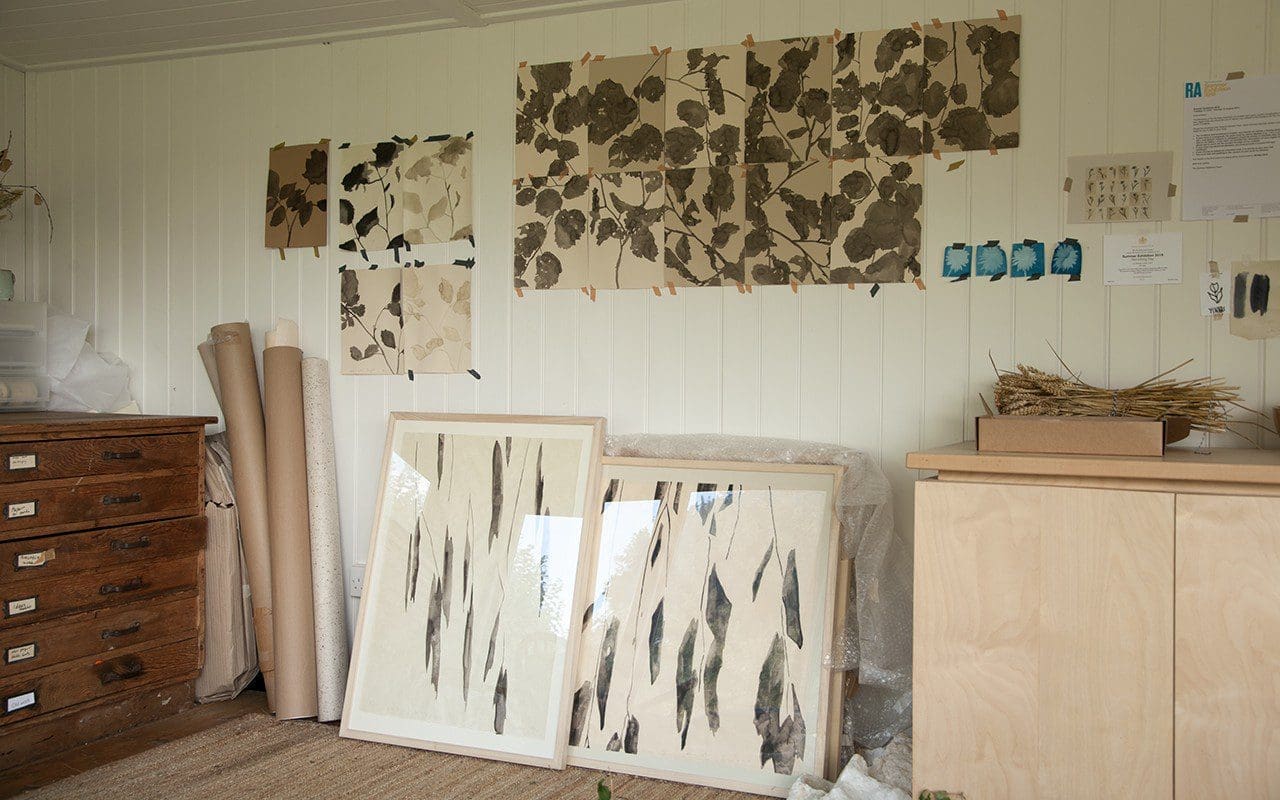 The exterior and interior of Lucy’s rural studio in Somerset
The exterior and interior of Lucy’s rural studio in Somerset
You produced all of that work and organised the exhibition yourself. What was that experience like ?
Well, I had five hundred A4, individually painted ink drawings, which I had completed in three months, and that both evolved my style and I became very confident at drawing. I also priced them at £40 each, which I think some people thought was madness, but at the same time nobody knows you, you have no reputation, and so £40 can seem like a lot for someone, but it was great because it made it affordable so that people would buy maybe nine or twelve at a time. An interior designer, Susie Atkinson, bought sixty. And so it got my name out there, because I was affordable.
The exhibition took place in Bath and I made sure I had beautiful letter-pressed invites. I invited everyone I’d ever met, contacts I’d made on Instagram or through business or who had shown an interest in my work. I invited people who I really admired for their work, which is why you and Dan got an invite. I just wanted to show people that this is what I do, this is my passion and if I fall flat on my face and no one comes and nothing sells, at least I would have known that I’d given it 100%. And then I’d have gone and got another job !
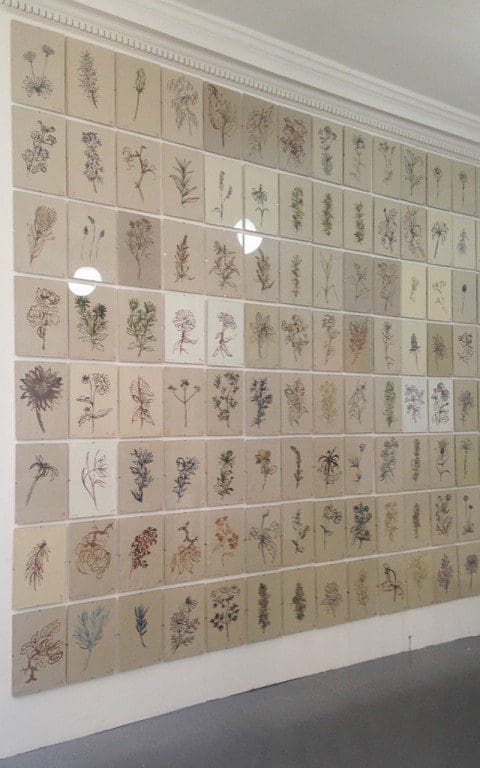 Installation view of 5oo Flowers
Installation view of 5oo Flowers
But it worked out in my favour. I had a queue out the door on the first night. I sold over eighty in the first couple of days. Then House & Garden emailed me to ask if they could have nine for their show, which the editor ended up buying. The assistant editor then bought another nine, and she put them up on her Instagram and I ended up selling out in five months. That then led to shows in Japan, San Francisco and elsewhere. It confirmed to me that, yes, you are on the right path, you’re doing the right thing, and the proceeds of that first exhibition went towards buying my studio. Before then I was working in a barn with no windows, no natural light, no loo, and so that exhibition was my make or break. Otherwise you can be creating, and calling yourself an artist and saying ‘This is what I do for a living.’ and yet you’ve never really put yourself out there, and so I thought, ‘baptism of fire’.
Then I started getting commissions from people to go and draw on their land, their flowers, which was really great. The best of those was for Gleneagles, which was the highlight of my career. I was flown up to Scotland, where I’d never been, and stayed at the Gleneagles, which was an amazing experience, and I went round the estate and drew all of the plants that were there at that time, and they are now hanging in the American Bar. And it was just so nice to know that people understood what you do.
Were you starting to charge a bit more for them now ?
Yes, I did raise my prices. Although I didn’t charge a lot because I wanted people to have the chance to invest in my work. I come from…my father grew up with no money, but he was always passionate about art, and just wanted someone from his background to be able to go, ‘I’m going to invest in something. Something beautiful.’ So that they can own real artwork. And I think that is a real gift to be able to do that. Especially as I had five hundred ! And the consequence now is that they have travelled all over the world. I love that there are some in Singapore, and some in Brazil and I don’t think I would have got that kind of international reach if I had not priced them so competitively. Of course, now my prices have gone up and I don’t need to produce as many. My last catalogue only had twelve paintings in.
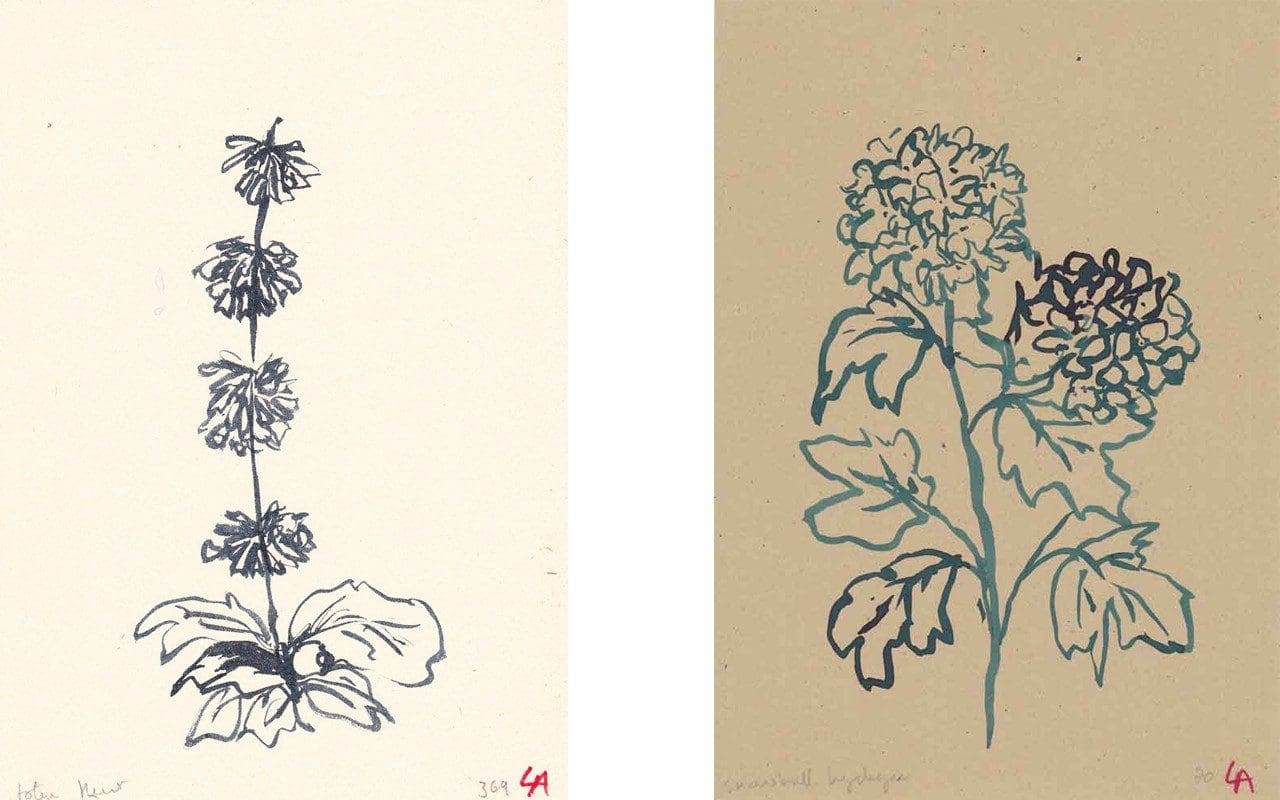
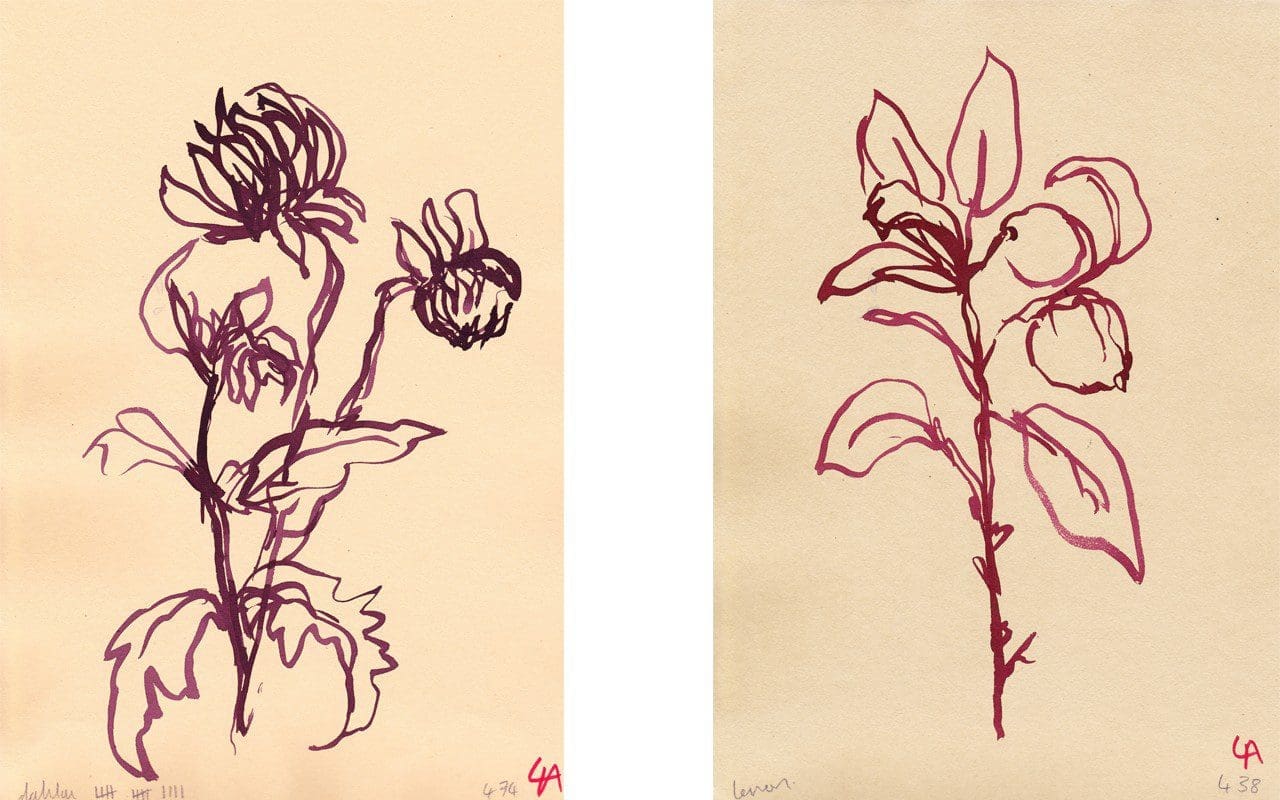
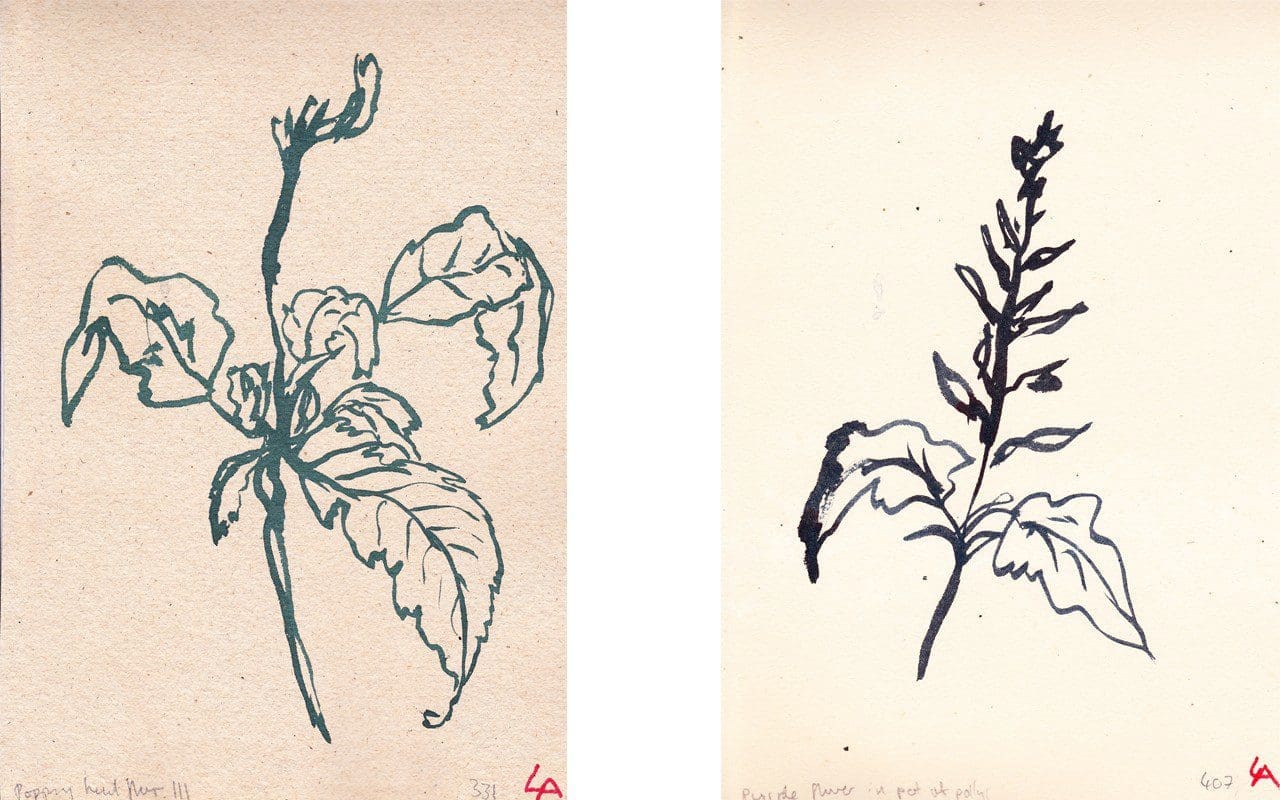 Six of the paintings from 500 Flowers
Six of the paintings from 500 Flowers
What was the medium you used for the 500 Flowers paintings ?
Ink. On antique paper.
I’ve seen some of your work which is very highly coloured and looks like it is done in felt tip ?
Yes, that’s right. That’s when I was still trying to be an illustrator. With those I was trying to fit in with the norm, so everything was very highly coloured for editorial. I would say that that was the only time I have ever tried to fit in. It worked for the clients to a point, but I kept being told, ‘Your work looks too much like you. There’s something to it, but it’s not commercial enough.’. So I gave it a year, doing that kind of work and I just grew out of it very quickly, because it wasn’t me.
There appears to be a strong Japanese influence in your work.
I love Japanese and Chinese art. I’ve always loved Japanese and Asian culture, so it’s always been in the background. Anything from there I could get my hands on I wanted to have a look at it, absorb it. Then I saw a show of Chinese paintings at the V & A, where I learnt that they were painting with natural pigments, so with copper and iron and earth and plants, and it just made this wonderful colour palette. So I found some Japanese inks that have that same antique colour palette, and it just felt much more me. It’s hard to put my finger on it, but it just started to fit better with the kind of images I wanted to make. And with the paper. I had never wanted to work on white. I had this antique paper, which had been in my godmother’s attic, which had the same feeling as the old Chinese papers I had seen, because they are made entirely from natural elements. So my choices were about aspiring to that antique colour palette. The other thing that struck me about that exhibition was that the artist was always invisible. The painting was never about the artist, it was about nature, landscape, weather, the seasons. It was about the everyday. And I thought, ‘Yes. Art can be like this.’ Because as I was growing up when everything was about high concept or shock, shock, shock or politics. The stranger the better. How far can you push it? And looking back at older art – one of my favourite artists is Monet – was deeply unfashionable and seen as suspect. But I love how he could just paint waterlilies and the resulting painting becomes this charged, emotional landscape.
Is that one of the reasons that you didn’t feel you could really be an artist ?
Yes, completely, and it’s one of the reasons I considered commercial art to begin with. Also I was never really encouraged at school, bar one teacher, to pursue my art. You were told that you needed to fit in. And I think as an artist you do need some kind of validation that what you are doing has value and that this is what you are supposed to be doing. And I never really got that until I put myself out there and had people say, ‘We want what you make.’ Because otherwise you can be drawing for just you – and I don’t think there’s anything wrong with that – but you do have to decide that you are going to be an artist, and I made that decision after the success of that first exhibition.
I could have gone in one of two directions. I could have just put my flowers on anything and gone down the commercial route, or choose to refine the work and make it more considered. I have had a few commercial collaborations, but I have been very choosy about who I have agreed to work with or who I have approached. And I then reined it in and have now moved my work away from it, as people lost the meaning behind what I was trying to do. So they just wanted a picture of a lily as their daughter was called Lily, which is fine, but it missed the ethos of the work.
Which is ?
Seasonal observation through nature and plants. Forgotten moments. The immediacy of right now. I always found it interesting that the first pictures to sell out always are the ones of weeds. Those are the ones that people really want. I think because, as soon as you paint them, and strip everything away, you can see the beauty in them, and the fact that they are so mundane, but the painting elevates them. Honours them.
Do you know that there are 56 seasons in Japanese culture that relate to the flowering times of 56 different plants ?
No, I didn’t. How fascinating. I can so relate to that. I get quite anxious at the possibility of missing things. You know, like cow parsley. I’ll have a great idea, and then two weeks later I’ll have the time to get onto it, and all the cow parsley is gone ! So now I prep my paper in advance and cut it to the size that I want so that, when that moment presents itself, I can just say, ‘Here I come !’. That’s why when I came to your garden I had no idea what I was letting myself in for. It’s definitely going to be, sorry to say for you, a much longer process than I had envisaged, as I now would really like to be there in different seasons.
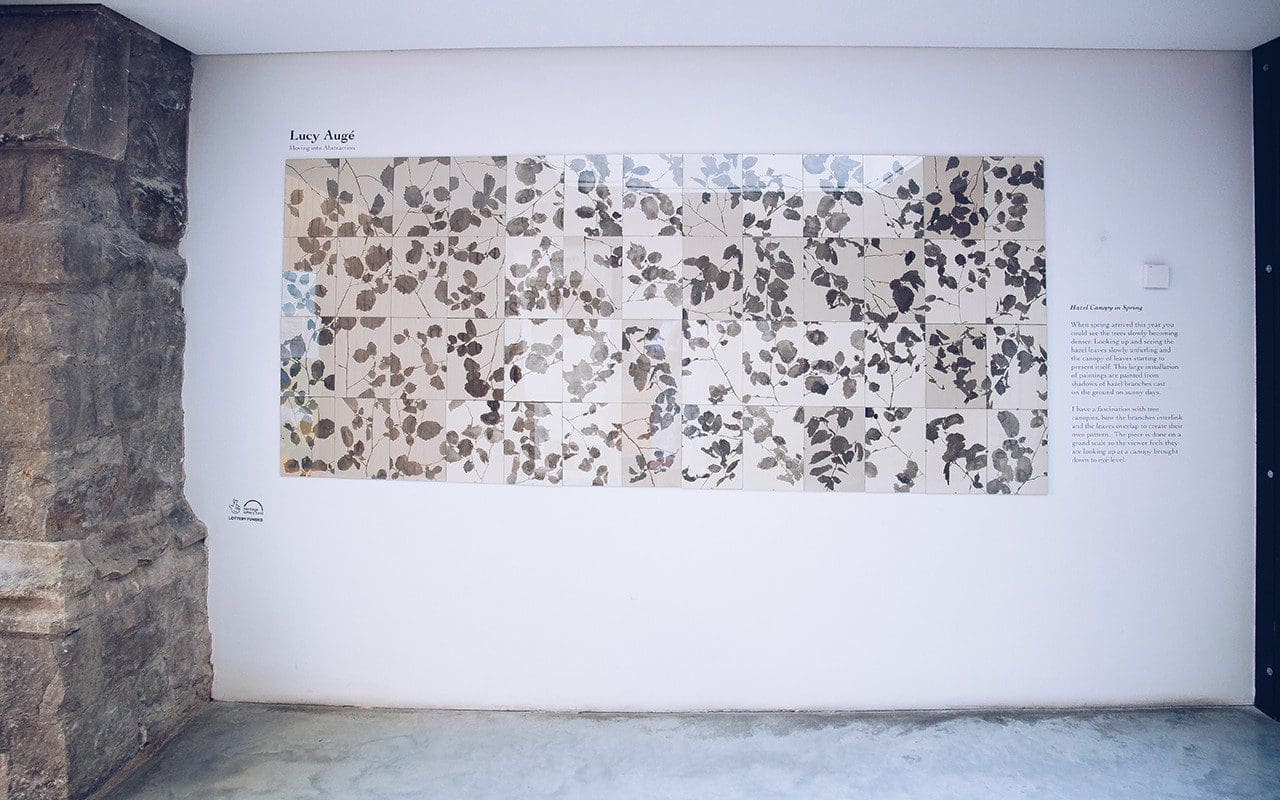
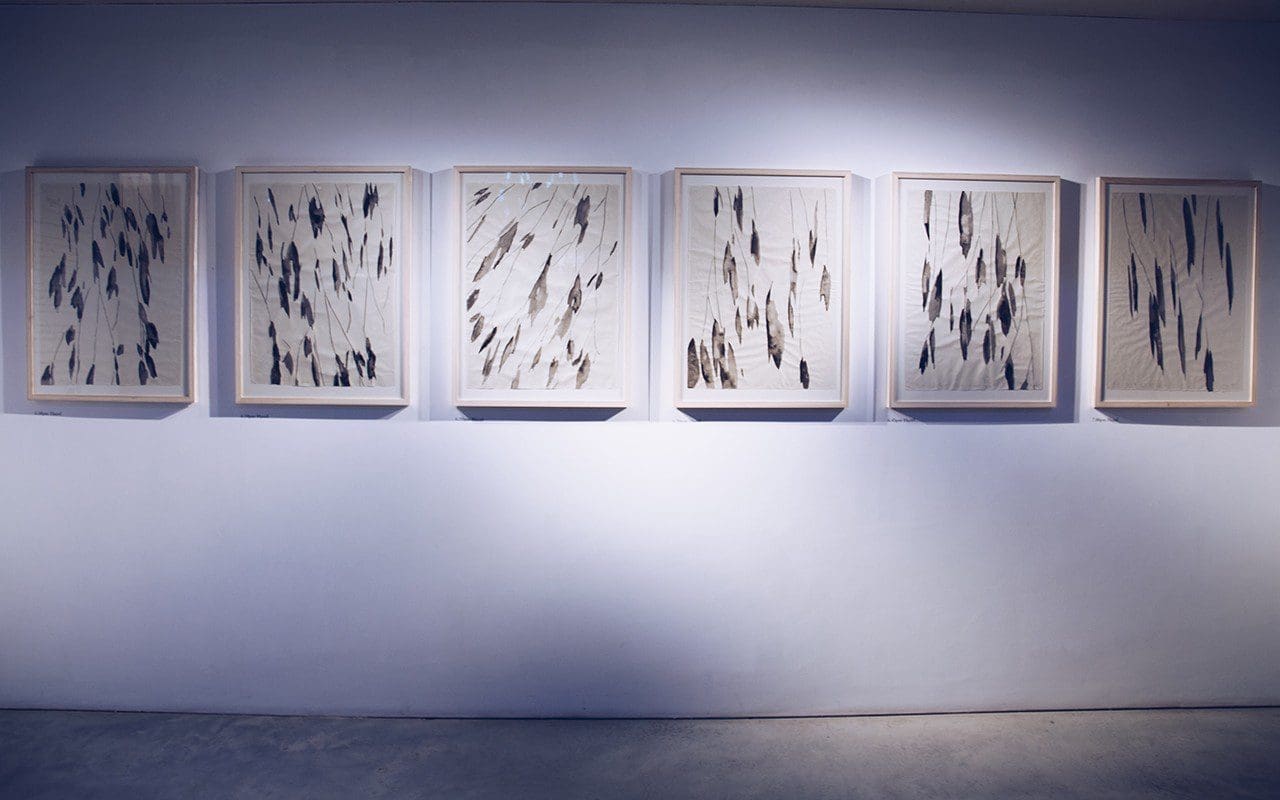 Installation views of the exhibition at the Garden Museum
Installation views of the exhibition at the Garden Museum
What does your work mean for you personally ?
Very generally it just gives me that quiet time. You don’t have to think about anything else. Once you get into a process – it’s a bit like gardening in a sense – it gives you that same mindfulness combined with productivity, which makes me feel at peace. You’re just drawing, or gardening, and that’s all you’re thinking about. And then sometimes you’re not even thinking at all, but are completely lost in the process of activity. That’s what I really love about what I do. It’s quite addictive. It empties your mind and is very meditative. I’m a worrier. I do worry too much and it’s quite nice to be able to say, ‘I’m not going to think about anything now.’ And I’ve always been quite confident in my own work, so it feels like a very safe space when I’m creating. And once I’m happy with it and happy to put it out in the world, it’s done and I can move on.
Until then – and that’s why I have my studio away, remote. I don’t want to hear everyone else’s opinions – I don’t actually show anyone my work until it’s at a certain stage, which is almost finished. It gives me a degree of freedom and escapism. Which is why it didn’t work for me as an illustrator, because someone else is dictating what you’re going to draw, your process is held ransom by deadlines, and I’ve never been any good at being told what to do. Ever. I will question and question to understand why I should do something. Just because I’m curious, but having it be just my own work I can ask my own questions and be curious about where it’s going to go next, how am I going to paint it. And I know what I am looking for, rather than what somebody else is looking for and wants me to produce. I do find it difficult when someone says, ‘I have a tree in my garden. Can you paint it ?’, because the tree might not be the thing in their garden that I would want to paint.
What are you looking for ?
In paintings I think it’s a stillness. I really want to portray stillness, or a captured moment. So everything has to be painted from life, because it feels fake otherwise. Sometimes I do draw from photos, but you’re just not capturing that moment when that leaf on that plant might have been at an awkward angle. You might not have seen that from a photo, so that’s really interesting to explore.
The 500 Flowers were all painted from life. Firstly, all near to me and around the studio, so a lot of wildflowers, but also some bought flowers, and that’s how I got in touch with Polly from Bayntun Flowers, because I looked up ‘local cut flowers’ online and saw what she was doing and I thought, ‘Brilliant !’. She had amazing heritage varieties and luckily, when I asked her if I could visit to paint, she said, ‘Yes. Come on round!’. I was like a child in a sweet shop. The first day was so exciting I must have made about forty paintings in one go. I would normally paint about five or ten. But the garden there was just chockablock with species, lots of which I hadn’t seen before, so it was very exciting and it got me up to five hundred !
But then it was hard when the winter came. I wasn’t aware of how much I would suffer. I became quite, ‘unusual’ in the winter, because I panicked and thought, ‘What am I going to draw ? Everything’s over. My work’s not good enough.’ It was really tricky. You’ve been doing all this painting and you’ve got this absolute high from painting all these things, because there are endless possibilities and inspiration in the summer, and then my first winter I didn’t know what to do. I was really looking and trying to paint winter, but really everything is just dormant and that’s when I realised I have to know what I’m going to do when winter comes. Not hibernate.
So now in the winter I paint a lot of dried leaves and stuff like that. The first winter I was so busy, doing commissions and collaborations, that I didn’t really notice. It wasn’t until winter 2016, a year after the show, that it was total panic. A flower desert. I thought maybe it was time to do some abstract stuff, get back into illustration. It was bleak. And then there was stuff going on in my personal life, and what’s going on in my personal life does feed into the work. If I’m having a grumpy day I will most likely pick out a mopy looking plant. It’s weird. I didn’t even realise it till someone else came to my studio and said, ‘This is all a bit melancholy.’ It’s frees such an subconscious part of your brain when you’re drawing, you’re not really thinking, you’re just observing. When I saw how my moods were feeding into my work I wanted to explore that more.
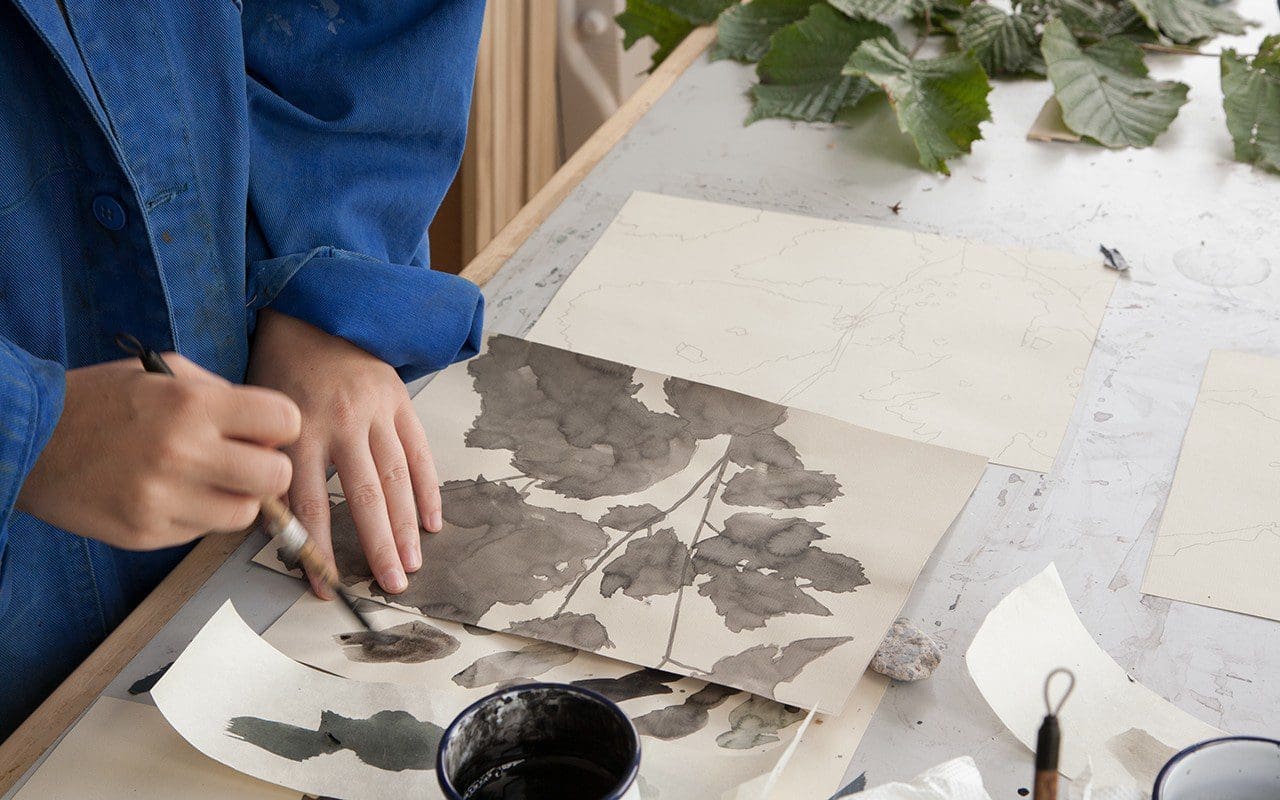
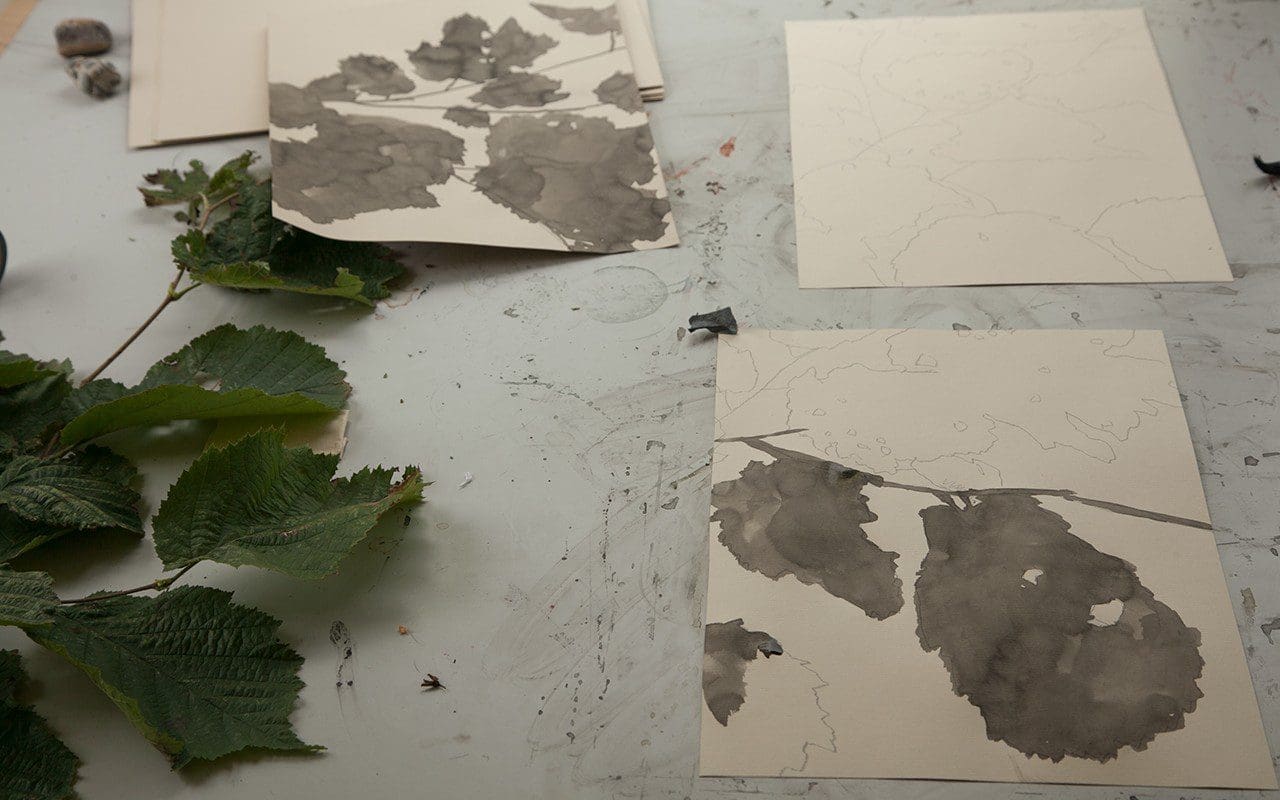
The paintings that I relate to the most, like Monet’s waterlily triptych, that he painted as a reaction to the war, is so powerful and emotive, and it is ‘just’ waterlilies, and I thought I would like to try and harness that emotional connection more and be more aware of it when I am working. So the tree shadows that I have been doing most recently came about because I had drawn so many flowers – I mean I was well over a thousand different flowers by now – and I was starting to fall out of love with them, even though there were commissions paying my bills. I thought, ‘I’m on the way to making myself into a performing monkey.’. I was getting set flower lists from people, with direction on paper and ink colours and I thought, ‘I didn’t start doing this to make ready-to-go flowers.’. It wasn’t me, and felt like I was heading back into illustration territory, which I had dragged myself out of.
But then it all changed because the farmer that owned the land that the barn I was renting died and so my studio tenancy went with him. I also had some financial worries. I didn’t want to paint another flower even though it was full on summer time and I was just lying in my studio taking a nap and I could see the reflections of the trees in the glass of one of my old pictures. And I thought it was interesting. I had also been experimenting with totally abstract ink paintings, which I would cut up and make into smaller single frames. But that didn’t fit in with anything that I was doing. But I started to think about how I could bring these things together. I started trying to draw the outline of the leaves onto the frame, but that didn’t look right. Then I started drawing outdoors, which I had always done. All five hundred flowers were drawn outside. But I couldn’t get a high enough outline definition.
That’s when I realised that everything moves so quickly. I would go and get my water bottle from the studio and, by the time I got back, the shadows had moved and the picture was different. That’s when I also started noticing the weather. Timing was everything. Before that I had just been aware of when each flower I was painting bloomed – this in when the roses are here, this is when the daisies look best – but not the bigger picture. When I was drawing the flowers I was more aware of the different varieties, because when you watch gardening programmes and learn that this is what a rose looks like, this is what an angelica looks like, and then when I would go out into the fields I would think, ‘Well, that has the same leaves as a rose. That looks like an angelica.’ And so then I was learning, without any books or anything, about those wild plants. Even though I didn’t know the name I was able to match them up.
What I was finding when I started doing the tree shadows was that , even when the shadows distort, they each have a particular look. Aa certain space between the leaves. The reason I like painting hazel is they have a lot of space between the leaves. I’ve tried painting quite a few different trees, but have found what works and what doesn’t work for me, for my aesthetic. I’ve also learned that, at four o’clock, you won’t be able to get hold of me, because the phone goes off, because that is the time I’ll be painting the shadows. That’s one of the things I noticed at your place. It wasn’t four o’clock. It was later. More like five thirty, which doesn’t sound like a lot, but it makes a big difference, because that’s when you’ve got the high definition of the shadows, like on the irises that I tried doing. And where your site is so exposed the light seemed to move so quickly. I only had a half hour window, and that was it. Whereas where I am I can start at four and not finish until seven. The angle of the image changes, but at yours I was surprised at how the time made such a big impact. It’s taken months to understand that. When is the right time to draw. What is the best weather.
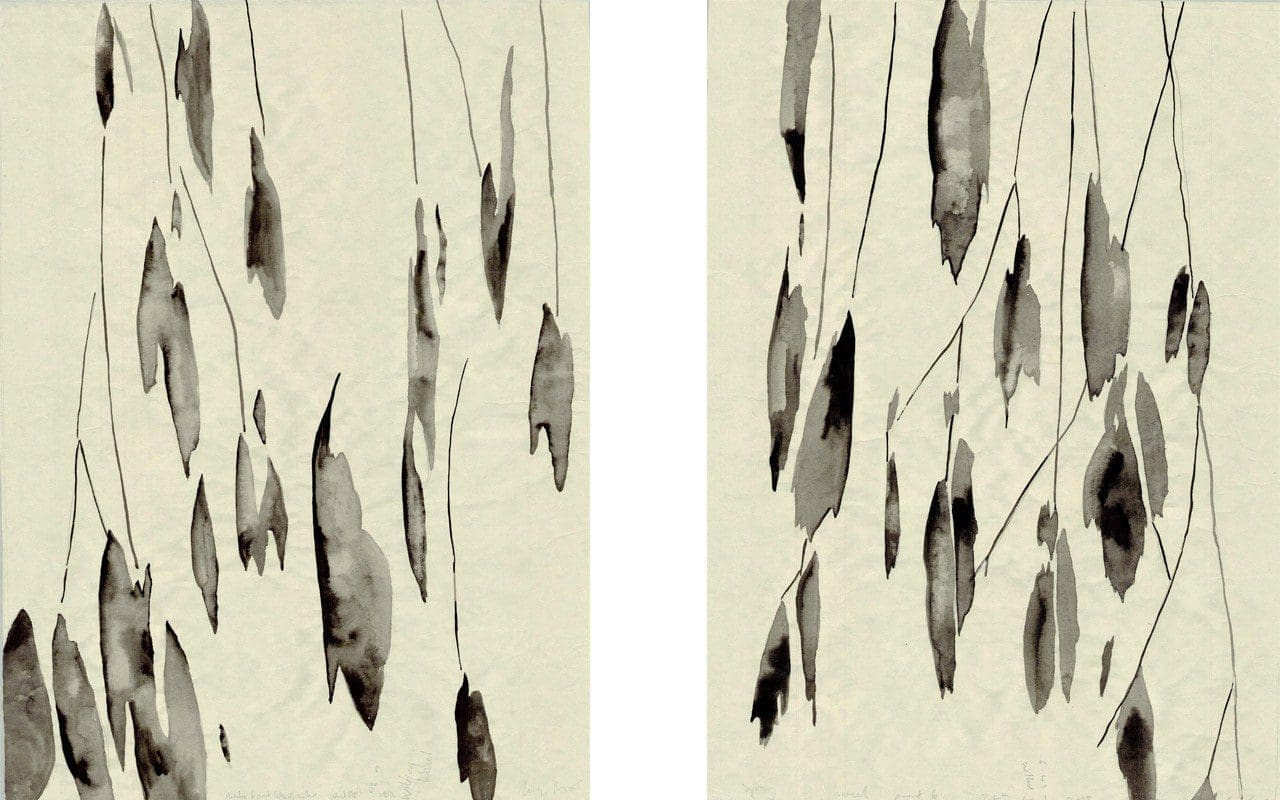
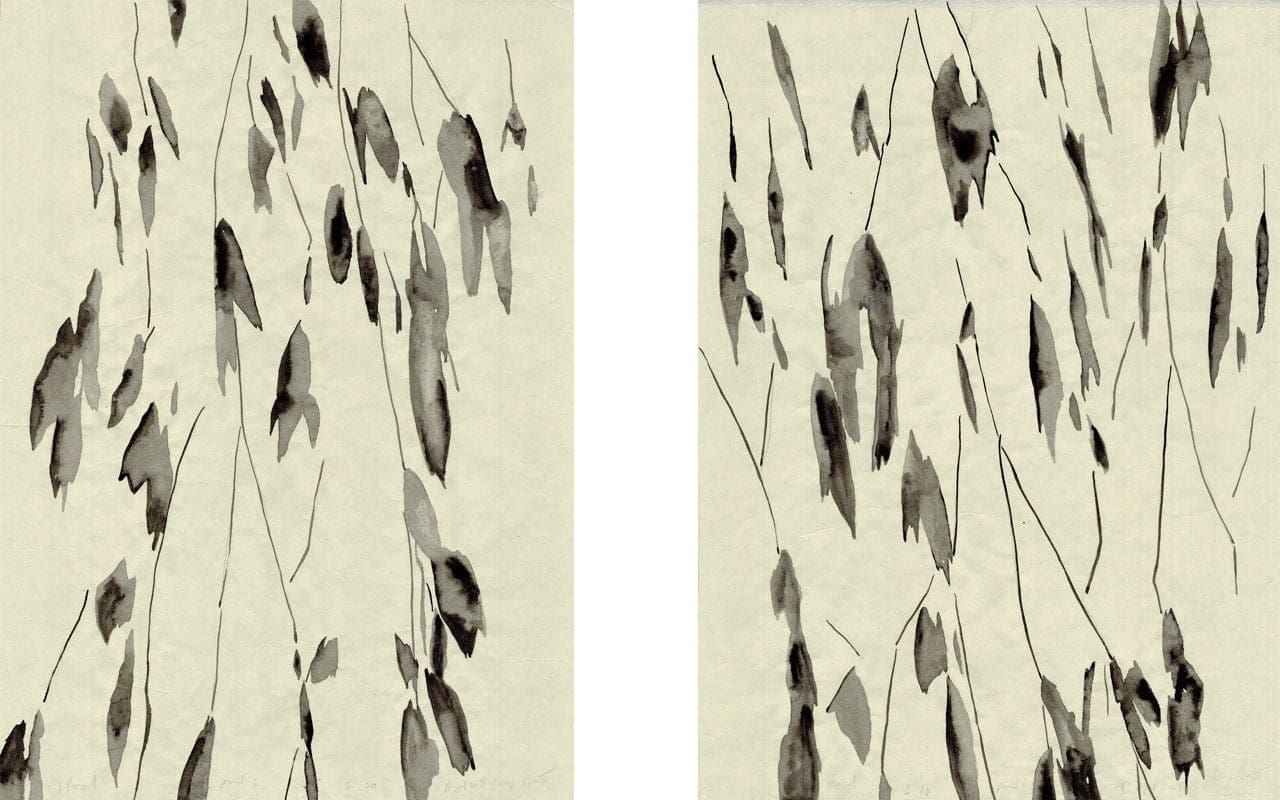 Four of the series of paintings of hazel shadows exhibited at the Garden Museum
Four of the series of paintings of hazel shadows exhibited at the Garden Museum
When did you start doing the tree shadows paintings ?
August last year. It was purely by accident. I had some leftover scroll paper and I had this birch branch and was trying to paint up into the canopy inside the studio. So I’d hung it up and then I saw that when the sun came in through the window, there it was on the ground. So I thought, ‘Oh, quick ! Get it down. Start drawing.’ I wouldn’t say that I’m drawing the outline, but more what I saw, because things move so quickly that you can’t get the exact outline, so there is a bit of interpretation involved, but I still want to be quite true to what it is, and if what it is turns out to be an awkward picture, I quite like that uncomfortableness.
So that first shadow painting, and I know this sounds cheesy, made me feel re-awoken again. I thought, ‘OK. Let’s restart.’ It was a risk, giving up on my flower paintings, which was bringing me in income, and then you think of going to your audience, who know you for your flowers, and saying, ‘I’m doing tree shadows now.’ But, the response was really, really positive. And it has been encouraging to hear people say, ‘You know I really liked your flower paintings, but I lovethe tree shadows.’
I think it’s because they feel more like art to people, whereas the flower paintings were more illustrative, the tree shadows are more abstract. But I think that doing the 500 Flowers gave me some validation, which means it is easier for people to feel comfortable with the change in direction.
When I was trying to capture a landscape through paintings of individual flowers – this is what grows here, this what I have seen and recorded – when I was in Scotland the flora there was very different, and it created en masse a very different painting. Different shapes and texture. Quite thistly, spiky plants, due to the hardier conditions up there. But not everyone got that, whereas everyone seems to get the tree shadows. I’m just really enjoying exploring it and see where it goes next.
I tried for two months earlier this year trying to capture the light coming through the canopy and it just didn’t work. Everything is a result of where I am working. My studio was too hot to work in, and so I was working under a tree – it was a walnut, which had a range of different colours in the leaves – and I was trying to capture all those variations in colour and collage them together, all in ink, in different gradients. I tried black and then green and it just wasn’t working, so I slightly felt that I was trying to – I’m always trying to come up with new work, a slightly ridiculous pressure to put on yourself, really you should just give yourself more time, so now I have gone back to doing the tree shadows. So yesterday I completed three paintings, which was a relief, because I got a bit stuck for two or three months. I do want to come back to the light through the tree canopies, because it’s been an obsession of mine for ages, since I was a kid really, when you were lying on your back on the grass looking up into the leaves with the sunlight coming through, but I can’t capture the light at the moment with the medium I’m using, so that’s why I’ve started making etchings, because the whiteness of the paper and the black ink, which becomes very matt, seems to be doing the job.
What are the challenges of your way of working ?
The etchings came about through the need to fill the winter gap. I was drawing in the winter sun, but it didn’t cast a good shadow, which I hadn’t realised, because the angle of the sun was too low. And it was a really grey winter last year, so I was waiting for the sun that never came. I did try using a lamp in the studio, but it felt wrong. It was impossible to get the light at the right angle and it felt like faking it. I am interested in capturing an ephemeral moment, not a frozen moment that doesn’t change. I have tried working from photos of shadows I’ve seen when out and about and projecting them onto the wall of the studio, and again it just didn’t feel right. I wasn’t capturing that moment that the camera had captured. And I enjoy the process of being really spontaneous. Just yesterday I had a small window to work in because the clouds were coming, and I was moving around this mock orange branch, and then the sun went, which was my fault for taking too long, which takes me back to that whole thing of not thinking and just being in the process. Every time I overthink it, it feels like I could be on that painting for weeks, and I’m not really like that as a person, so it would feel unnatural to do that.
By working with the sun I have got to know more about the passing of time, changes in daylight and seasonal changes. So I now know that autumn is coming up to peak season, because you get those amazing long shadows, which I find quite exciting, alongside the anxiety of knowing that I’m running out of time. I did do some painting in Thailand last winter. Paintings of palm trees that just looked like palm trees, and I found that quite interesting, because I didn’t know the Thai landscape, I didn’t know Thai plants, and I realised I am happier painting the familiar. Someone asked me recently why I paint hazel, and it’s simply because it’s in the hedge at the back of my studio, and it’s abundant. When I came to your place, again it was just complete overstimulation. There was so much, and I didn’t know what to choose, and your garden is very much a changing landscape. You can leave it for two weeks and come back and there will be a whole different colour palette. So when I came to your garden it just felt wrong not to paint flowers, even though in my mind I thought, ‘No more flowers. I’ve painted enough.’ It was the first time I felt like I actually wanted to paint flowers again, because I was discovering new things again, So that is something I’d like to explore more in your garden, but I need to get more used to it, as it is a whole new territory.
You told me that painting in our garden has opened up a new way of working for you. How ?
Well, the summer we’ve had this year has been very unusual. We don’t usually get weeks on end when it is just sunny every day, and I just felt like I needed to mark that. To capture the sun, and capture the flowers. So I thought, ‘How can I do that ?. So what I have noticed about your garden is that it has a lot of different shapes. All the plants have their own identity, and they all hold their own in the beds, none of them get lost. So I wanted to capture the shape of the plants, but not in ink.
With the etchings I did last winter of leaves, you just got the silhouette, and so I tried painting the silhouettes of some of your plants directly from life, and I just didn’t like the feel of them, and then the light was so amazing that that became my focus. So I started exposing the shadows onto cyanotype paper, where you are directly capturing the light on the paper. I’d first done this a few months earlier and was really interested in the process, as it produces images that are almost like abstract paintings. In some you can tell what the plant is, but in others you can’t and I like that. So the first time I tried it in your garden I was too scared to get close to the plants in the beds, and so I took the deadheaded rose cuttings off the compost heap, because I could just put them onto the paper and allow them to fall in their own way without me arranging them. I also like that element of chance. And I was also very influenced by the things you have at your place. Quite a lot of elements from Japan, a lot of natural materials and a lot of craft. And I just felt that etching, which is a craft, was a more appropriate response to the site.
So I want to create a series from your garden, but I would also now like it to be a longstanding, seasonal thing. So this summer it has, so far, been about the roses, which were such beautiful, old-fashioned looking varieties. I would like to come back at harvest time and see if I can capture that, when everything is going to seed. And rosehips. I just really want to document the seasons, as I don’t think people look at things closely enough and I think, when you’re more in tune with the seasons, you understand the world and our place in it better.
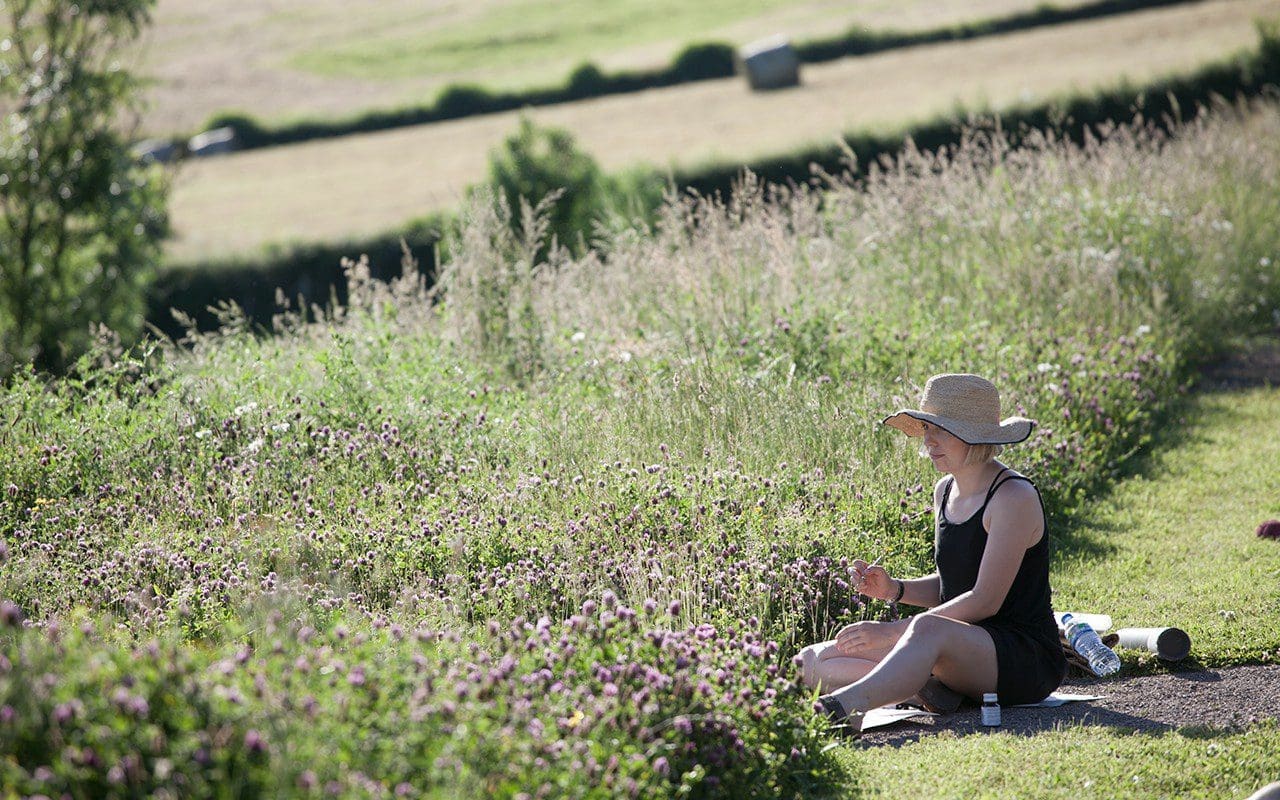 Lucy in the garden at Hillside in June
Lucy in the garden at Hillside in June
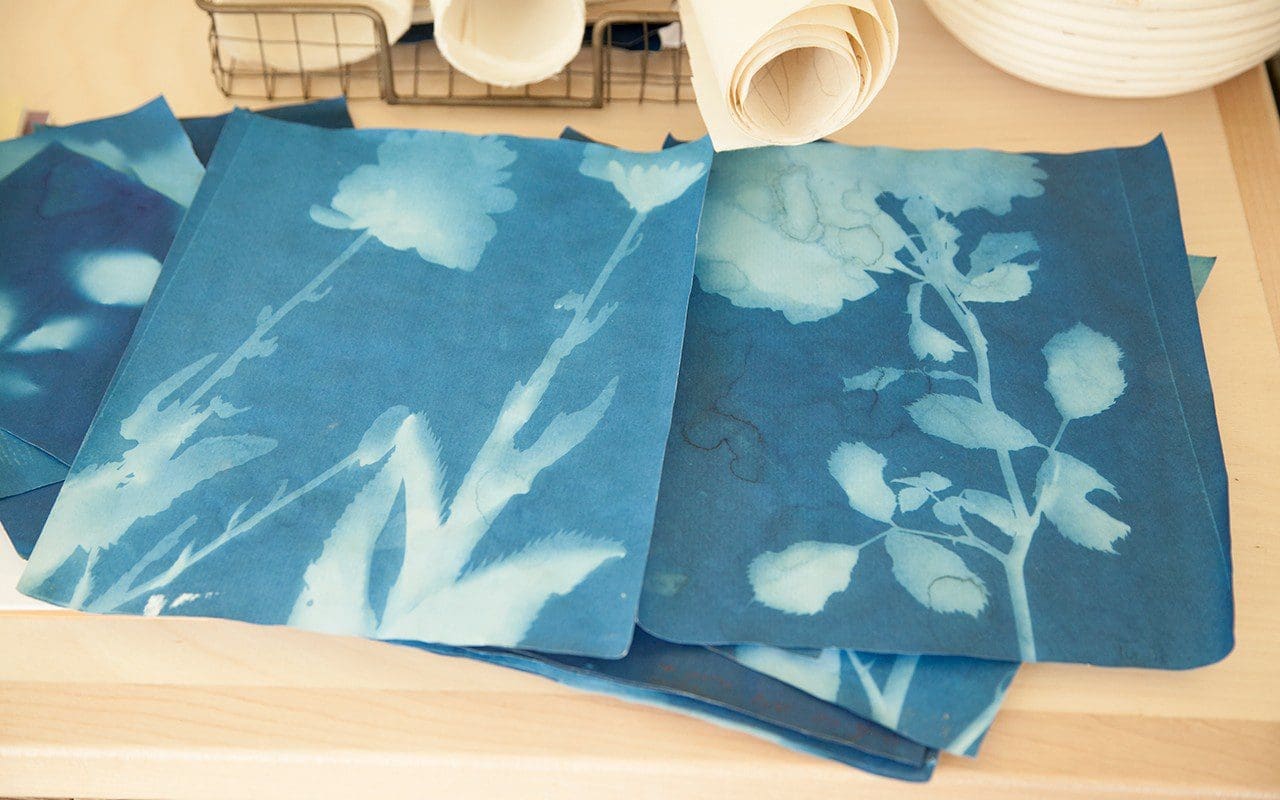 Some of the cyanotypes made in the garden at Hillside
Some of the cyanotypes made in the garden at Hillside
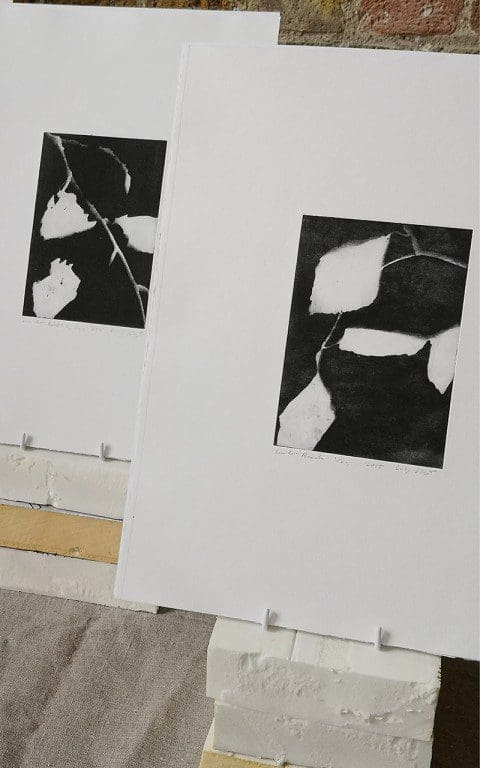 Etchings produced by Lucy last winter
Etchings produced by Lucy last winter
After last winter do you have a new approach for this coming winter ?
Yes, winter will be the time when I execute all of the etchings I am going to make from the cyanotypes taken in your garden. The process of creating etchings is quite time-consuming and complex, and it is still very new to me so I would like to spend more time getting more experience of that process. So at the moment I am just amassing lots of exposures so that I have plenty to work with later. And I am also going to explore some light and dark paintings of your garden from sketches I have made. Fingers crossed I am beginning to find a good seasonal rhythm for my work.
I’m also going to experiment more with photography, and explore the uses of light more and see where I can take it. As well as stillness I’m really interested in capturing the passing of time. For example the cyanotypes I made in your garden only needed a ten second exposure because the light is so strong there, whereas in my studio I need a fifty second exposure to create the same quality of image, but that longer exposure also captures that extended amount of time. I find that fascinating, and a route I’d like to explore. I also go to Westonbirt Arboretum in the winter, as there is always something out. Going there makes you realise how much there is to look at. There’s always something in season, or that has something in its branches to explore, and then you really are looking at winter. But I think your garden has a lot of winter interest, which I am looking forward to.
I also want to focus on the work without the pressure of a show, and just have a process for a while and see where things go, like the exhibition at the Garden Museum, who you introduced me to, and which came about very organically. I would like to be a bit more relaxed and take more time.
Do you have any burning ambitions for projects ?
I would love to be commissioned to create a stained glass window in a church. I’m not religious, but because I work so much with light, I could really see my work translating into stained glass effectively, with sun streaming through. I’d love to work with a craftsperson to do that. And I’d really love to create a design for the Chelsea Flower Show poster, which has always been something I’ve wanted to do. And I would love to do a residency in Japan.
Lucy’s work is available to buy from a catalogue on her website.
Interview: Huw Morgan / Photographs of Lucy and studio: Huw Morgan. All others courtesy Lucy Augé.
Published 25 August 2018
I first encountered Beth Chatto in 1977 at The Chelsea Flower Show. It was the first time she had exhibited and, aged 13, it was also the first time I’d attended the show. I remember quite distinctly the spell that was cast when my father and I came upon her stand. The froth, confection and sheer horticultural bravado that made the show remarkable fell into the background, and suddenly everything was quietened as we stood there, entranced.
We worked the four sides of the display, noting the differences between the plants that were grouped according to their cultural requirements. Leafy woodlanders cooled the mood where they were mingled together, with barely a flower, in celebration of a green tapestry. Nearby, and separated by plants that allowed the horticultural transition, were the delicate blooms of the Cotswold verbascums, ascending through molinias and sun-loving salvias. Plants with none of the pomp of the neighbouring soaring delphiniums, but which were captivating for their modesty and feeling of rightness in combination. The exhibit stood apart and was confidently delicate. We learned from it, filling notebooks hungrily with sensible combinations, happy in the knowledge that the wild aesthetic we were drawn to was something attainable.
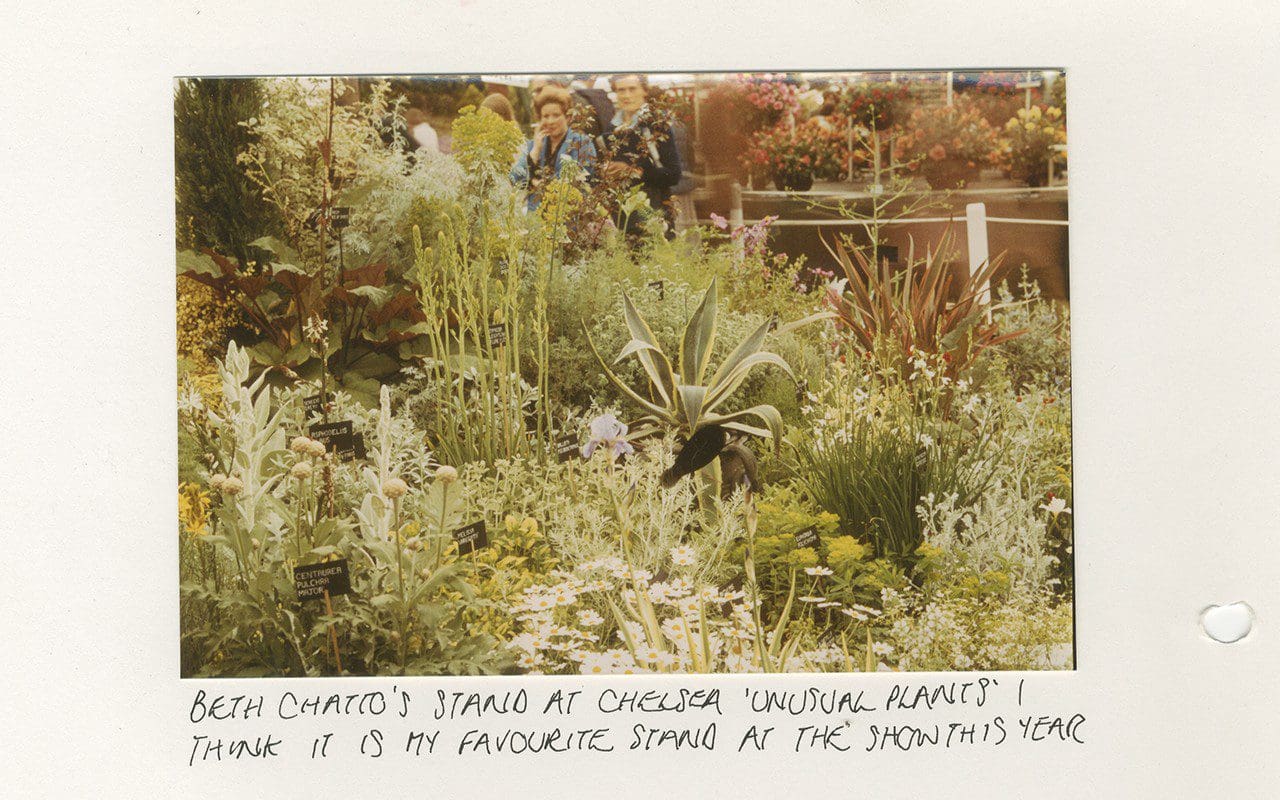 A page from Dan’s 1980 Wisley notebook
A page from Dan’s 1980 Wisley notebook
At that point no one else was doing what Beth was doing and, when I met Frances Mossman, who commissioned me to make my first garden five years later, it was those show stands that brought us together. We talked at length about Beth’s ethos, the excitement of combing her catalogues of beautifully penned descriptions and our resulting purchases.
Of Crambe maritima, she wrote, “Adds style and grandeur to the filigree grey and silver plants. Waving, sea-blue and waxen, the leaves alone can dominate the border edge, while the short stout stems carry generous heads of creamy-white flowers in early summer. The stems are delicious, blanched in early spring, served as a vegetable. 61 cm.”
While Gladiolus papilio is, “Strangely seductive in late summer and autumn. Above narrow, grey-green blade-shaped leaves stand tall stems carrying downcast heads. The slender buds and backs of petals are bruise-shades of green, cream and slate-purple. Inside creamy hearts shelter blue anthers while the lower lip petal is feathered and marked with an ‘eye’ in purple and greenish-yellow, like the wing of a butterfly. It increases freely. Needs warm well-drained soil. 91 cm.”
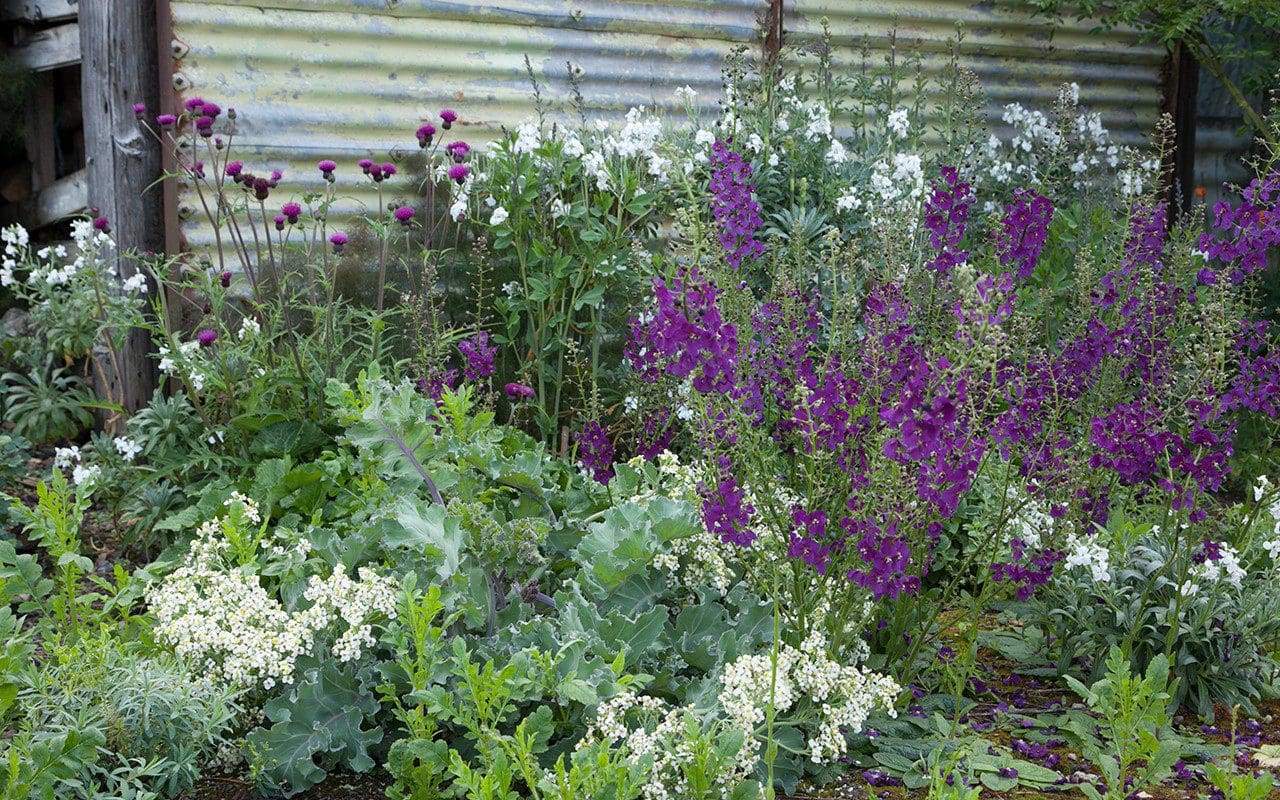 Crambe maritima with Verbascum phoenicium ‘Violetta’, Cirsium rivulare ‘Trevor’s Blue Wonder’ and Matthiola perenne ‘Alba’ in the gravel by the barns
Crambe maritima with Verbascum phoenicium ‘Violetta’, Cirsium rivulare ‘Trevor’s Blue Wonder’ and Matthiola perenne ‘Alba’ in the gravel by the barns
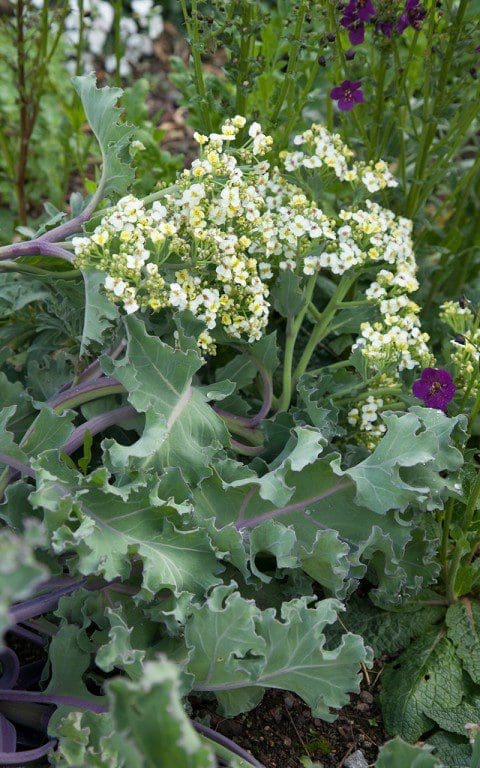 Crambe maritima
Crambe maritima
We came to rely upon her nursery of then ‘unusual plants’; me with a long border I had planted in my parents’ garden, and Frances with her own first garden in Putney. Unusual Plants was the place we would go to help us make that first garden together and, when we started making the garden at Home Farm in 1987, it was Frances who wrote to Beth to tell her of her positive influence and of what we were doing there to make a garden without boundaries. Beth wrote back with careful responses and encouragement. Once I had got over my shyness, I too started to write and we struck up a friendship from which I will always draw inspiration and refer back to as pivotal in my own development.
Beth made an indelible impression with her words, wisdom and practical application of good horticulture. In this country she was arguably the link back to the beginnings of William Robinson’s naturalistic movement and an informality that drew inspiration from nature. Her writings were always dependable and combined the artistry of an accomplished planting designer with the fundamental practicality of someone who had seen how plants grew in the wild and knew how to grow them to best effect in combination in a garden.
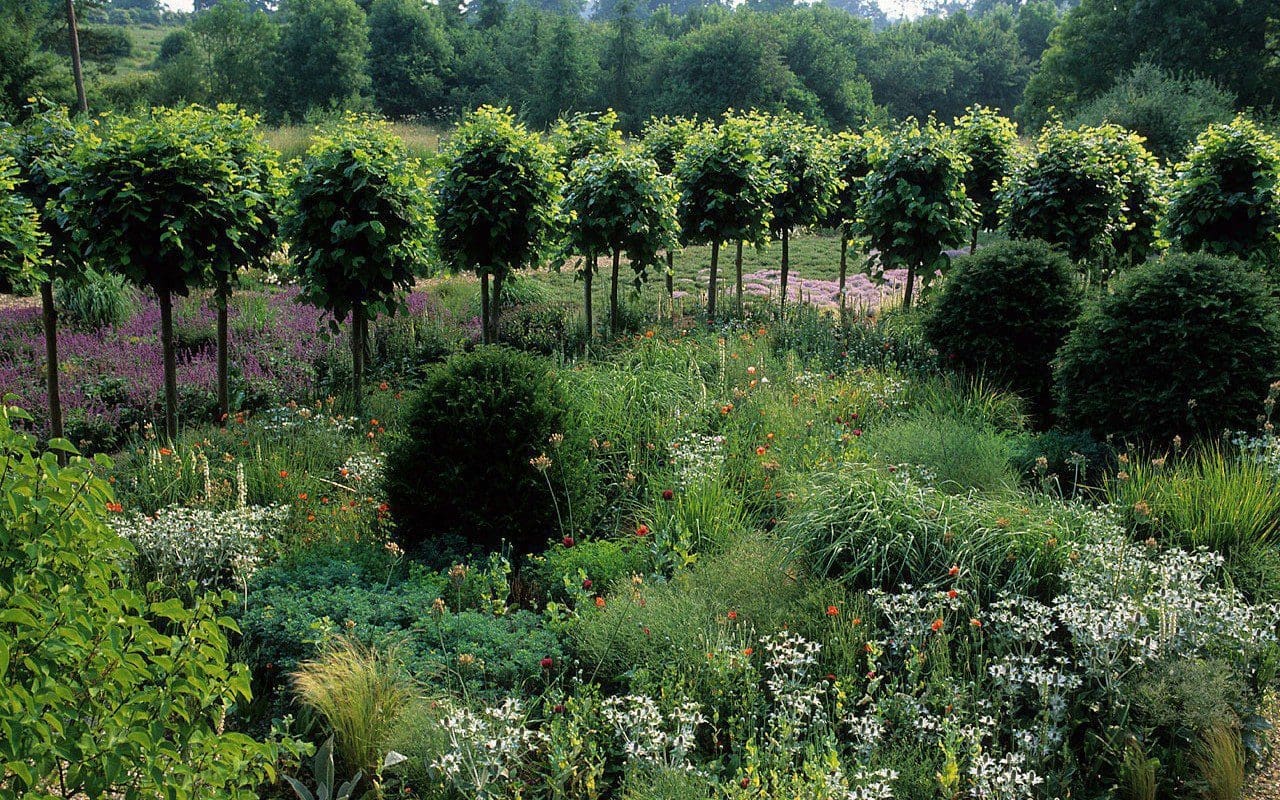 The gravel garden at Home Farm in 1998. Planting included Verbascum chaixii ‘Album’, Nectaroscordum siculum, Glaucium flavum var. aurantiacum, Stipa tenuissima, Limonium platyphyllum and Eryngium giganteum, all from Beth Chatto Nursery. Photo: Nicola Browne
The gravel garden at Home Farm in 1998. Planting included Verbascum chaixii ‘Album’, Nectaroscordum siculum, Glaucium flavum var. aurantiacum, Stipa tenuissima, Limonium platyphyllum and Eryngium giganteum, all from Beth Chatto Nursery. Photo: Nicola Browne
If you study Chelsea today, it is easy to overlook the influence she had on the industry of nurserymen and designers. The ‘unusual plants’ that were her palette are no longer so, and the way in which they were combined naturalistically on her stands has become the status quo. Rare now are the perfect bolts of upright lupins and highly-bred, colourful perennials, not so the mingled informality of plants that are closely allied to the native species, many of which had their origins at her nursery.
Though we will all miss her presence after her sad departure last weekend, her influence will remain strong. In the hands of Beth’s trusted team, led by Garden and Nursery Director, Dave Ward and Head Gardener, Åsa Gregers-Warg, the gardens and nursery have never been better. In recent years, as Beth’s health has deteriorated, Julia Boulton, her granddaughter, has firmly taken the reins and, as well as ensuring that the gardens and nursery continue into the future, has been responsible for setting up the Beth Chatto Education Trust and, this year, a naturalistic planting symposium in her name which takes place in August. At its heart the gardens will become a teaching centre, a living illustration of Beth’s passion for plants and her ecological approach to gardening.
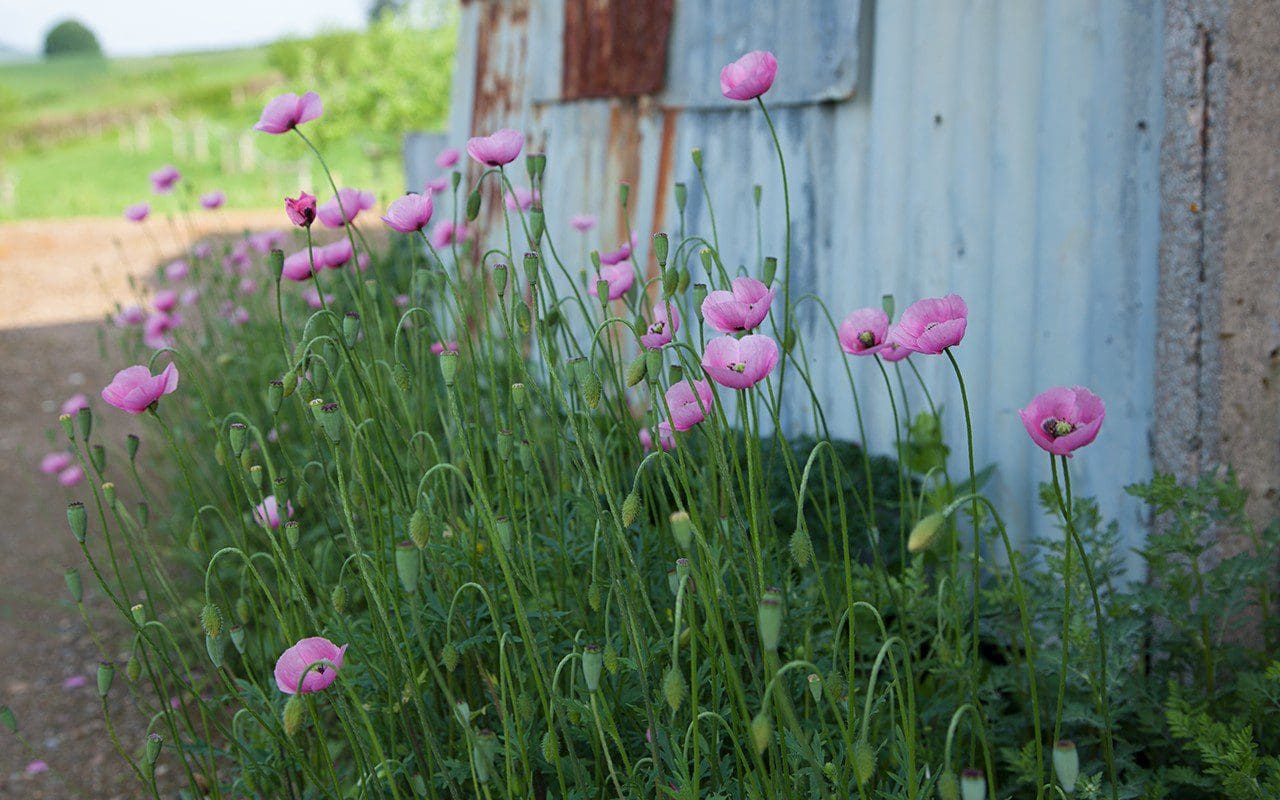
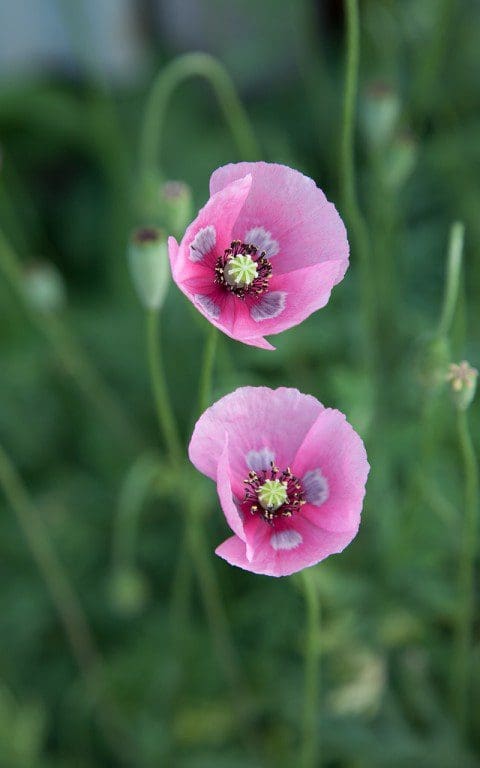 ‘Beth’s Poppy’ – Papaver dubium ssp. lecoquii var. albiflorum
‘Beth’s Poppy’ – Papaver dubium ssp. lecoquii var. albiflorum
Looking around my garden this morning, I can see Beth’s influence almost everywhere in the plants that are grouped according to their cultural requirements. Be it the ‘pioneers’ in the ditch, which have to battle with the natives, or the colonies of self-seeders I’ve set loose in the rubble by the barns, her teachings and plant choices are everywhere. Her plants also connect me to a wider gardening fraternity, a reminder of her generosity and willingness to share. The Papaver dubium ssp. lecoquii var. albiflorum that has seeded itself around the vegetable garden was first given to me by Fergus Garrett as ‘Beth’s Poppy’, since she had passed on the seed, while the Ferula tingitana ‘Cedric Morris’ growing against the breezeblock wall by our barns, was collected by her great friend, the artist and aesthete, who helped open her eyes to the beauty of plants.
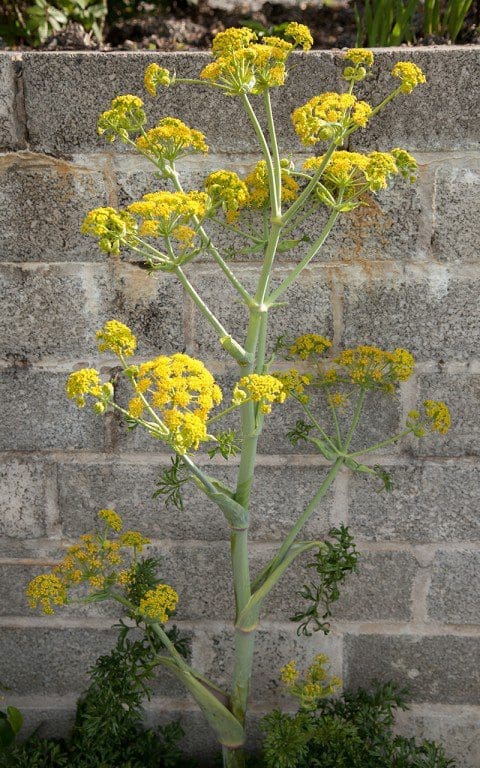 Ferula tingitana ‘Cedric Morris’
Ferula tingitana ‘Cedric Morris’
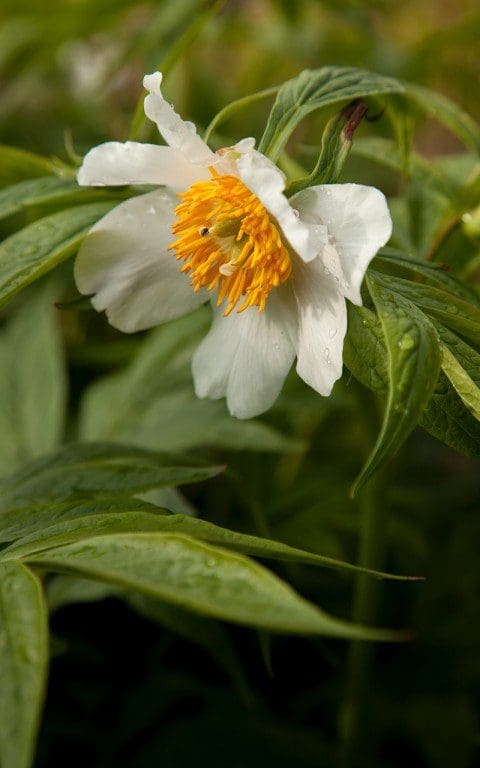 Paeonia emodii ‘Late Windflower’
Paeonia emodii ‘Late Windflower’
A visit to the nursery is still one of my favourite outings. I can guarantee quality and know that I will find something that I have just seen growing right there in the garden and have yet to try for myself. About twelve years ago, on a trip that culminated in a full notebook and an equally full trolley, Beth gave me a plant of Paeonia emodii ‘Late Windflower’ accompanied with the usual words of good advice about its cultivation. Sure enough, it is a good plant both in its ability to perform and in terms of its elegance. I moved it carefully from the garden in Peckham and divided it the autumn before last to step out in an informal grouping in the new garden. Last Sunday, although I did not know that this was the day she would finally leave us, the first flower of the season opened. As is the way with a plant that has a heritage, I spent a little time with her, pondering aesthetics and practicalities. I know for certain that it will not be my last conversation with Beth.
Beth Chatto 27 June 1923 – 13 May 2018
27 June 1923 – 13 May 2018
Words: Dan Pearson / Photographs: Huw Morgan
Published 19 May 2018
In March, the week after my mum died, we received an email from Simon Bray, a Manchester-based photographer and artist, asking if we might be interested in featuring him and a new book he was self-publishing. The book, Signs of Spring, is a collection of family photographs he has assembled of his childhood garden, which was initiated in part by the death of his father, and the importance the garden had in Simon’s memories of him. Although it was pure coincidence that Simon chose to write that week, it felt as though I was being offered an opportunity to remember mum in a new way. The more of Simon’s work I saw, the stronger this feeling became.
Simon, can you tell us how you came to study and work with photography ?
I began taking photographs when I moved to Manchester from Winchester for university. It was quite a shift for me, having lived in rural Hampshire my whole life, so I would walk everywhere, exploring the city by foot. Taking pictures helped me assimilate. I’ve never actually studied photography. I studied music, but as a drummer, so taking photos was something I could do on my own without requiring others and the practicalities that come with playing drums! Photography became one of many ways in which I like to express myself creatively and I’m now very fortunate to call it my job, making time for both artistic projects and commercial work.
You have a clear interest in place as a locus for memory. How did you come to realise and key in to this aspect of photography ? Has the idea of loss always been intrinsic to your work, or is it something that has developed over time ?
The notion of place has always been central to my practice. As I mentioned, Manchester was a starting point, but photographing places such as The Lake District helped me to understand that there was something about taking photographs in certain locations that excited me and made it easier to express myself. This has led me to explore my own connections to physical places and also work with others to explore theirs. It’s not always somewhere grand and romantic like the lakes, the garden from my family home has probably been the most significant place in my life and where I took many photographs.
The notion of loss came into my work after my dad passed away in December 2009. It took me quite a while to pick up my camera after that, nothing seemed significant enough to make pictures of but, over time, I began to appreciate that my photography could actually be hugely beneficial in helping me to express how I was feeling.
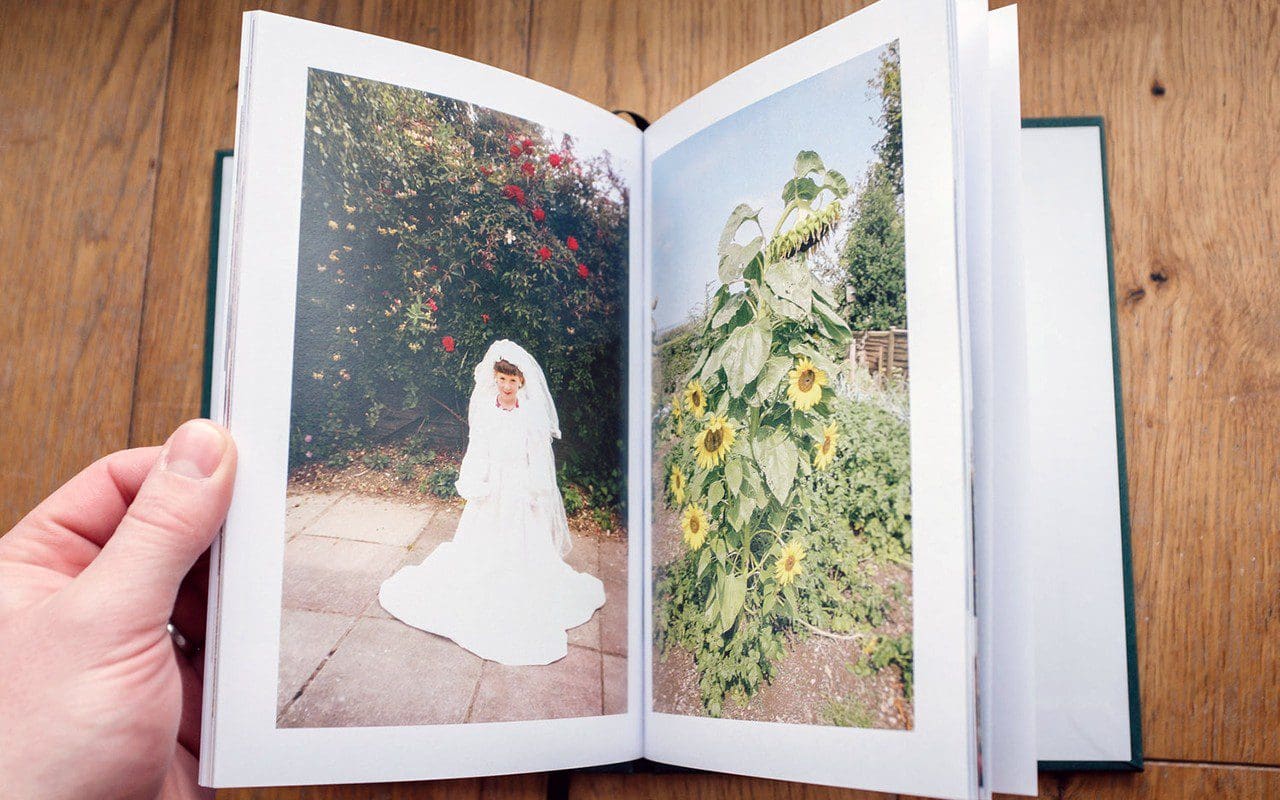
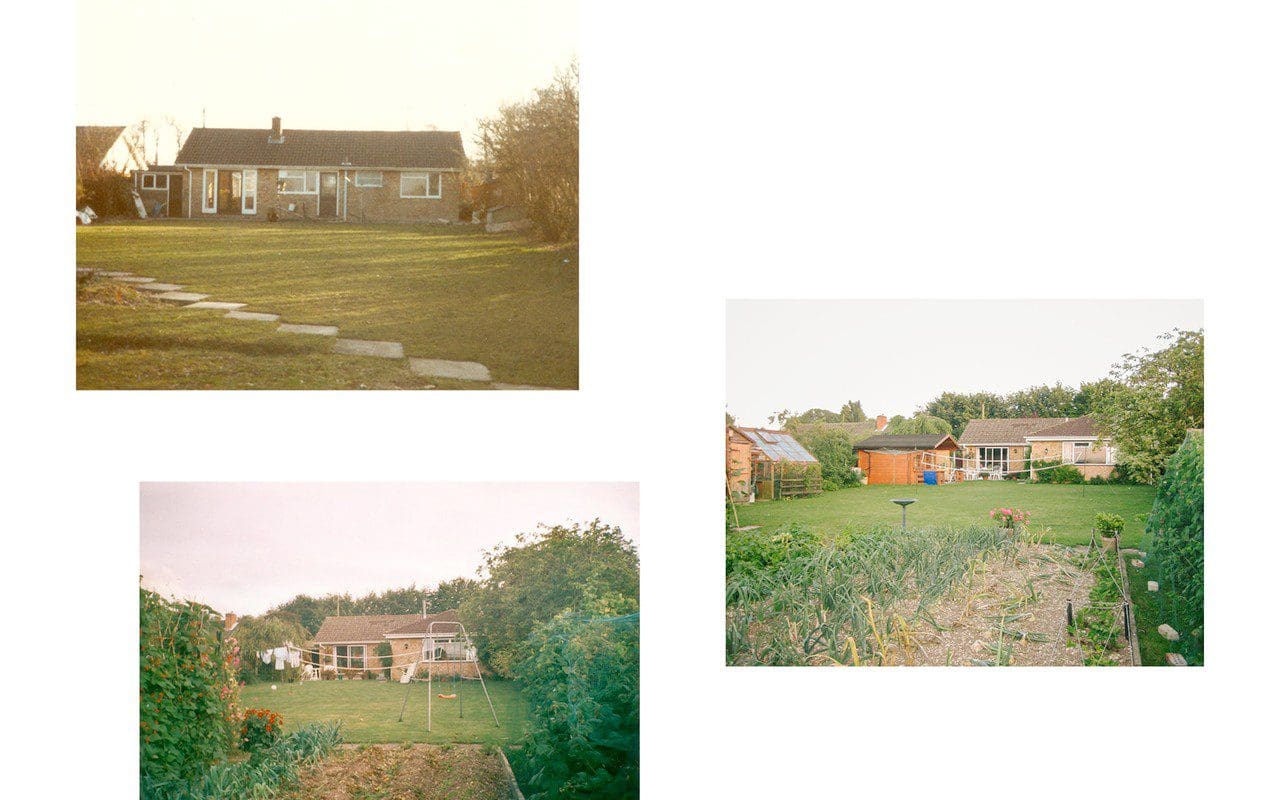
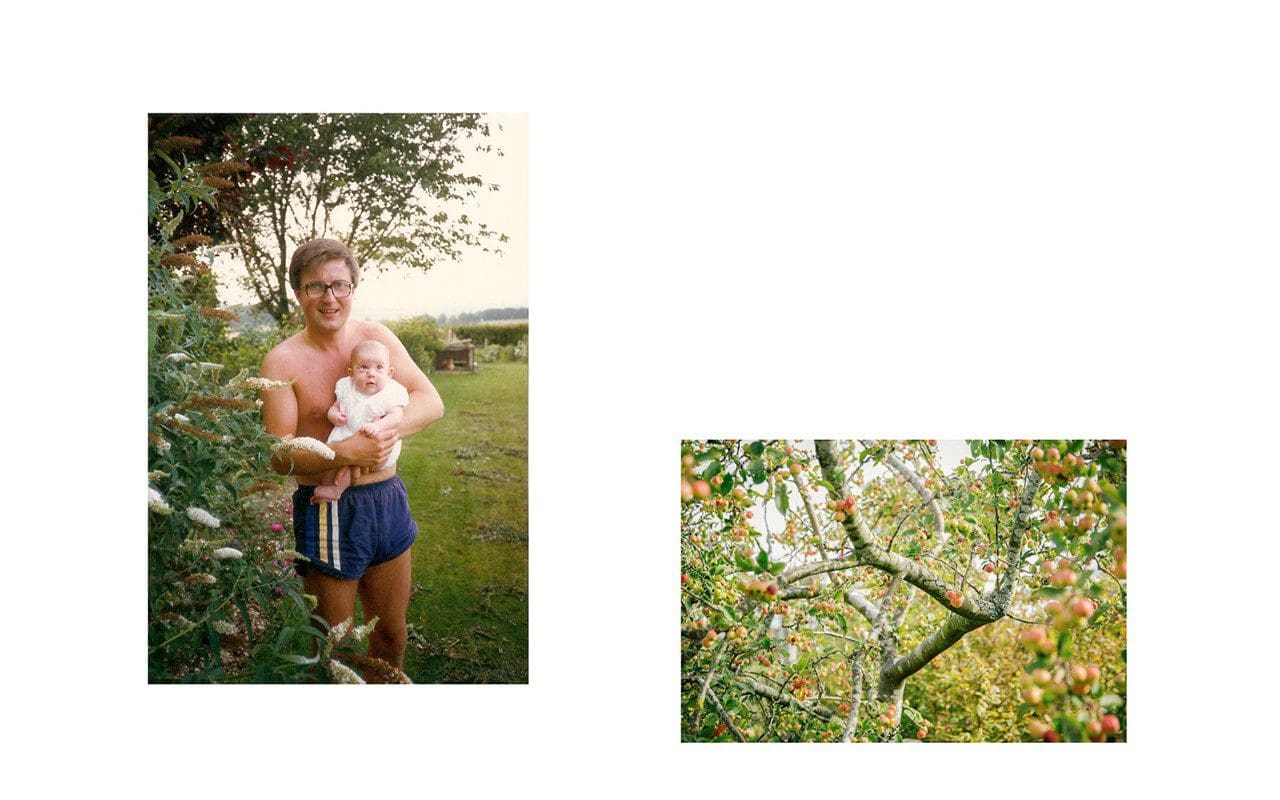
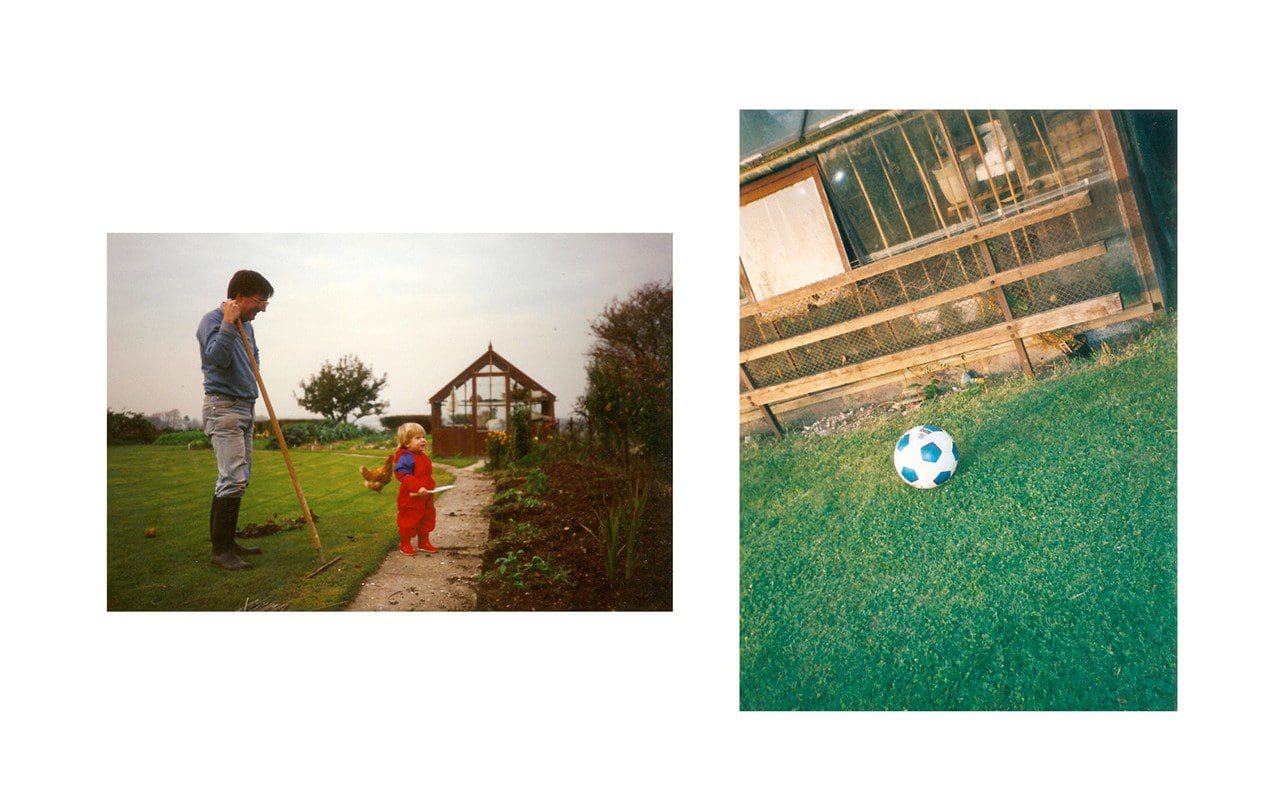 Spreads from Signs of Spring
Spreads from Signs of Spring
I was really moved by Signs of Spring, the book you have published in memory of your dad. Also your ongoing photography project 30th December which is also connected to memories of your father. Can you tell me how each of these projects came about, what they mean to you and what they provide for you ?
Both of those projects are about place, memory and loss, manifested in different ways. Signs of Spring is a collection of photographs that I’ve gathered together, found in family photo albums. It’s not a memorial as such, more a celebration of the life of our family in the garden where I grew up. Dad was a very keen gardener, having grown up on a farm in Cornwall he spent every hour of a daylight outside, producing vegetables and fruit and keeping everything very well maintained. It was a playground for my sister and I and the location for countless family occasions, so it holds many special memories for me. After dad passed away, mum vowed to keep the garden going, which she did very well, continuing to produce fruit and veg, but a couple of years ago she decided it was time for a fresh start and moved down to Penzance. That meant having to say goodbye to the house and garden I’d grown up in, which was far harder than I’d imagined. It felt like having to let go of Dad all over again, so I wanted to celebrate the garden by producing this book.
The 30th December project is very similar actually. It’s the anniversary of dad’s passing and, once I’d picked up my camera again, on each anniversary I’d go out and make pictures. Last year I made a series of handmade books with photographs taken at dawn on St. Catherine’s Hill in Winchester, somewhere we used to go as a family. The pictures aren’t necessarily about loss, they’re not inherently sad pictures, but it’s a process that helps me remember and engage with how I’m feeling on that day. I shall keep on making photographs on 30th December each year, wherever I am in the world.
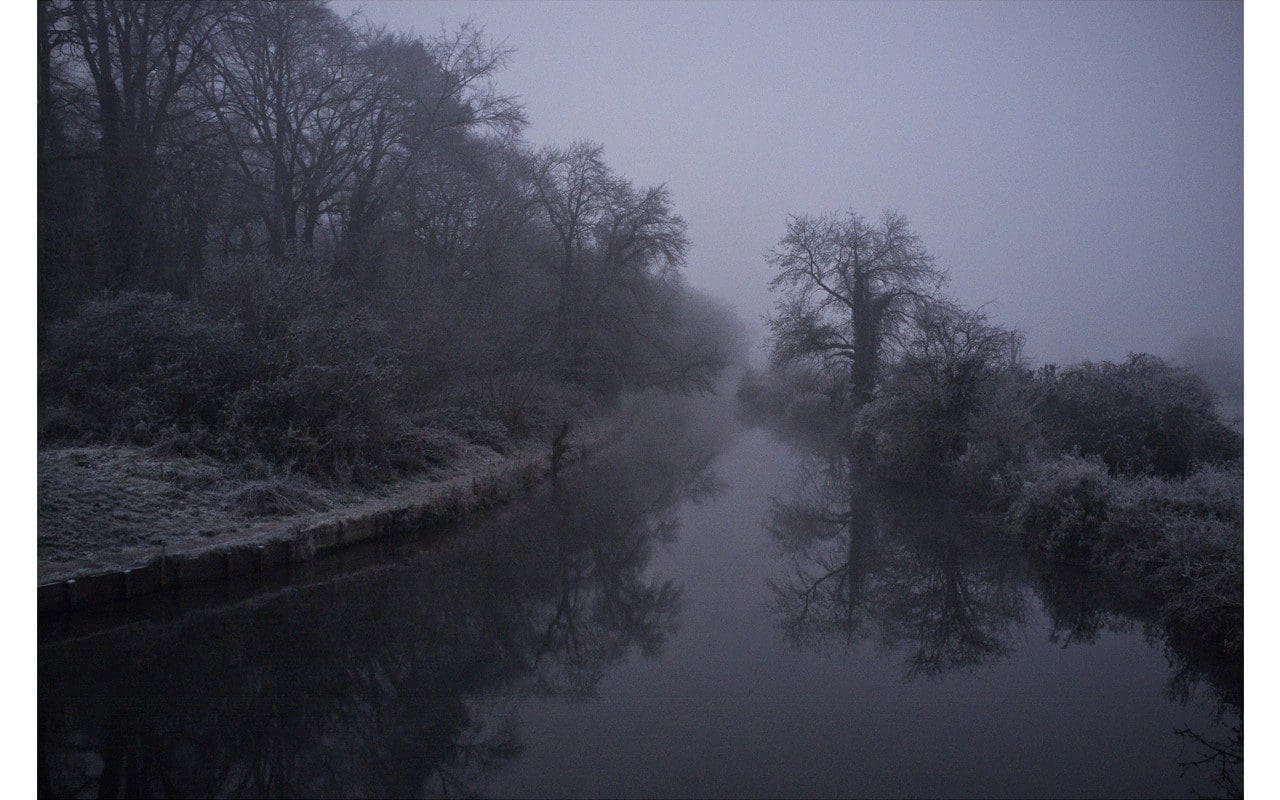
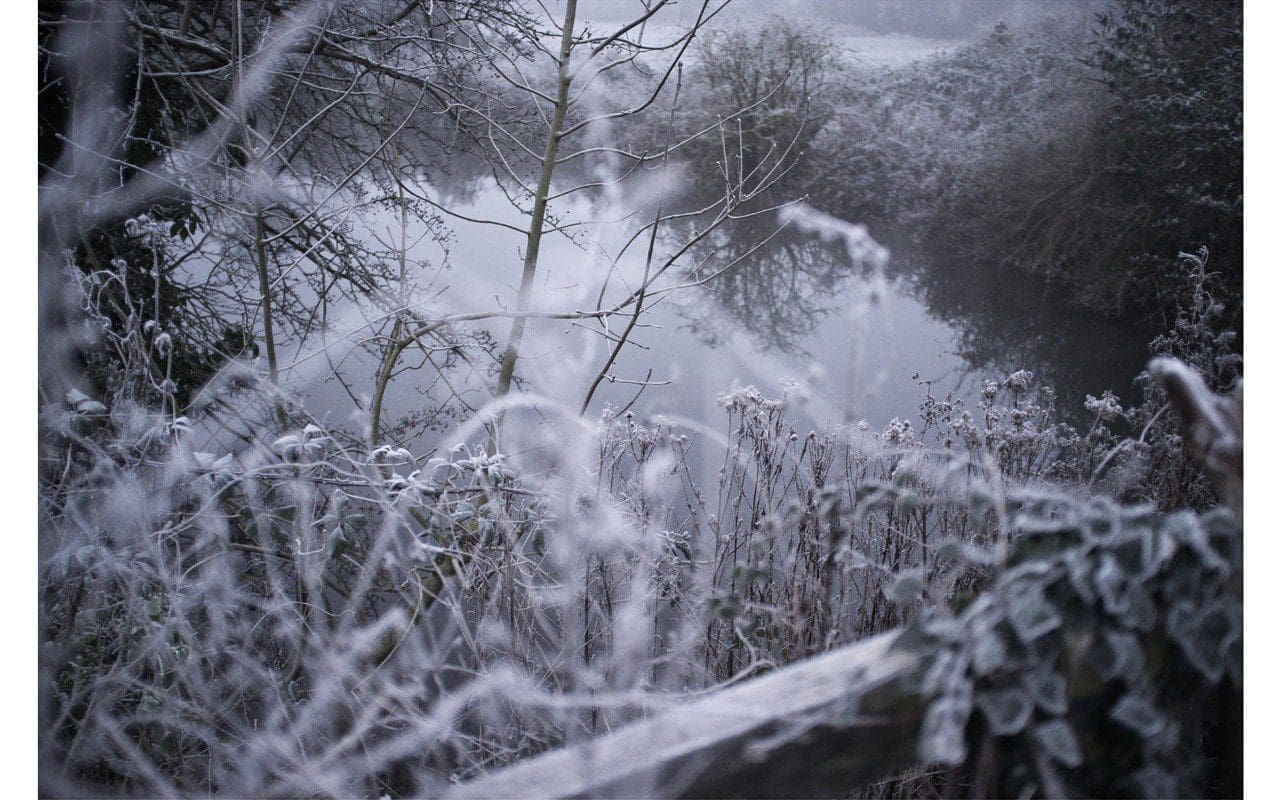
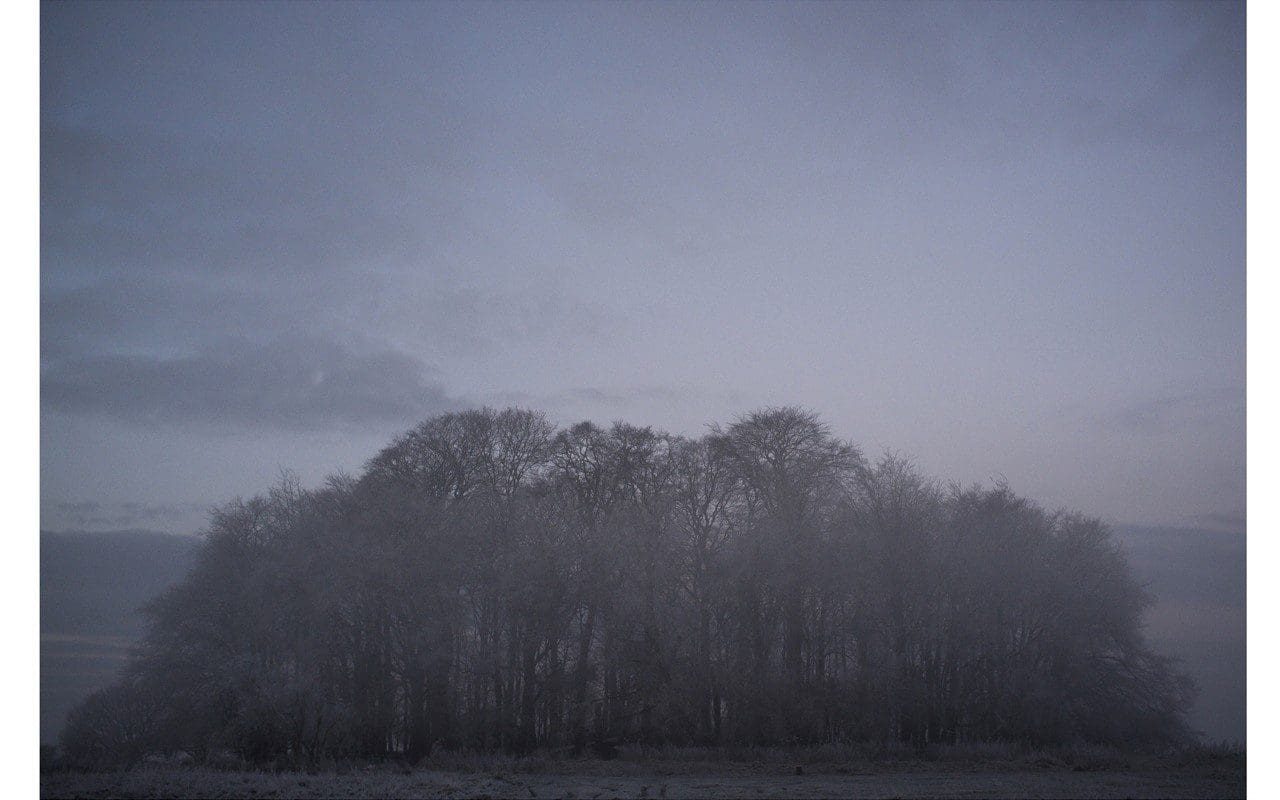
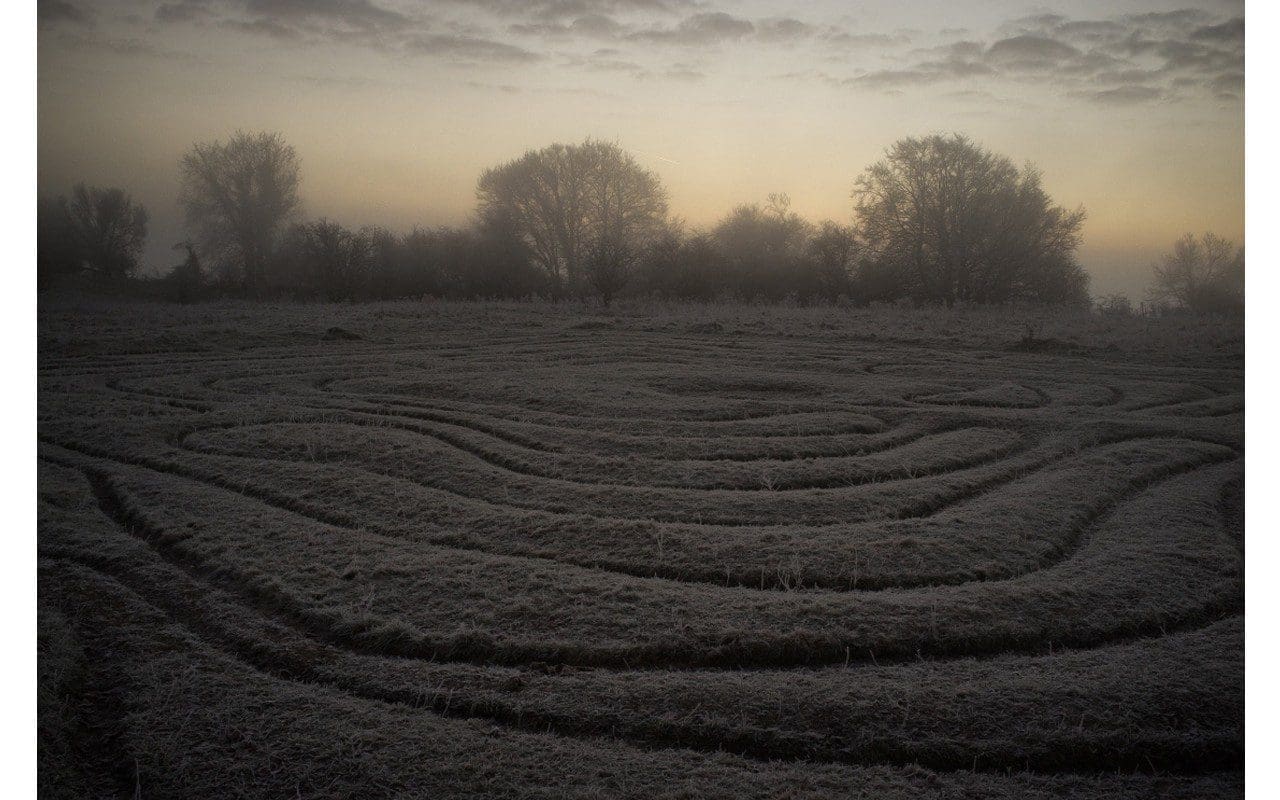
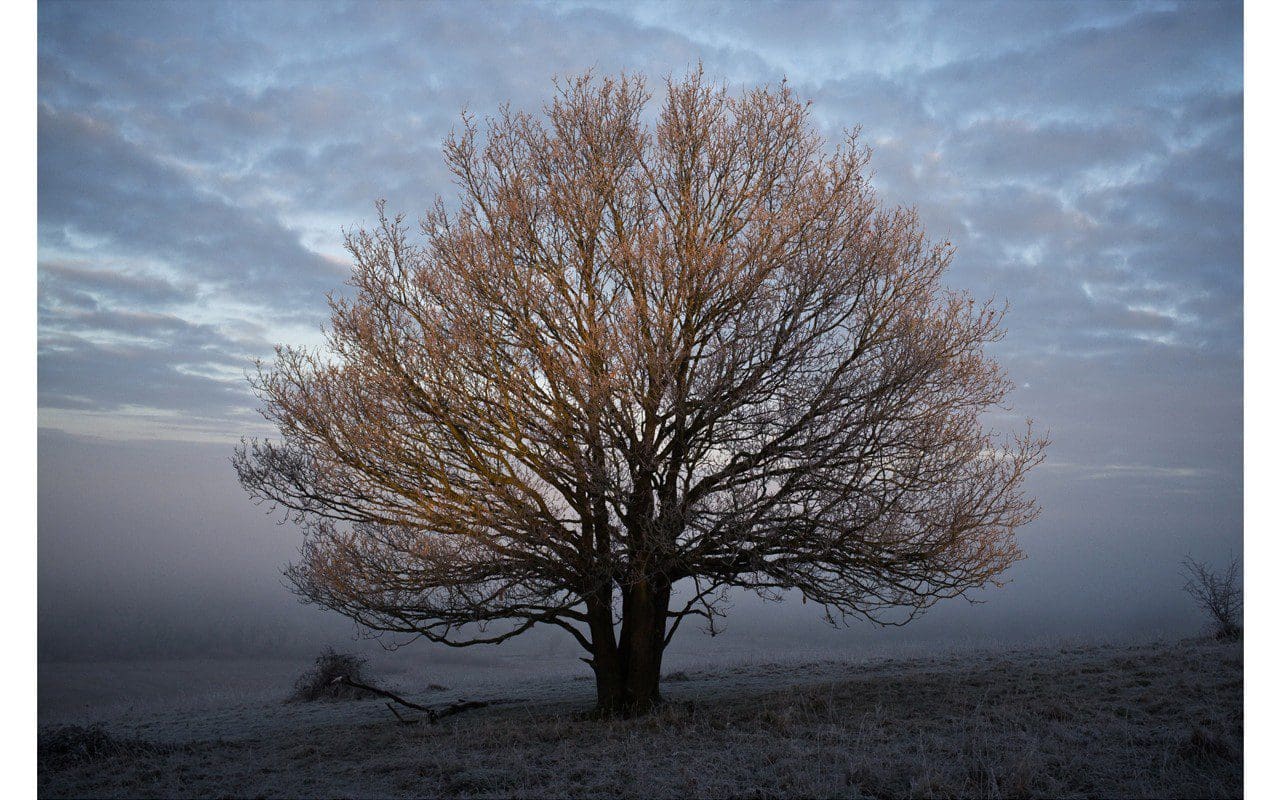 Photographs from 30th December
Photographs from 30th December
I am interested in how you see gardens as a receptacle for childhood and family memories. Can you tell us your thoughts about this and how gardens differ from other landscapes, both urban or rural ?
Unless you’re a farmer, your garden is a patch of the world that you’ve been gifted to take care of. You can do with it as you please, you can pave it over and not have to think about it, or you can cultivate it to feed your family, create a place to relax and share with others, or fill it with flowers for others to see and enjoy. There’s something very satisfying about a well-maintained front garden! It’s the sense of ownership and responsibility that makes it differ from urban and rural spaces, not that you can’t feel ownership of the town you live in or your favourite national park, but those are shared spaces, your approach differs to that of your own garden. I’ve recently moved to my first house that has a garden and I’m getting so much pleasure from looking after it. Simply just staring out the window at the birds feeding as I write this is making me feel relaxed!
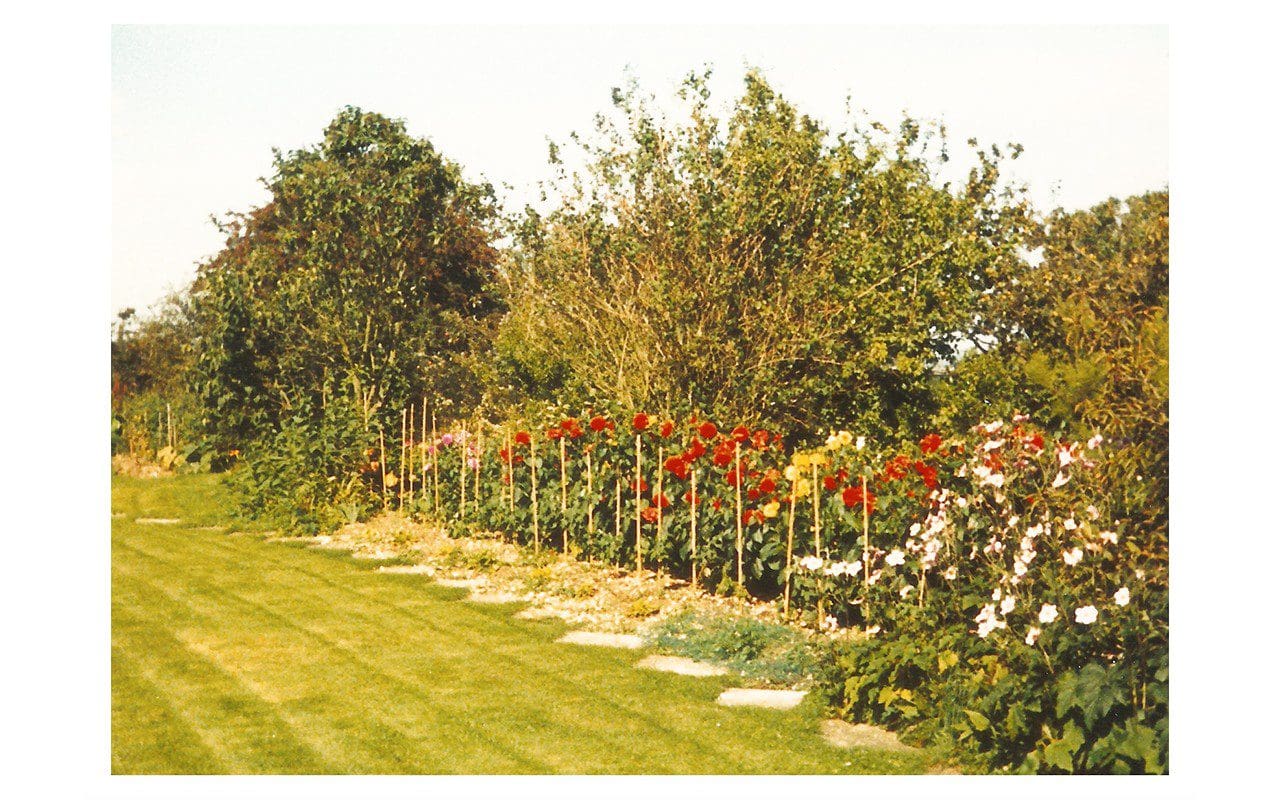
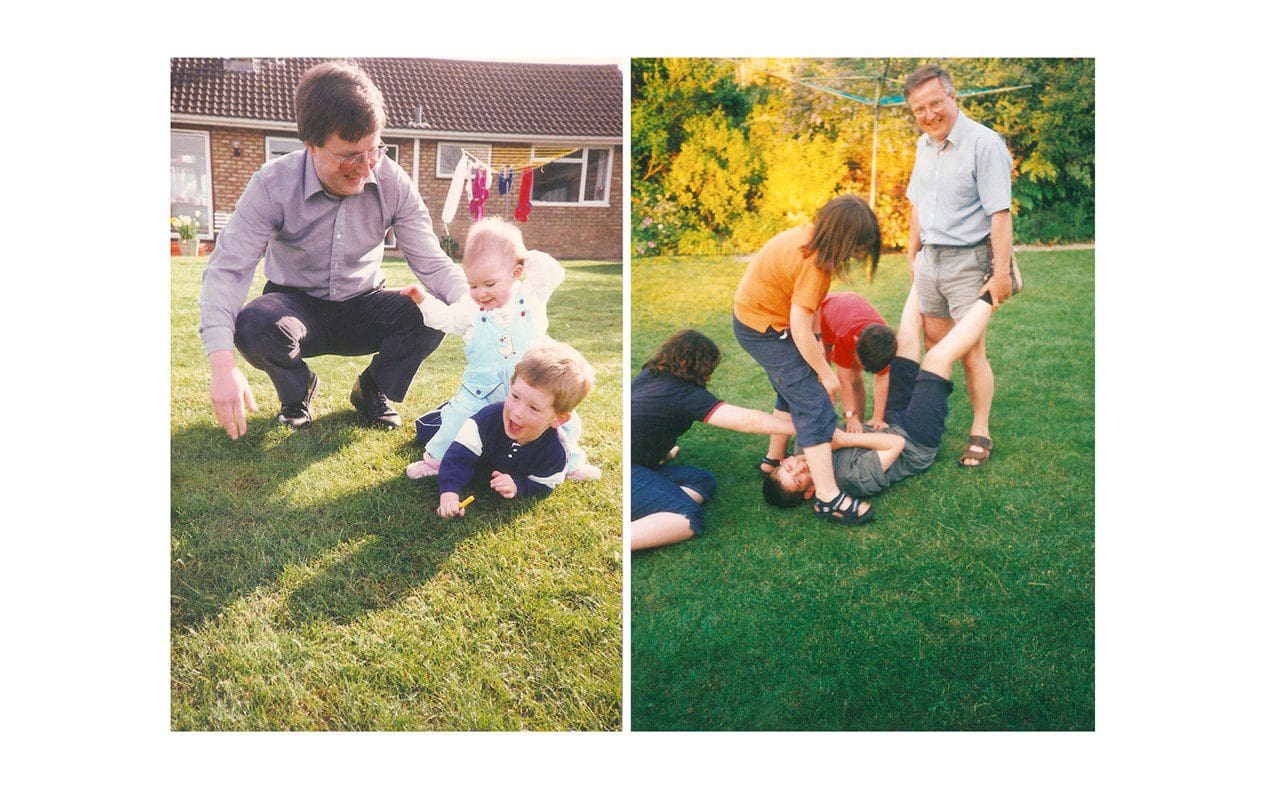 Spreads from Signs of Spring
Spreads from Signs of Spring
The Loved&Lost project looks at a wide variety of places through the prism of loss, memory and the passing of time. I found it very cathartic reading about other people’s experience of losing a loved one. Can you tell me more about how the project came about and what you learnt from it ?
As I alluded to earlier, after the loss of my father I found ways to try and help others engage with their loss, and this now manifests itself as the Loved&Lost project. I invite participants to find a family photograph of themselves with somebody who is no longer with us, we then return to the location of the photograph to re-stage it and record a conversation about the day. It’s amazing how impacting it is to return to the physical location of the photograph. It brings back so many memories and makes it all very tangible for the participant. I want to encourage them to engage with their loss in a different way. The photograph is simply a starting point, but the process allows us to have a conversation, to recall the day the first image was taken, to share their account of losing someone close to them, but also celebrate the person who is no longer here.
When dad passed away, lots of people asked me how I was, which is a very kind and natural thing to do, but in the mix of it all, I didn’t actually know the answer to the question and so I didn’t really want to talk about me, what I wanted to talk about was dad. I found myself in social situations recalling memories, jokes, anecdotes that he would have enjoyed, but not really being able to share them because there was no context for everyone else, so I wanted to create a forum in which it’s absolutely fine to share your favourite stories about that person that no-one else knew quite like you did.
The project is ongoing, and I learn something new from every person I meet. It’s not about having to be strong or getting over it after a certain amount of time – some people take part months after their loss, others many many years – the loss is still there, but how you engage with it varies. Lots of people end up restructuring their lives after a significant loss, your focus changes and priorities get realigned, it shapes you, not always in ways that you understand in the moment, but over time I find that most people feel it’s important to know that some good has come out of their pain, and for me, I’d like to think that Loved&Lost is that.
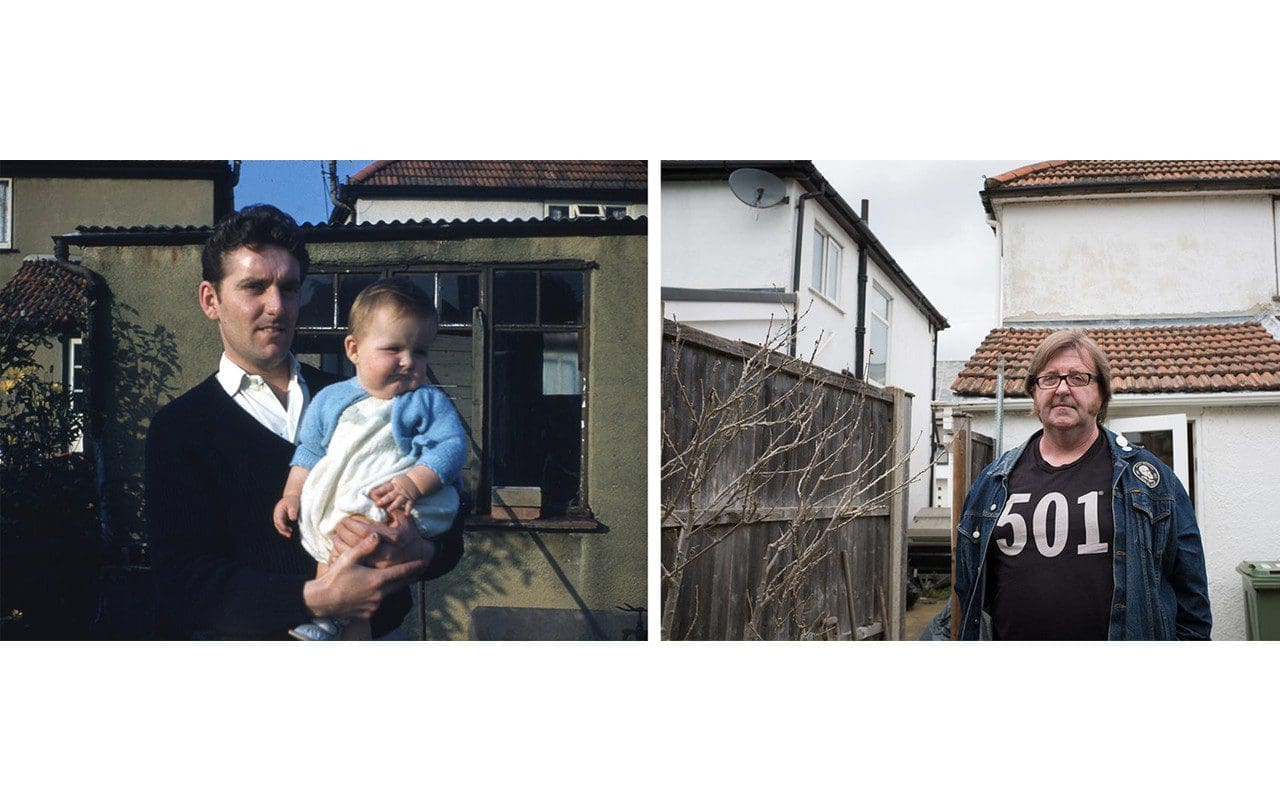
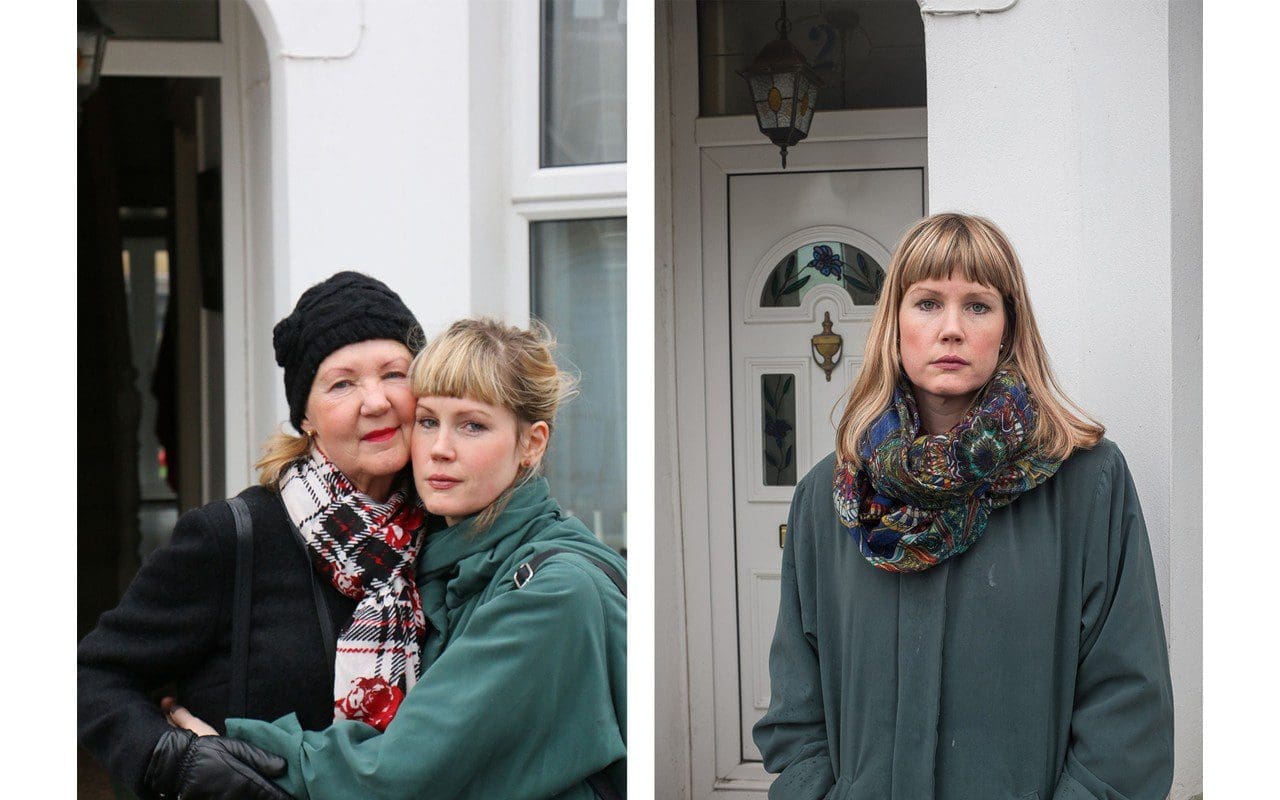
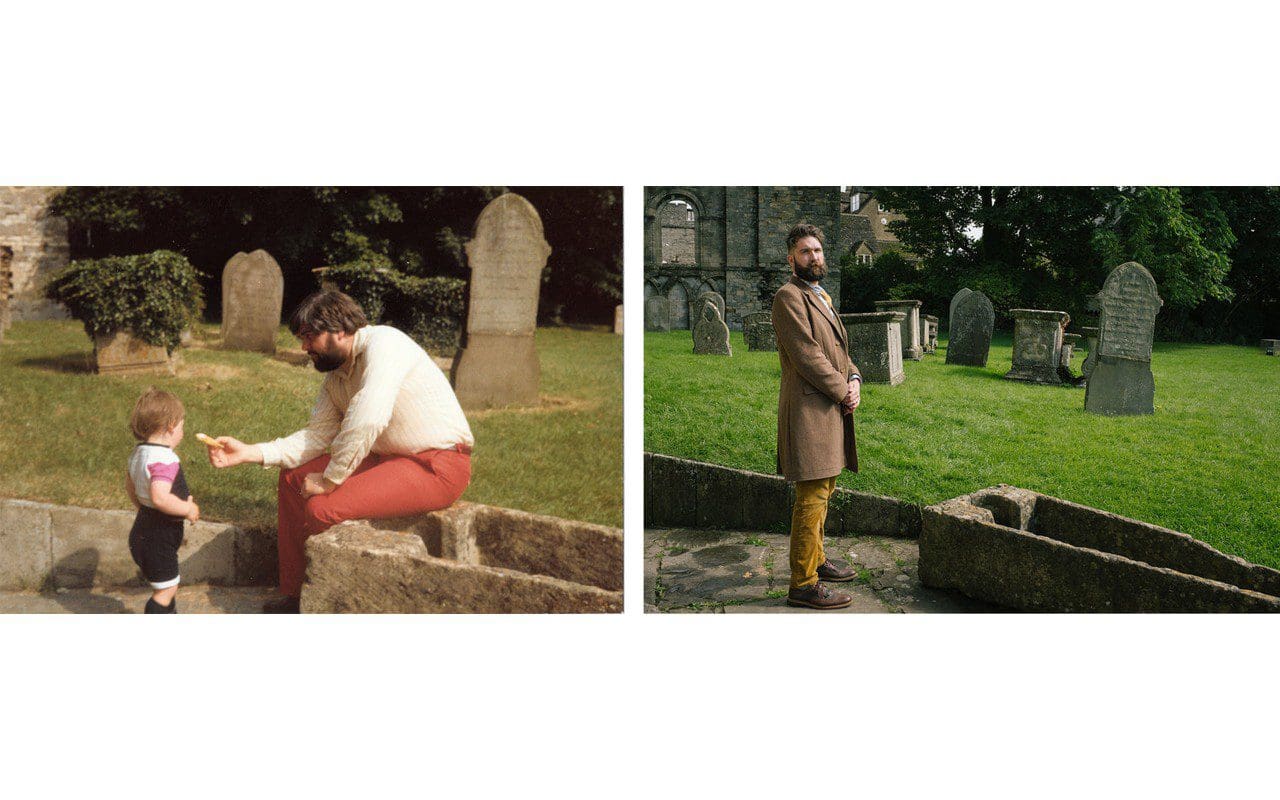 Double portraits of Paul, Emelie and Will from Loved&Lost
Double portraits of Paul, Emelie and Will from Loved&Lost
Much of your landscape photography has a very particular atmosphere of emptiness or vacancy, like stage sets where the protagonist has just left or is just about to arrive. Can you explain your feelings about ‘wild’ landscapes and how we relate to and inhabit these environments ?
I really like that analogy, because as much as the landscapes within the UK especially can be wild, most of them are fairly approachable as well. Obviously you need to be cautious and equipped according to the weather, but there are so many accessible and varied locations within these British Isles that can be truly breathtaking. So many of us use the outdoors as a means of escape. I will always feel better about life if I’ve spent the day outside, particularly in some mountains or by water, so it feels very natural to be drawn towards that as subject matter photographically. I quite intentionally don’t include people within my landscape photographs. In fact, sometimes there’s not much of anything in my work, probably just sky and mist with a bit of land at the bottom of the frame! I think that’s a result of my yearning for space. My mind seems to be full of thoughts and ideas all the time and stretching my legs and exploring somewhere new seems to not necessarily turn that off, but brings clarity and energises me mentally. The space required for that comes through in my images, which sometimes can appear bleak or vacant, but I suppose it’s a thoughtfulness or consideration that gets subconsciously built into the photographs.
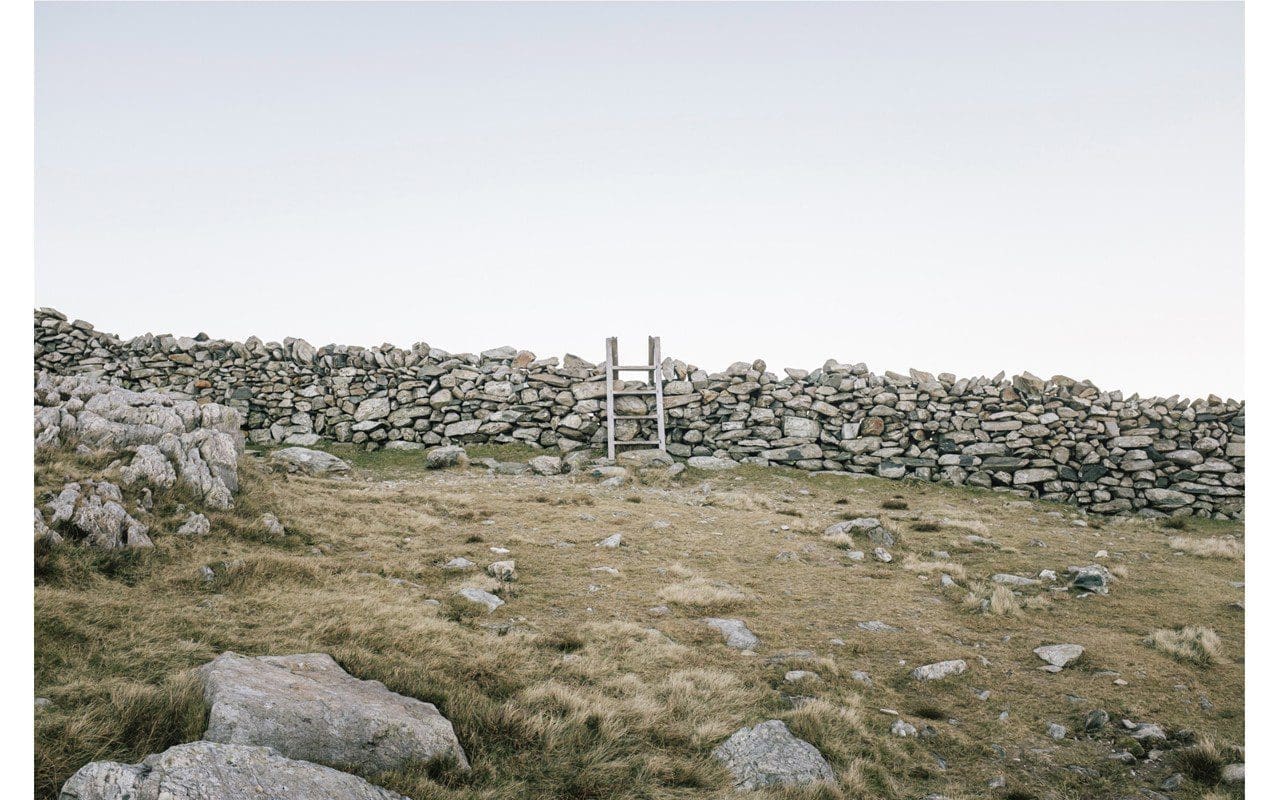
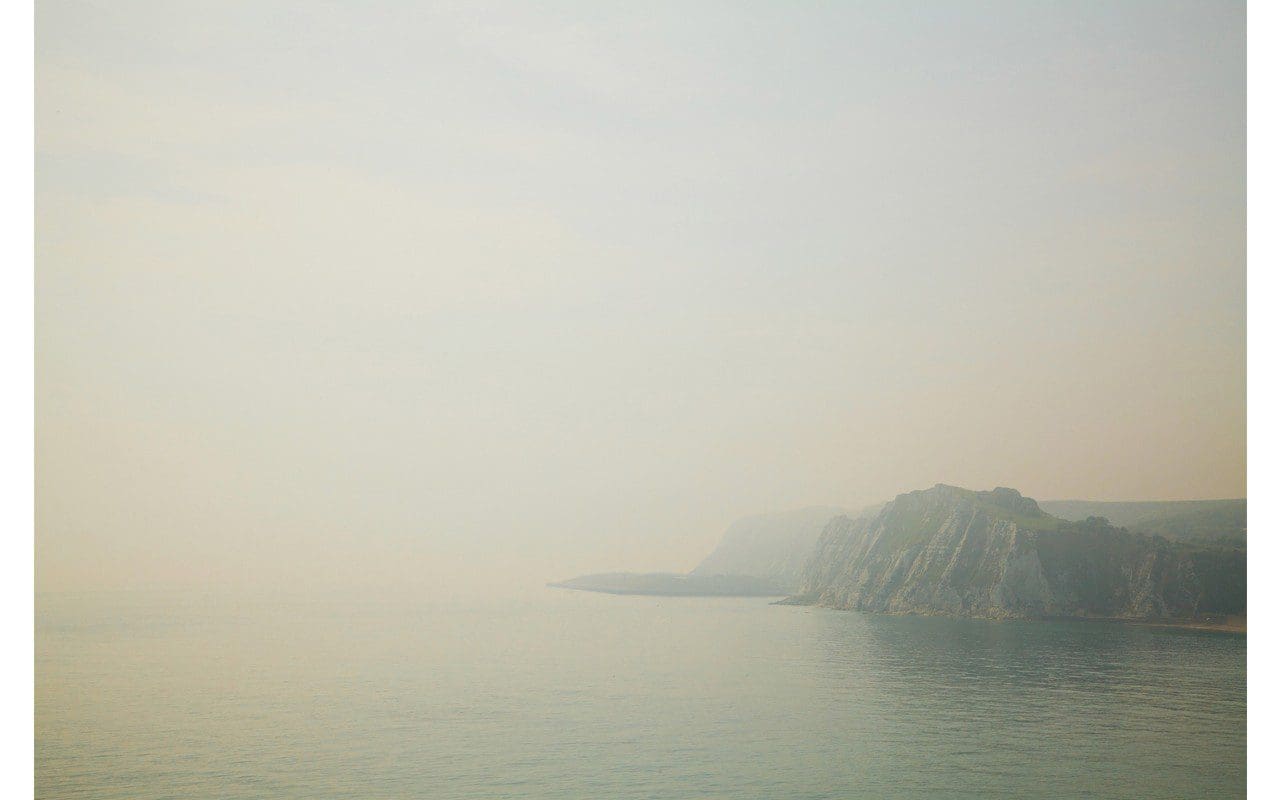
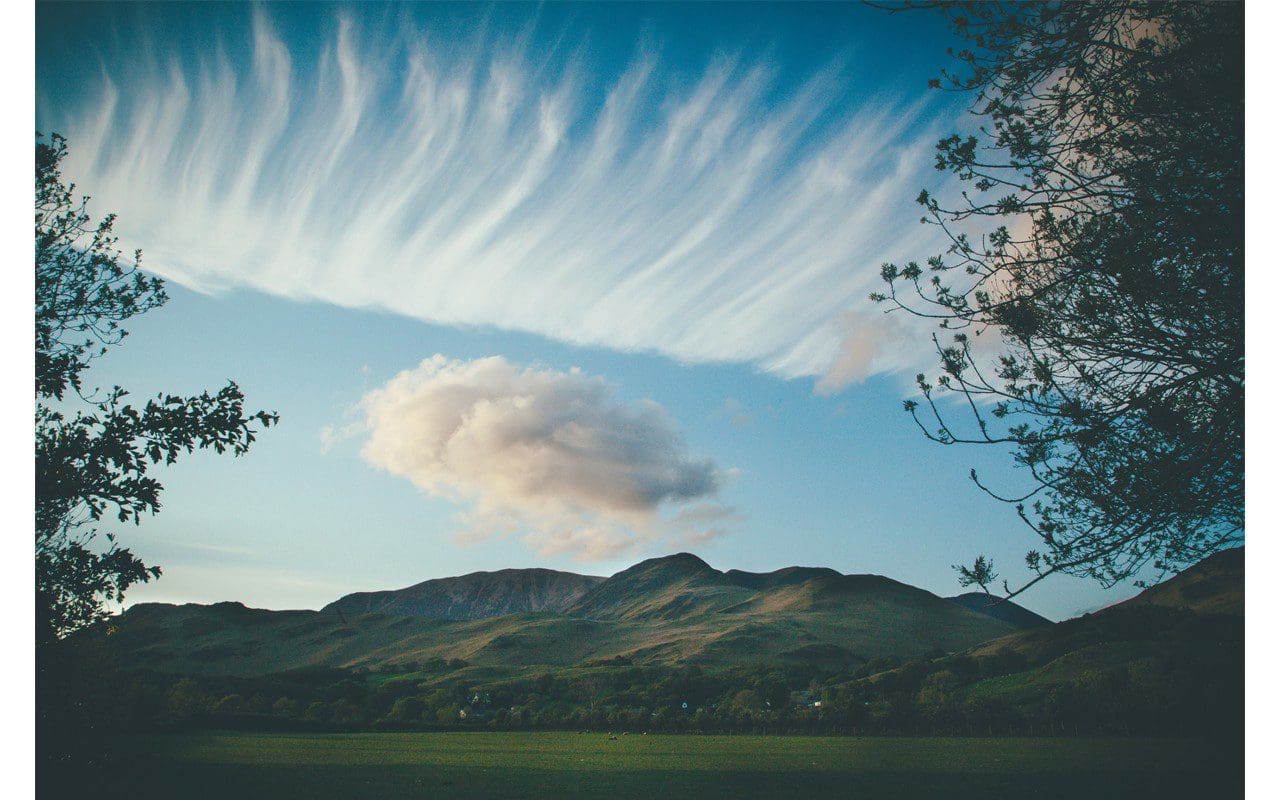
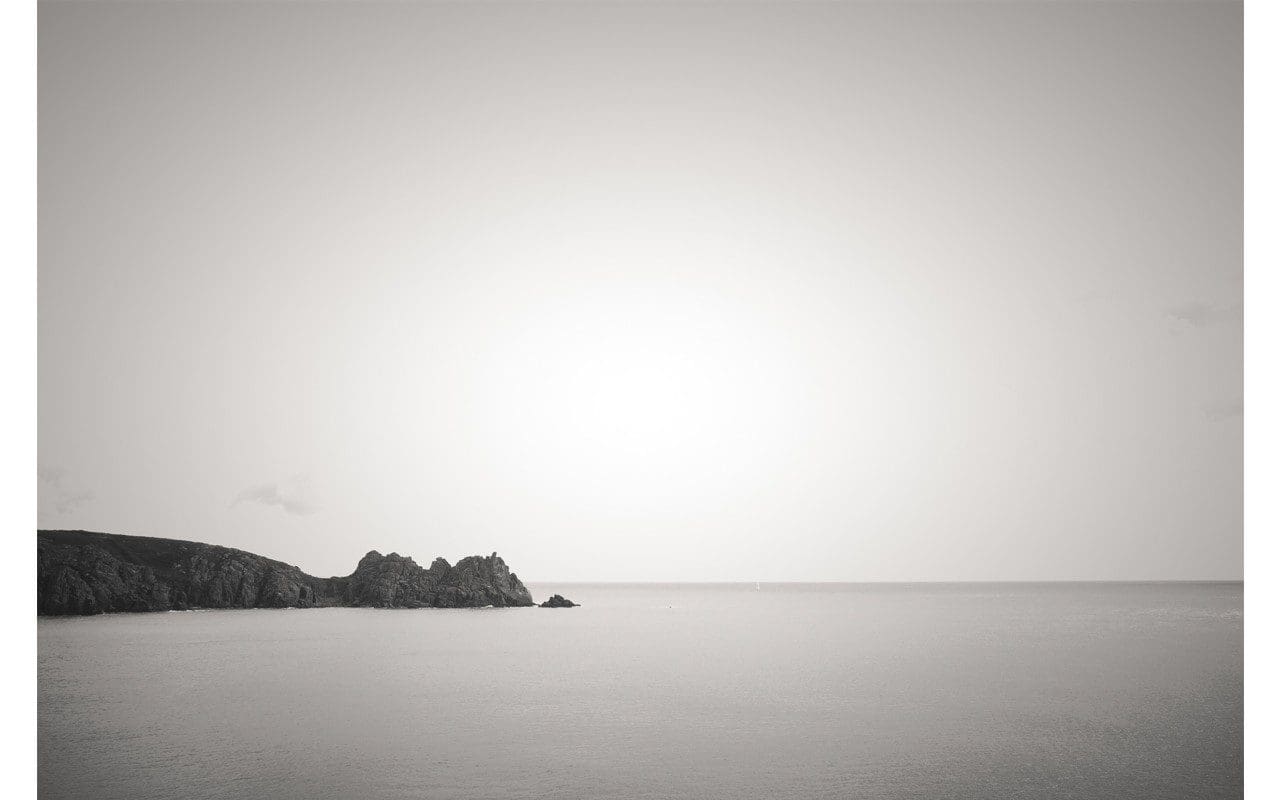
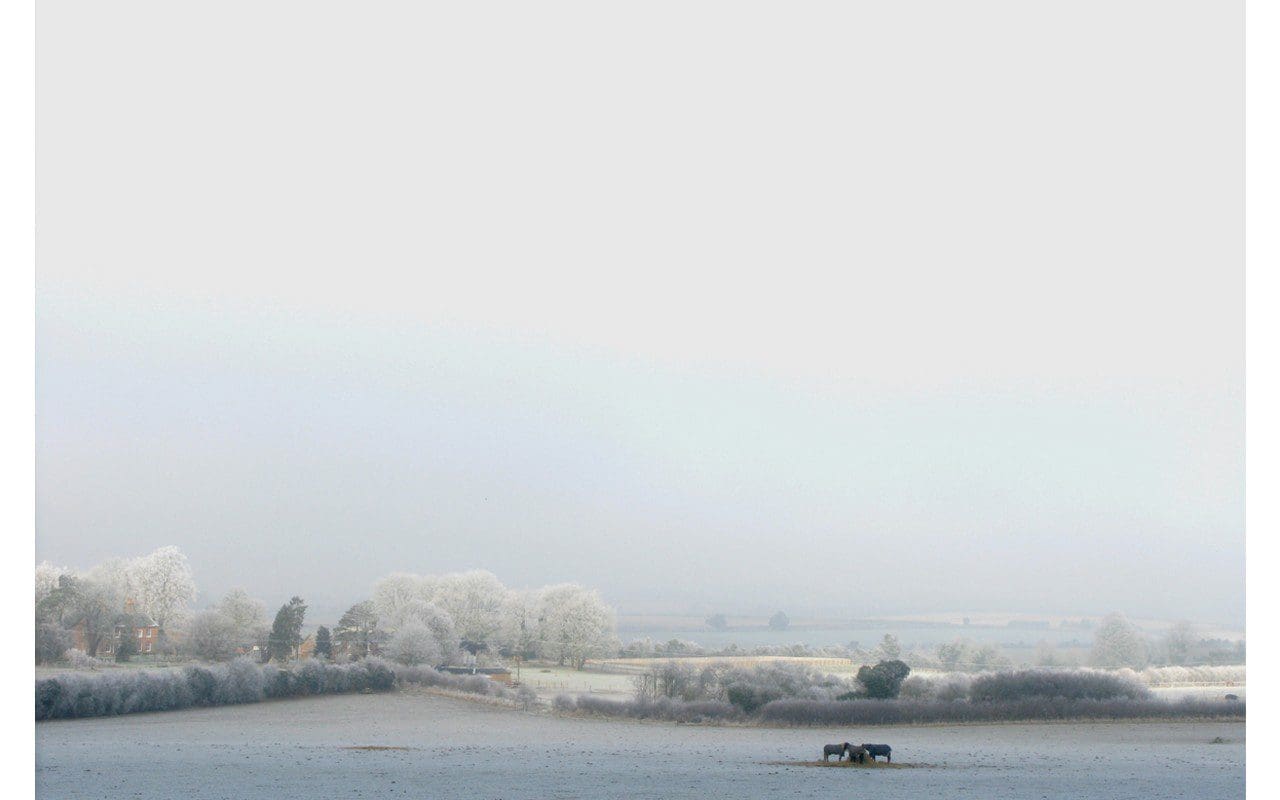 Photographs from Simon’s ongoing Landscape series
Photographs from Simon’s ongoing Landscape series
How did the The Edges of These Isles project come about and how did you collaborate with artist Tom Musgrove on it ?
Working with Tom came about after we did the Three Peaks Challenge together with a couple of friends. We established that we’d both like to be making more work inspired by landscape and that it would be very interesting to see how a painter and a photographer might be able to collaborate. It took us a couple of years, but we ventured all across the UK together, making work, sharing thoughts, ideas, music and establishing where our approaches to making work could meet and where they differed. We ended up making a 120 page book, a 25 minute film and have exhibited the work 3 times. It was a huge step forward in terms of my appreciation of what it means to be an artist and how I can engage with the subject matter before me and utilise it to express myself. The work I made on those trips is still some of my favourite that I’ve created. I’m a romantic at heart, so the aesthetic and notion of the sublime are very much in my mind when I’m working within the landscape, but I also want to bring myself into the image. I like to do my best to avoid making pictures that I know have been captured countless times before by awakening my senses in that moment to really understand how I’m going to make that picture, which is something I learnt from Tom.
What can you tell me about your involvement with One Of Two Stories, Or Both (Field Bagatelles), the piece by Samson Young that was commissioned for the 2017 Manchester International Festival ?
I was fortunate to be selected as one of six artists to take part in a fellowship with Manchester International Festival last year. This involved being placed within one of the festival commissions and I was very lucky to work with Samson Young, who had just represented Hong Kong at the Venice Biennale. It was incredible to see him at work, creating a 5 part radio play complete with live musicians, voice actors and foley artists, as well as constructing an installation for the Centre For Chinese Contemporary Art in Manchester. He invited me to play drums in the radio pieces and make a photograph for the installation, both of which were a huge privilege. I also got to engage with the other young artists and experience many other performances within the festival, which really broadened my horizons in terms of what I create and who my audience is. Not that I have the answers for those things yet, but it was a hugely inspiring experience.
Samson’s piece was all about the hypothetical journey of Chinese migrants to Europe at the start of the century travelling by train. It was amazing to observe how Samson created that world through the medium of radio, utilising the music, actors and created sounds. It formed amazing visual landscapes in my mind and really informed how I engaged with the characters in the piece. It got me thinking about how I construct the landscape images that I make, how much of it is me simply photographing what’s in front of me, and to what extent do I build the feel and atmosphere of an image in how I shoot and edit it.
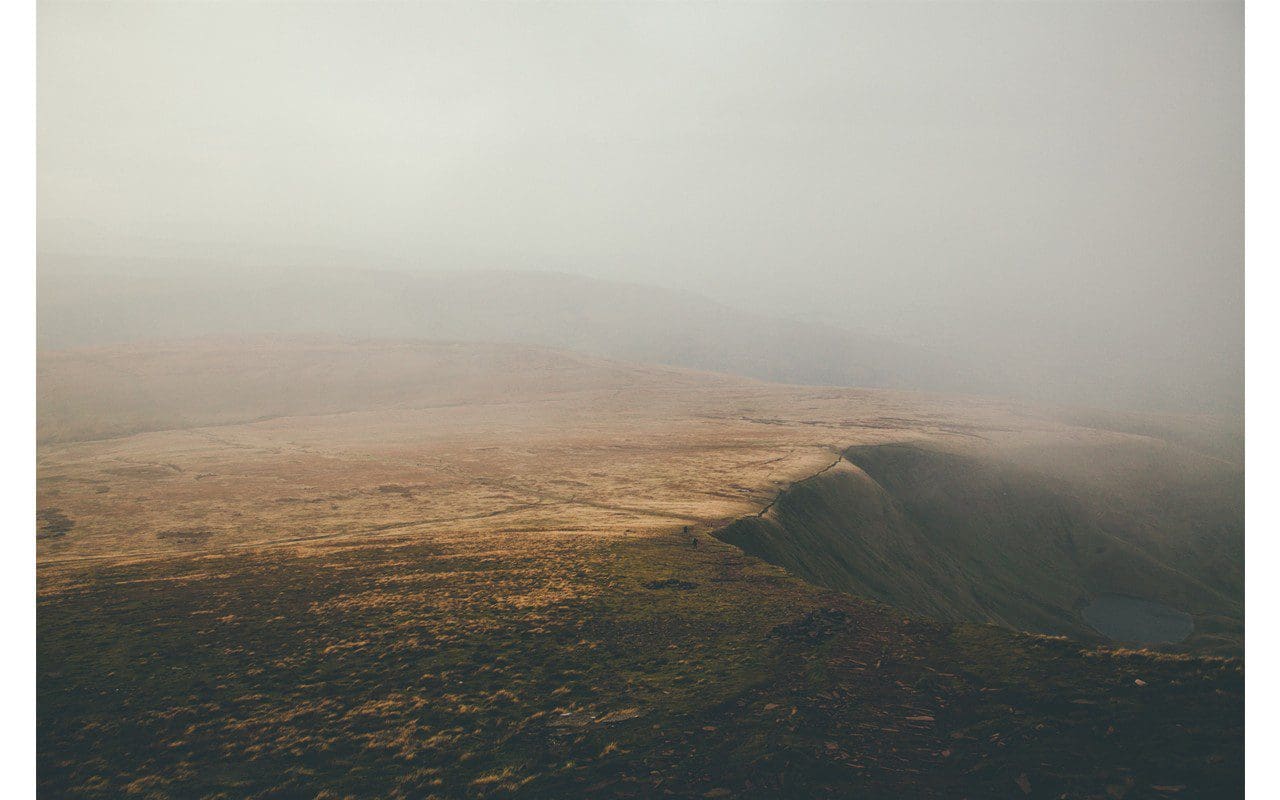
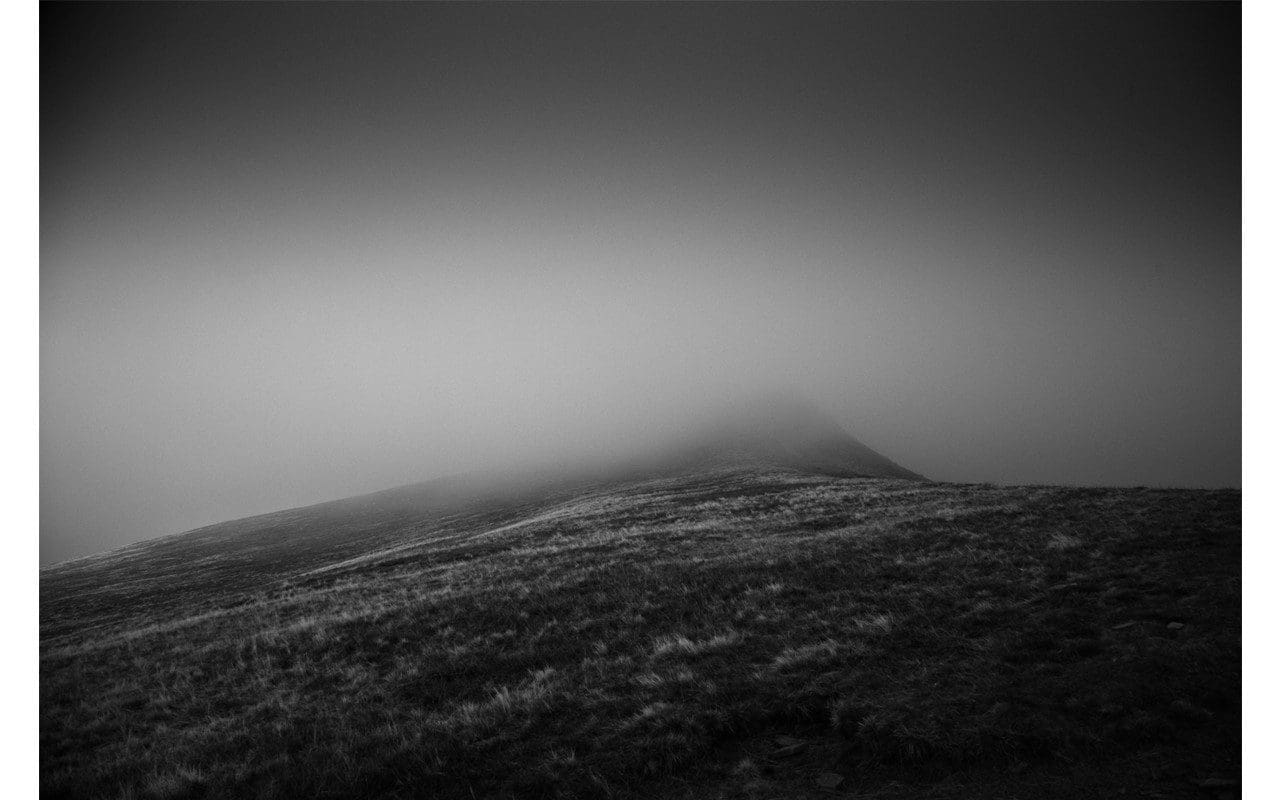
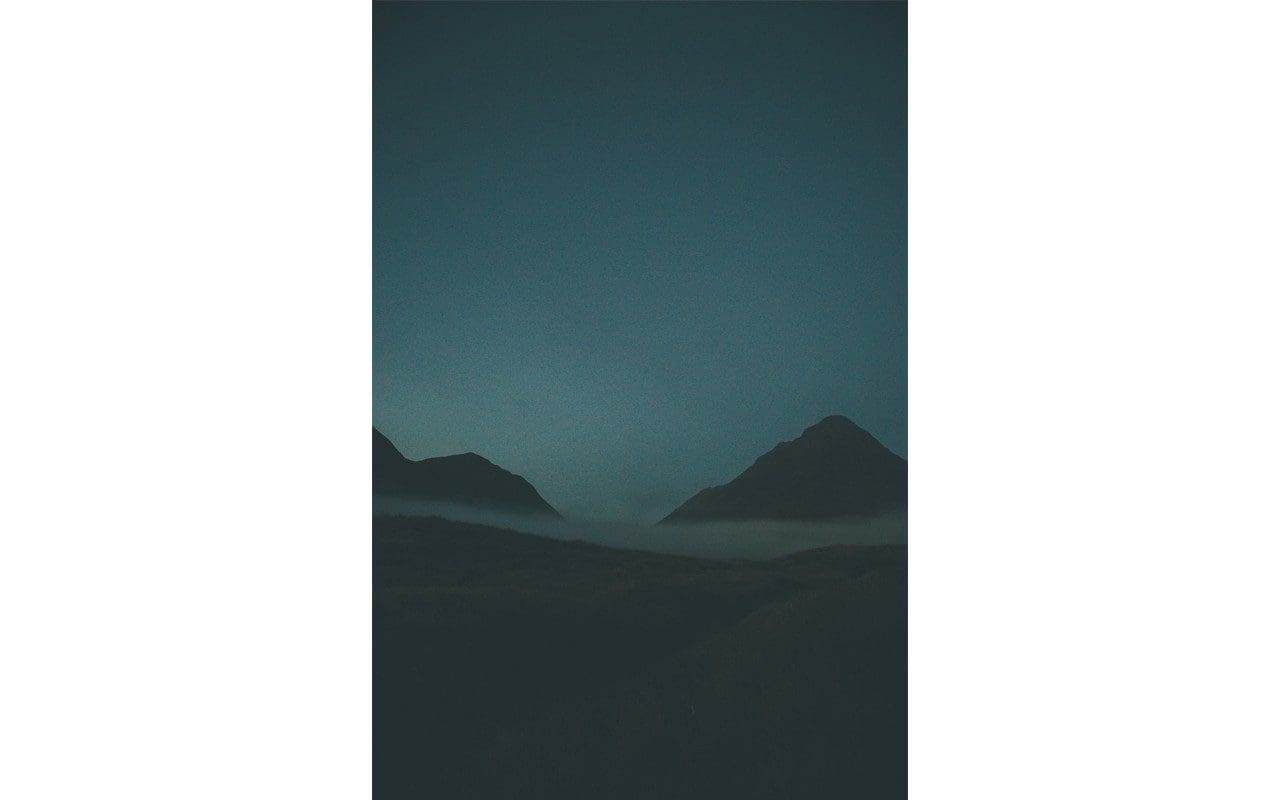
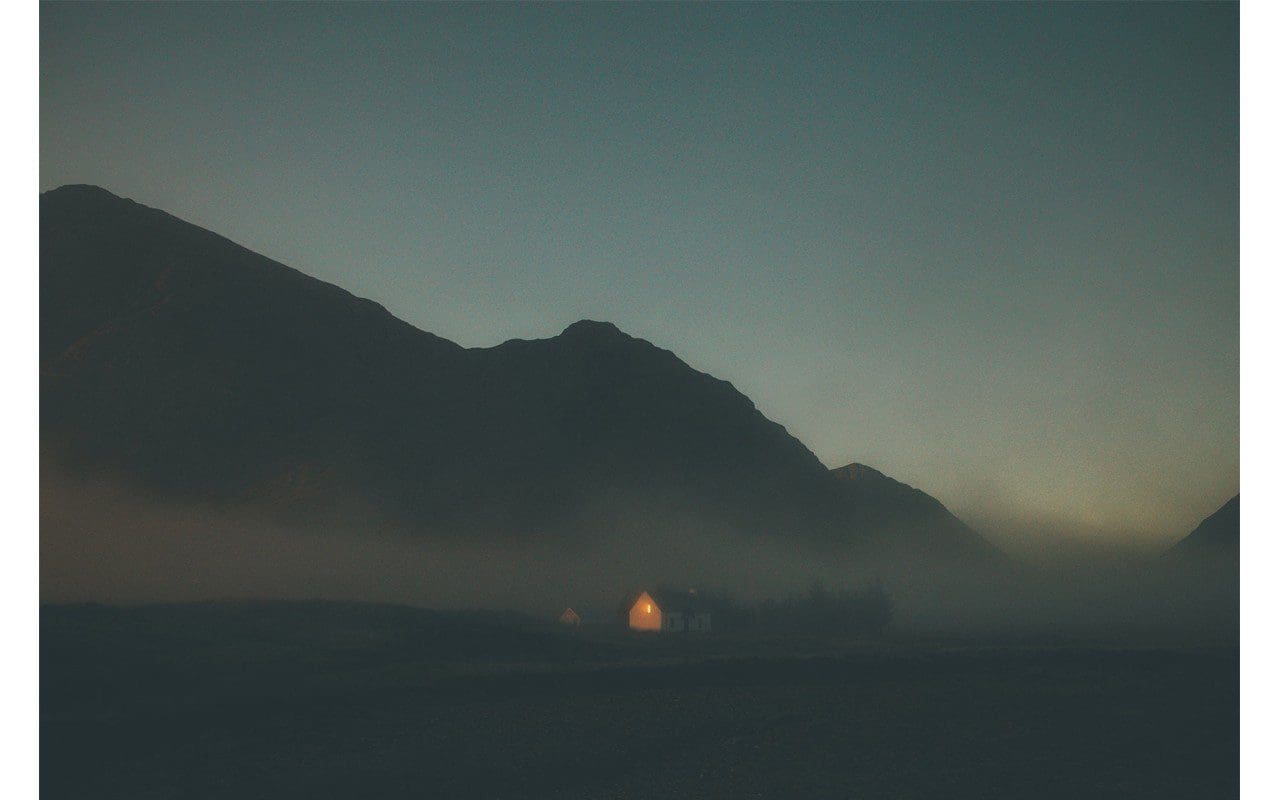
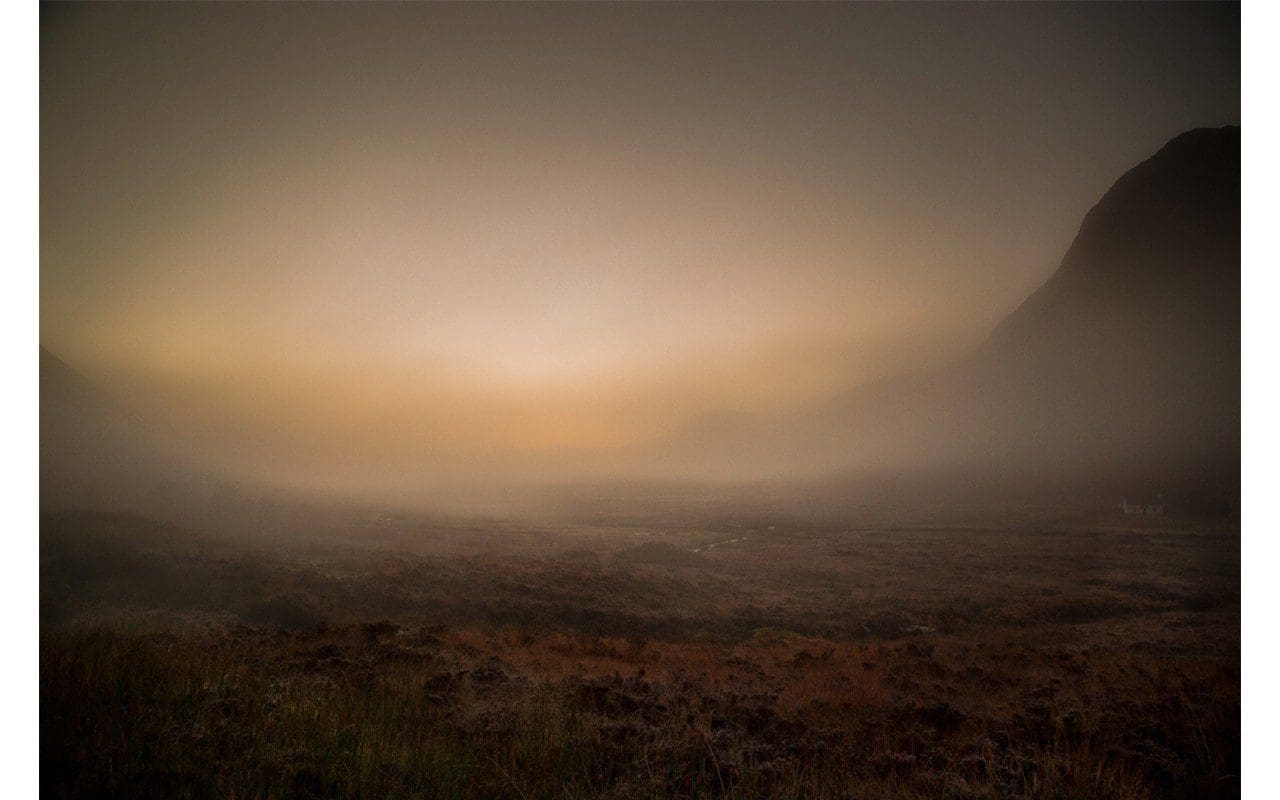
Photographs from The Edges of These Isles
You are currently working with Martin Parr on a new commission for Manchester Art Gallery. Firstly, I’d love to hear your take on Martin’s photography and what it means to you. Then can you then tell me anything about the work you’re collaborating on?
Martin was one of the first photographers I was ever made aware of, and there’s something about his style which is so stark, but so honest at the same time and his sense of humour is something I know I’ve tried to seek out in my street photography work as well. I’ll see one of his images and know straight away that it’s his, which, as a photographer, is something I’ll always be aspiring to.
I began working with Martin in March as the producer for his commission with Manchester Art Gallery for an exhibition opening this November. The gallery is going to show a huge selection of Martin’s Manchester work from the past 40 years, from when he studied here in the early 70’s up until today, which is what we’re currently working on now. So I’m spending a lot of time arranging shoots, but then I get to work alongside Martin for a few days at a time and it’s a real privilege to observe him working, he’s so confident and assured, just being around him for a few days fills me with confidence.
And finally, what are you working on personally at the moment, and are there any opportunities for us to see your work anywhere ?
I have a couple of exhibitions coming up, the first is Duality, a documentary project that I’ve collaborated on with another Manchester photographer. Its focus is workwear and uniform, posing questions about how we perceive the individual based on their appearance, which they potentially haven’t chosen for themselves, but also how the individual perceives themselves based on what they’re wearing. That’s going to be on show at The Sharp Project, Manchester on 31st May.
I’m also showing a selection of stories from Loved&Lost at Oriel Colwyn in Colwyn Bay throughout July. It’s the first time the work will have been shown in a gallery, so I’m currently establishing how to do that sensitively and effectively.
Working with Martin and finishing off the Loved&Lost stories is keeping me fairly busy at the moment, but I have begun work on a couple of new projects, one inspired by the locations that feature in Brian Eno’s album Ambient 4 : On Land, and the other is about photographing smells, which I know is impossible, but I’ve just started developing the idea to see if it’ll work!
Interview: Huw Morgan / Photographs: Simon Bray
Adam Silverman is a potter living and working in Los Angeles. After initially studying and practising as an architect, in the early 1990’s he was one of the founders of cult skate wear company X-Large. Since 2002 he has been practising as a professional potter. As a keen amateur potter myself, two years ago I was inspired to write him a fan letter and was delighted to receive an email from him inviting me to visit him at his studio, which I did in October 2016. Adam generously gave me two days of his time, showing me his studio, his work and explaining his process. This March he has his first European solo exhibition in Brussels at Pierre Marie Giraud.
Adam, how did you come to work in ceramics ?
Ceramics is something that I started as a hobby when I was a teenager, around 15 or 16. Before that I did wood turning and glass blowing. Clay stuck and I continued taking classes as a hobby throughout high school and college. In college I studied architecture, but took ceramic classes whenever I had a free period. I never studied it per se just enjoyed doing it. I didn’t know anything about making glazes or firing kilns or the history, ancient nor modern. I continued making pots as my creative outlet after college and while I began my working life in Los Angeles, first as an architect and then as a partner in a clothing company.
In about 1995 I bought a small kiln and a wheel and set up my own studio in my garage at home and the hobby grew into more of a passion and then into a fantasy life change. In 2002 I attended the summer ceramics program at Alfred University in upstate New York with the intention of studying ceramics seriously for the first time. I wanted to learn about glazing, firing, history, etc. and to see what it felt like to work on ceramics full time, 8-10 hours a day, in a serious studio context, with feedback from people who weren’t friends or family. My idea was that at the end of the summer I would decide to either commit to working professionally as a studio potter, or give up the fantasy and acknowledge clay as my hobby but not my profession. It was a great summer and I returned to Los Angeles and set up a proper studio, outside of home, got a business license and went to work as a studio potter. I gave myself one year to see if I could make a living at it. That was fall 2002, so it’s been 15 years and in many ways I feel like I’m still just getting started.
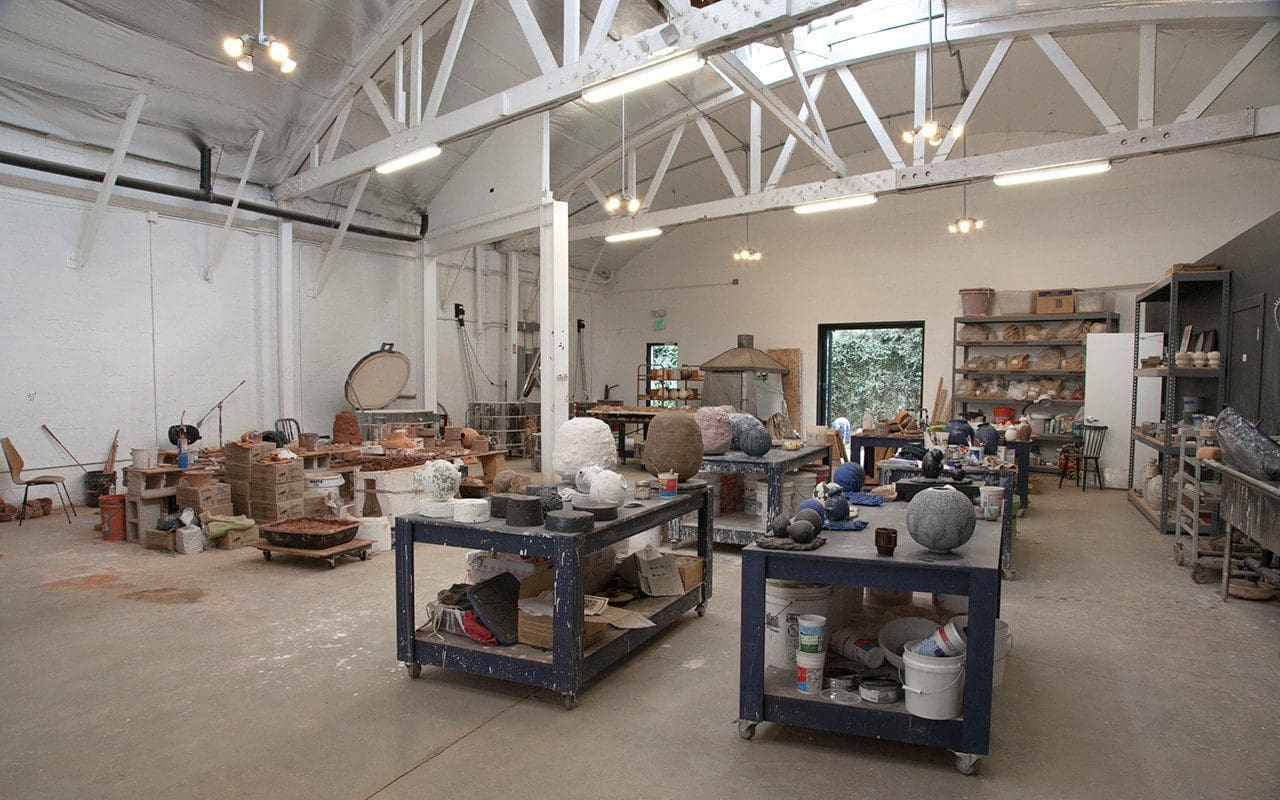
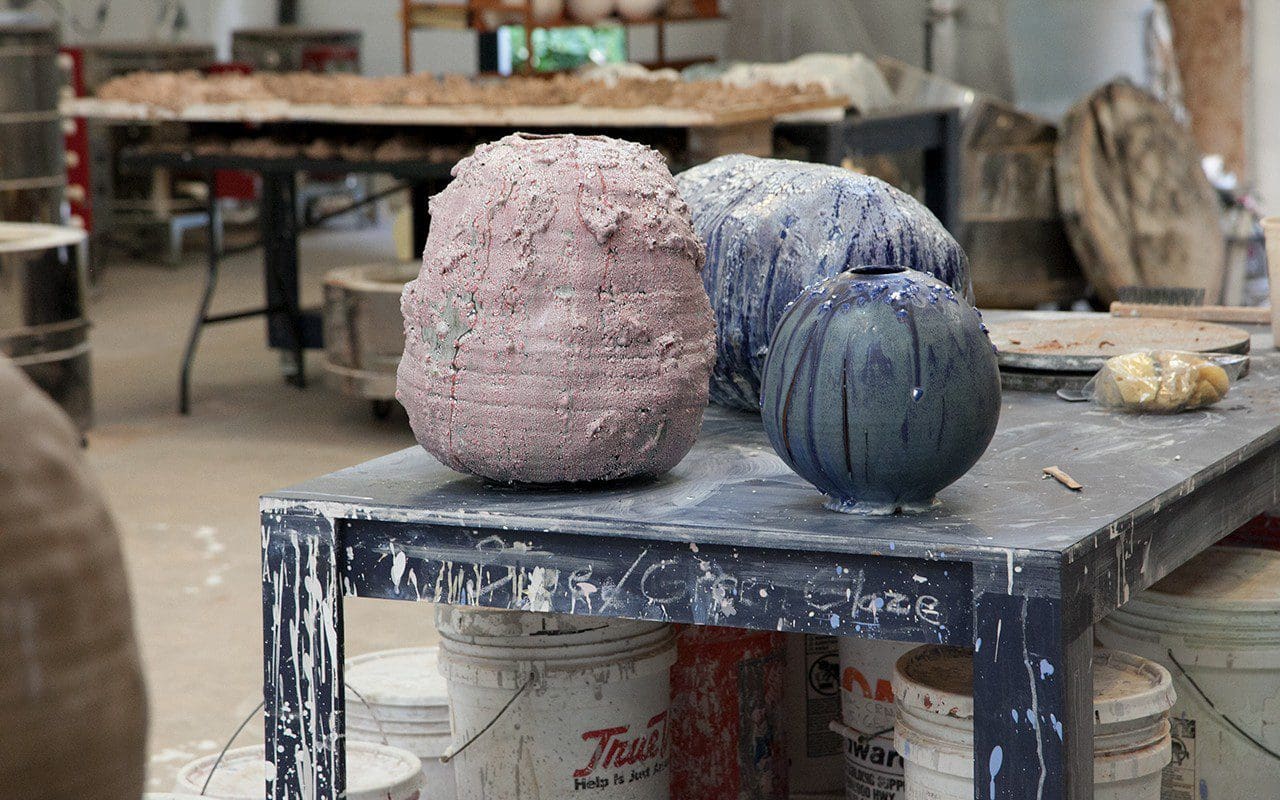
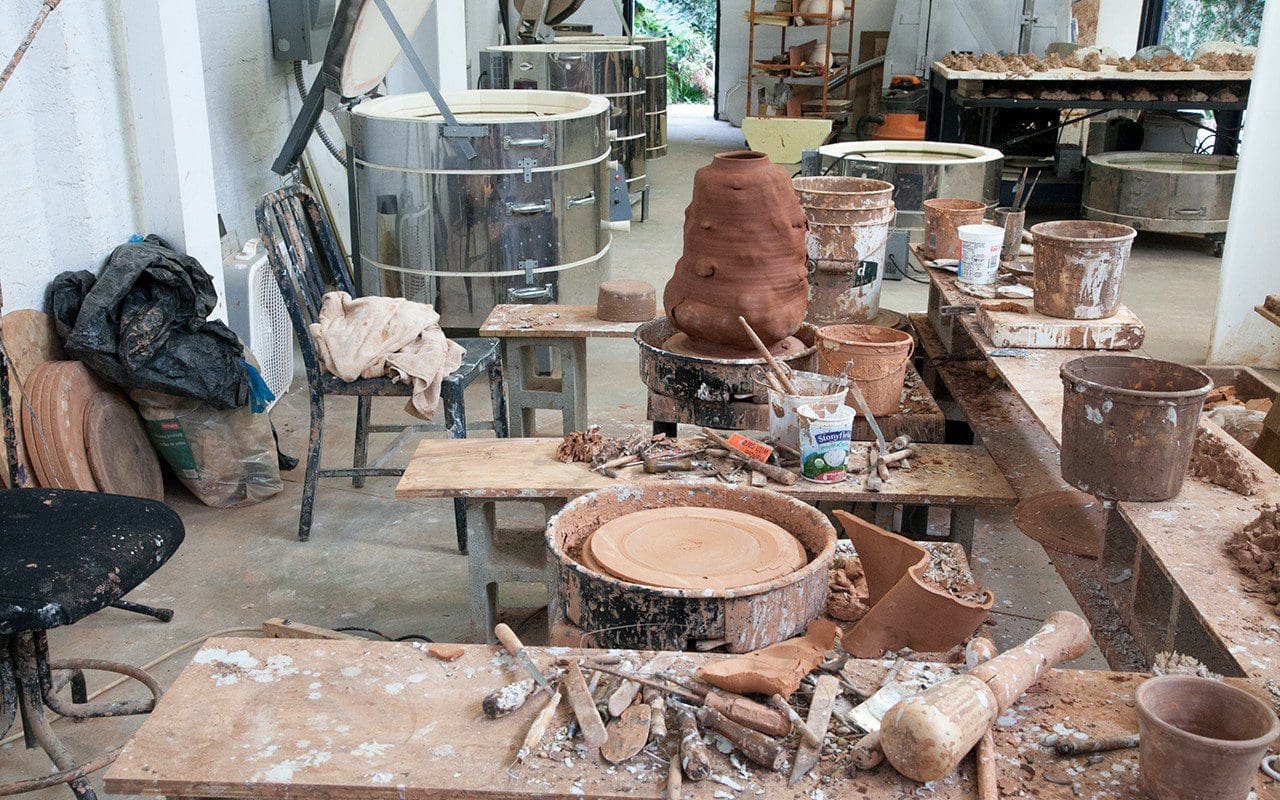
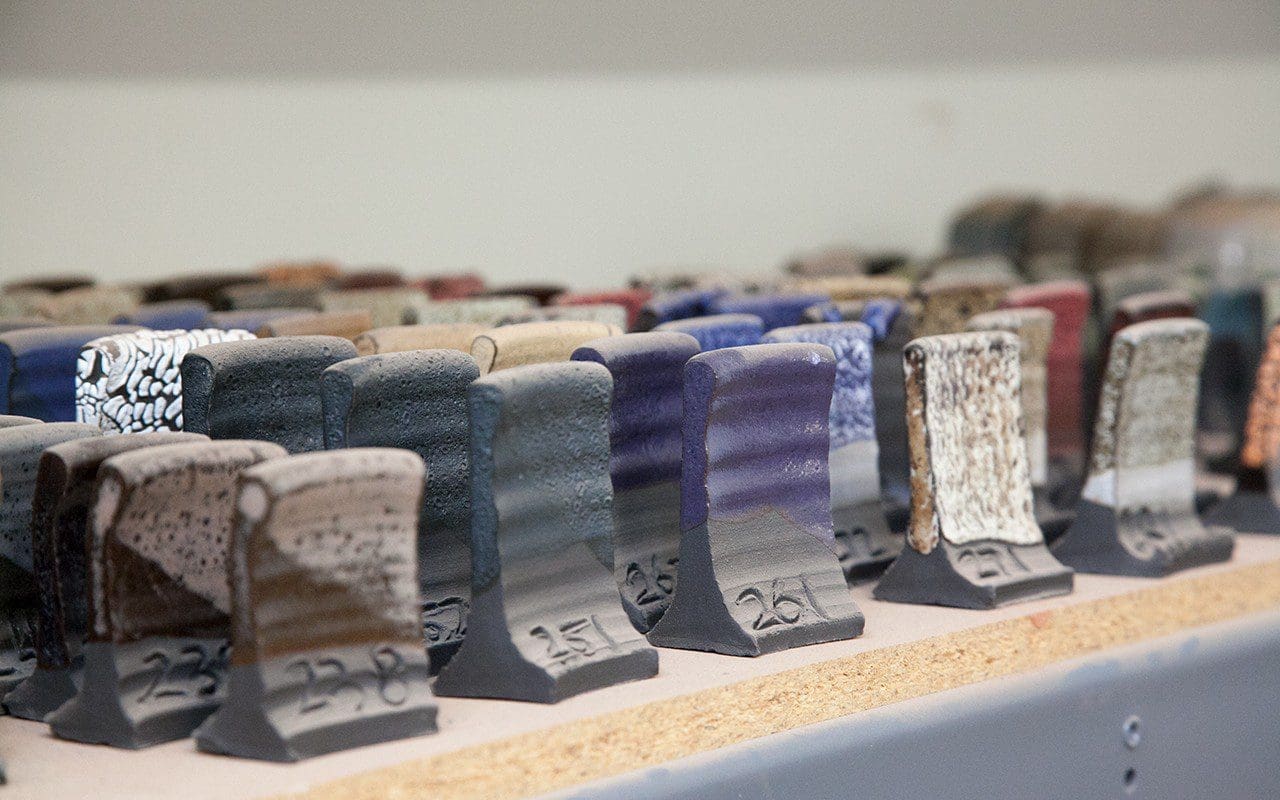
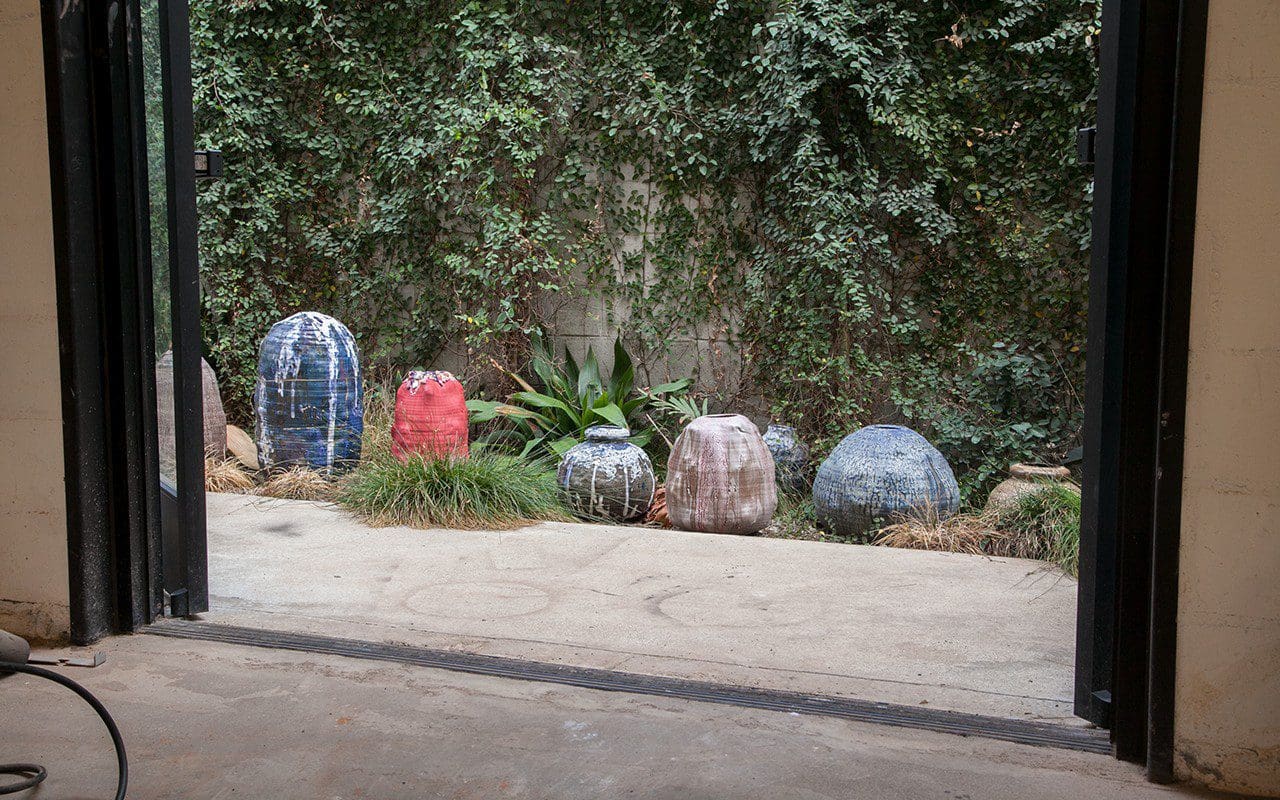
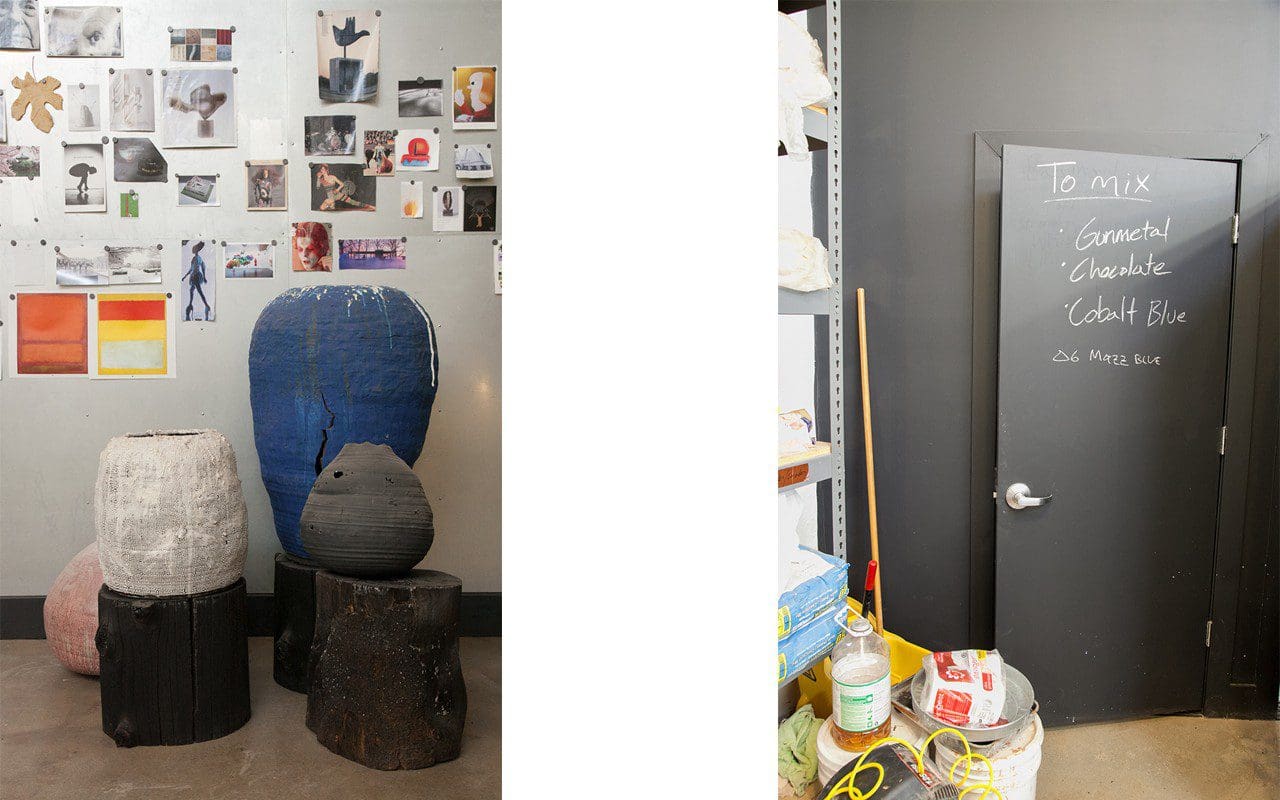 Adam’s Glendale studio in 2016. He has recently moved to a new studio in Atwater.
Adam’s Glendale studio in 2016. He has recently moved to a new studio in Atwater.
I’m interested in how you see the relationships between the seemingly unrelated disciplines of architecture, clothing design and production and ceramics.
Ceramics, clothing and architecture are all “functional arts” or at least can be. They are all made for and in many ways dependent upon the human body. They are all usually seen as “design” more than “art”. I moved from the hardest and most complicated (architecture) in terms of the amount of people and money needed to realize your work. Making clothing is very similar to making a building in terms of the process, but much faster and cheaper and less dangerous and less regulated. Ceramics I can and do make entirely alone. I have as much control over the process and results as I want. It is an amazing thing to come to work alone and be able to make what I want, when I want. This, in a way, is one of the reasons that I call myself an artist rather than a designer. I come to my studio and make what I want. I don’t have clients to service or problems to design solutions for. It’s not a service business that I am in. Anyway, you get my point I’m sure.
From 2008 to 2013 you worked as a studio director and production potter at Heath Ceramics, a tableware producer founded in the 1940’s with a distinctive Californian modernist aesthetic. What can you tell us about your time there ?
My time at Heath was great. I learned so many things, some about making ceramics and issues of production, some about design, some about running a growing business with a rapidly increasing number of employees and the associated complexities, and some about myself and what I wanted to be doing with my work and my life. It allowed me to work commercially and so not have to worry about money so much, while still giving me the freedom to both develop their homeware ranges with my aesthetic input while also producing more experimental work of my own.
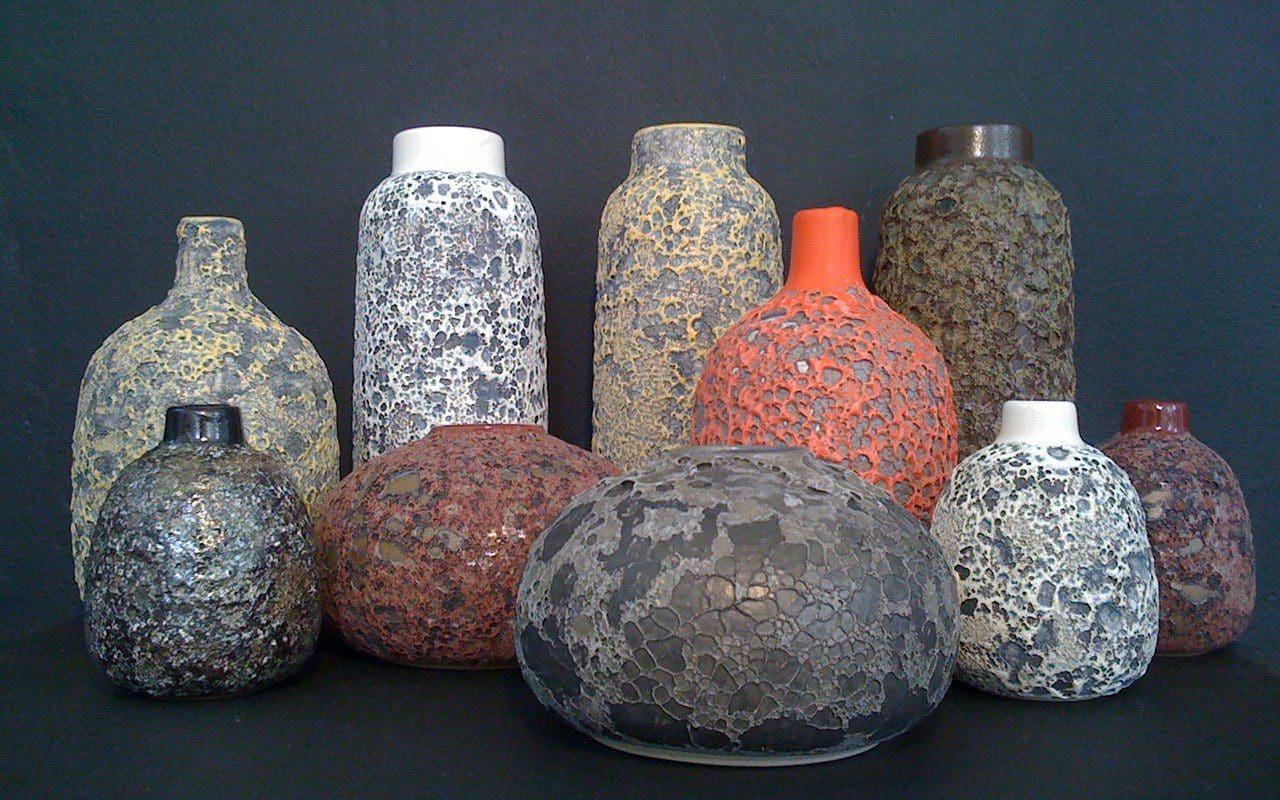
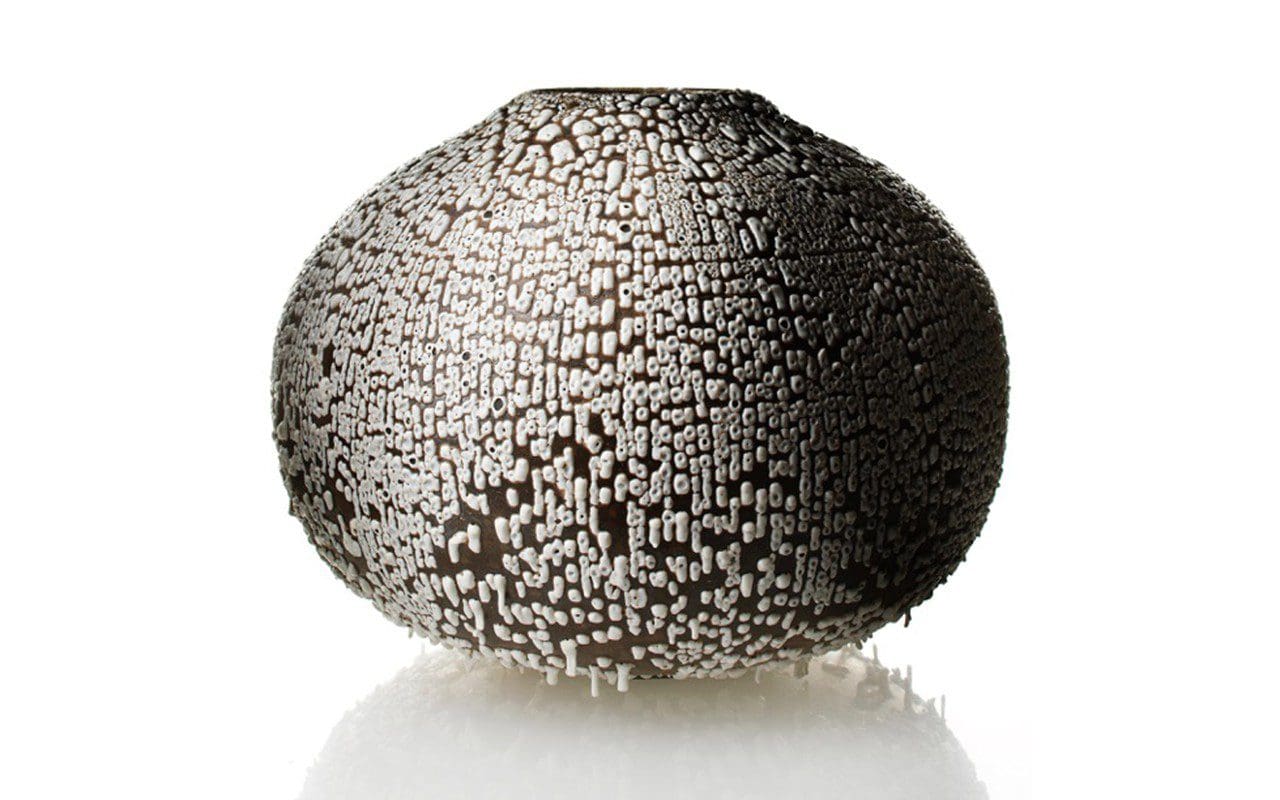
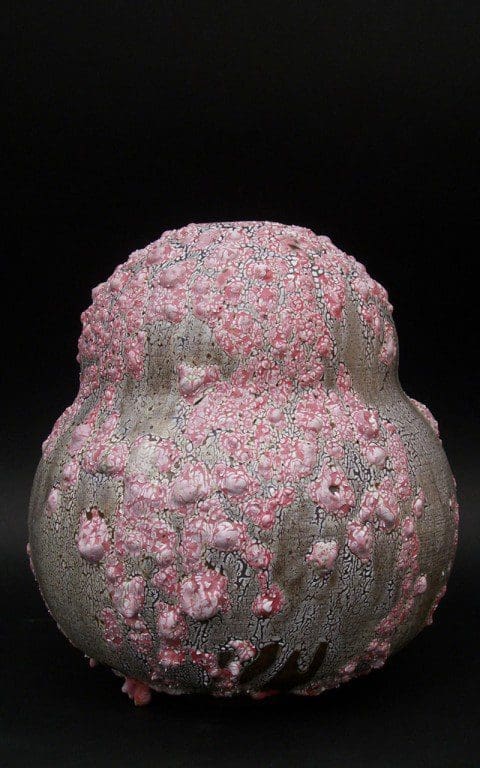 Pots produced during Adam’s time at Heath Ceramics. Photos courtesy Adam Silverman
Pots produced during Adam’s time at Heath Ceramics. Photos courtesy Adam Silverman
When I first encountered your work the forms you were making were controlled and symmetrical and served as canvases for extreme textural glazes. Since then your work has become monumental, less controlled, more chaotic. How has your approach changed since you first started to pursue ceramics professionally ?
I think that I have been following a path without preconceptions of what I wanted my work to look like or be like. The evolution of the approach and the results have been very organic. The one consistent is the potter’s wheel. I love working on the wheel, that’s the foundation of my studio and, in a way, my life. The work has evolved from very clean and tight, reminiscent of modern Scandinavian ceramics, and into a much looser and freer interpretation of those same basic geometries, which are dictated, or at least implied, by the forces of the spinning wheel, circles, spheres, eggs.
I can say that there really isn’t a thought process per se behind the evolution. It is more of a physical evolution. There is a lot of improvisation on the wheel. I think as I’ve aged and become more confident as an artist, things have very naturally loosened up. In the early days I would on occasion think that I was too tight and needed to loosen up. I would intentionally try to make looser work and it always felt horrible, contrived and unnatural, and the results didn’t feel like my work. I felt that they were terrible to look at and touch.
You have developed your own glazes over many years. Can you explain how you do this ?
I am a total caveman when it comes to chemistry. I put stuff together and burn it and see what happens. I’ll find materials where I am working and use them to leave marks on the work. Usually I start by thinking about just a colour or group of colours that I want to use and then start making things and see where it goes. I use glaze recipe books, the internet, and sometimes commercially available glazes as a starting point, and then start altering them through experimenting. Also I multi-fire everything, often many times, to build up layers or to try to correct something. It’s all a bit of a mess honestly, and I can’t really repeat anything, which I like.
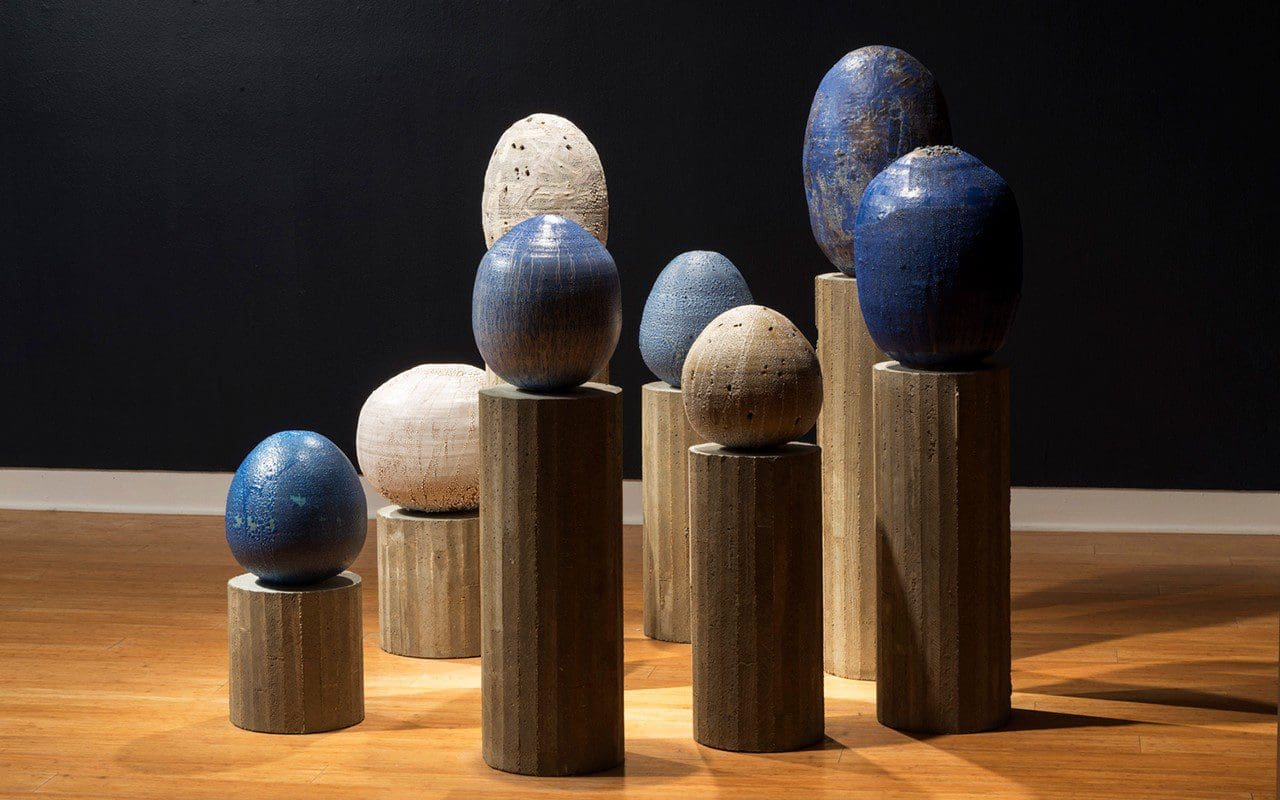 An installation at Laguna Art Museum, 2013-14
An installation at Laguna Art Museum, 2013-14
Can you tell us about your Kimbell Art Museum project in 2012, which brought you back into the orbit of some of your architectural heroes ?
This was a commission to create a body of work celebrating the 40th anniversary of the opening of the Kimbell in 1972. It is one of architect, Louis Kahn’s, finest buildings. In 2010 construction began on a new Renzo Piano designed building, while behind the original Kahn building is The Fort Worth Modern Art Museum, designed by Tadao Ando. Both architects were much influenced by Kahn.
For me as an architecture student, and then a young architect, each of these three architects were very significant, and they continue to have a bearing on my practice as a potter. So to be given this opportunity to engage with the three of them was exhilarating and terrifying. I made three large pots using only materials harvested from the site, which included items gleaned from the partial demolition of the original Kahn building, rust shed from a Richard Serra sculpture and water from the pond at the Ando building.
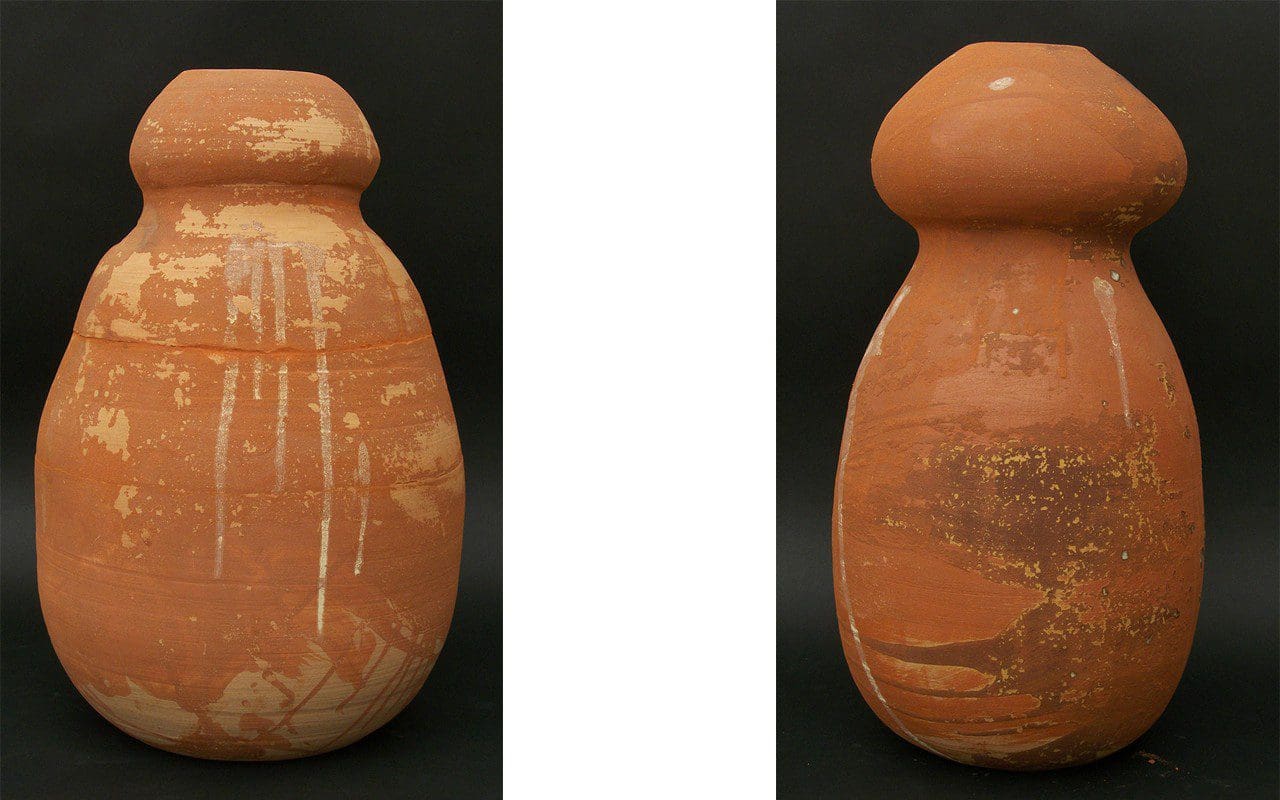
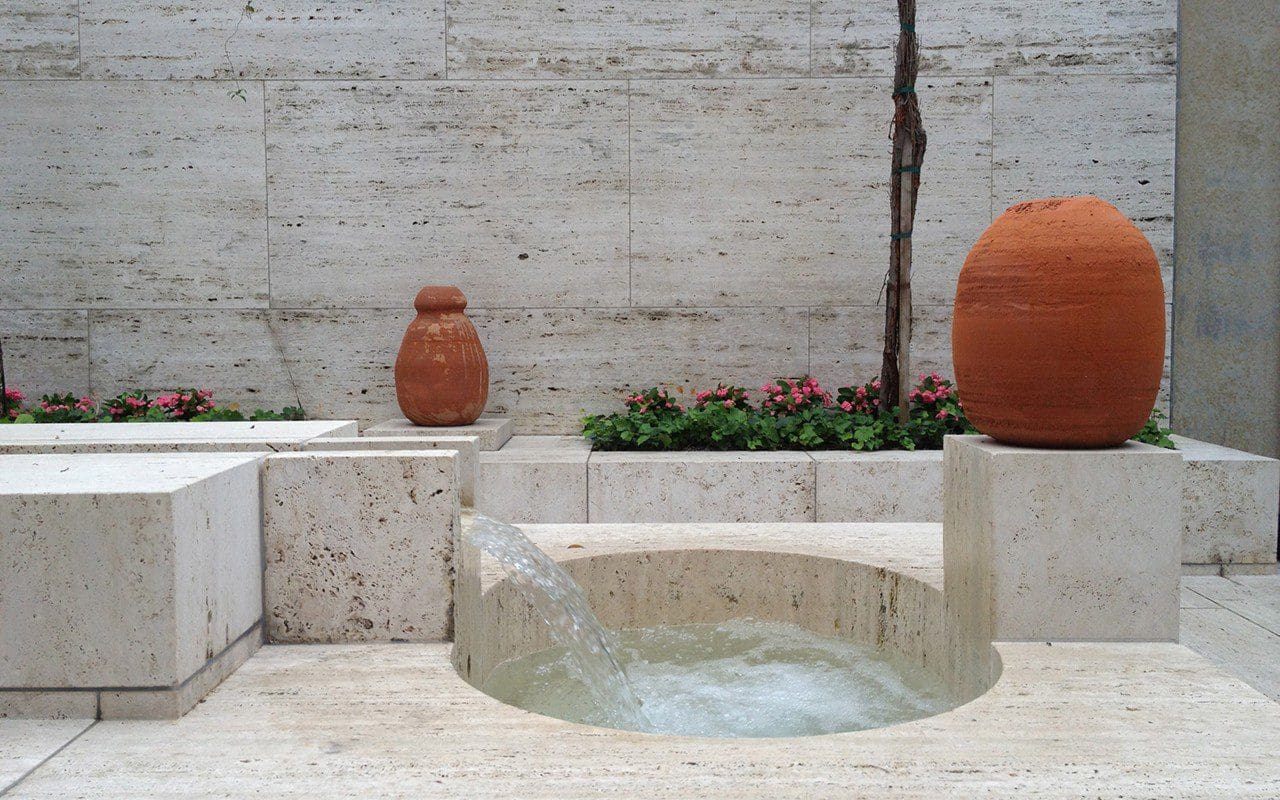 Pots produced for the Kimbell Art Museum and an installation view, 2012. Photos courtesy Adam Silverman
Pots produced for the Kimbell Art Museum and an installation view, 2012. Photos courtesy Adam Silverman
What attracted you to the Grafted project that you collaborated on with Japanese botanist Kohei Oda ?
This project was suggested and orchestrated by our mutual friend Tamotsu Yagi, who is a brilliant designer and art director. He also designed the book of the project as well as my Rizzoli book of a few years before the Grafted project.
Kohei creates ‘mutant’ cactus plants by grafting different species together. Tamotsu thought that I would be a good person to create pots for some of these plants and set us up on what was essentially an international blind date. I was reluctant to do pots for plants as I felt that I had moved past that part of my life and practice, but his work is so special and powerful that I couldn’t say no to Tamotsu. We did a few test pieces where I sent him a few pots and he sent me a few plants and the results were encouraging and exciting so we decided to do the two part show, one in Venice, California and one in Kyoto. We made a total of 100 pieces together over the course of a year. It was a pretty special project.
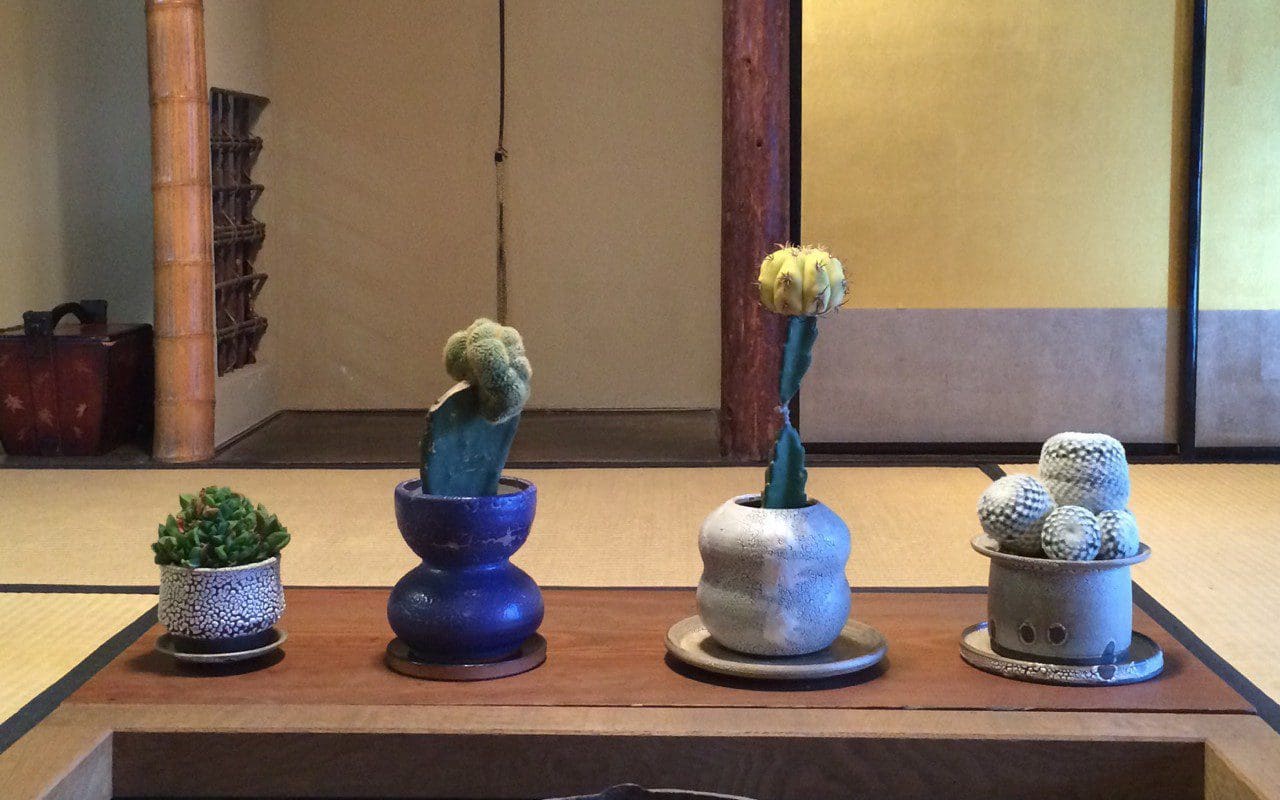 Installation view of Grafted, Kyoto, 2014
Installation view of Grafted, Kyoto, 2014
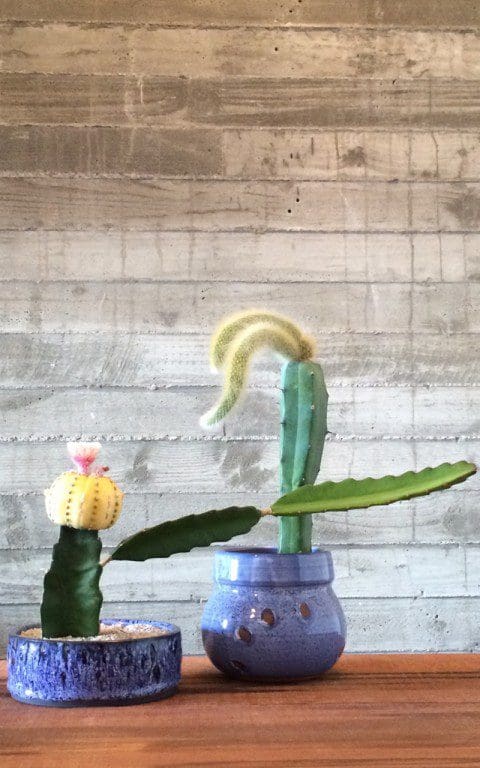 Installation view of Grafted, Venice CA, 2014
Installation view of Grafted, Venice CA, 2014
It is self-evident to say that the forms and surfaces of your pieces are organic in quality. What are your inspirations and intentions with these forms ? Your recent show at Cherry & Martin in L.A. was titled Ghosts. Can you explain why ?
In a way I prefer for the work to stand on its own without explanations of influences, intentions. I will tell you that I look a lot at painting, anything from Cy Twombly to Monet to Rothko to Philip Guston. I look a lot at architecture. And dance. But in the end none of that really matters, because I’m making pots and sculptures that must exist on their own in the world.
The title Ghosts (and, at my upcoming show at Pierre Marie Giraud, Fantômes) simply suggests the histories and lives that are inherent in the pieces. Living organisms in the clays and glazes, my hands and actions on the clay, gestures frozen. Lives stopped, but that also live on.
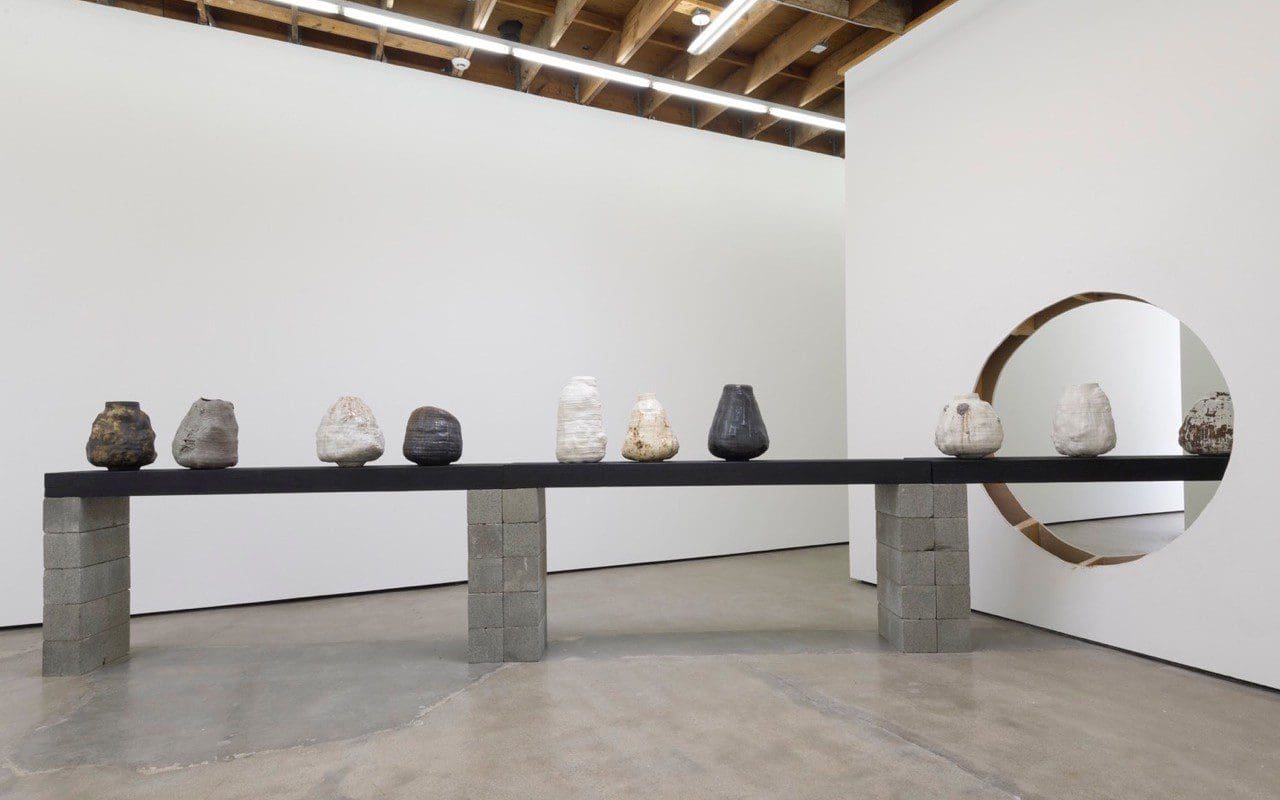
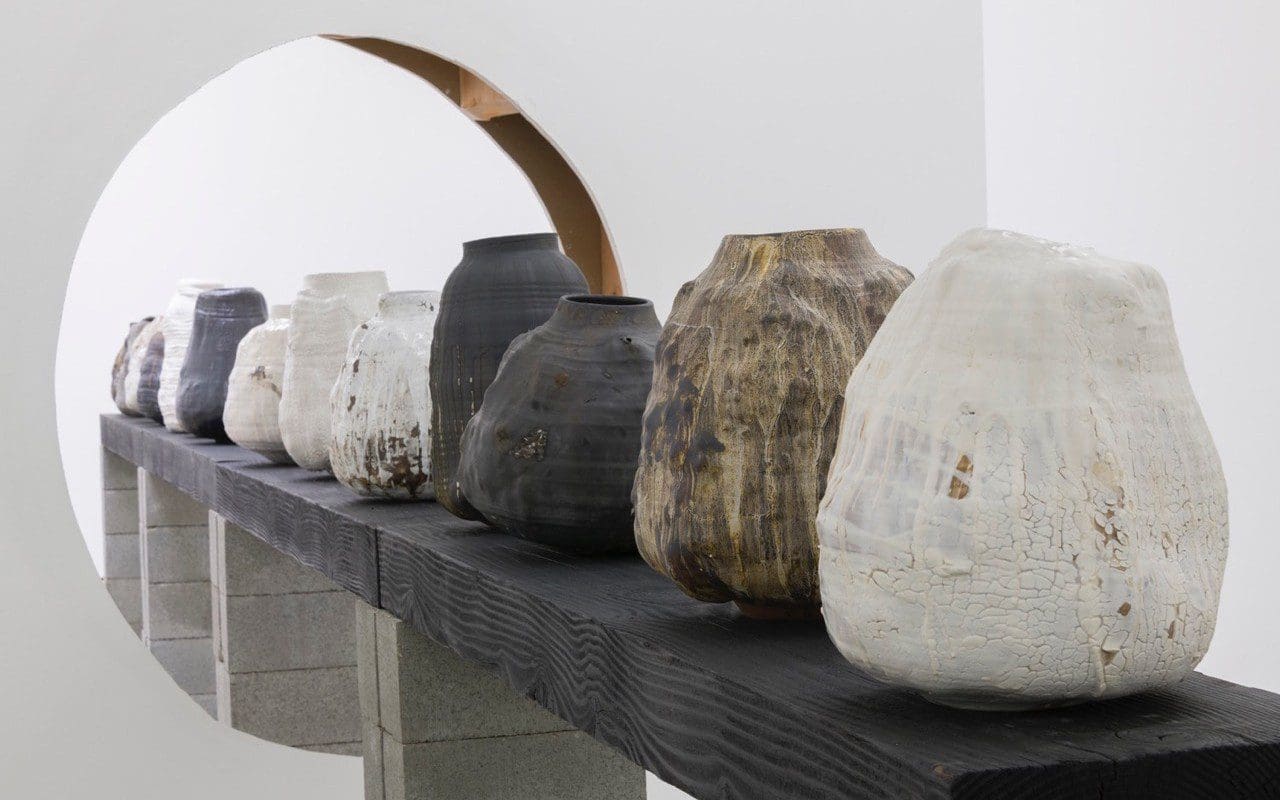 Installation views of Ghosts at Cherry & Martin, Los Angeles, 2017. Photos courtesy Adam Silverman
Installation views of Ghosts at Cherry & Martin, Los Angeles, 2017. Photos courtesy Adam Silverman
Landscapes, both urban and rural, are present in your work, and there appears to be a strong Japanese influence. What can you tell us about these ?
Yes there is a lot of this stuff in the work, and all mostly unconscious or not specifically intentional, beyond using materials harvested from my surroundings, both urban and rural. I like the idea of scars and marks coming from the place where I’m working. It’s abstract and people don’t need to know and usually don’t, but to me it feels like the place is in the work and the work is of the place and somehow it resonates and means something, even if it is unspoken and invisible.
Japan is deep in my heart and DNA. When I was in architecture school I was (and still am) a huge fan of Tadao Ando and my first trip to Japan in 1989 was specifically to look at Ando buildings. I’ve been going back there my entire adult life and have so many influences from there inside me that it’s hard to tell where it starts and ends.
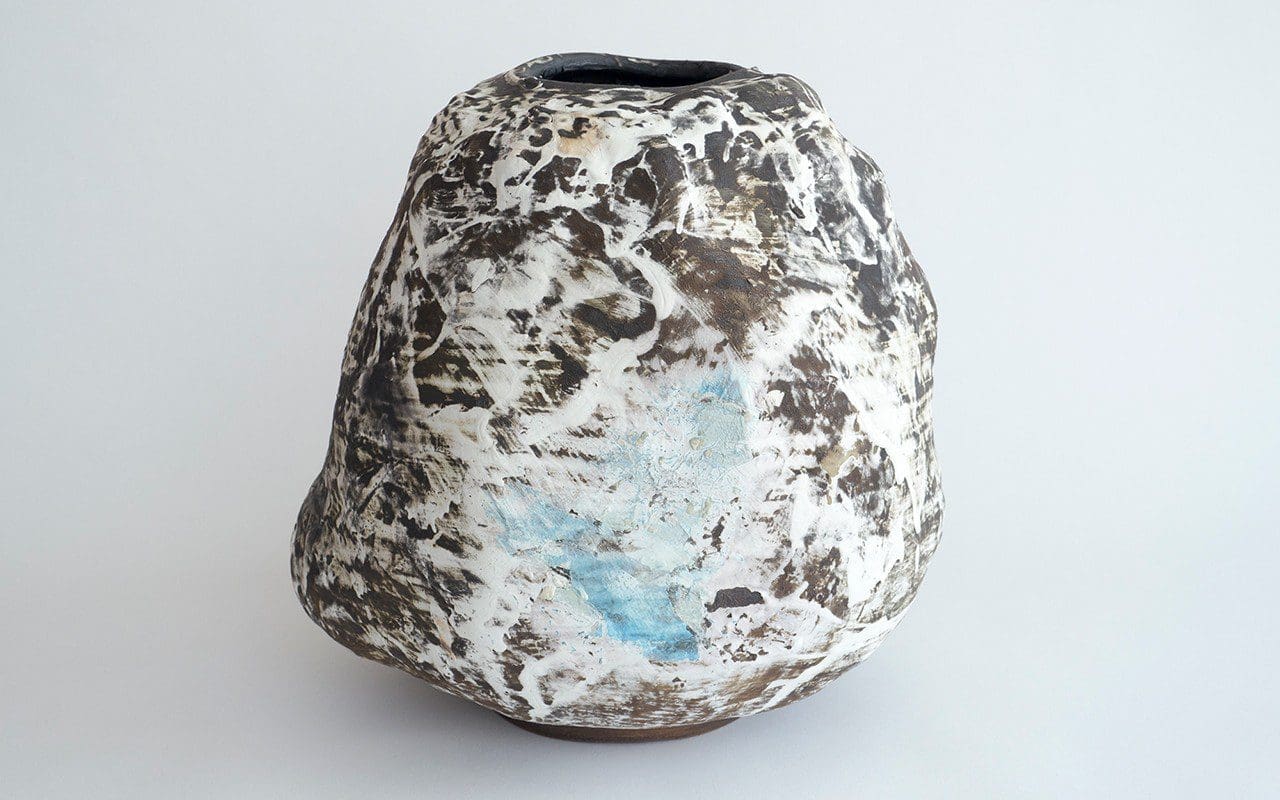
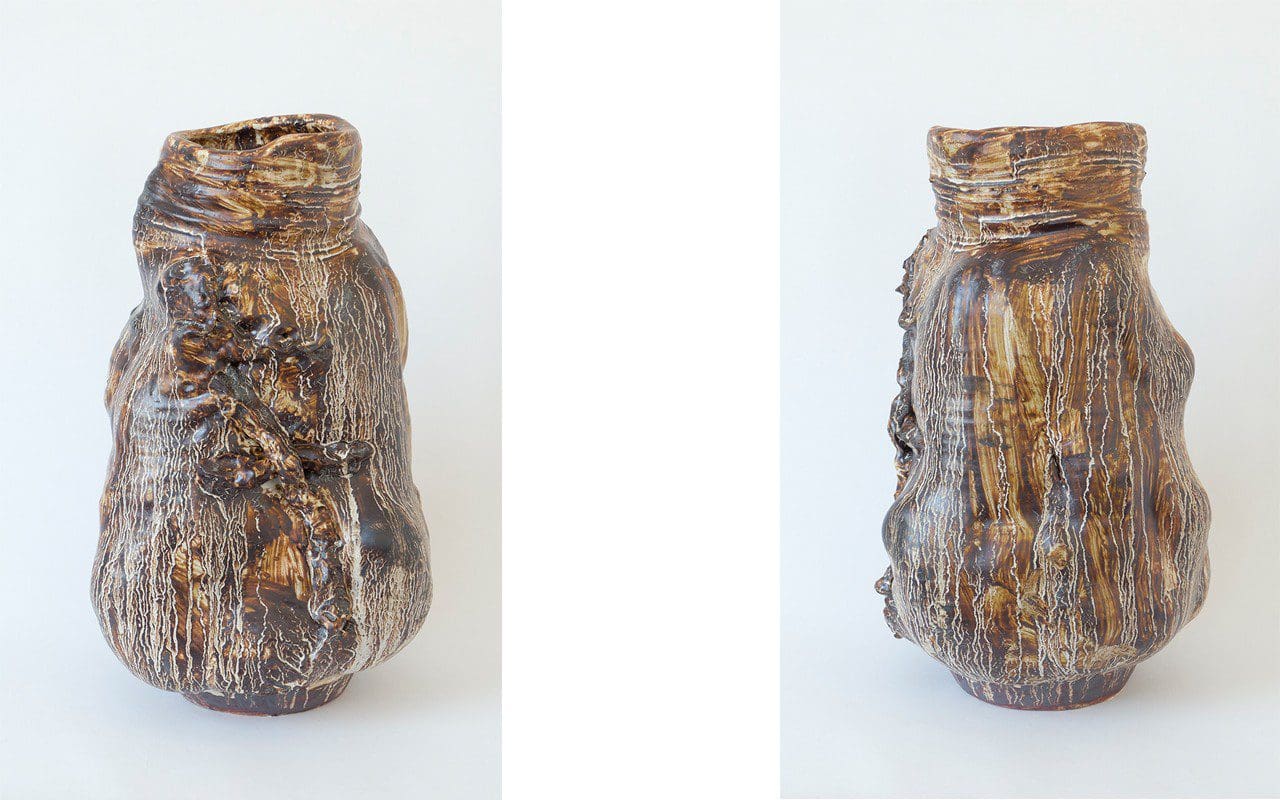
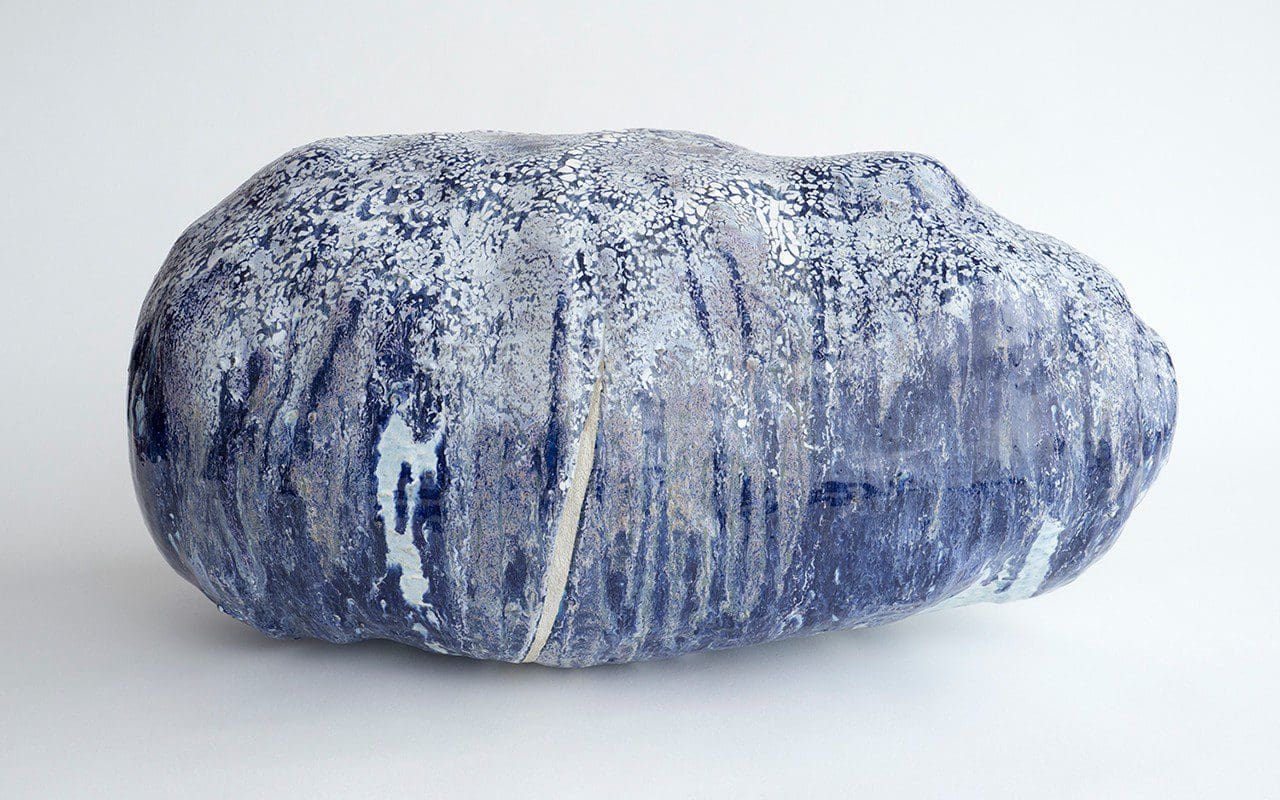 Pots for Fantômes, Pierre Marie Giraud, Brussels, 2018. Photos courtesy Adam Silverman
Pots for Fantômes, Pierre Marie Giraud, Brussels, 2018. Photos courtesy Adam Silverman
Fantômes is at Pierre Marie Giraud from March 8 – April 7 2018
Interview and all other photographs: Huw Morgan
Published 17 February 2018
Michael Isted is the founder of The Herball, a company producing handmade herbal infusions and plant extracts in small batches. The plants he uses to produce them are sourced from a number of independent, organic producers and freshness and quality are of prime importance. Michael started out as a drinks specialist and is a trained phytotherapist and nutritionist. He is passionate about educating and celebrating the ways in which we can integrate plants into our diets to energise, enhance and heal.
Michael, you have a background in the beverage industry. Can you tell us how you came to see the importance of plants and how that inspired you to start The Herball ?
I was always fascinated with nature growing up as a child in the cradle of the South Downs in Sussex, picking blackcurrants and sticking cleavers to people’s backs. Then, whilst working in the beverage industry as a drinks consultant, I realised that everything (almost everything) I was working with was made from plants, whether working with gin, vermouth, tea, coffee or distilling eau de vie. I knew I had to dedicate more of my time to learning from plants and from people that worked with plants. It all happened fairly organically, nature called and it felt like a brilliant path to tread, intuitively right.
Where did your passion for plants come from? Are there any key people, influences or experiences that set you on this path?
I think we all have a passion for nature, it’s just sometimes hard to access or connect with nature, particularly in our urban environments, but I’m sure inside of us all is a burning desire to be with nature in some form. Plants are so diverse, colourful, vibrant and dynamic on so many levels. They are extremely influential companions.
Although I didn’t know it at the time, my earliest inspiration were the roses growing on the pathway leading up to our childhood house. That scent has stayed with me forever. The rose is a very powerful plant, it triggers so many memories. Like a form of time travel, it has taken me to some very magical times and places, it has been hugely influential.
Then I was inspired by learning about distilling plants with an eau de vie distiller in Alsace and connecting with herbalists such as Peter Jackson Main, Peter Conway, the work of Barbara Griggs and for sure the writing of Stephen Harrod Buhner. I urge everyone to read his book The Lost Language of Plants.
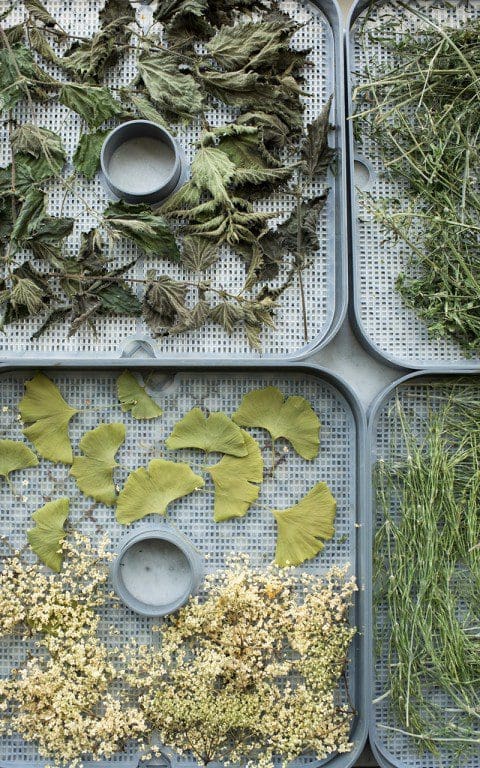 Dehydrator trays containing (clockwise from top left) dried nettle, cleavers, equisetum, elderflower and gingko.
Dehydrator trays containing (clockwise from top left) dried nettle, cleavers, equisetum, elderflower and gingko.
Photo: Susan Bell
You are a qualified Phytotherapist. Can you explain what that means and what the training involves?
It’s a posh term for a herbalist, to make us sound more professional. It means somebody who works with plants to heal and nurture people. We introduce nature and look at ways in which plants can help support disease, illness or just enrich people’s lives.
I trained with many naturopaths, nutritionists, herbalists and plant workers on shorter courses and then went into a full time BSc (Hons) degree at the University of Westminster. It took four years of full time training, but some of the most valuable training is spending time with the plants themselves. They can teach you a great deal.
Tell us about the range of products you produce, and the process you went through to develop them.
It all started as I was unhappy with the quality of the herbs & spices in many herbal teas and commercial spice ranges. There was (is) a distinct lack of relationship between people and the plants that they are drinking or eating. Supermarkets are littered with herbs in tea bags and boxes, but you don’t see the plants or engage with them enough. You don’t know where they are from, when they were harvested, who harvested them, you can’t even see the plants. So I wanted to create a range of plant products where you could really engage with the plant itself, on a very basic level by looking at and identifying it, drinking its qualities. It’s about engaging with and respecting nature really. I want people to see the love and hard work (from both the plant and the people producing them) that goes into nurturing, growing, harvesting, drying and blending the herbs.
We take plants for granted most of the time. Just take black pepper for example. In almost all households it is just a commodity. It’s just not celebrated enough. It’s a sensational plant, with brilliant flavour. Just take a good quality black peppercorn and place it in your mouth and eat it. Taste it fully and consider its qualities. Phenomenal.
We really want people to engage with the nature that they are drinking, eating and ingesting. All of our plants are harvested in that growing year, we know when they were harvested and by whom. We make our infusions, waters and bitters in tiny batches. It’s all created by hand with lots of care using the most vibrant plant material possible.
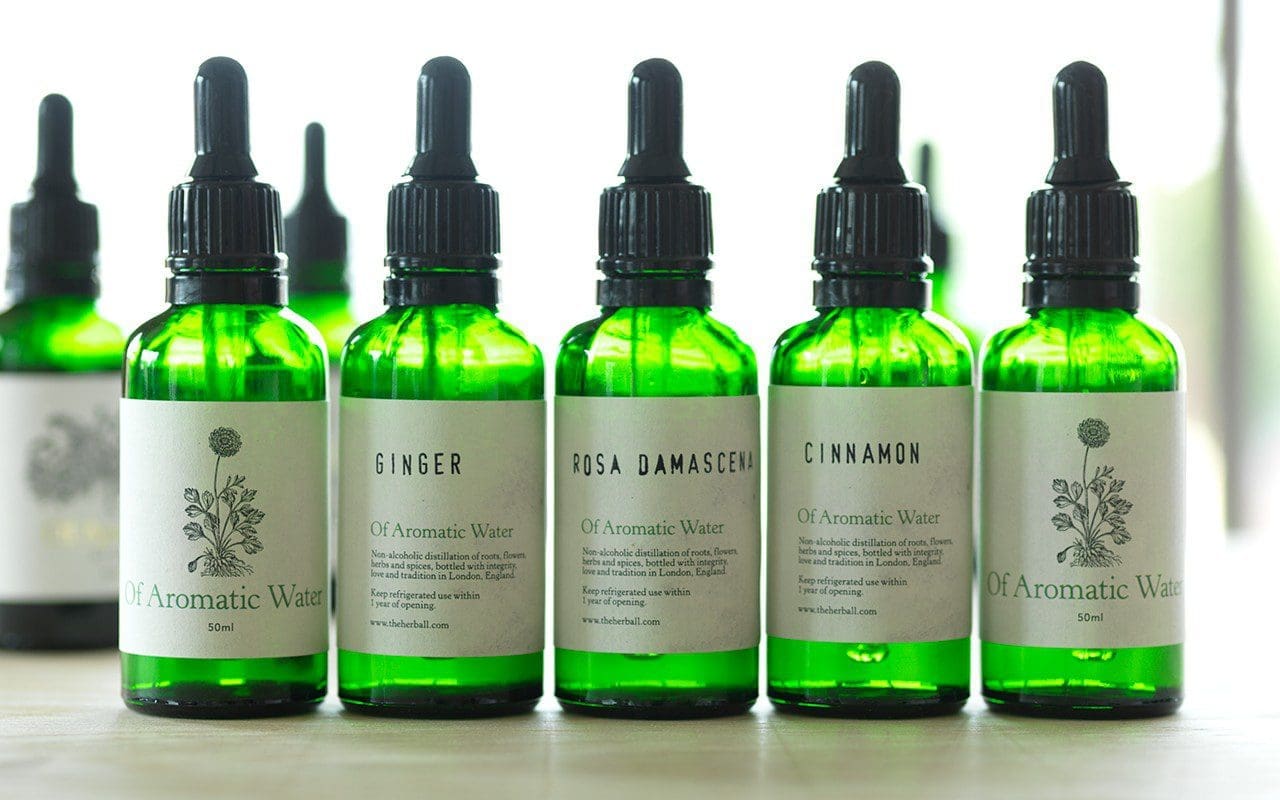 The Herball’s Of Aromatic Waters
The Herball’s Of Aromatic Waters
Our aromatic waters (non-alcoholic distillations of plants) were sourced from two distillers in the UK and India, although we have since stopped working with them as we are now distilling everything ourselves. There will be some very special distillates available in 2018 as we are currently working on polypharmic distillations, distilling lots of different plants at the same time. There is a natural synergy between plants in the wild and it’s always interesting to see which plants like to grow together, for example nettle & cleavers. We are trying to capture this synergy and relationship in the form of a distillation.
We distil plants in traditional copper alembic stills (main image – photo by Susan Bell) to use as a flavouring for food and drinks and as ingredients for natural skin care. We are just starting to use CO² extraction, which produces the most beautiful and vibrant oils. We also work with co-operatives in Southern India and Sri Lanka who supply us with beautiful vibrant spices. Again it is crucial that we know who harvested the plants, where and when. We visit the growers on their tiny holdings – when I say tiny they are really tiny, 1 hectare and less – and they cannot afford organic certification, so that’s where the co-operative comes in, to help give the growers the sales platform and access to people like us.
The bitters are remedies and recipes that I had been using in practice and for drinks creation for years. They cover all of my inspirations, so there is an English-based blend with 20 herbs grown here, an Indian blend with spices like cinnamon, turmeric and one of my favourite bitter herbs, Andrographis, and a Chinese blend with Chinese herbs such as Schisandra paired with a beautiful rock oolong tea from our dear friends at Postcard Teas. We wanted to share these formulas with everyone.
From where and how do you source your ingredients?
The herbs we use are mostly grown, nurtured, harvested and dried by a wonderful grower called Diane Anderson who has a smallholding in Oxted, Surrey. Diane was one of my teachers at University. She was an amazing resource and she used to come into the dispensary with the most beautiful dried herbs. Seeing these wonderful dried herbs was also an inspiration to start blending infusions.
We also work with a biodynamic plantation in Somerset, we grow a few things ourselves and for the more exotic plants, as mentioned before, we source from our friends in Southern India and Sri Lanka.
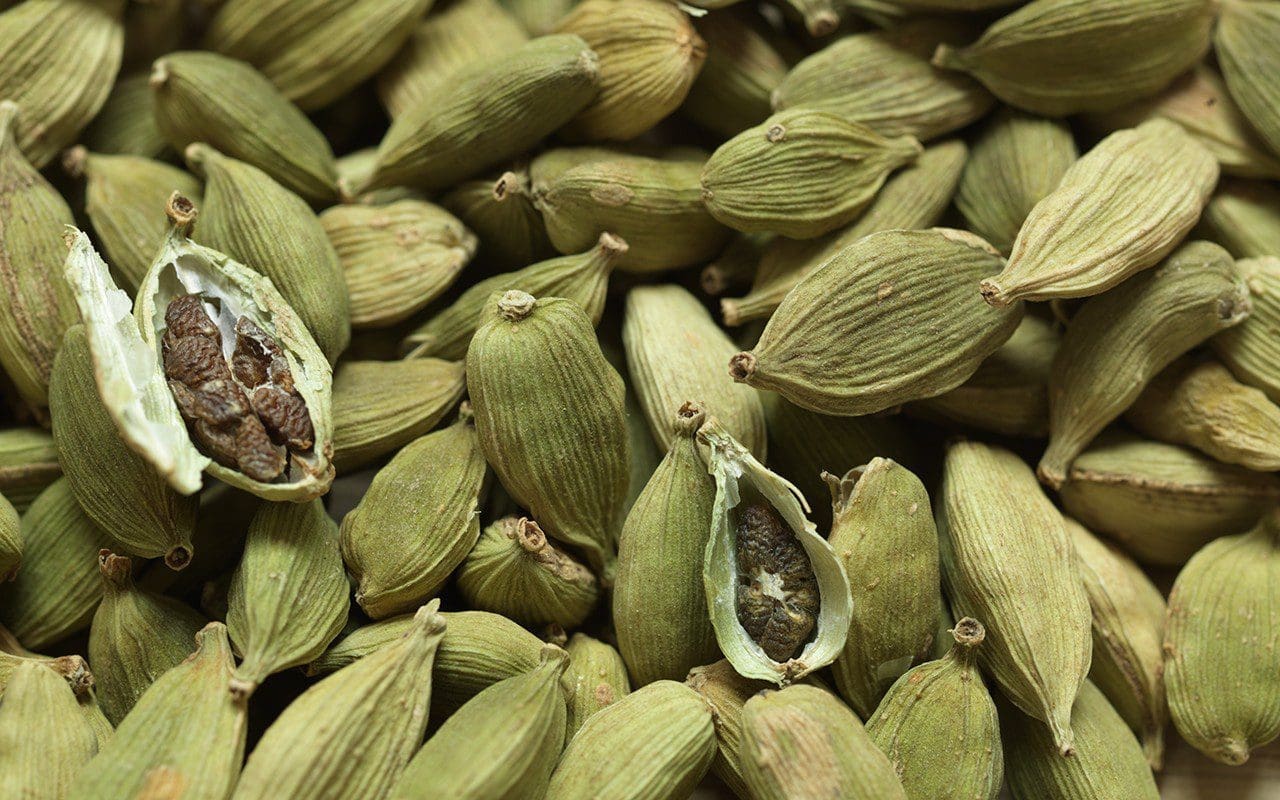 Cardamom
Cardamom
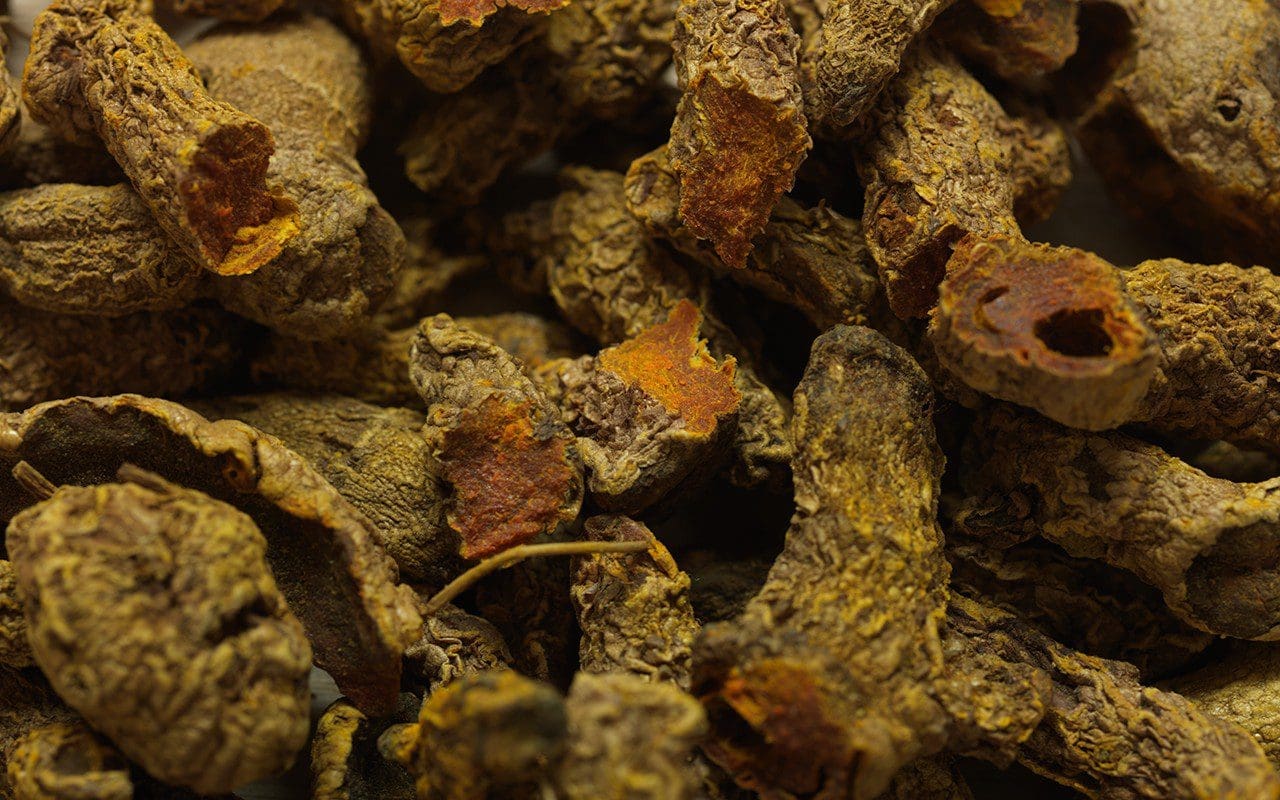 Turmeric
Turmeric
Can you explain how the bitters and herbal waters you produce might be used?
I’m not allowed to talk too much about the health benefits of our products, so broadly speaking their purpose is really to enhance and envigorate drinks and dishes and to give pleasure. The bitters are amazing just with water, or fresh juice, pre- and post-prandial, to stimulate digestive function and assimilate some of the metabolites from your meal. The aromatic waters are so diverse, I use them every day in a glass of water, sprayed directly on my face as a toner (rose), in salad dressings (rosemary & thyme are particularly good), to create cocktails with and without alcohol. They are amazing.
 The Herball’s Of Ayurveda Bitters
The Herball’s Of Ayurveda Bitters
Can you tell us something of the therapeutic effects of some of your key ingredients?
Plants have endless therapeutic qualities on so many levels, physically, spiritually, emotionally, and I think it’s important that you are ingesting some good quality organic plants every day. I don’t want to say as part of a routine as that sounds boring, but use them prophylactically as a preventative. Have fun with plants, get to know them, enjoy their nature, enjoy their brilliance, it’s so rewarding for health and happiness.
The herbs we use and work with are packed full of complex secondary metabolites, diverse plant chemicals (phytochemicals) produced by the plants which enable the plants to interact with their environment. These phytochemicals have a wide range of functions, including protection from herbivores, to fight against infections and to attract pollinators such as bees and other insects. The plant’s secondary metabolites include constituents such as tannins, aromatic oils, alkaloids, resins and steroids. It is these chemicals that not only carry a raft of potential health benefits for us, but also offer a huge palette of flavours, textures and aromas to create delicious food and drinks.
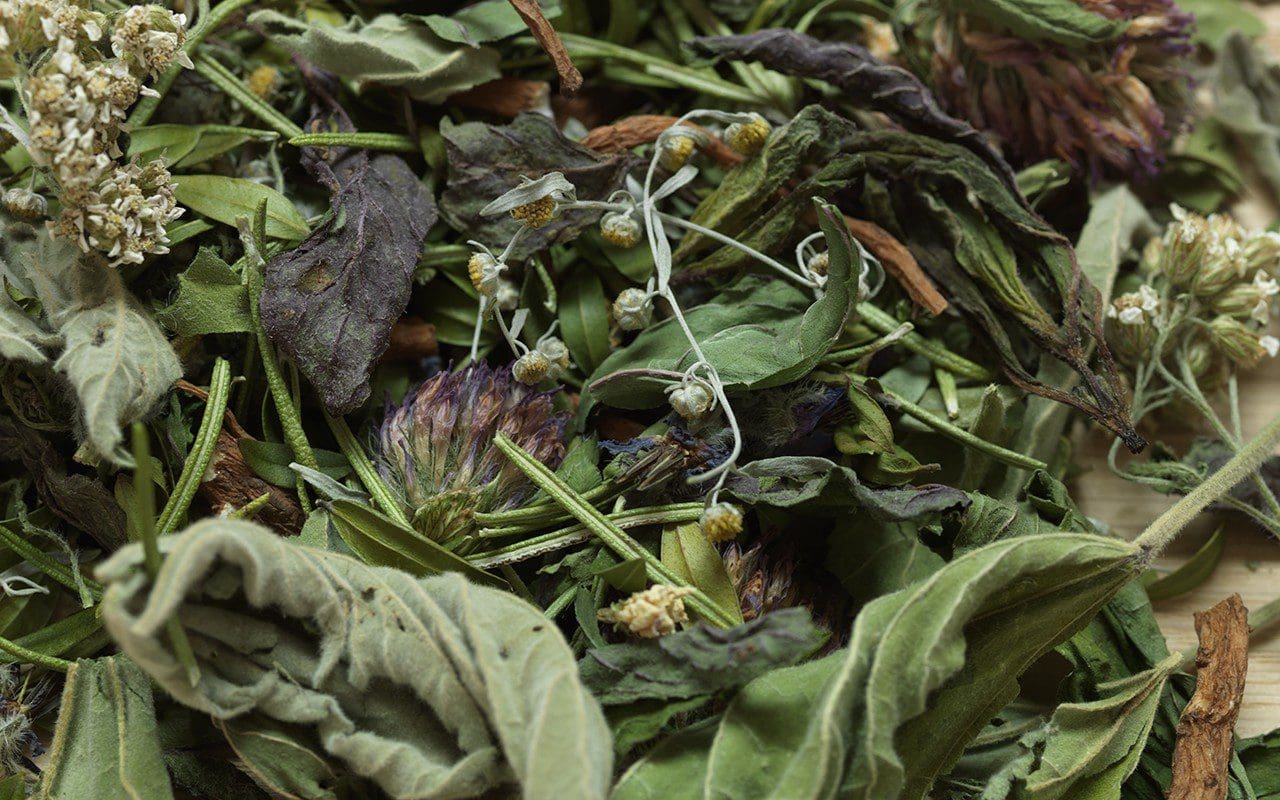 The Herball’s Of Herbs infusion contains marshmallow, peppermint, red clover, wormwood, burdock, lemon balm , rosemary, yarrow, goats rue and fennel
The Herball’s Of Herbs infusion contains marshmallow, peppermint, red clover, wormwood, burdock, lemon balm , rosemary, yarrow, goats rue and fennel
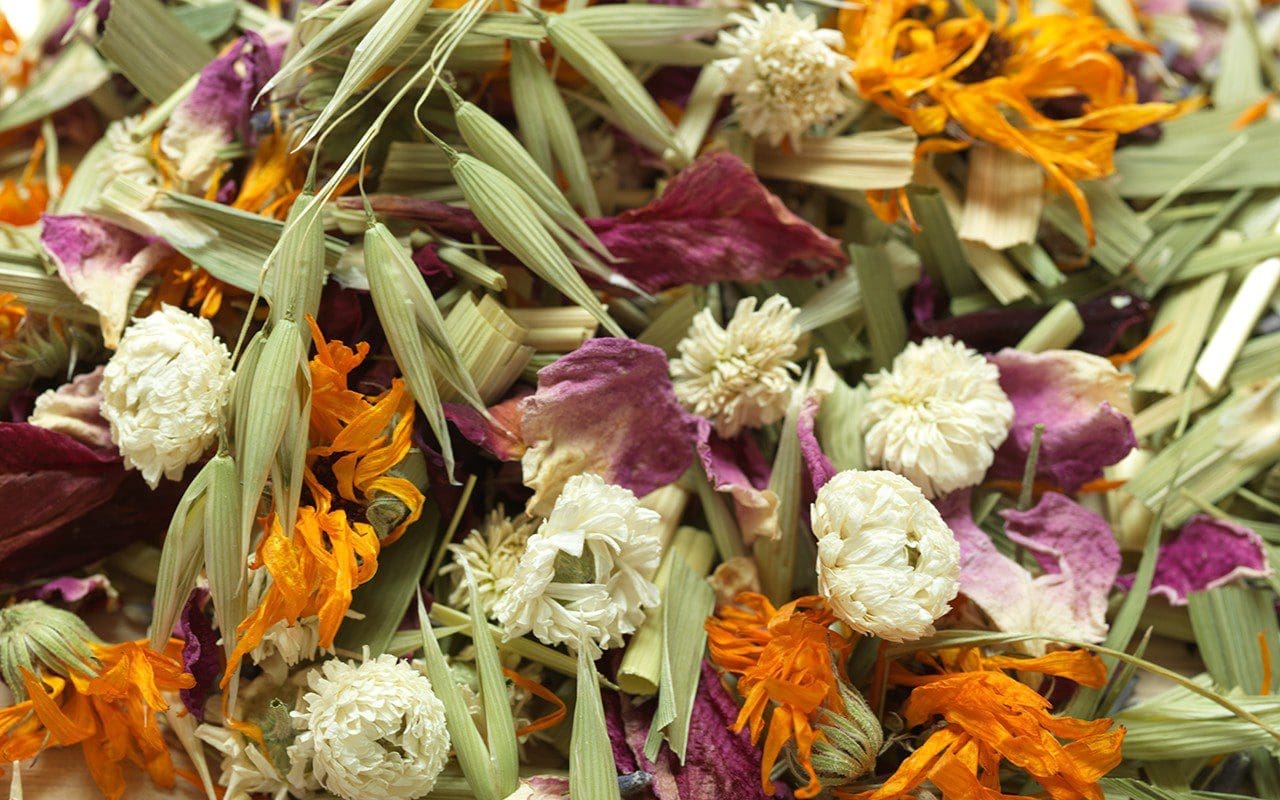 The Herball’s Of Flowers infusion contains oat straw, Roman chamomile, calendula, rose, lavender and goldenrod
The Herball’s Of Flowers infusion contains oat straw, Roman chamomile, calendula, rose, lavender and goldenrod
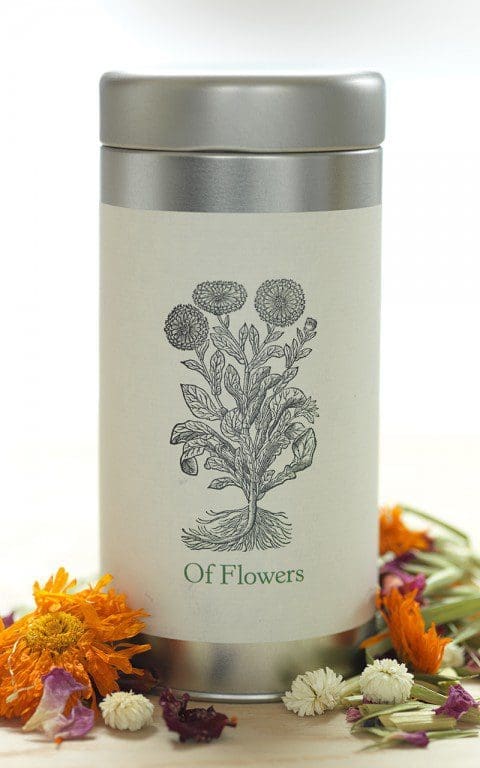
You have a book coming out in the new year. Can you tell us a bit about it?
Super exciting, yes. It’s a book on my work really. I talk about my inspirations, some of the plants that I work with, when and how to harvest them and then how you can work with those plants to create dynamic and delicious botanical drinks. I talk about distillation, extraction methods, drying and processing the plants and then there are over fifty recipes, all without alcohol.
Would you share a recipe with us that readers can try at home?
Sure. I’m drinking a lot of sage right now so here is a simple recipe with sage including a quote from John Gerard, whose work we have been greatly inspired by, he wrote (or collated and published) the seminal text The Herball or Generall historie of plantes, 1597.
THE WISE ONE
‘Sage is singularly good for the head and brain, it quickeneth the senses and memory, strengtheneth the sinews, restoreth health to those that have the palsy, and taketh away shakey trembling of the members’. John Gerard 1545 – 1612.
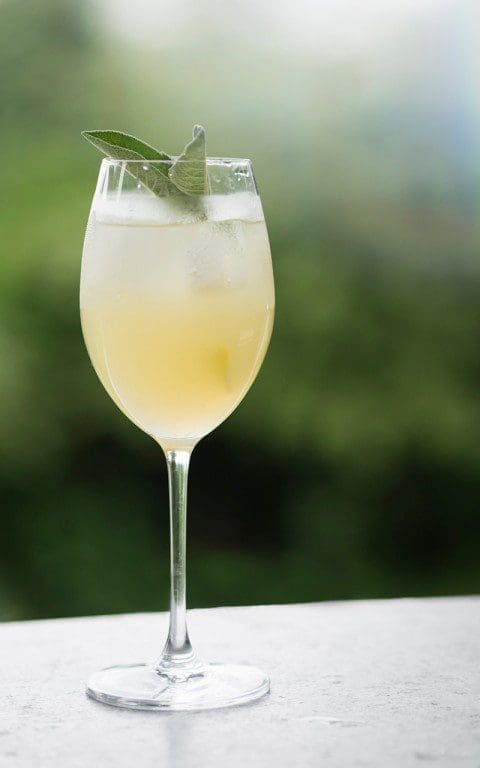 Photo: Susan Bell
Photo: Susan Bell
This is a contemporary take on a classic sage preparation to produce a cooling, blood cleansing formula, which makes for a sensational afternoon tipple.
Plants & Ingredients
Sage Salvia officinalis
Lemon Citrus limon
Sugar Saccharum officinarum
Water
Recipe
15g fresh sage
4 lemons
500ml hot water
75ml lemon & sage sherbet (see below)
100g sugar
Method
Boil the water, then pour over 10g of sage into a pot with a lid. Infuse with the lid on for 30 minutes before straining into another jug or decanter. Peel 1 of the lemons and keep the zest. Add the juice of that lemon and the sherbet to the decanter and stir until dissolved. Keep the jug or decanter in the fridge to chill and serve once cold.
Serve in a wine glass with the remaining twist of lemon and fresh sage leaves
For the Sherbet
Peel the remaining 3 lemons, then put the zests in a container with the sugar and the remaining 5g of sage. Press the zests with the sugar and sage for a minute or so, then juice the lemons and stir the juice into the sugar mixture. Seal and leave to infuse overnight, or for at least 6 hours. Stir, strain and bottle. This will keep refrigerated for at least 1 month and can be enjoyed with still and sparkling water.
The Herball’s Guide to Botanical Drinks: A Compendium of plant-based potions to Energise, Cleanse, Restore, Boost Sleep and Lift the Heart by Michael Isted, photography by Susan Bell, will be published by Jacqui Small in February 2018. Pre-order here.
Twitter: @TheHerball
Instagram: theherball
Interview: Huw Morgan/All other photographs: Laura Knox
Published 30 September 2017
Clare Melinsky is a linocut illustrator, who created the cover and monthly chapter plant illustrations for Natural Selection, Dan’s new book which is being published by Guardian Faber on May 4. Clare was chosen for her keen eye for botanical detail, her innate understanding of plants and her talent for graphic simplicity.
You originally studied Theatre Design at Central School of Art. How did the change to linocut and illustration come about ?
In Theatre we had a seriously practical course with actual budgets for putting on productions with real actors. We stayed up all night sewing on buttons and painting scenery. It taught me about deadlines and responsibility, skills you would not normally associate with an art school education. And I also learned that the theatre world didn’t suit my temperament.
In the Foundation year at Central I had enjoyed a week of printing linocuts, and after I left college I did some linocut printing on textiles. A publisher friend, Richard Garnett at Macmillan, asked if he could use one of my motifs on a book cover: so I discovered the world of editorial illustration. At the same time Mark Reddy, a contemporary at Central, was starting out in advertising, and he, too, commissioned a linocut image from me. So I also discovered the existence of illustration in the commercial world. Both were much more financially rewarding than printing bedspreads and cushion covers. Light bulb moment: I would be an illustrator.
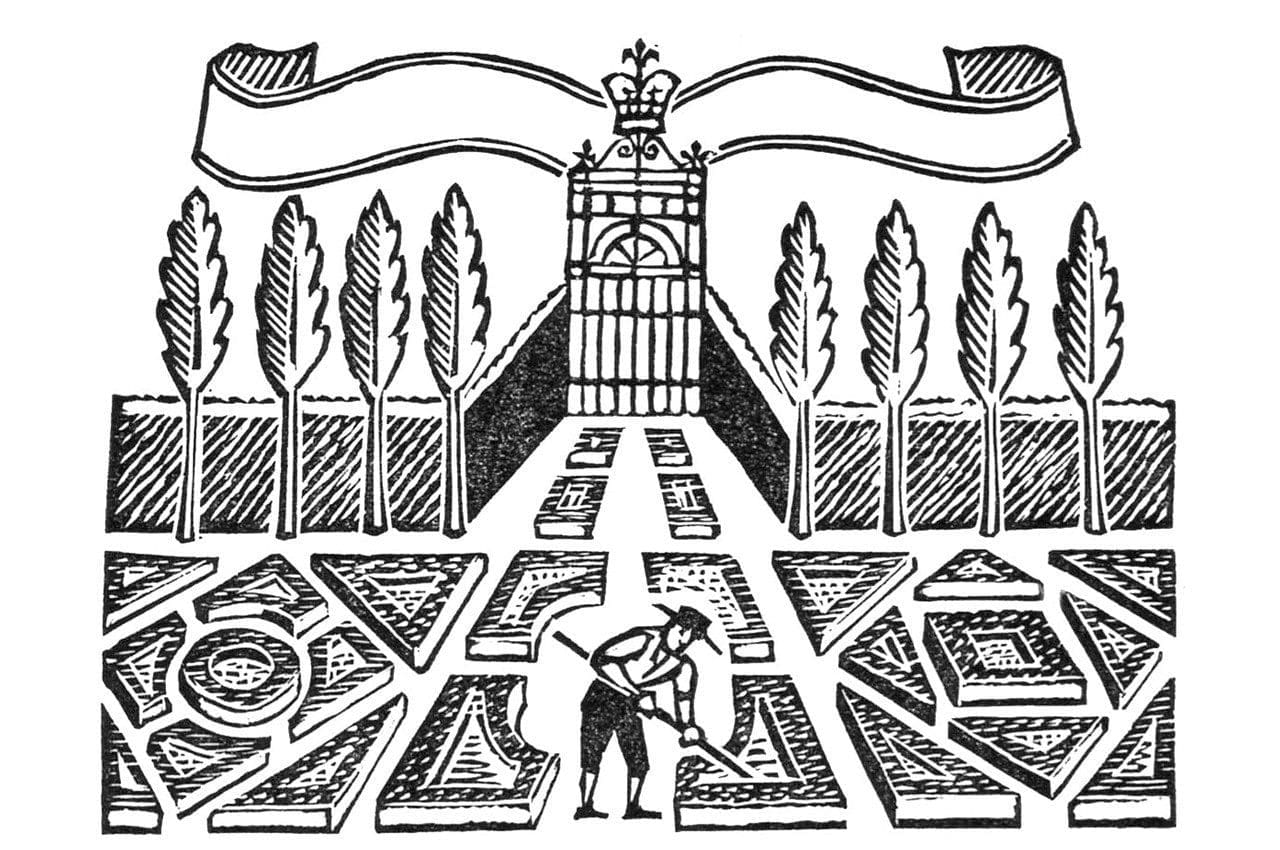 Illustration for Tesco wine label
Illustration for Tesco wine label
There is clearly a connection between theatre and the narrative complexity and framing of many of your illustrations. How do you go about identifying the elements required for a commission and then putting them together in a coherent whole ?
I have always enjoyed the research part of a job. As a student I spent many happy days ordering up stacks of dusty books from the card index at the V & A library, and sketching in the galleries. Now I have my own collection of reference books which I know inside out.
I like to get authentic detail of the time and place, and look for telling motifs rather than invent my own. For example the figure of Juliet on the Penguin Shakespeare cover is based on a tiny detail in an Italian fresco that I came across when looking at contemporary images, a lady leaning on a balcony: there was my Juliet. Having identified the elements, I then apply structure and colour and contrast to the specified size and shape in the short time available. Rather like garden design, I suppose.
 The Holm
The Holm
You have said that your work is inspired by historic woodcuts. I can see echoes of Edward Bawden, Eric Ravilious and others in your work, and many of your plant portraits have a distinctly Japanese feel to them. Can you tell me about artists that have inspired you ?
I am a big fan of Bawden and Ravilious. I first came across their work at an exhibition at the Tate in 1977: The Curwen Press collection. It was a seminal moment. Before that I had studied technique by looking at Bewick’s wood engravings (1800-ish) and Joseph Crawhall’s popular woodcuts from the 1890’s.
Some years later I was given a secondhand book of mid 20th century Japanese prints collected by an American, Oliver Statler, when he was stationed in Japan after the war. These prints are known as Hanga: a revelation to me. A whole new way of looking at relief prints. More recently my daughter Jessie spent two years in Japan on a Daiwa scholarship doing part two of her architecture degree. So I was able to visit her in Tokyo, and travel during the traditional cherry blossom festival time which added a lot to my appreciation of Japanese style, and prints in particular.
Seeing the gardens in Kyoto was so exciting, in the context of their temples. Our accommodation in Kyoto was in a monastery, and we were expected to meditate in the temple for an hour before breakfast, which was mushroom broth. In the hillside moss garden, we saw the monks (or were they gardeners?) picking fallen leaves out of the moss to keep it pristine.
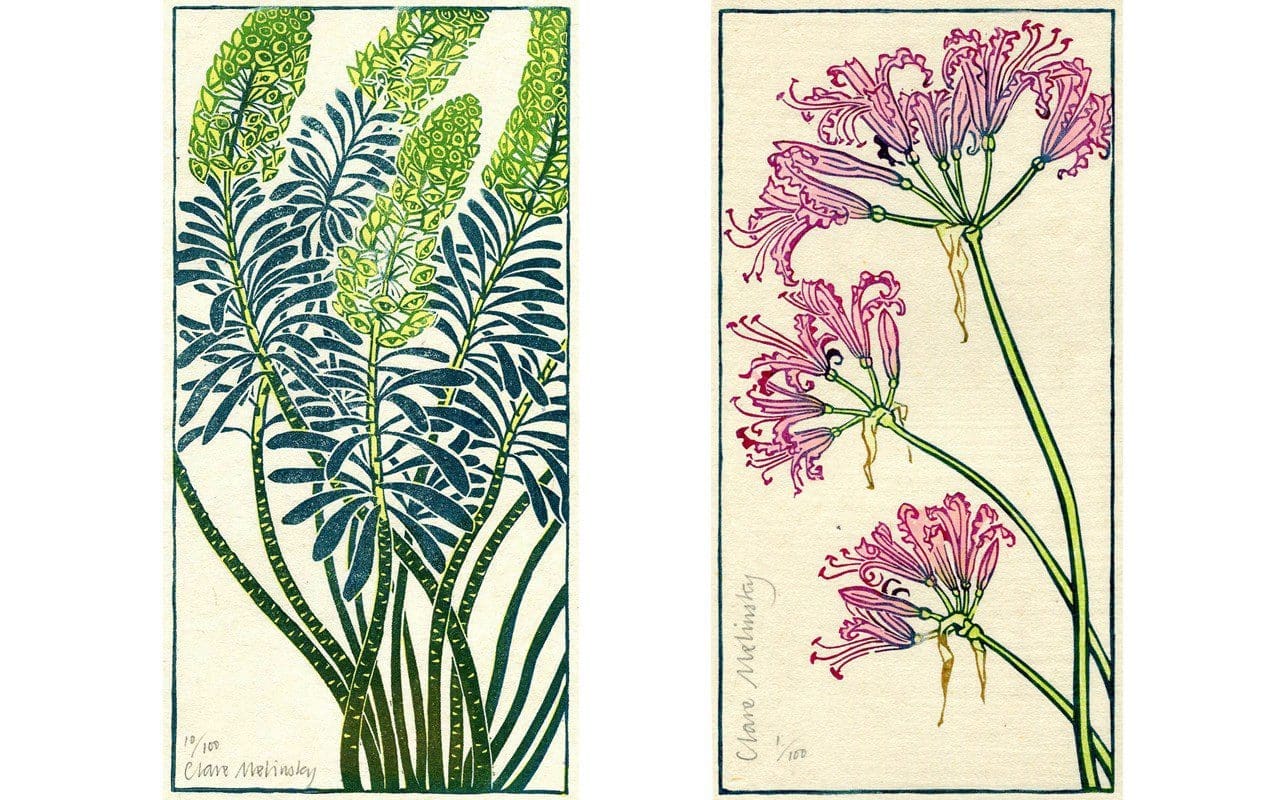 Euphorbia characias and Nerine bowdenii from the Cally Gardens Florilegium
Euphorbia characias and Nerine bowdenii from the Cally Gardens Florilegium
You have said that your garden can easily distract you from your linocuts. Can you tell me about your garden and what it means to you personally and professionally ?
After graduating I still lived in London. But my partner and I spent the summers with his sister’s young family in south west Scotland on their smallholding: we decided that was the life for us too. We started with twelve boggy acres at 1000 feet (300 metres). That means high up in the hills. We were the last house, six miles up a single track road in Dumfries and Galloway, south west Scotland. Sheep, goats, a dairy cow and calves, hens, two children, geese, a pony… we were very ignorant but it was a good life and I have no regrets.
It was originally my partner who was the gardener: we had a huge and productive veg plot, organic of course, with a big input of muck from the beasts. Very good soft fruit too. It was such a good lifestyle choice, because it meant that we could afford to live off my earnings in the early years. I could never have earned enough as an illustrator to support a family, if I had stayed in London.
After thirteen years it was time to move somewhere more sensible. Not far from our first house, but a bit nearer sea level and civilisation, we now have just one cat and a garden, with a wood at the back of the house and a burn running alongside. Lots of hardy perennial flowers and a small fruit and veg plot. Whenever the sun is warm I drop what I am doing and go outside with my gardening gloves on for a couple of hours. The climate here is so wet that you absolutely have to enjoy any fine weather when it comes.
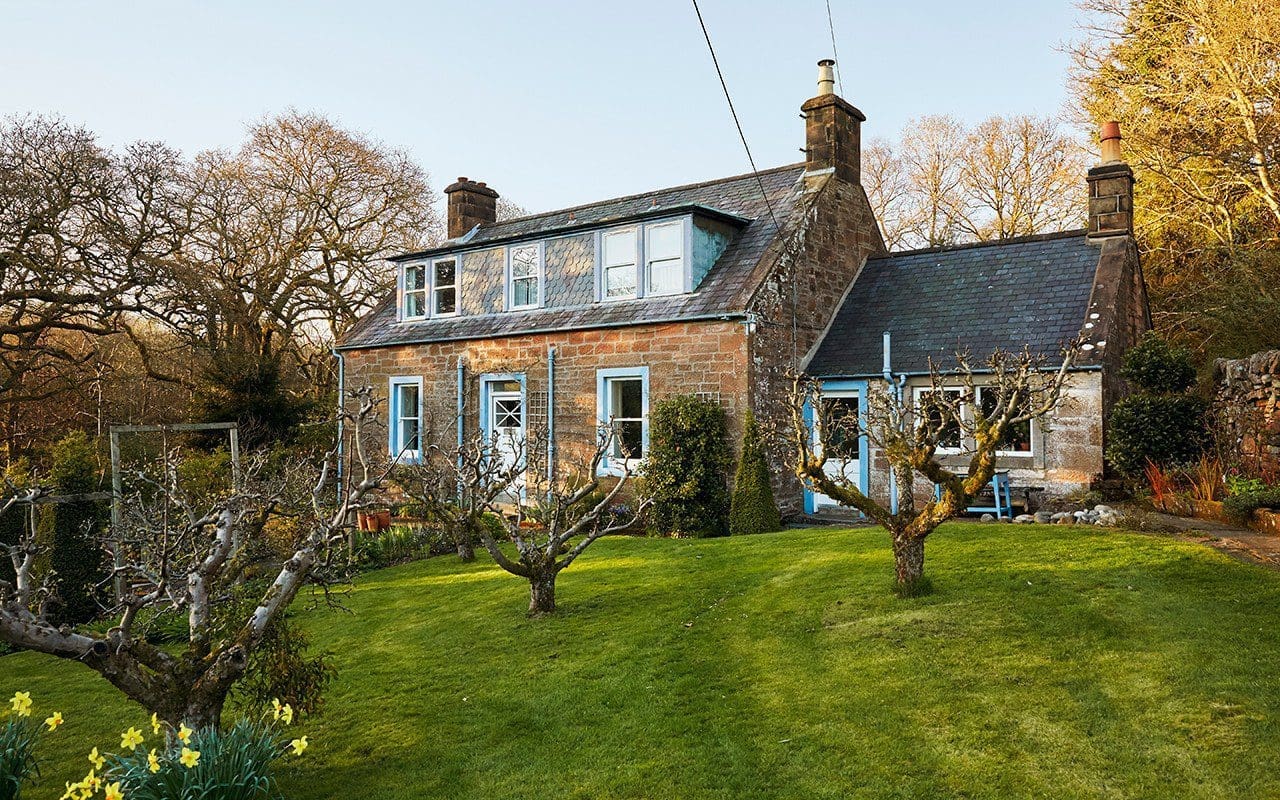
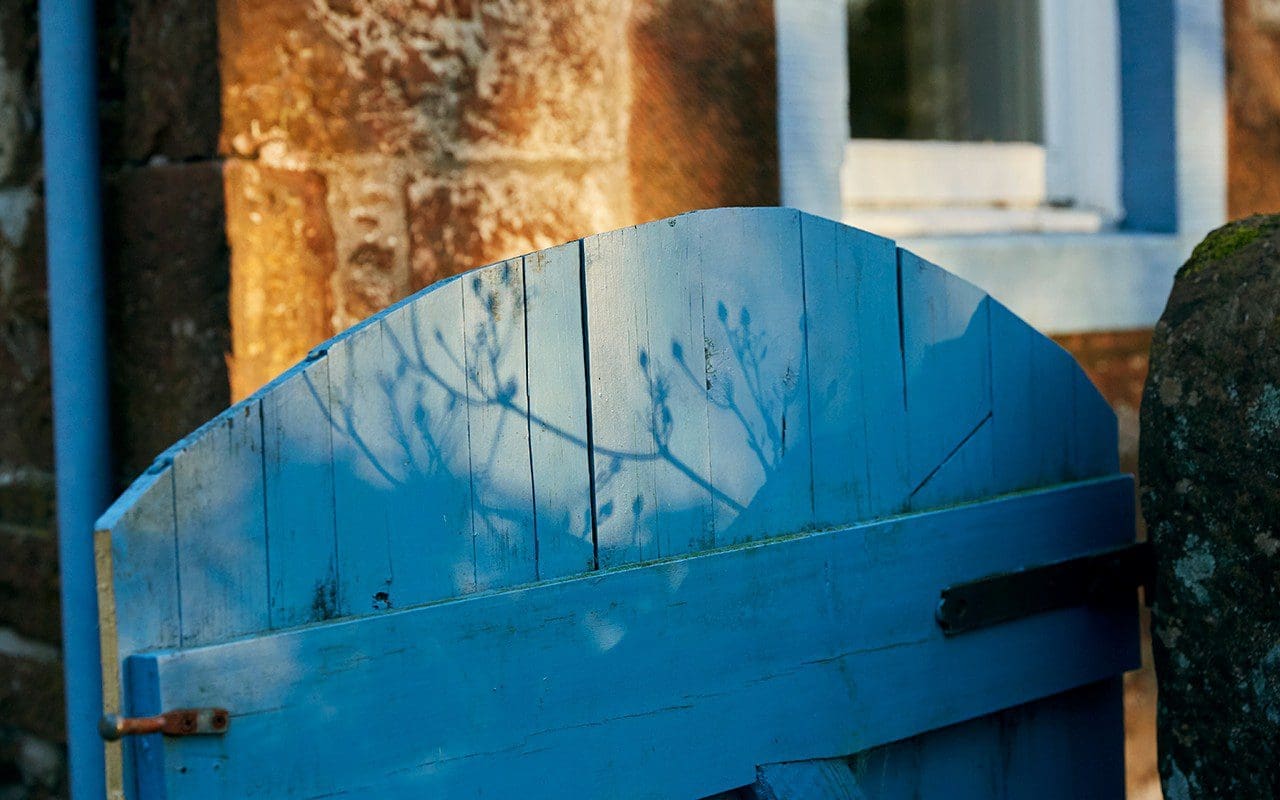
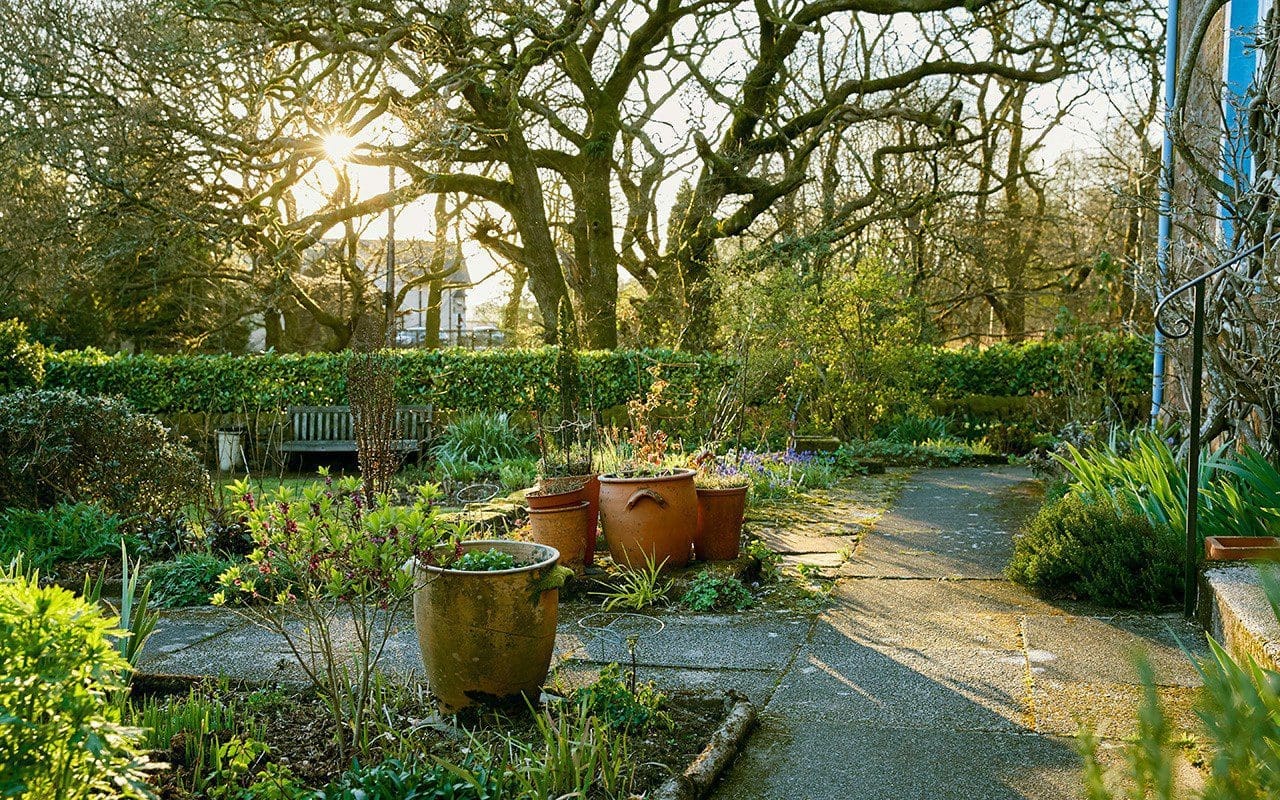 Clare’s house and garden in early April
Clare’s house and garden in early April
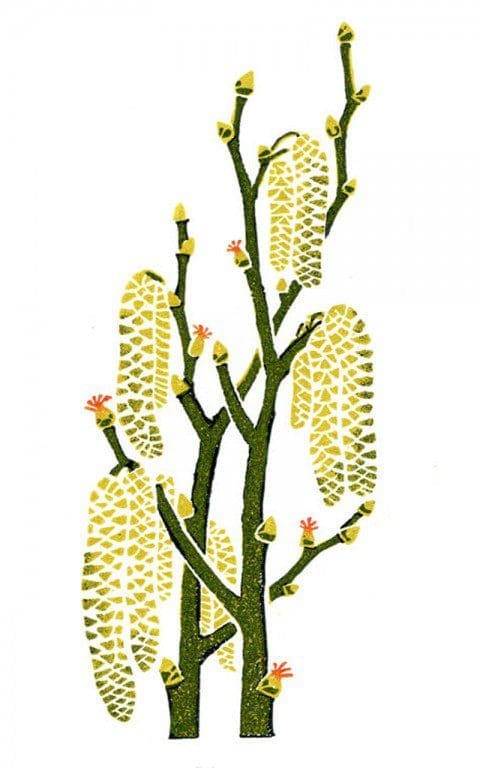 Hazel catkins
Hazel catkins
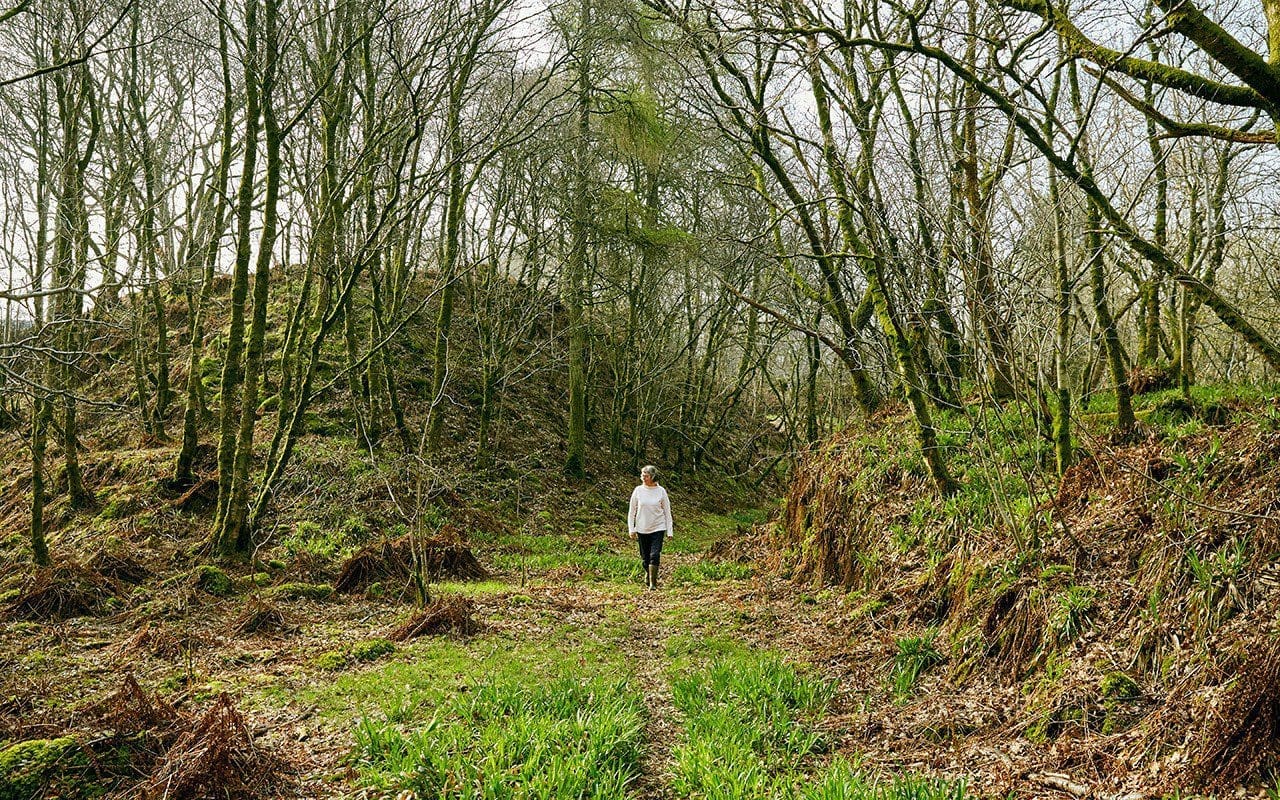
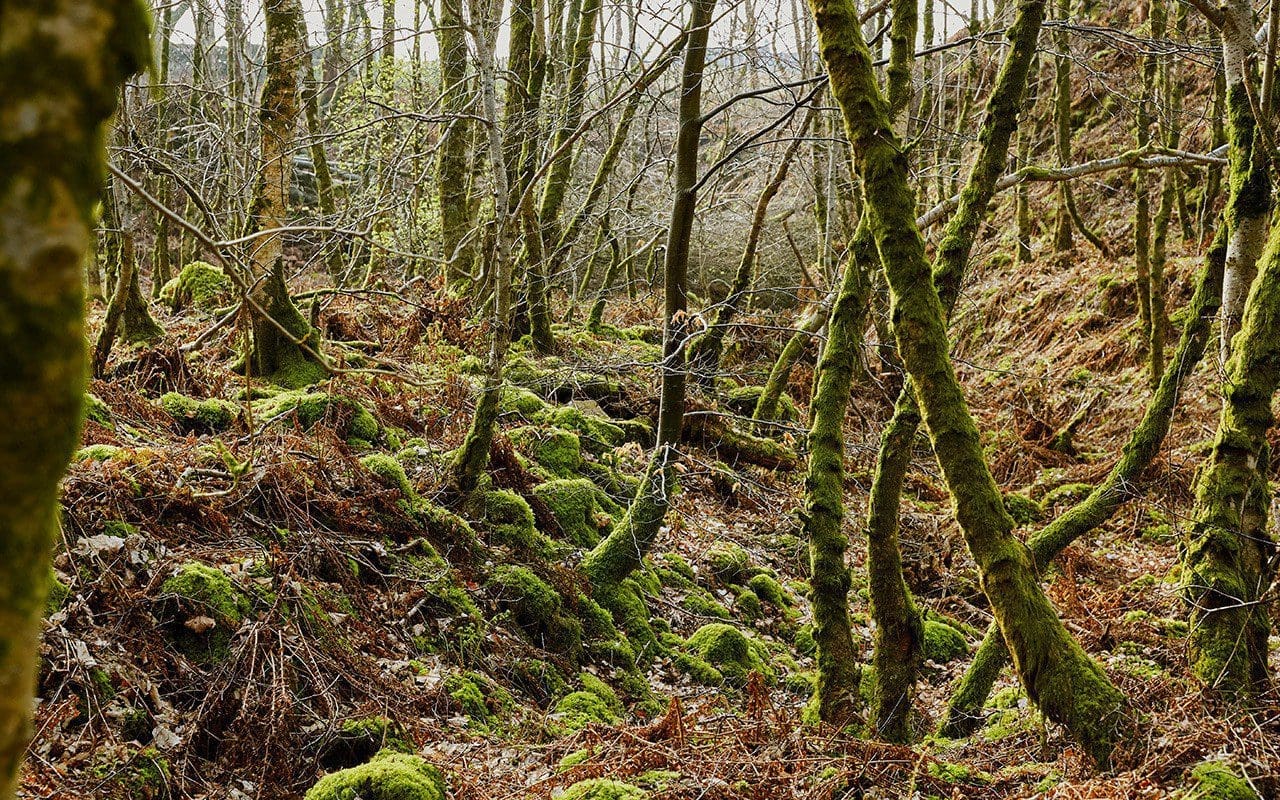 In the woods behind Clare’s house
In the woods behind Clare’s house
You work across a wide range of different media including book covers, stamps, product packaging and editorial. However, it seems that you include plants and landscape in your illustrations whenever relevant and possible. Can you tell me how your garden, landscape and plants inspire your work and influence the commissions that you accept ?
It’s what I see when I look out of the window. Most of my holidays are actually in cities by way of contrast: visiting my son Tom who lives and works in New York for example. I accept most commissions that come from my agent if I have the time: each job stimulates new ideas and creative development.
Gardening wasn’t a memorable part of childhood. I do remember individual plant experiences: a sea of lupins, as tall as us children, blue and pink and mauve, at the foot of the sand dunes on the Norfolk coast where we spent our summer holidays. A ravishing philadelphus enveloping the shed when I wheeled out my bike to cycle to school. A cataract of wisteria on an old rectory we used to visit.
My favourite toy at one time was a Britain’s Miniature Garden: little brown plastic rectangles and semicircles were the flowerbeds, dotted with holes into which you could push different clumps of coloured plastic flowers. You could buy individual flat-pack trees ready to assemble. Cardboard flagstone paths and rectangles of green flocked card with mowing-striped pattern. Little plastic rockeries and a pond and stone walls. I would save up my meagre pocket money to buy a new pack of plastic hollyhocks. Maybe that’s why I now have no hesitation in digging up a whole clump of perennials in full flower and replanting, if I decide that something is in the wrong place.
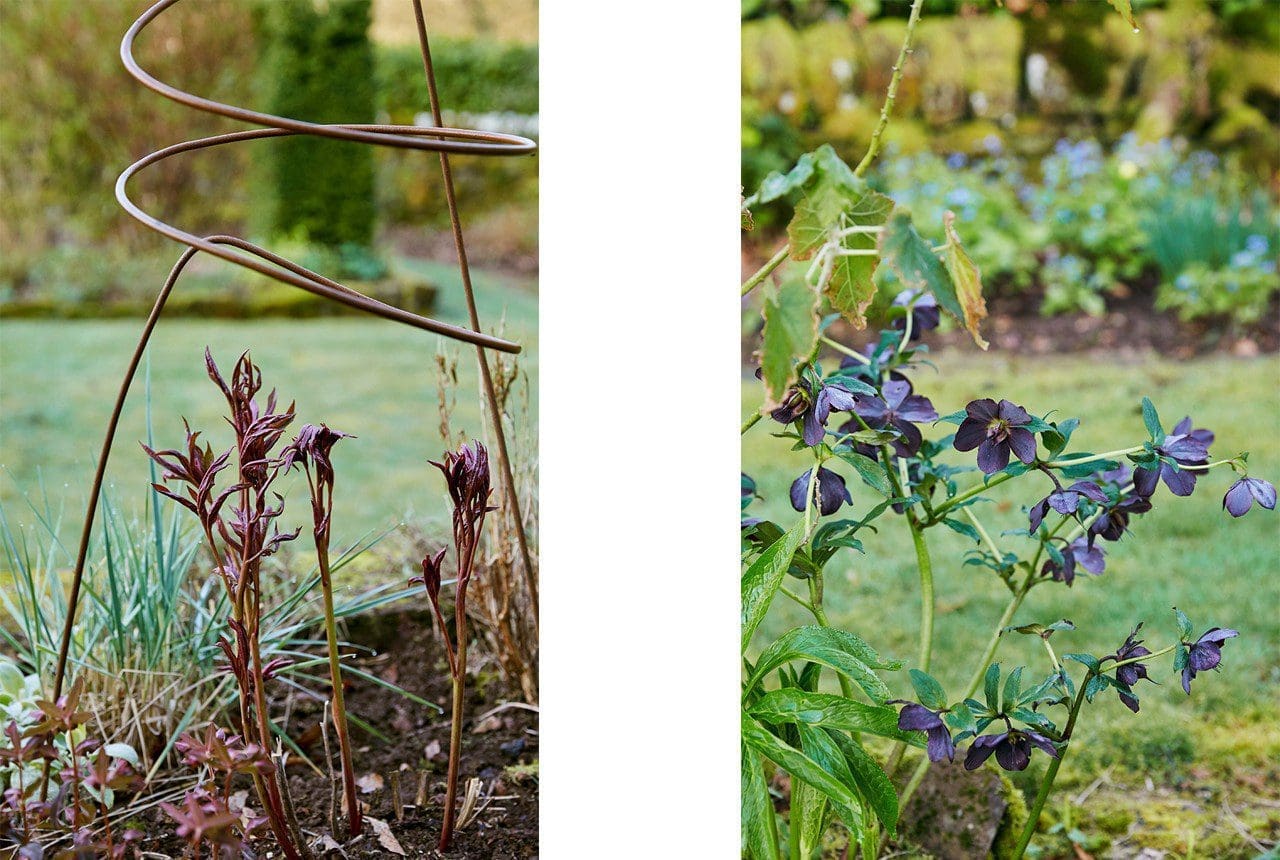
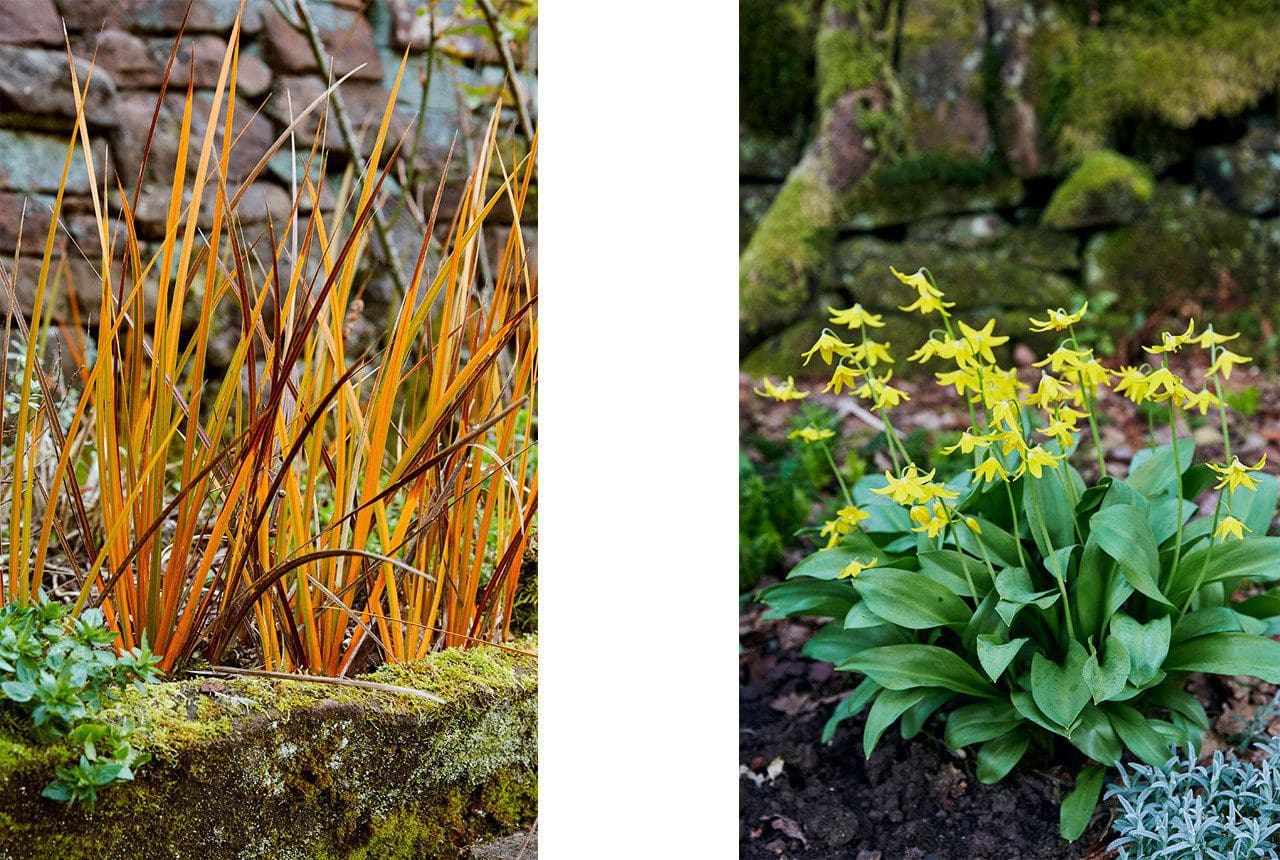 Whenever possible Clare draws from life using the plants in her garden
Whenever possible Clare draws from life using the plants in her garden
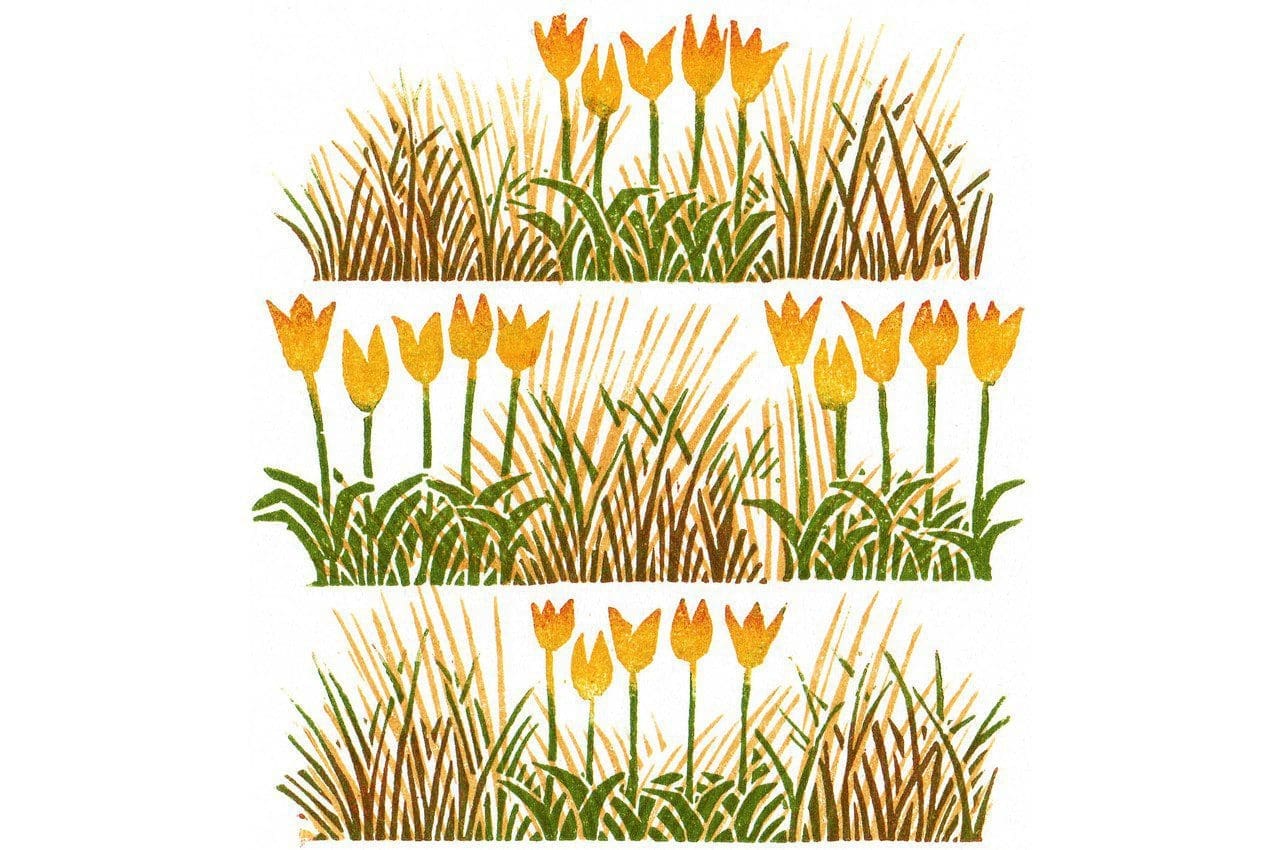 Tulips
Tulips
Given the breadth of your commissions do you have a favourite subject matter ? Which appeals to you most ?
My agent comes up with very varied jobs – and I like that. I was so lucky to be invited to join the Central Illustration Agency when Brian Grimwood first started it. It is the one thing that makes it possible for me to live in the country, and still access the world of work in London. There is no continuity to the work, it is completely unpredictable what people ask for. The client has chosen me because they like my linocut style. So it is often more of the same. Since I finished your book I have done images for food packaging for Waitrose, a folk tale illustration for Britain magazine, and some labels for a local cider maker. Sometimes it all goes quiet and I don’t get a job for six months.
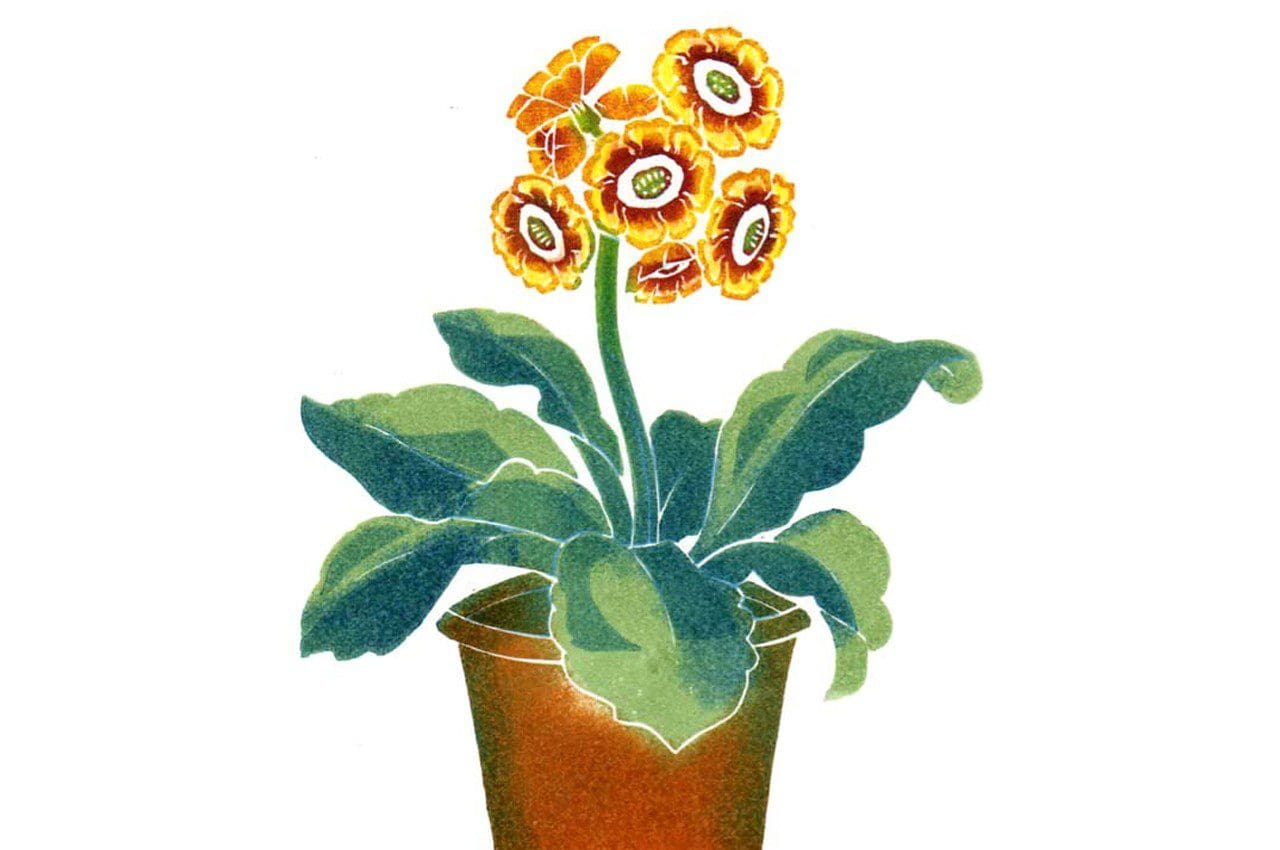 Primula auricula
Primula auricula
Can you explain your design process from sketch to finished print ?
I do a rough drawing to show the client. Once that is approved, I transfer the image onto a piece of linoleum. I buy my lino from a flooring supplier by the metre. Cutting a design into a piece of lino calls for simplification and clarity. I am obliged to be selective. If in doubt, leave it out.
As it is a print, everything has to be done as a mirror image. I cut into the lino with a set of five small v-shaped and u-shaped gauges. I have to decide whether to show the veins on a leaf, or the outline of a leaf, or I can just depict the solid shape of the leaf. Less is more. The areas of lino that I cut away won’t print. When I roll the ink onto the finished block, the remaining lino will pick up the ink. Then I make a print using my big press.
I can print in black and white, but mostly my work is brightly coloured as it will be used on a book jacket or for packaging. I can add more than one colour onto each block using small rollers. Where the colours merge makes an interesting blend. Then when I print a second block over the first print, more subtle and interesting and unexpected things happen. The inks can be mixed to be quite transparent, or quite opaque. I use linseed oil-based relief printing inks from Lawrence. I was introduced to Lawrence’s at art school, when they were at Bleeding Heart Yard in London. I am still using the same tools that I bought there, though the smallest v-tool has been retired and replaced: it became rather short after years of sharpening.
Making the drawn line into a cut line transforms the quality of the line itself. I am still always surprised by what I have created when I see the first print.
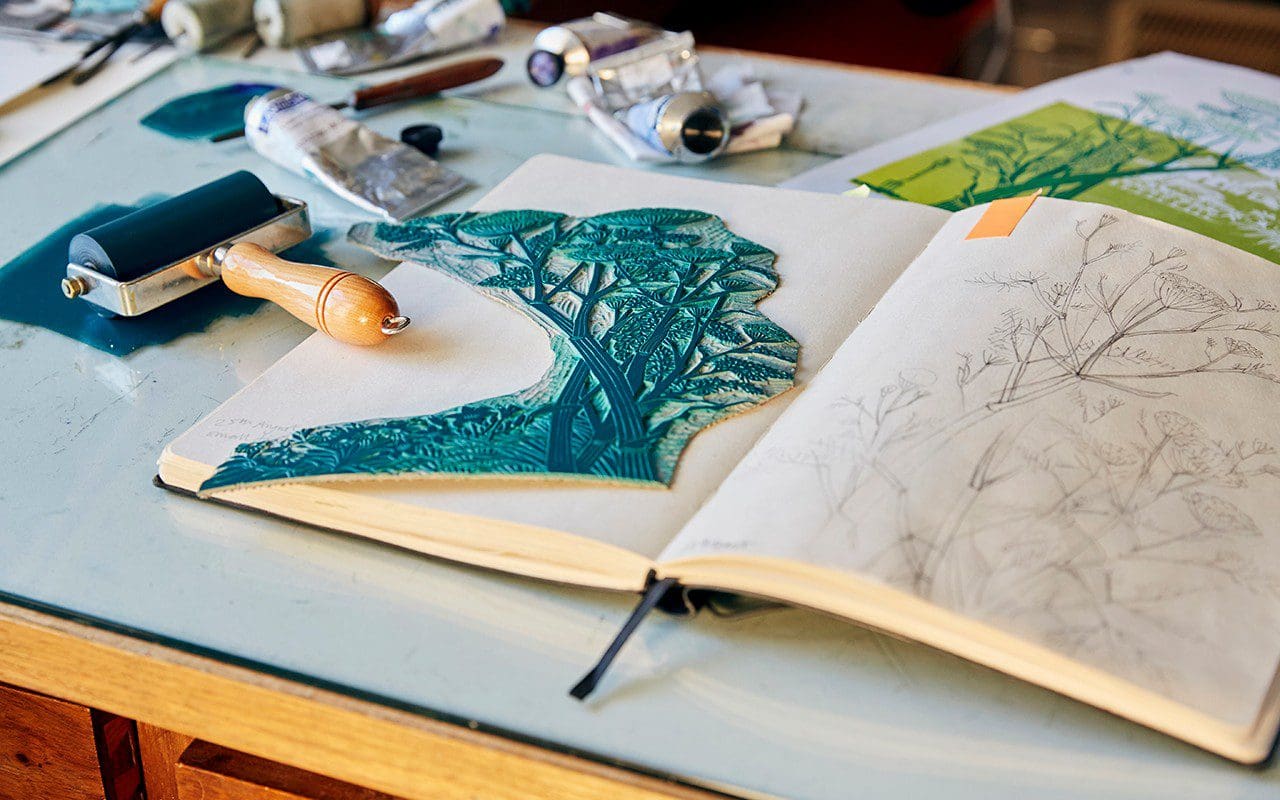
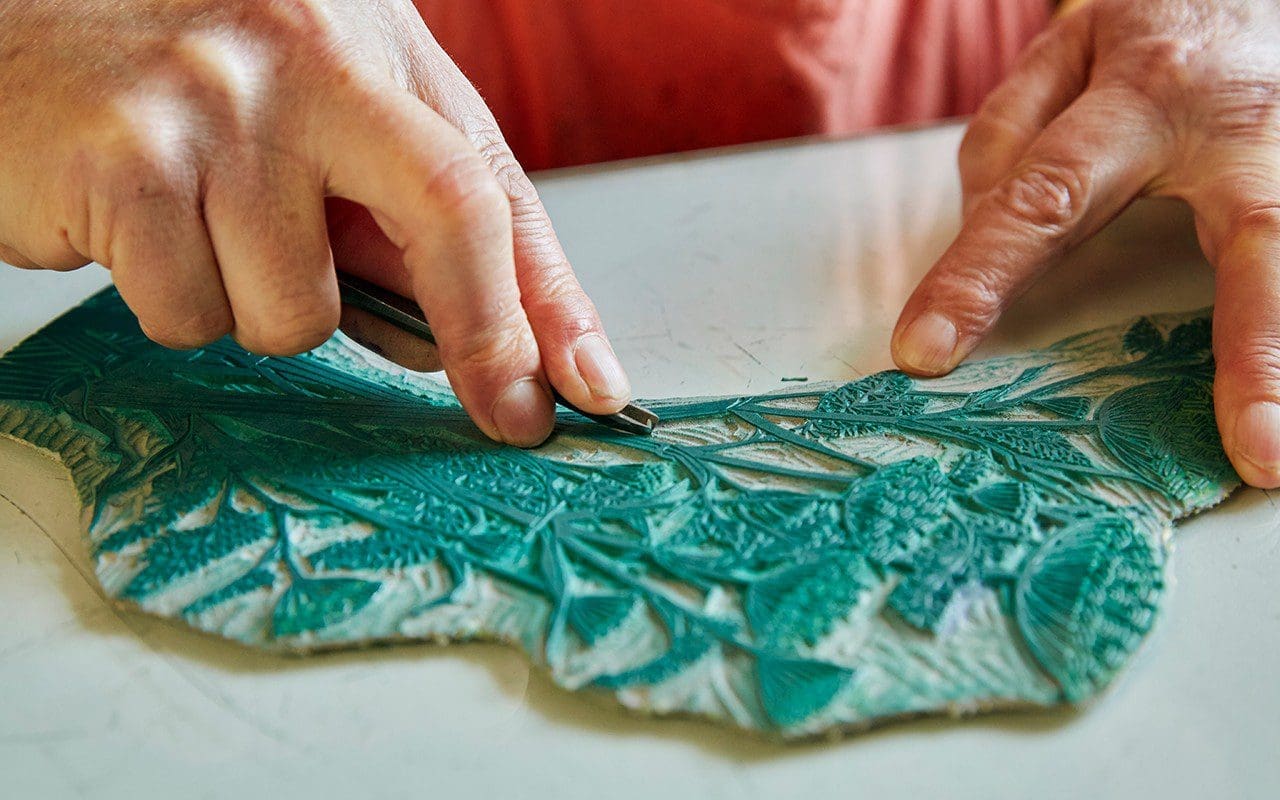
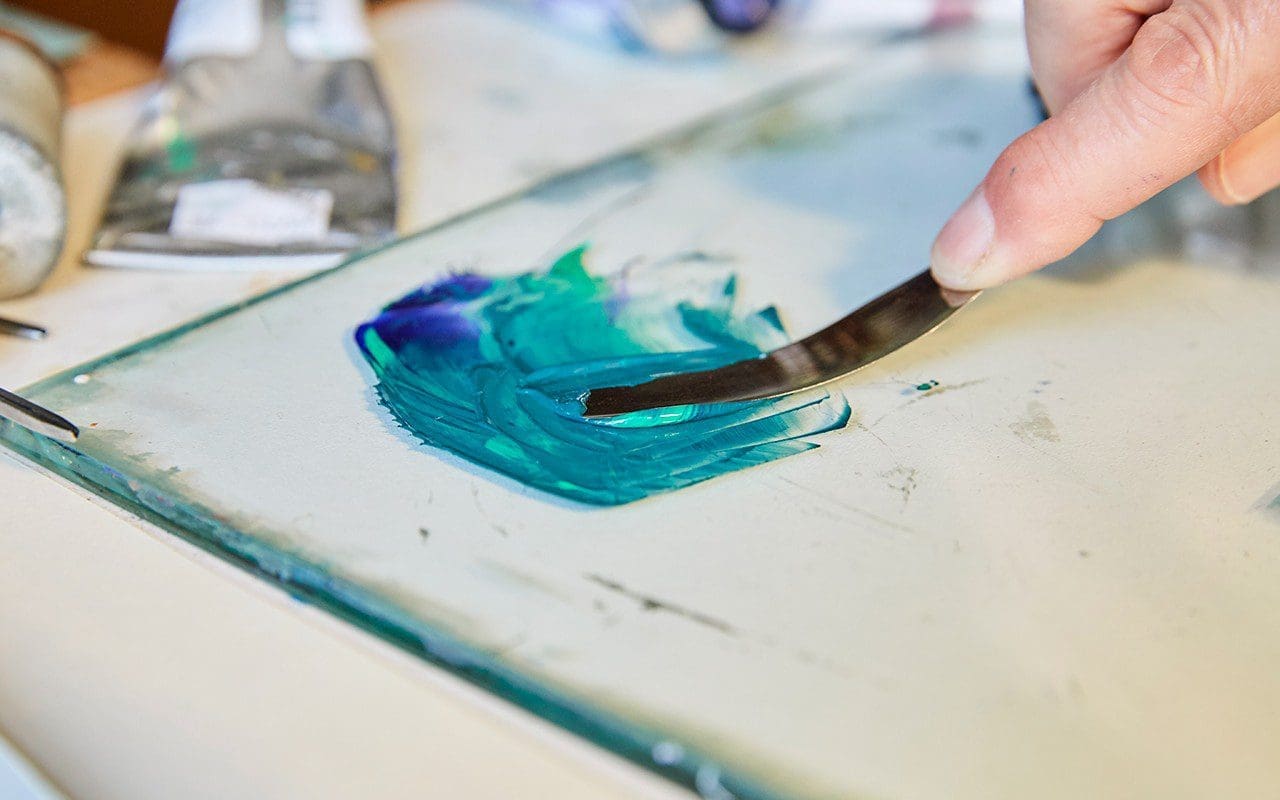
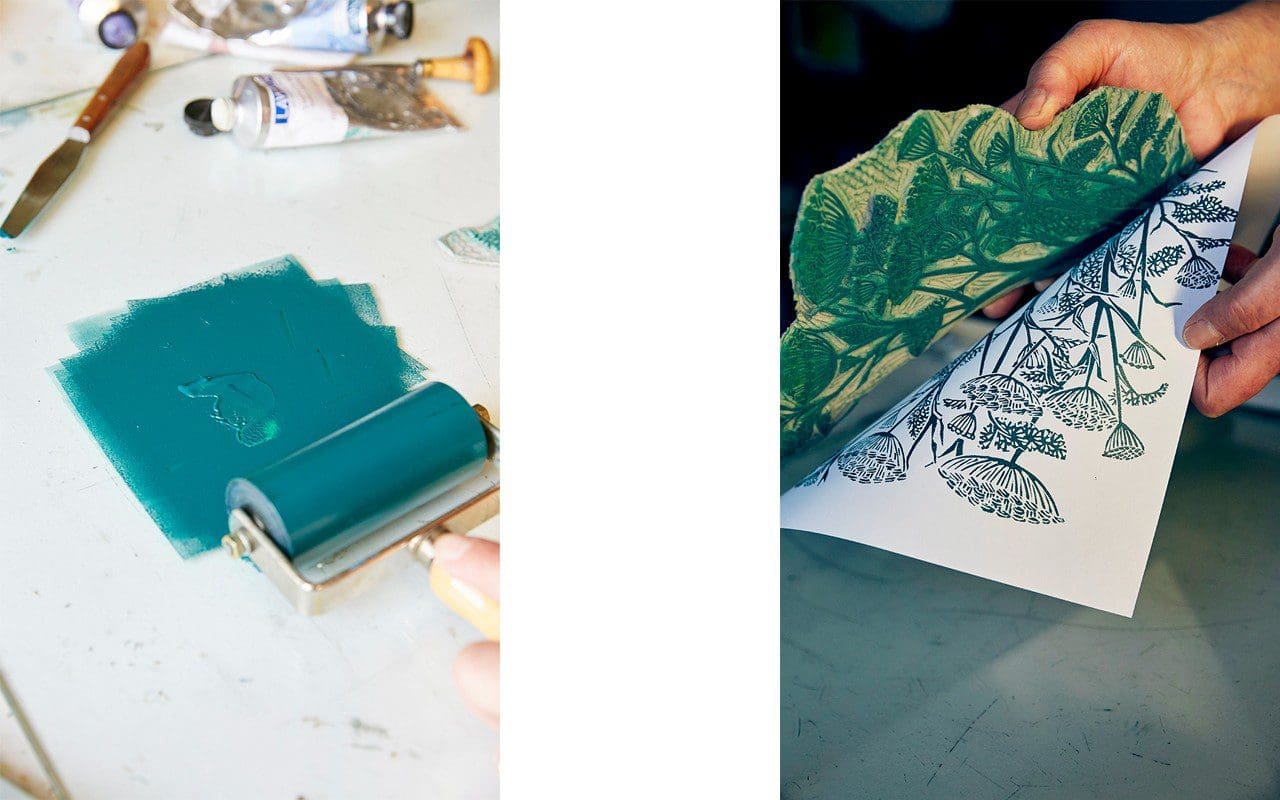
How did you approach the commissions for Natural Selection ? The cover image features a house which looks very like Dan’s house in Somerset. Did you research images of it, or is it a happy accident that it looks so similar ?
I was so pleased to get this commission, I knew right away that I would love to do the book. If the house on the cover looks like Dan’s, then that is a happy accident: that’s my house more or less. Mine actually has dormer windows, but I thought Dan’s house would look more English with ordinary smallish windows.
I first came across Dan’s name in the early editions of Gardens Illustrated when it was something new and special. And have followed his career haphazardly, since I don’t have a television, in occasional gardening magazines. Dan decided to have one plant portrait for each month. We had different ideas about which plant, but I was happy to go along with his choices. The only problem was that by then it was October, so I couldn’t draw all the plants from life which would have been preferable. But mostly I had drawings that I could refer to. I happily use photos for reference, but I still think the best work is done from life if possible.
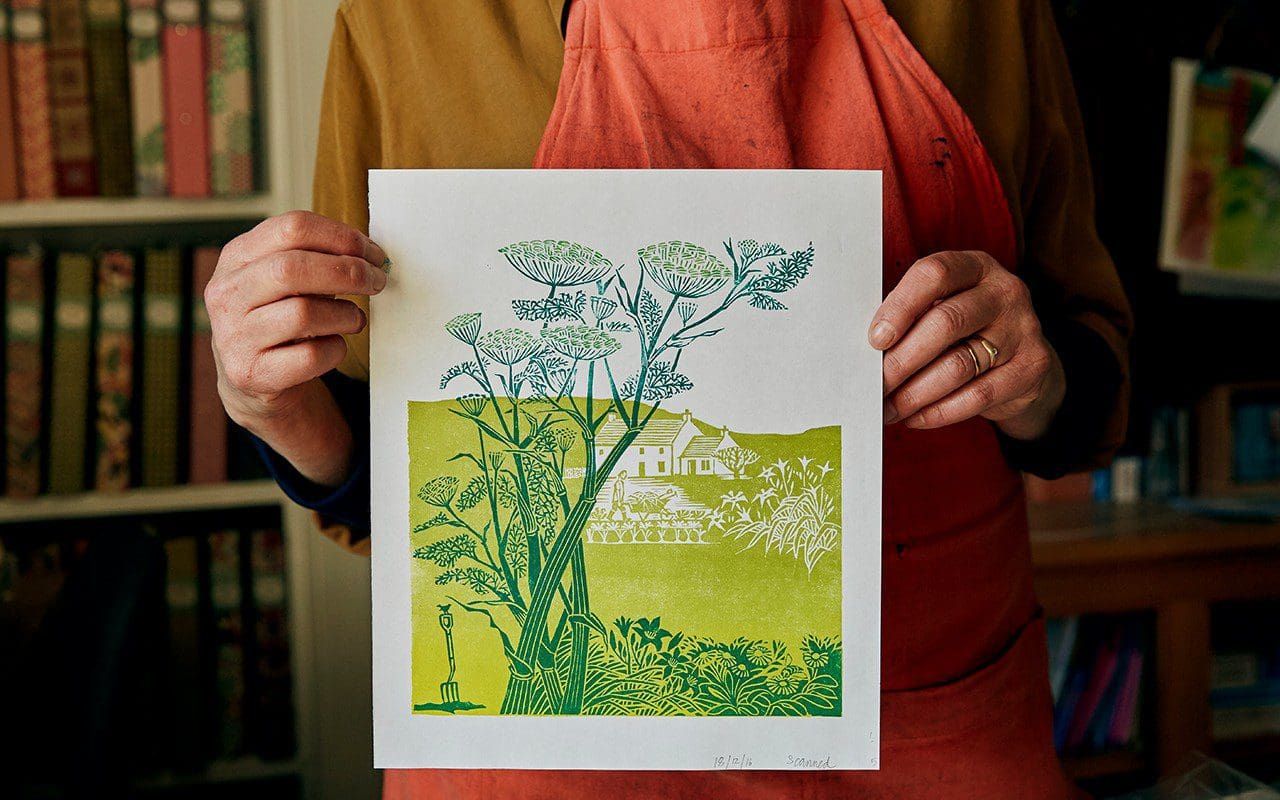 The hand-printed cover artwork for Natural Selection
The hand-printed cover artwork for Natural SelectionWhat are the greatest challenges in your work ? Can you tell me about the brief for the murals at Beatson Hospital in Glasgow ? How did you visualise your work for such a large piece and how did you scale up your linocuts for the site ?
I knew my linocuts would look good reproduced at a larger size. It enhances the irregular quality of the line, the handmade look. It was exciting to see the A4 size images enlarged to two metres high, extending over four thirty metre corridors. Each corridor was named after a Scottish island as a theme, and I rearranged my selection of details of the countryside to create a harmonious and varied flow of landscape and wildlife for patients and staff to enjoy as they passed by time after time.
The Beatson is the hospital for treating cancer patients in Glasgow, and the Macmillan Fund provided money for an art consultant, Jane Kelly, to enhance the whole interior with colour and style and fittings, with the Scottish west coast as the overall theme. Very worthwhile and successful.
Each job is a challenge. The deadlines are tight. Understanding what the client has in their head is a challenge: they often know what they want, it is my job to find out what that is and turn a concept into an artwork.
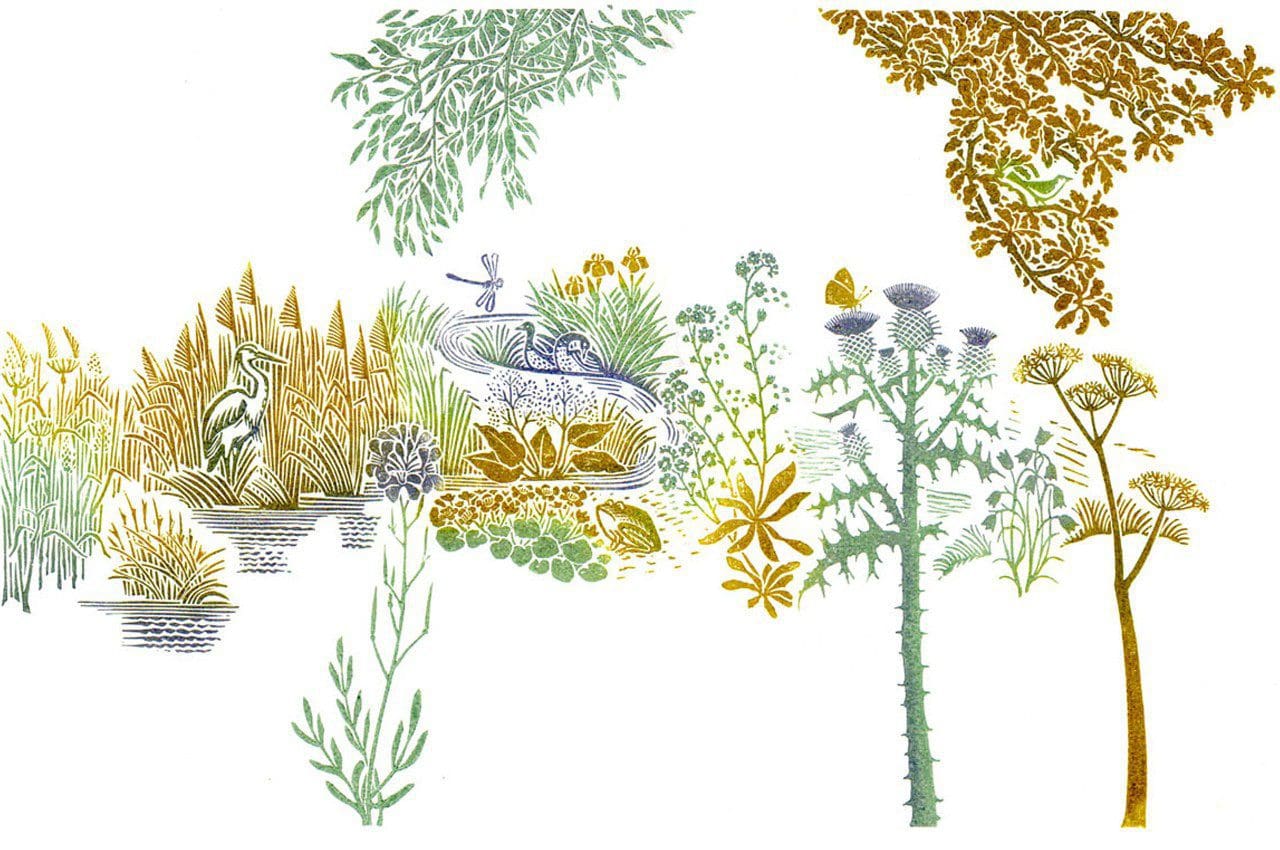 Part of the Beatson Hospital Mural
Part of the Beatson Hospital Mural
You have produced a number of illustrations for Cally Gardens over the years. It was a shock to hear of Michael Wickenden’s recent death in Myanmar while on a plant hunting expedition. Can you tell us about your relationship with Michael and the nursery ?
Michael’s fantastic nursery is an hour’s drive along the coast from here. He had bought a derelict walled garden thirty years ago and filled it with his vast collection of plants over the years. I was there doing a drawing for the Garden History Society. On seeing the final product, Michael asked if I would do a design for him to use on his Cally Gardens mail order brochure. We became firm friends, and the brochure has been published every year with my cover design. Until this year.
It is so sad that he is no longer with us, but I firmly believe he would be delighted to have died on top of a remote mountain on a great adventure. He knew that he was taking a big risk going to these remote places, and loved the expeditions, traveling with native guides under extreme conditions. As I tidy up my flowerbeds after the winter, I can recognise each plant that came from Cally, and I am reminded of Michael each time.
He was very outspoken and didn’t mind causing offence, objecting at every opportunity to the Plant Breeders Rights nonsense. I also learned from his example that my flowerbeds should be rigorously tidy in March. His garden looked like a jungle by the end of the summer, but in March everything (well no, maybe not everything, it’s a huge area) was cut back and isolated into its own distinct space. We all hope that some gardener with vision will grasp the nettle and keep the place going.
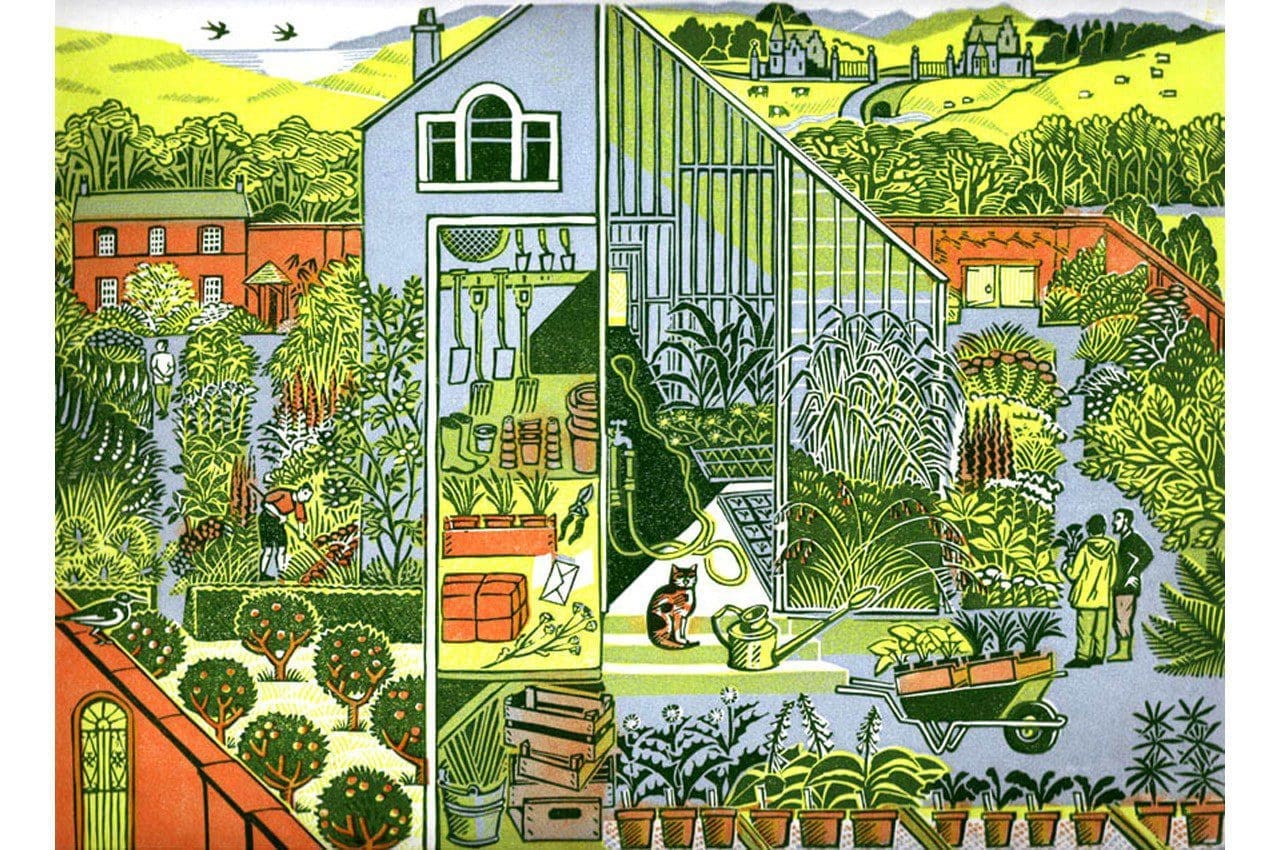 Illustration for the cover of the Cally Gardens catalogue
Illustration for the cover of the Cally Gardens catalogue
What are you working on at the moment ? What would be a dream commission ?
Just now I am designing a publicity image for an exhibition for the Royal College of General Practitioners. Then I have to print up more work for my local Open Studios event 27th-29th May 2017. I also teach linocut workshops, including residential courses at Higham Hall in the Lake District three times a year which I enjoy.
A dream commission: Natural Selection in an Italian palazzo with a cook and a housekeeper and a gardener. In the sun, with a swimming pool. With a whole year to do the work, so I could draw each plant from life. My partner and children and friends, and my agent, would come to visit at intervals…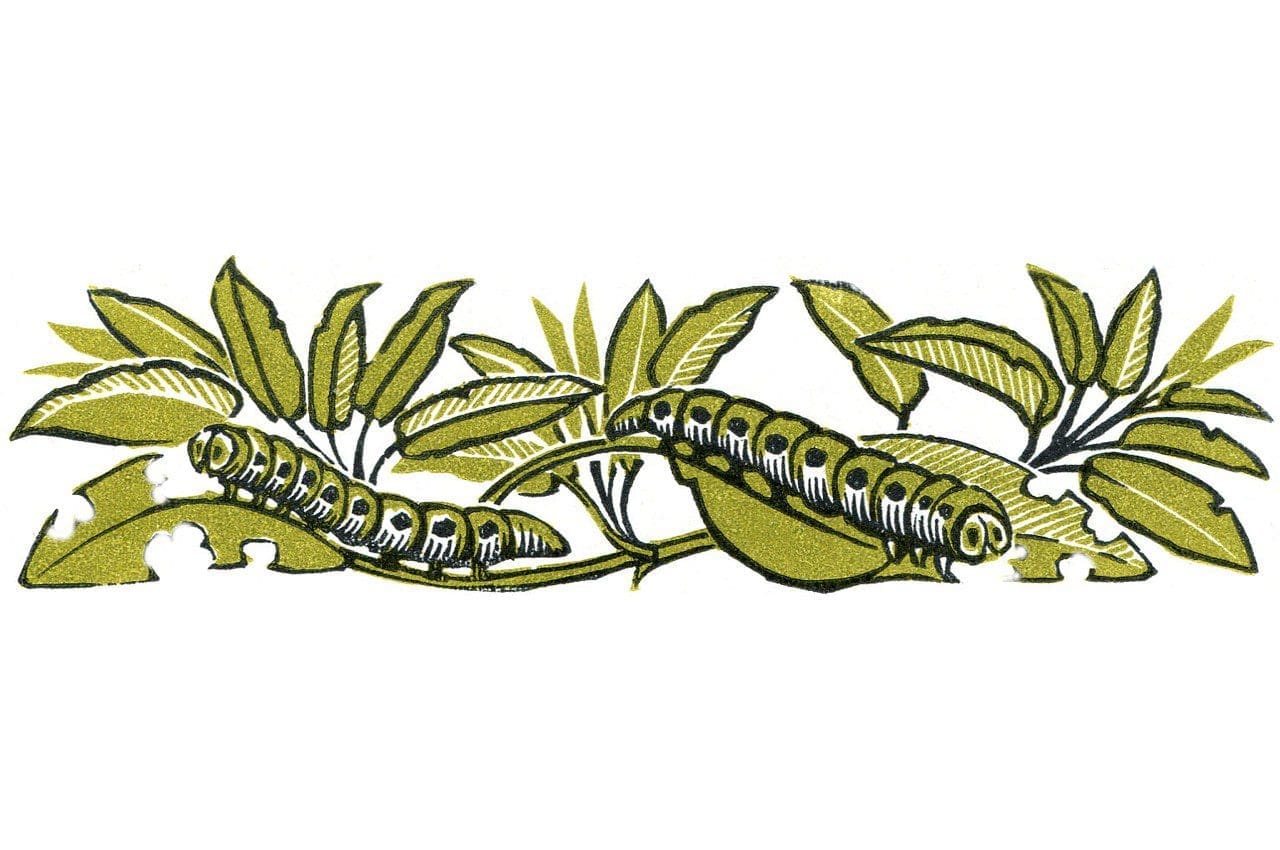 Interview: Huw Morgan / Photography: Emli Bendixen / All illustrations © Clare Melinsky
Interview: Huw Morgan / Photography: Emli Bendixen / All illustrations © Clare Melinsky
Cleo Mussi is a mosaic artist who worked with Dan on one of his first Chelsea Flower Show gardens in 1993. Her work is concerned with the influence and importance of nature, man’s place in the ecosystem and the effect we have on it through such practices as intensive agriculture and genetic modification. She brings a critical, politicised and humorous eye to an old folk art tradition.
You originally studied textiles at Goldsmiths. Can you tell me how you arrived at working with mosaic and the connections between these different materials ?
In the late 1980’s I was creating wall pieces using a number of textile processes, printing, weaving and patching together found (essentially affordable) fabrics. Charity shops, car boots and skips were an Aladdins’ cave. I was also studying ceramics at night school. When I left college I began to explore mosaic as a technique and taught myself through trial and error. My work is created from second hand table-ware and ornaments patched and pieced together as with the textile tradition. Originally I wanted to make durable artworks that could be created for both interior and exterior spaces though, due to our climate, very low fired ceramic is not suitable for outside, so all my pieces are interior now.
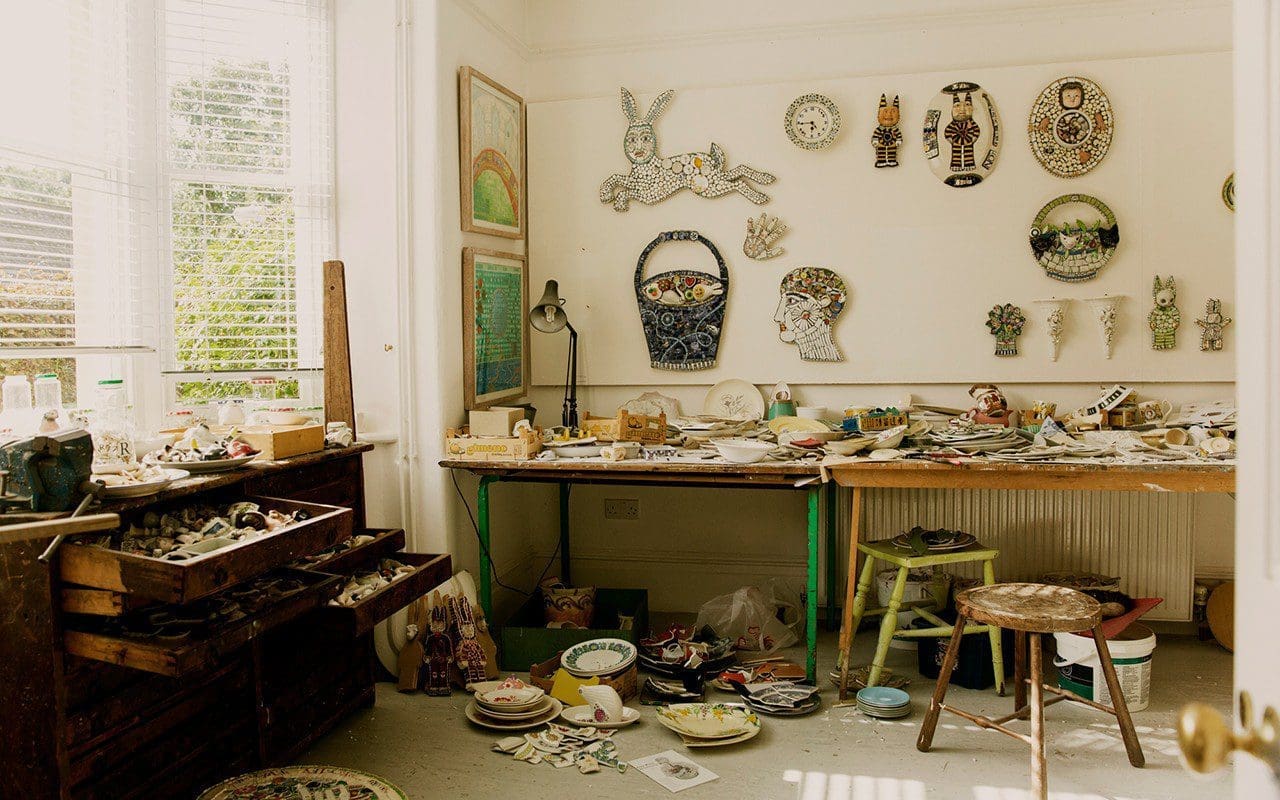
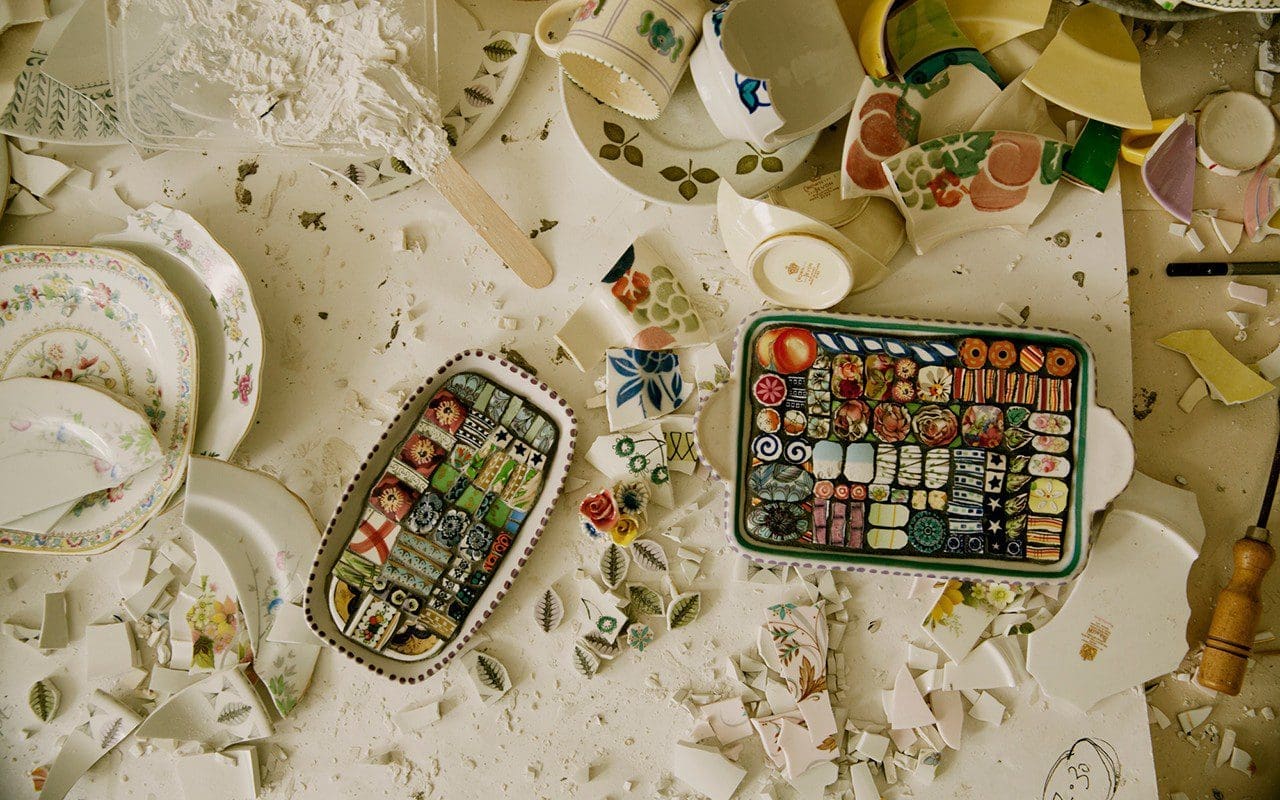
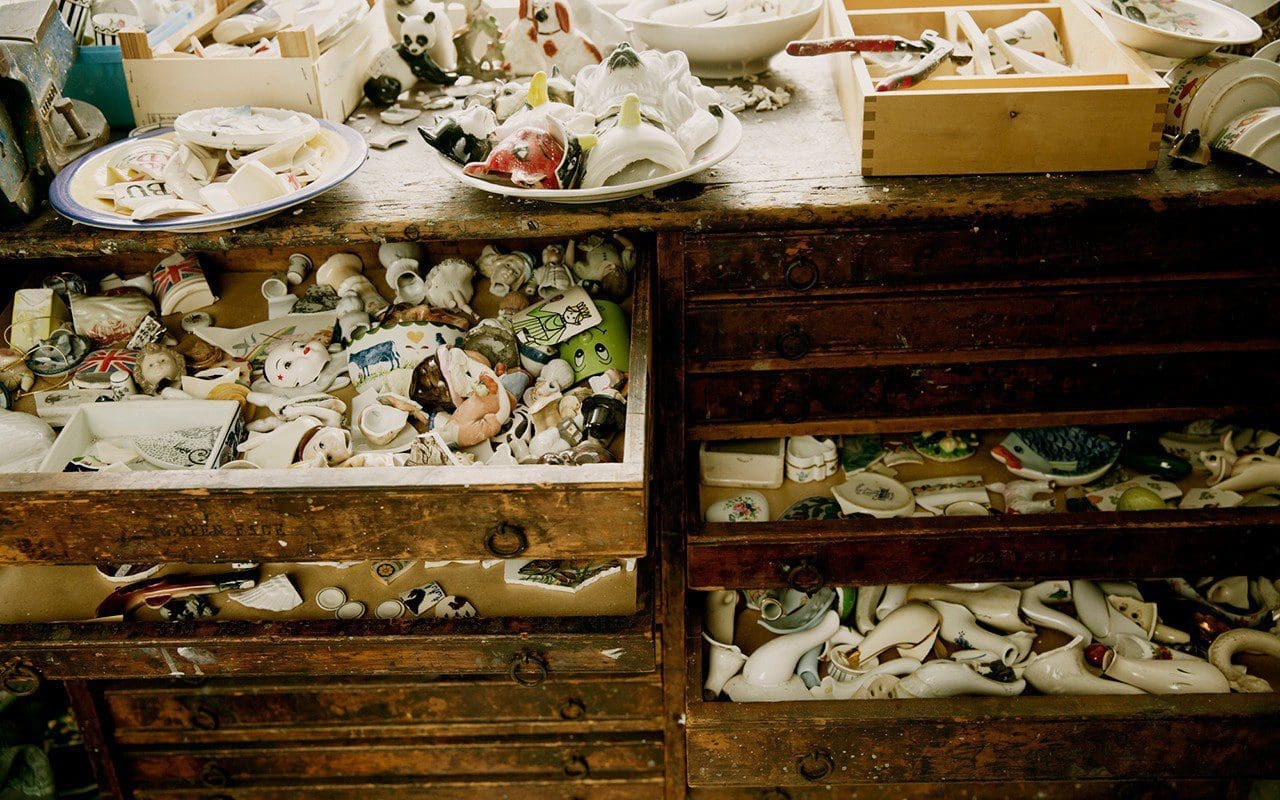 Cleo’s studio, works in progress and her meticulously organised drawers of raw materials
Cleo’s studio, works in progress and her meticulously organised drawers of raw materials
You worked with Dan on one of his early Chelsea Flower Show gardens. How has the market for your work changed since then ?
My work has evolved very slowly over the years. When I left college, my contemporaries – the YBA’s from Goldsmiths – were having their first Frieze show and I was making hundreds of tiles and glass mounted works, some of which I exhibited in an architect’s office on Brick Lane and also in an empty shop in Hoxton. I had a studio on the Old Kent Road and then later at the South Bank.
In 1992 I was lucky to be accepted for a show at the Royal Festival Hall called ‘Salvaged’ and was then offered a subsidised studio. It was a fantastic space full of makers working in a variety of disciplines inspiring and helping each other. I think it may have been the ‘Salvaged’ exhibition and subsequent press coverage that introduced Dan to my work. It was Dan’s second Chelsea garden, very vibrant and rich with intense colour, and I think the mosaic complemented the planting. It was a real education seeing him create and plan a show garden and being on site during the event. I still have a number of plants that he gave me when he dismantled the garden and they remind me of that time. Plants, like china, hold memories and connect to people and events.
Since then my work has evolved in that my projects are more ambitious and my work is more refined in the making and the conception of the ideas. I create large installations of up to 90 mosaics for new touring shows on grand themes that I am passionate about. Interestingly my clients are still the same sort of people, individuals and establishments that love the work for what it is, for what it is made from and the inherent properties in the china, for the memories they revive, and for the stories that I tell.
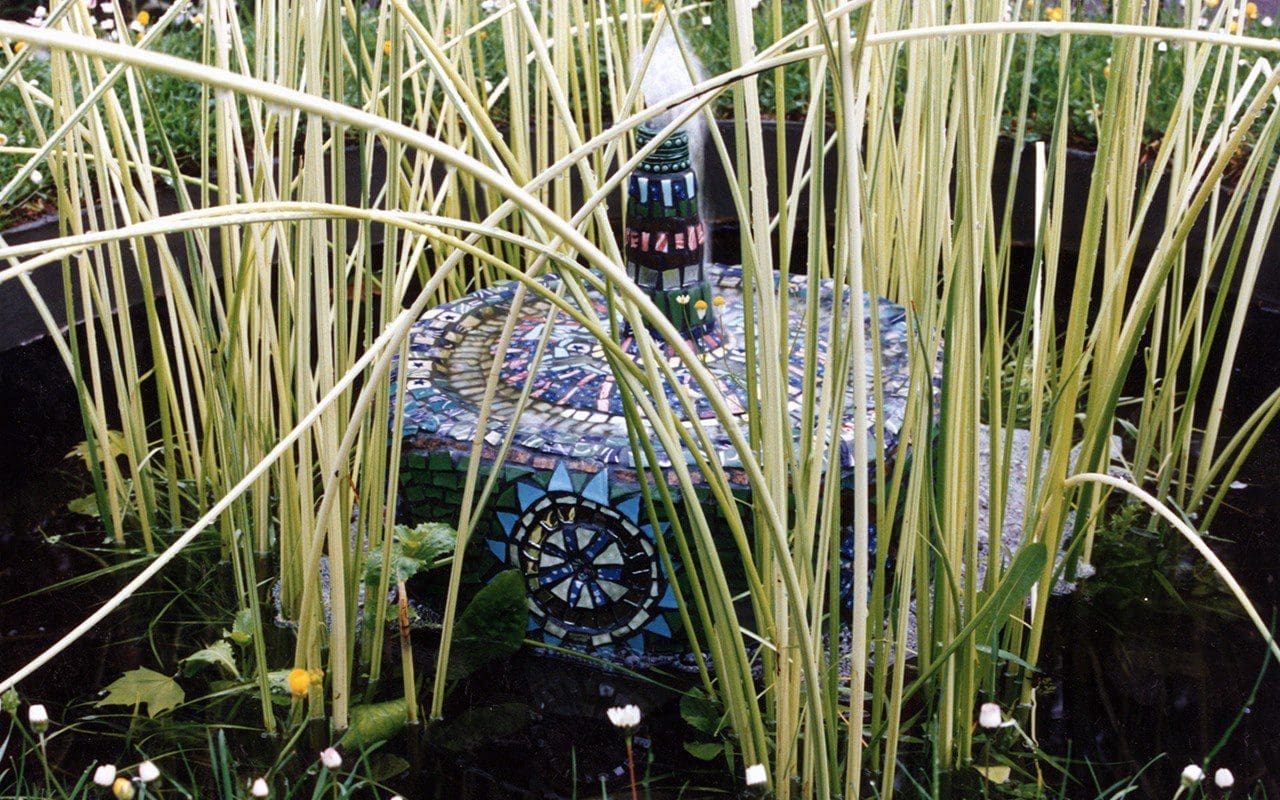 The water feature in Dan’s 1993 Chelsea Flower Show garden designed and made by Cleo
The water feature in Dan’s 1993 Chelsea Flower Show garden designed and made by Cleo
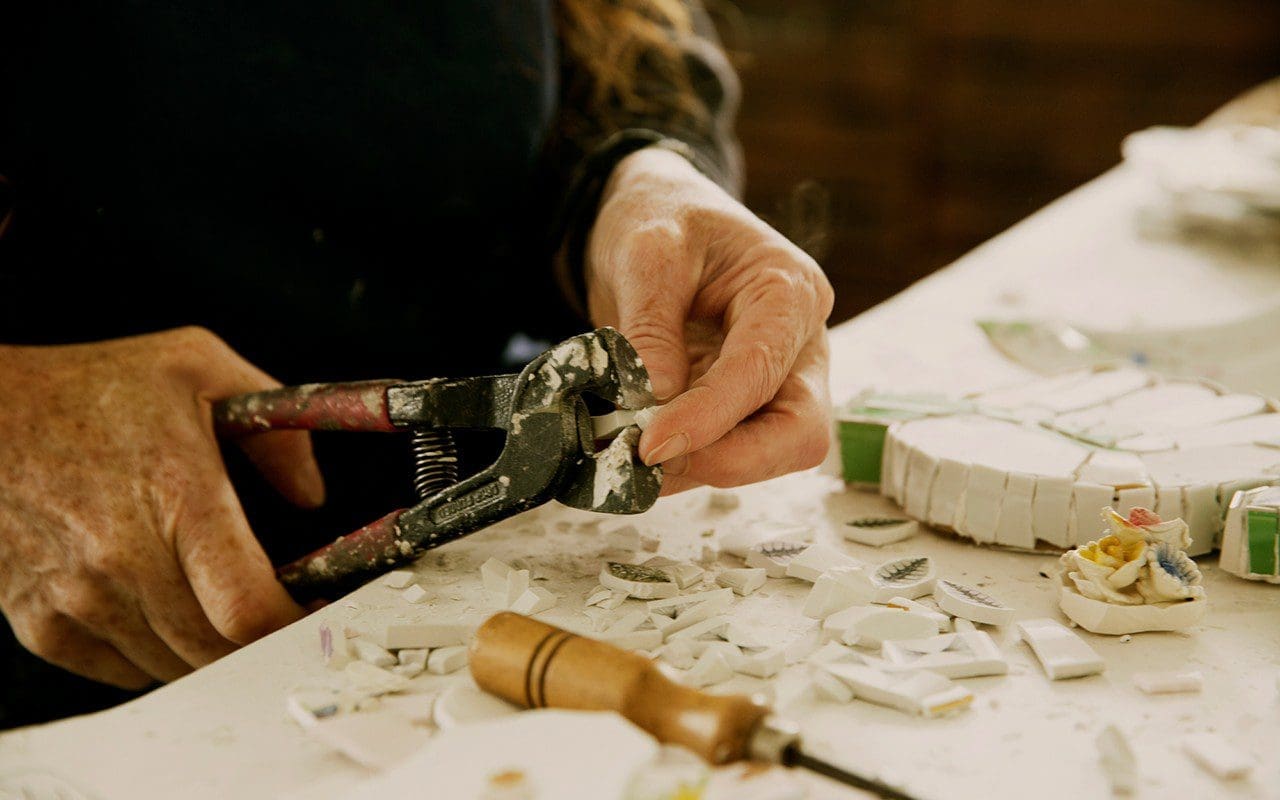
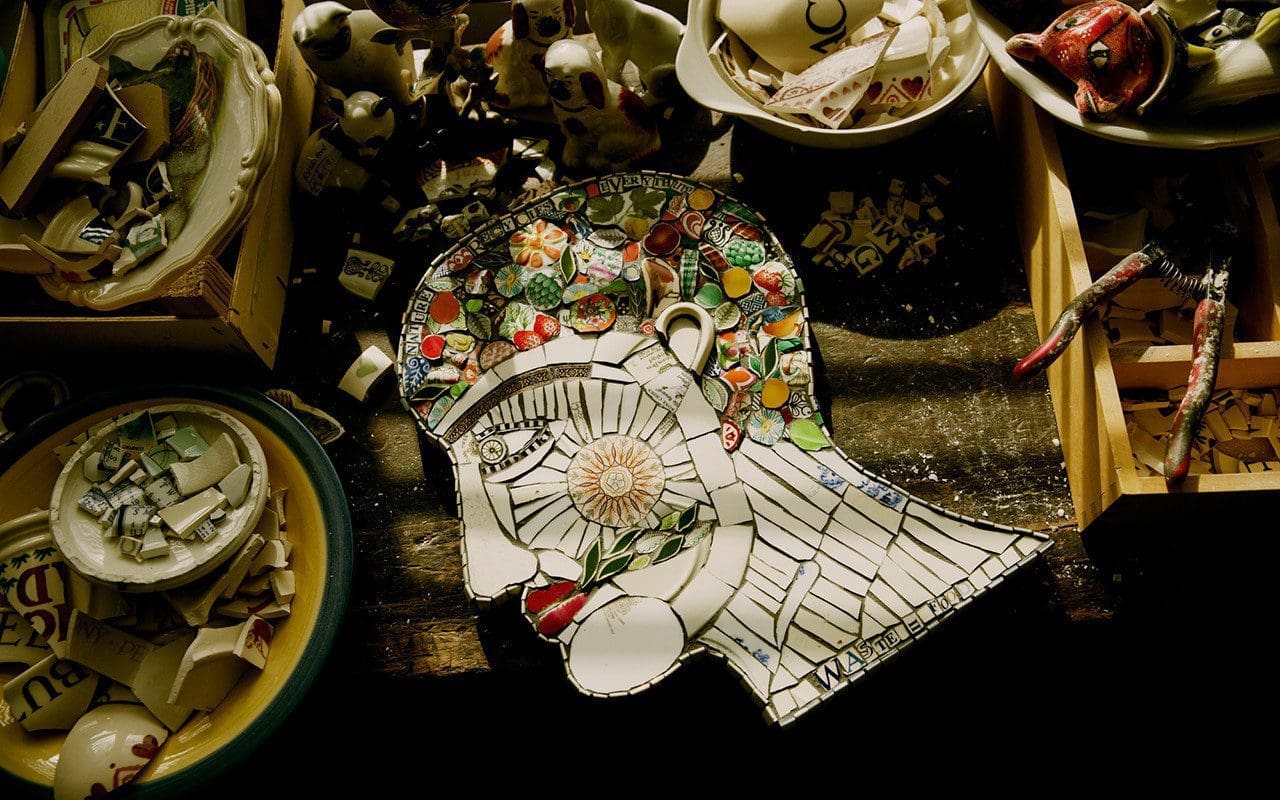
Nature is clearly a very important theme in your work, and I know that you are a keen gardener. How do nature, gardens and plants inspire your work ?
I had my own small patch as a child and gathered euphorbia milk and strawberries for my dolls. At an early age my mother taught me about plants; that rue can cause blisters due to photo-allergy and that monkshood is deadly. My mother loved and feared plants. My parents’ oldest friend was Roger Phillips the photographer, ‘Wild Food’ author and mushroom hunter, so this was all part of my childhood. And that Darwin ruled, OK !
My father was an engineer, which is why I love structures and cause and effect and my mother was a human biology teacher, Naturopath and keen gardener. Plants were to be respected, but entice us to take advantage of them to keep the species alive and they in turn take advantage of man. I collect plants like old china, gathered at every opportunity, divided, seeds collected, cuttings taken for my own garden and lovely meals made from produce either grown or from the hedgerow.
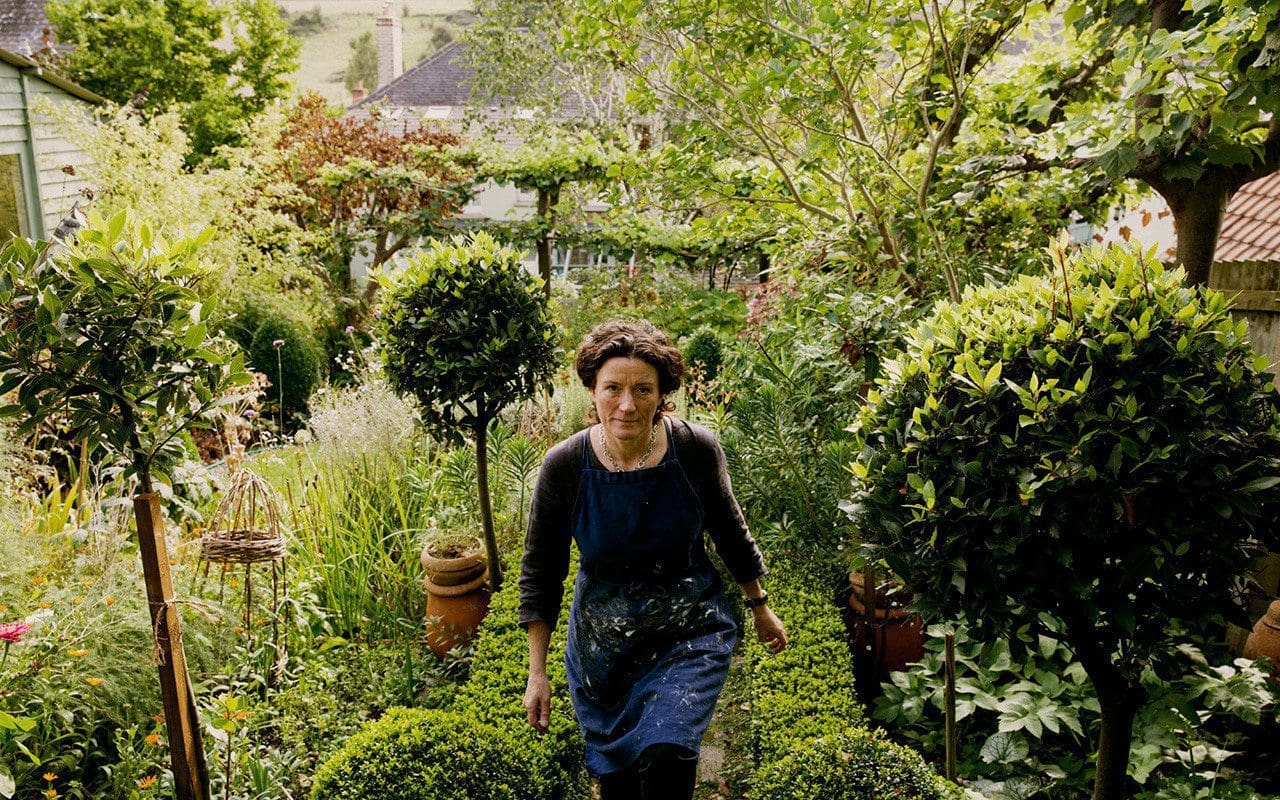 Cleo in her garden
Cleo in her garden
 Large Collector’s Baskets with Bees, 2014. Photograph courtesy Cleo Mussi.
Large Collector’s Baskets with Bees, 2014. Photograph courtesy Cleo Mussi.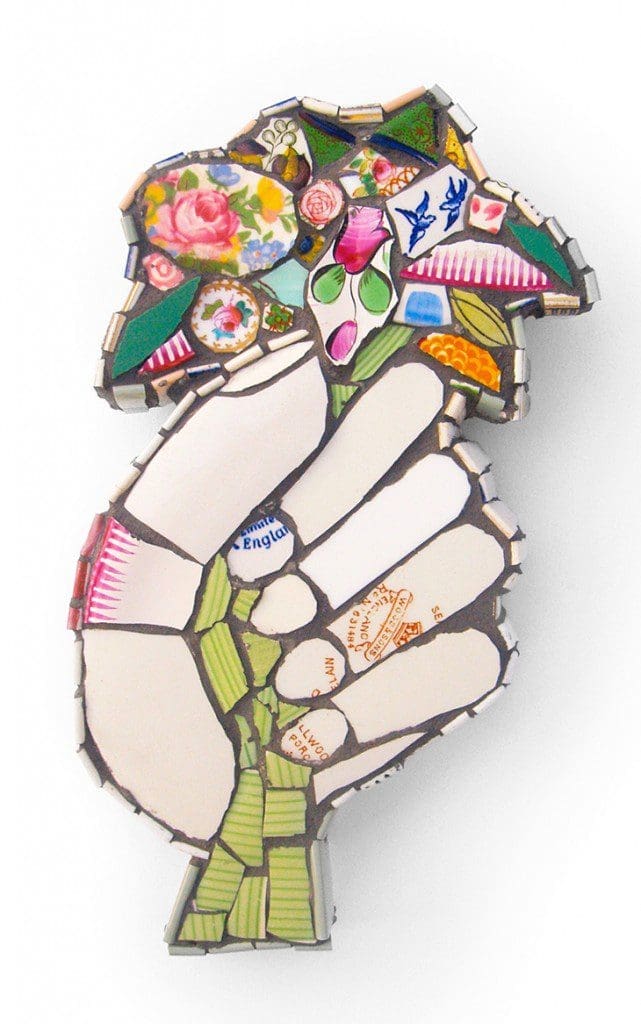 Bouquet, 2005. Photograph courtesy Cleo Mussi.
Bouquet, 2005. Photograph courtesy Cleo Mussi.
Can you tell me about your recent conceptual shows ‘Pharma’s Market’ and ‘All Consuming’, the themes you explored through them both and why they are important to you ?
These exhibitions connected ideas about food, agriculture and animal husbandry with modern developments in stem cell research, genetic modification and alternative energy. I am intrigued by evolution from the microbial soup in sea vents to archaea, bacteria, viruses, plants and animals; the physical details, the names and the stories and connections on the cellular level. These exhibitions explored the history, the characters, plant hunters, collectors and science. I observe man’s destruction and consumption of natural resources and the impact on our environment, whilst being inspired at the creativity and imagination to solve problems. For example, most recently the discovery of mycelium that neutralise toxins in toxic waste or that bind clean plant waste to form biodegradable packaging, or fungi that help in cancer research. More recently I have become interested in cyborgs and biophysics as well as in the Human Brain Project, the Human Genome Project and, of course, the microbiome; the little gardens in our own bodies yet to be discovered.
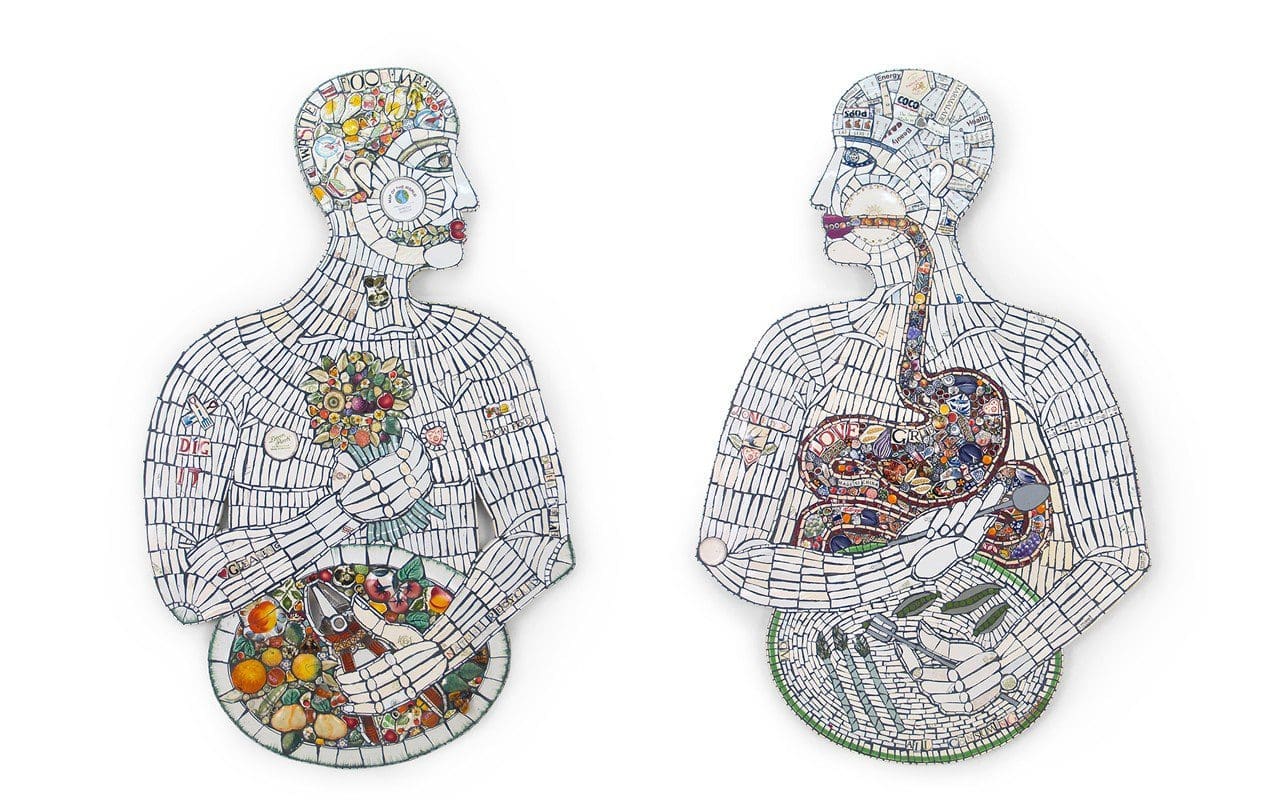 Nature Recycles Everything (left) and All Consuming (right), 2014
Nature Recycles Everything (left) and All Consuming (right), 2014
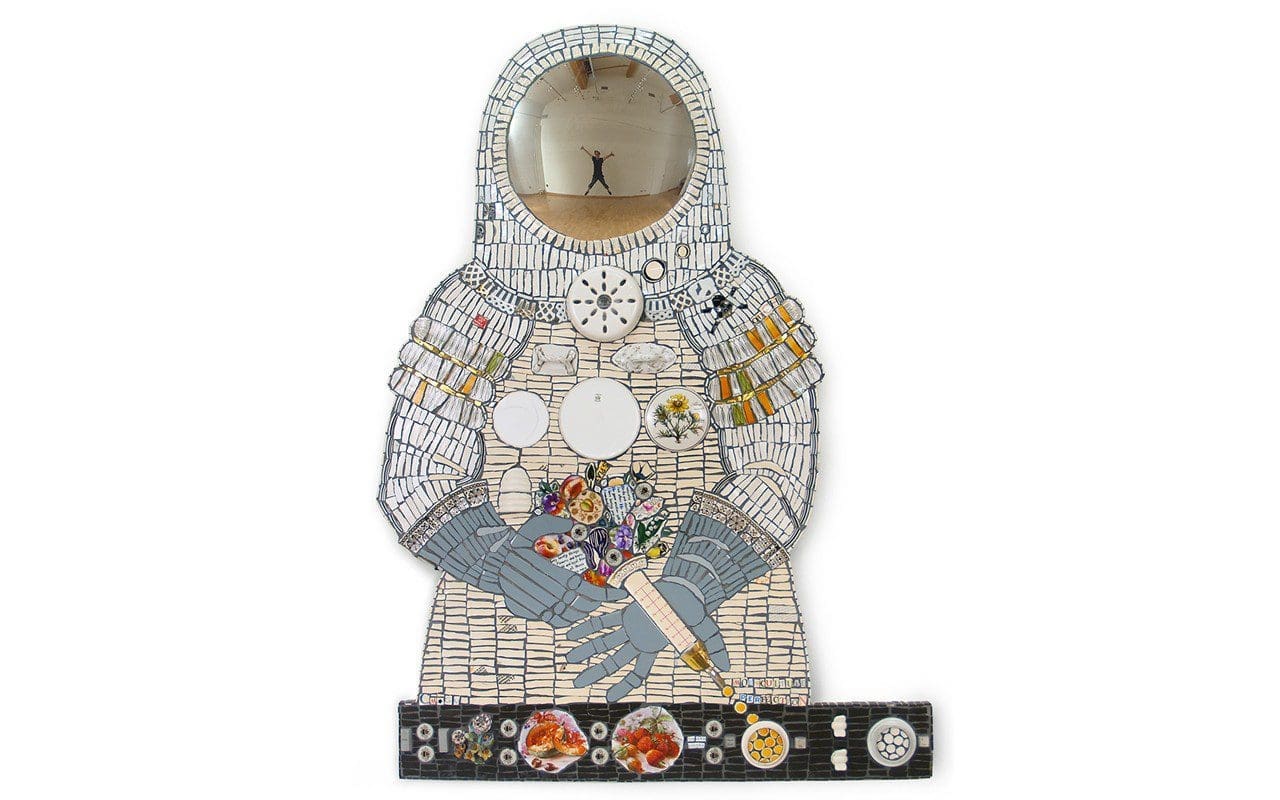 Monoculture Perfection, 2014. Photographs courtesy Cleo Mussi.
Monoculture Perfection, 2014. Photographs courtesy Cleo Mussi.
How has your work changed and developed since you first started ?
When I first started making mosaics, my work was quite simple: tiles, tables, abstract wall panels, naïve faces and fountains for conservatories and gardens, I contributed to many gardening and craft books. Currently my work is generally exhibition focused with a number of commissions alongside mainly for private individuals, but also for arts centres and hospitals and businesses. The pieces are figurative and tell a story. I often have dark tales to tell, but with twists of humour, layers and details hidden beneath the surfaces.
You made a research trip to Japan a few years ago. What did this bring to your work ?
As a family we went to Japan for 4 weeks as my husband Matthew Harris (also an artist) and I were due to create a joint touring show called 50/50 starting at The Victoria Art Gallery in Bath. It was a fantastic experience, and refreshing to develop new work purely from visual information. We were inspired by very different things, but both of our work is constructed from fragments. We incorporated our research and inspirations. In the final exhibition, which unified the work, we had cabinets of sketchbooks, objects and photographs. We visited many of the moss gardens and temples as well as contemporary art and cultural sights. It was from Japan that I developed my interest in Kawaii and Japanese spirit creatures which include such unusual characters as fire-breathing chicken monsters, a red hand dangling from a tree, the spirit who licks the untidy bathroom and other inanimate objects that come to life.
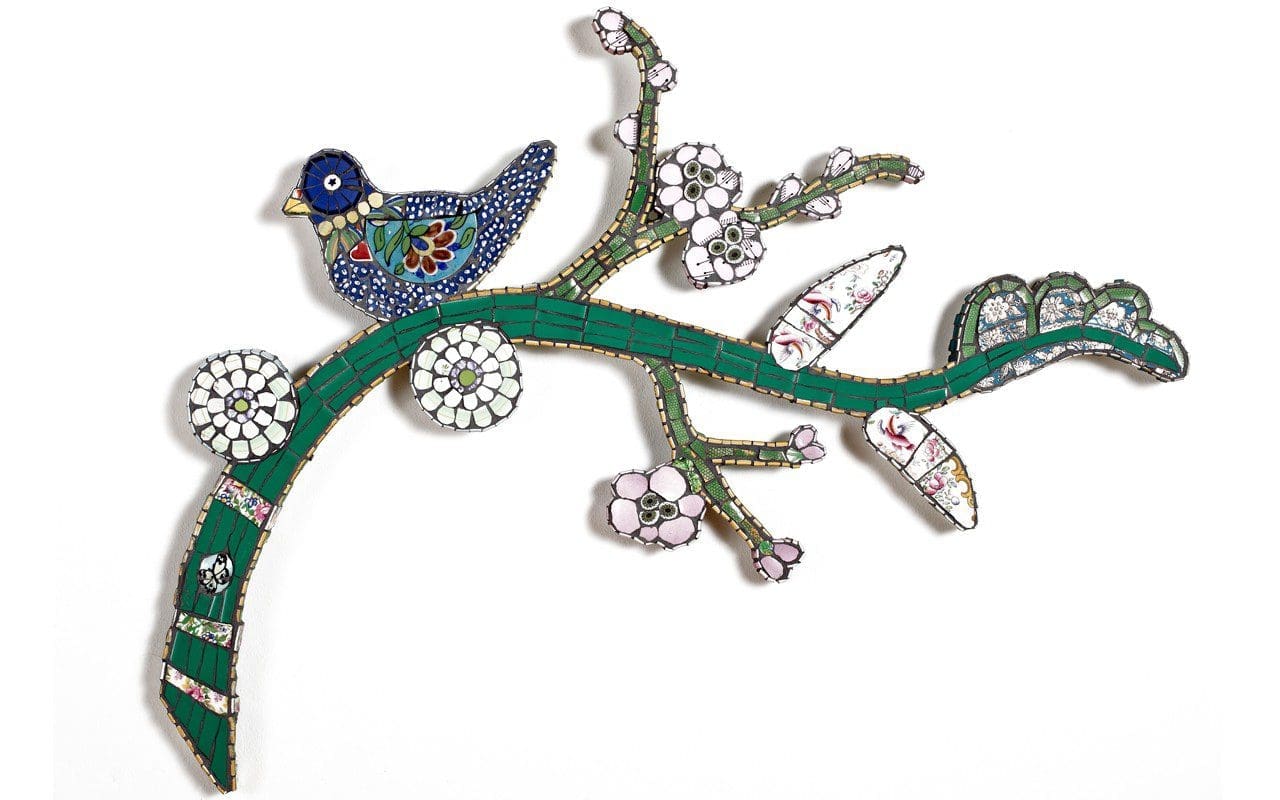 Harajuku Fruit Branch with Blossom and Chrysanths, 2011.
Harajuku Fruit Branch with Blossom and Chrysanths, 2011.
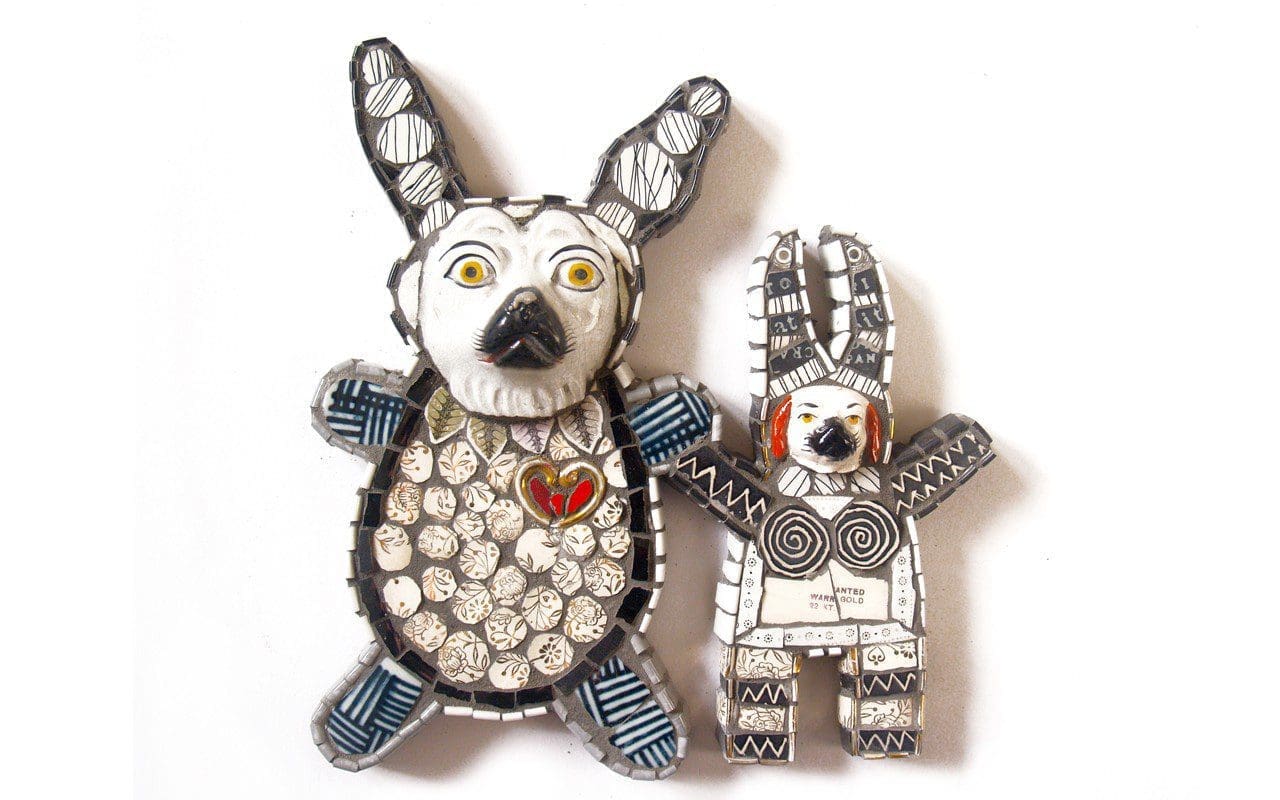
Outlaws – Wanted Dead or Alive, 2016. Photographs courtesy Cleo Mussi.
Your work clearly engages with the history of mosaic craft as a means of storytelling. It also appears to increasingly be concerned with political or social themes.
I think of myself as a modern day folk artist. In the traditional sense of Folk Art my work reflects the world that we live in whilst connecting to bygone days. The mosaic technique is simple, but the content has depth. The work can be read on many levels and I often touch on word play and double meaning. The work on one level is purely decorative celebrating colour form and pattern and, alternatively, on another level has a political content.
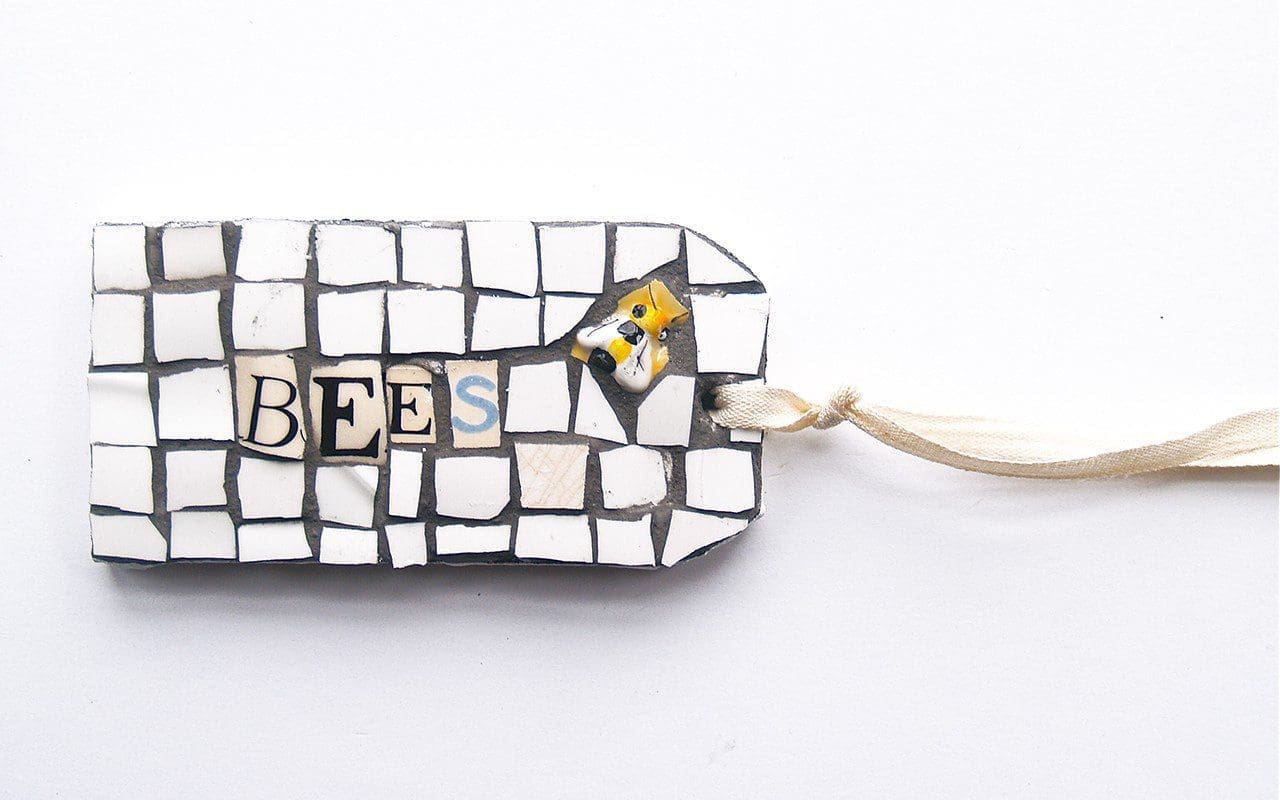 Systema Labels: Bees, 2016
Systema Labels: Bees, 2016
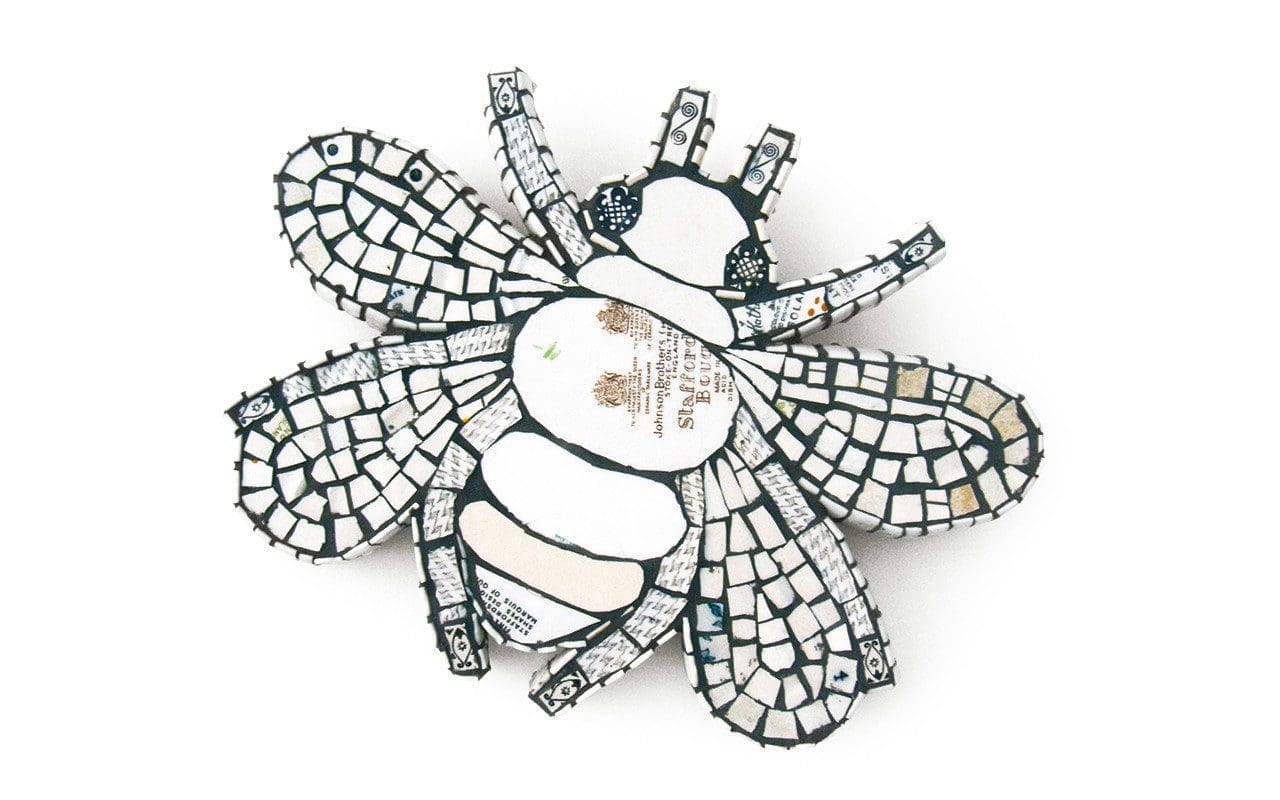 Bombus Spiritus Johnson Brothers, 2015. Photographs courtesy Cleo Mussi.
Bombus Spiritus Johnson Brothers, 2015. Photographs courtesy Cleo Mussi.
What are you working on at the moment ?
I am creating a new touring show which I hope to take to London as well as nationwide. The ideas are in their infancy, but I am looking at how weeds have evolved and the relationship between them and man’s migration and establishment of agricultural settlements. I am interested in the symbiotic relationship that we have with plants and the delicate balance of what we ingest as cure or poison and what we cultivate as food or weed.
I love the colloquial names ‘Bunny Up The Wall’ (Ivy-leaved toadflax), ‘Bomb Weed’ (Rosebay willow herb), ‘Jack Jump About’ (Ground elder), ‘Kiss Me Over The Garden Gate’ (Pansy), ‘Summer Farewell’ (Ragwort) and all the Devils; claws, blanket, tongue, fingers, etc. Many of these weeds were migrants, and yet they define our landscape. I am intrigued by this language that comes from the people who worked the land, often describing the plants and ‘weeds’ in terms of endearment or loathing from their working days; knowledge passed down by example and word of mouth.
What do you find to be the challenges and differences between self-generated work and commissions ?
Time is always the master, and the work is very time-hungry to physically create. I constantly alternate between making work that people would like to live with and thus support the creation of the more challenging pieces. I alternate between smaller works, which I make in series, and the large one-off exhibition pieces that can take weeks to make. I love to take on new large commissions as these often bring new ideas into the mix that I may otherwise not discover. Recent joys were a Donkey with Baskets for Vale Community Hospital in Dursley, a giant magic cat inspired by Edward Bawden, a piece about education called ‘Ode To Ed’ at Prema Arts in Uley and a Solar Panel Installation Worker for Primrose Solar in London. Pretty diverse.
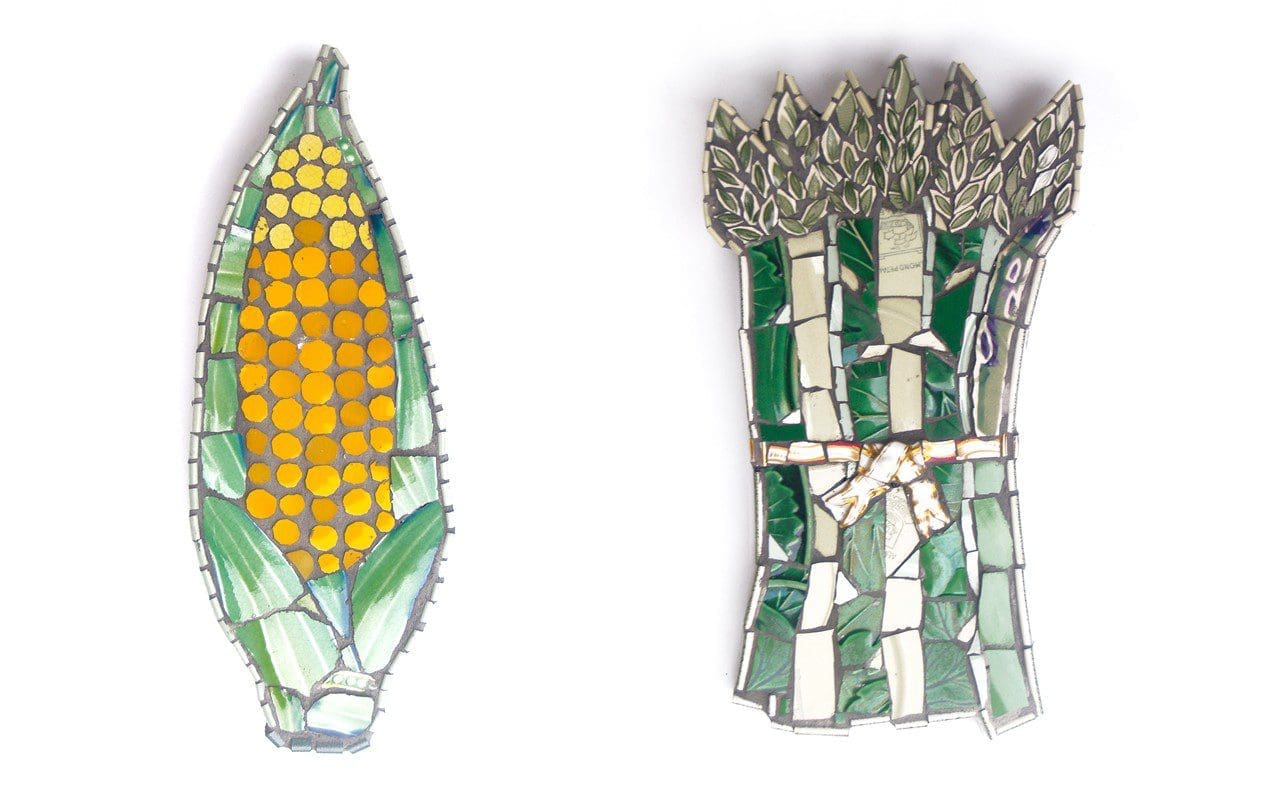 Corn Cob with Dark Kernel (left) and Asparagus (right), 2014
Corn Cob with Dark Kernel (left) and Asparagus (right), 2014
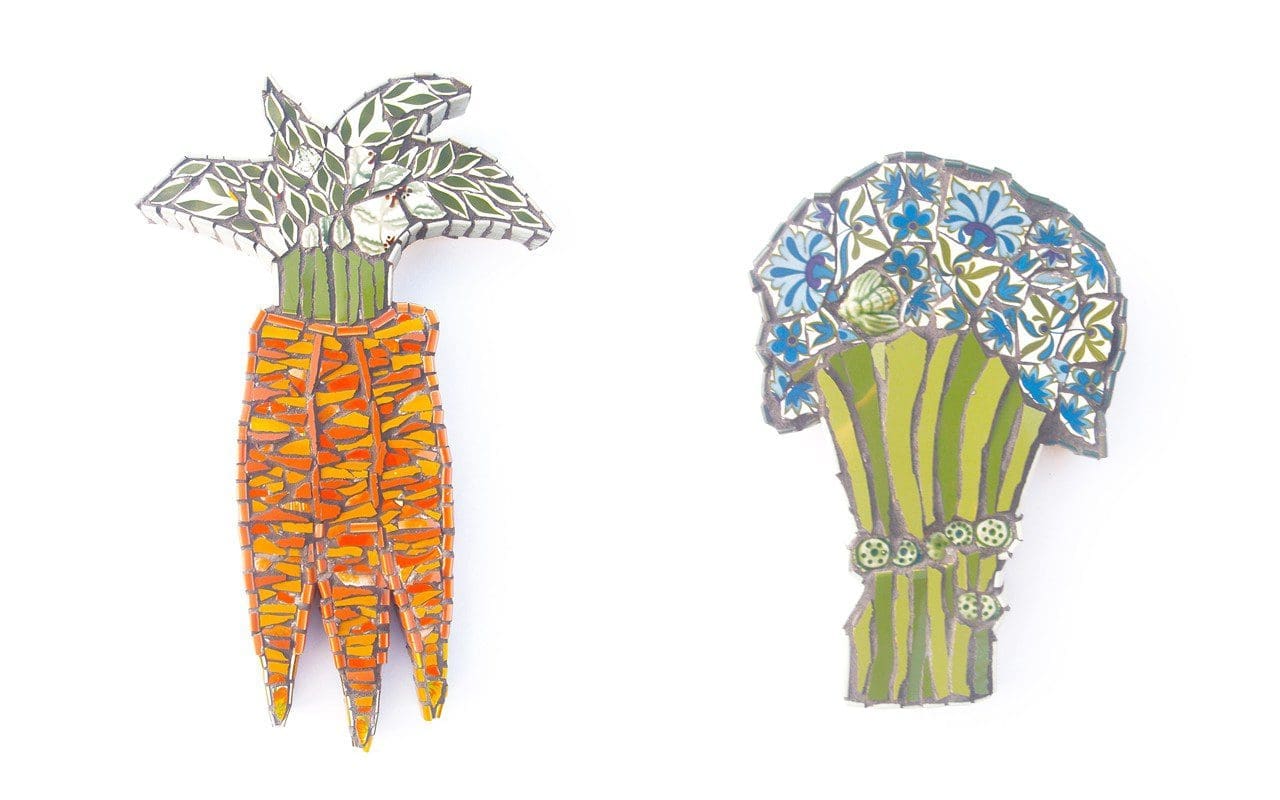 Carrots (left) and Broccoli with Dots (right), 2014. Photographs courtesy Cleo Mussi.
Carrots (left) and Broccoli with Dots (right), 2014. Photographs courtesy Cleo Mussi.
Can you tell me about your role in The Walled Garden at The Museum in the Park in Stroud ?
‘Patron of The Walled Garden’. I am rather pleased with my new title. I have been asked to create a planting scheme on a shoe-string budget for this special space. The garden is about a third of an acre and is managed by teams of volunteers. Essentially the back garden is open at The Museum in The Park. It was untouched for over 50 years and it has now been given a new life as a place for education, contemplation and creativity for the community. Since 2008 numerous volunteers have contributed time and knowledge to this space. Starting with secret artist donations to raise funds and teams of people excavating and clearing, sifting, weeding planting and now watering. The hard landscaping and education space was commissioned and completed last year and now it’s time to put the icing on the cake. So, with just a few hundred pounds, we have purchased a handful of plants and the rest, as with my own garden, have been gleaned and propagated, split and gifted to create a new garden in about 14 sections. Dan kindly donated a huge and varied selection of irises, which have been combined with a collection from Mr. Gary Middleton, so we will have quite a show this May.
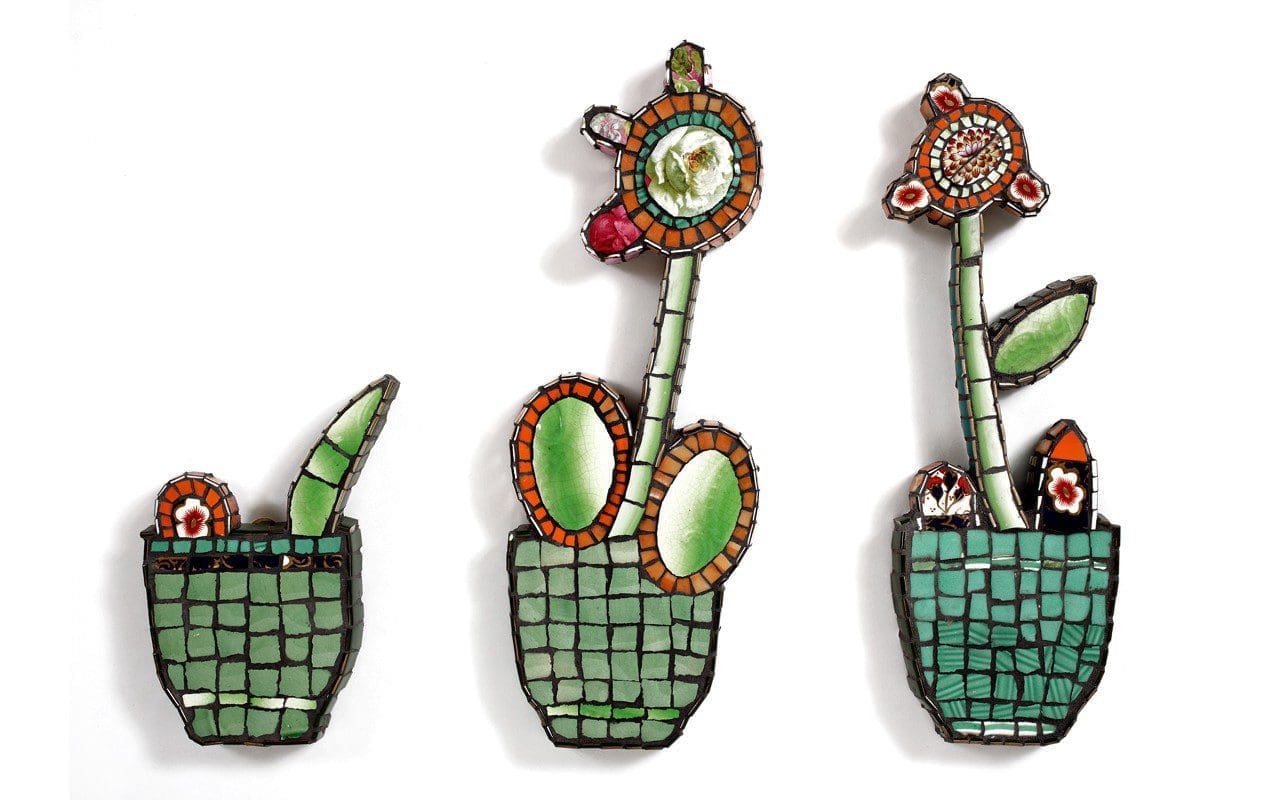 Kyushu Tea Vases, 2011.
Kyushu Tea Vases, 2011.
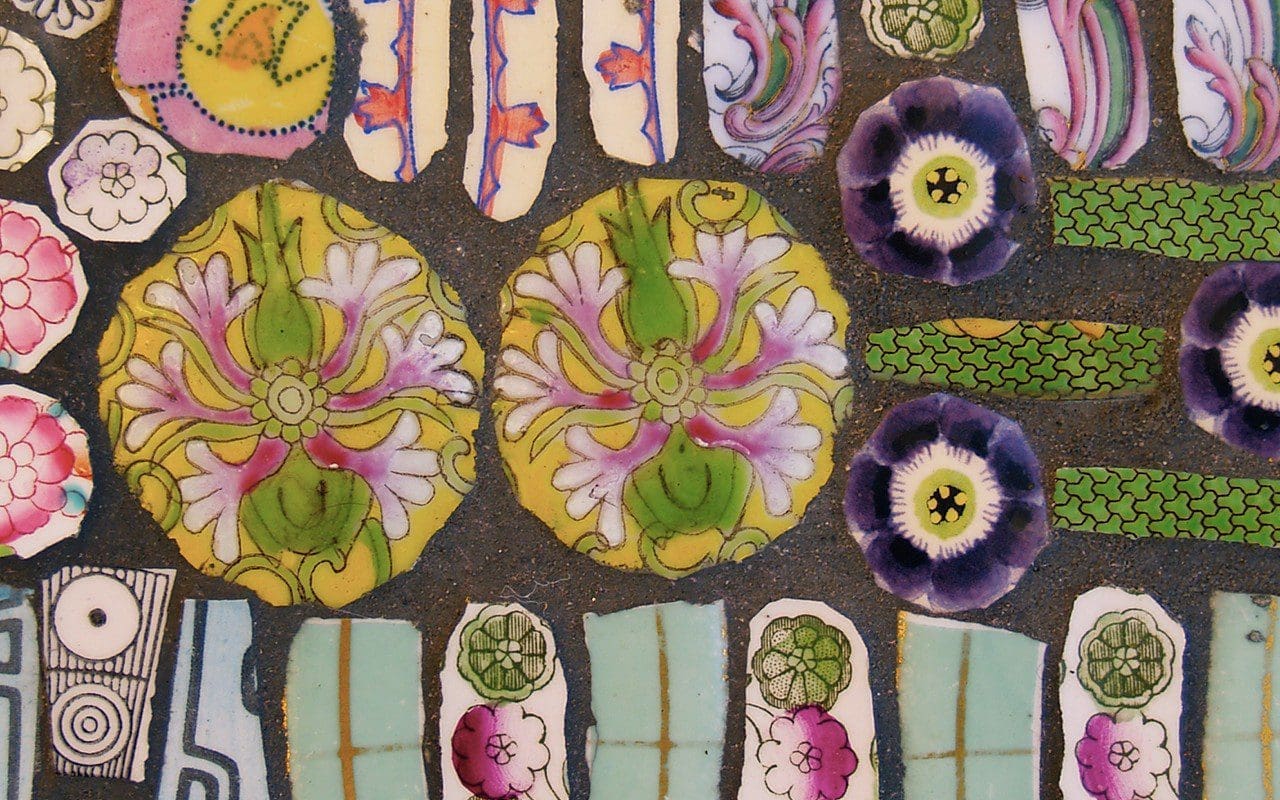 Bento Box, 2011. Photographs courtesy Cleo Mussi.
Bento Box, 2011. Photographs courtesy Cleo Mussi.
Starting from scratch enables us to make bold decisions; not to use blanket herbicides, our weeds are ‘hand picked’. We have introduced English bluebells under the mixed hedges and a wild seed mix and snakeshead fritillaries in the newly planted orchard, rather than lawn grass. The beds are divided into sections and aptly named ‘Bobbly Border’, ‘Bonkers Border’, ‘The Hot Bed’, the ‘Red Hot Bed’ , ‘The Purple Complementary’ and the more gentle ‘White Border’ and ‘Fernery’. Being a walled garden it’s a very hot space with very little shade, so this has been both exciting and challenging and it will also be interesting to see what survives through the winter. So the garden will evolve. This is our first season and the garden has established incredibly well. I think it has a secret underground water source. We are open to the public and anyone is welcome to visit. Coming up now are species snowdrops, ‘Wasp’ being my favorite, an auricula theatre, a tulip bed for cutting (inspired by Dan) and then later -fingers crossed – a bonkers display of zinnias for bedding, as well as all the other aspects of the garden in each season.
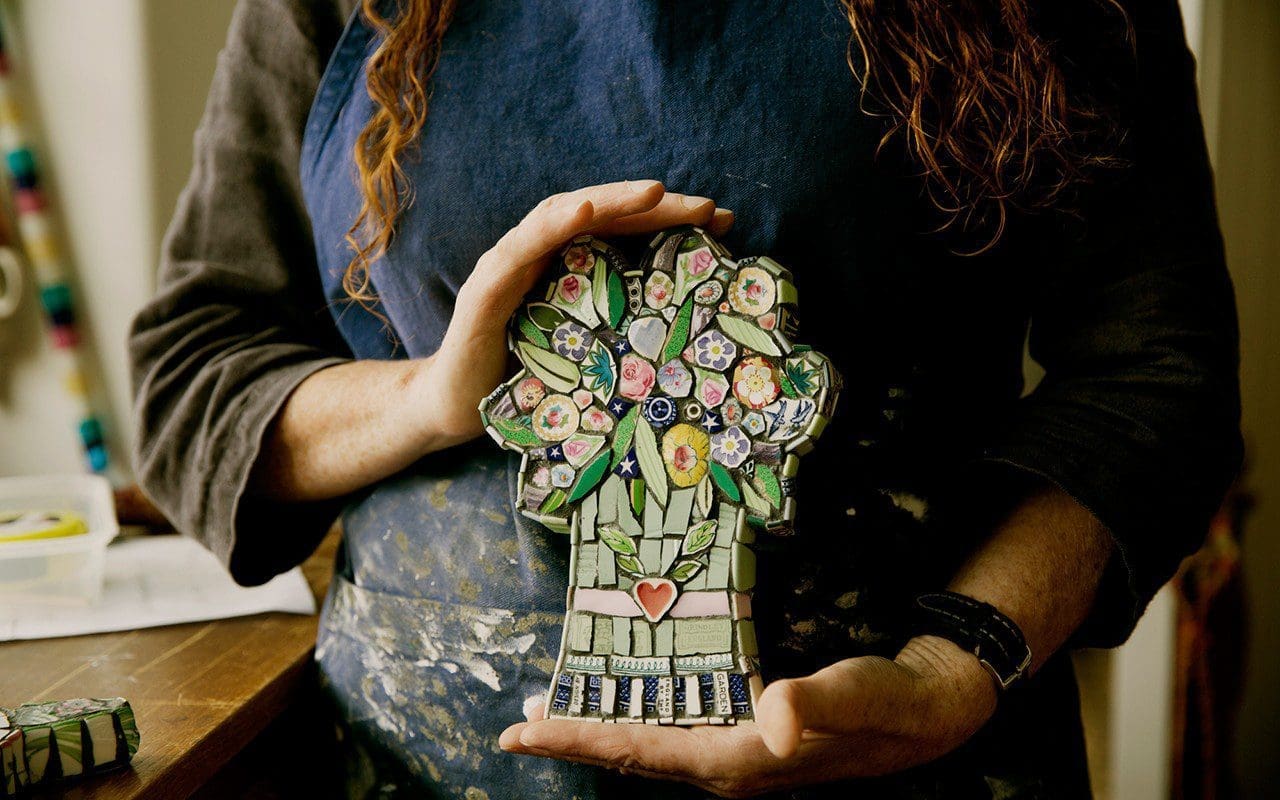 Cleo holding a recently completed Tussie Mussie, 2016
Cleo holding a recently completed Tussie Mussie, 2016
Cleo’s work can be seen in these upcoming exhibitions;
March 18th – May 7th
‘Pour Me’
The Devon Guild of Craftsmen
Riverside Mill
Bovey Tracey
Devon
TQ13 9AF
Mid-May for 6 weeks during the Hay Literature Festival
‘All Consuming’
Brook Street Pottery
Hay-on-Wye
Hereford
HR3 5BQ
May 6th & 7th and 13th & 14th
Select Trail
Open Studios
Frogmarsh Mill
South Woodchester
Stroud
GL6 7RA
Instagram: cleomussimosaics
Interview: Huw Morgan / All other photographs: Emli Bendixen
Marcin Rusak is a London-based Polish designer who explores themes of consumption, ephemerality, aging, decay and longevity in his work. For very personal reasons he has chosen to work with flowers in a range of different ways. I recently met him at his new studio where he talked to me about his history, his process and his creations.
Tell me how you arrived at this way of working with flowers.
It was quite an adventure for me to get into the Royal College of Art. It started with me studying European Studies, not liking it, doing interior design on the side and trying to get into art school in Poland. They didn’t accept me. So I tried the Design Academy Eindhoven, the conceptual design school, not knowing at all what conceptual design is. I was supposed to be there for four years, but after two I felt I wanted to experience more, and the way Dutch education works is they wipe your head clean and they inject their tools into you and after four years you’re only allowed to use those tools. So after years of study I knew that I wanted something more. I wanted freedom, so that’s where the RCA came into the picture.
At the RCA you’ve got this amazing ability to make mistakes all the time, and find your own thing. So I found my own thing through an accident again, because there was a brief to find an object that interests you, like from your past or wherever, just something that you like.
And so I found this cabinet that we had in my family house, which was from the 17th century. It’s a Dutch cabinet, and it’s carved in wood, and the whole sculptural decoration is inspired by nature and the seasons. So I just started investigating, ‘Why is it that I like it so much ?’. So the first natural step for me was to go and investigate nature and flowers – the subjects of the carvings – and I went to a flower market for the first time. And that’s where I started seeing all this waste. And because I was always interested in processes, I took the waste material and started doing everything I possibly could with it, to get somewhere, not really knowing where it was going. And that’s how I discovered printing with flowers.
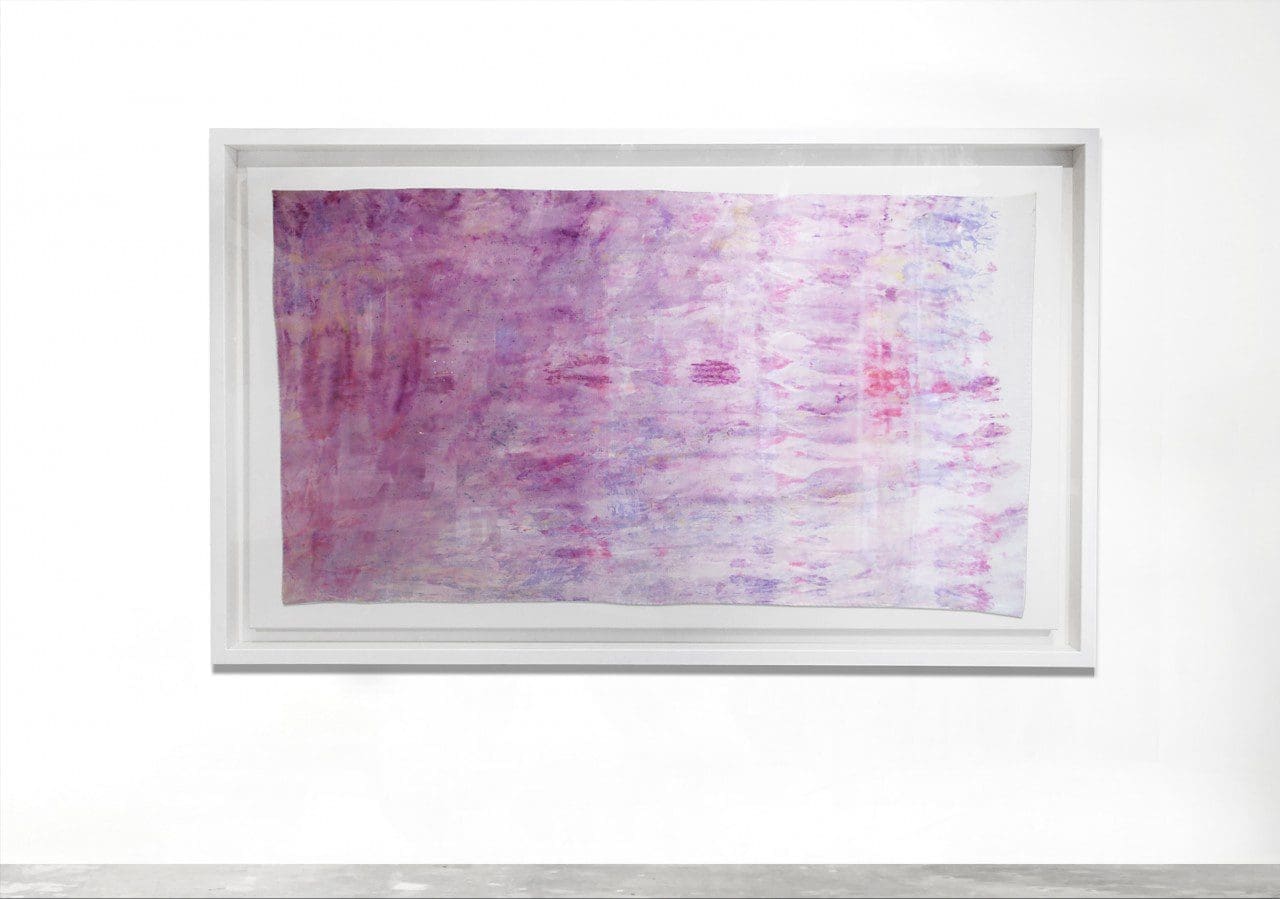 Flower printed textile, 2015. Marcin is standing in front of this in the main image (top). Photograph courtesy Marcin Rusak.
Flower printed textile, 2015. Marcin is standing in front of this in the main image (top). Photograph courtesy Marcin Rusak.
On your website there is a video of you making one of these textiles. What is the liquid you were spraying on the flowers ?
Vinegar. It helps to bring out the natural pigments in the flowers, and it also helps them to penetrate the silk. I also use special silks made specifically for digital printing, because they are treated with substances which react with ink, and although the flower pigments are not inks the silk reacts in the same way and the pigments become more light fast. When I first tried with normal silk the colour only lasted about a month. These pieces are about a year old and have not really faded that much, but they will fade eventually, although they will never completely disappear. I still have all the ones I made, as it is really hard to sell things that don’t last, but people have started to understand me better now, and they are prepared to buy the idea along with the object. Also recording the process of making the work becomes part of the work itself.
By the end of this project I went to my tutor, and I said, ‘You know what? It’s actually really funny that I’m doing these things with flowers now, because I have a history of 100 years of flower growing in my family.’
When I was born the business was closing down, so maybe about two or three years after I was born it closed. So until I was 26 and at the RCA I really had nothing to do with flowers.
I was raised in those abandoned glasshouses. That was my childhood playground. It was amazing. I still have this memory of the very dry warmth when you were in the glasshouses, but there was nothing else, just these pipes coming out from everywhere, and all these steel structures, but no flowers, no natural material. And then we moved when I was 10. My mum always loved flowers and she always wanted to do something with them, but she never did.
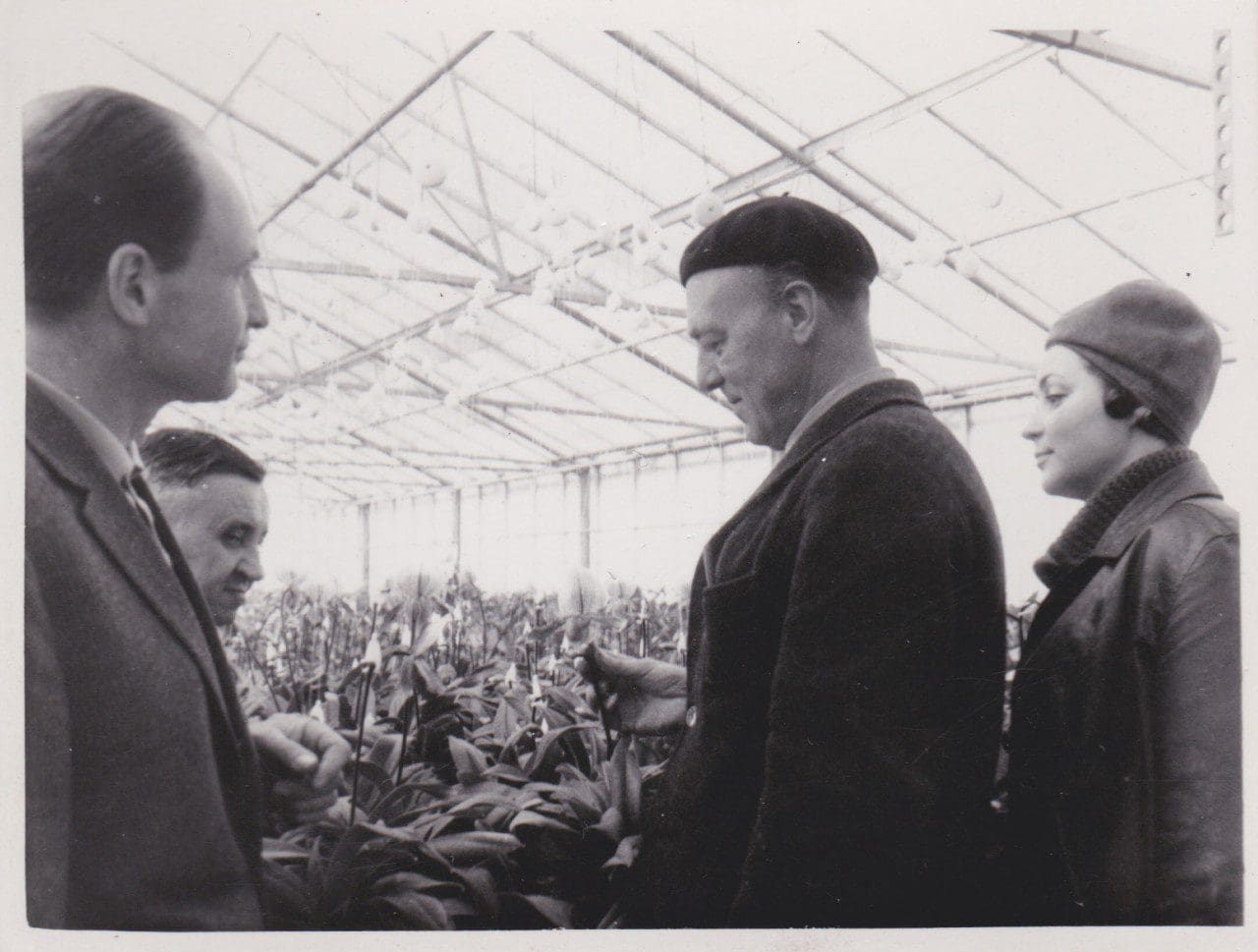 Marcin’s grandfather inspecting orchids in one of the family greenhouses. Photograph courtesy Marcin Rusak.
Marcin’s grandfather inspecting orchids in one of the family greenhouses. Photograph courtesy Marcin Rusak.
So the flowers weren’t really in the family, they were in this amazing history we had, because my grandfather, and his father, for over a hundred years they were growing flowers. They also had flower stores, so they had a really big business, mostly growing orchids. And my grandfather was kind of a freako scientist, so he was really bad with people, but amazing with plants. So actually discovering this was a breakthrough for me, but it was also quite natural. Although I kill plants, or I use dead plants or I make objects that die !
But it made me think. I remember having this conversation at the RCA with one of the tutors, they asked, ‘Why are you doing this, actually ? It’s nice that its this textile that extends the life of already dead flowers by months or years, so that’s great, but what’s the interest ? Think about it. Why ?’
So then I started doing much more research work in the Netherlands and actually trying to understand why people manipulate flowers so much these days, and how flowers became a commodity, and how they are being sold in Tesco and grown in Kenya, and flown with planes and using water in places that don’t have water. All of the background of what people don’t know about commercial flower growing. And then I started explaining to people that it’s a bit like the food industry, that started to change 10 years ago, when we started realising how we source food and intensively farm it and so on and so on. So I established a connection with Wageningen University and Research Centre in the Netherlands, right next to the massive flower market there. And I made a book about it.
So you got into the science of flowers through doing this book, which you hadn’t really thought about before ?
No completely not! Because, you know, like a lot of people I just didn’t know what the situation was with flowers being grown, because we don’t have to eat them, so we don’t really think of them in the same way that we think of food, because in a way, they are perceived as a luxury. So I started investigating it at the university and they helped me a lot. At the beginning they were very suspicious of what I was doing, because they work with a lot of big brands which pay a lot of money to get their research and I was going in there saying ‘Hey, can you tell me about this ?’ for nothing. But I established a nice connection and they let me see a few things and we started talking and I introduced to them to the idea of the flower monster that I wanted to do, which is basically combining everything we want from flowers today. From retailers, to growers and consumers, everyone wants flowers to be a certain way, either living longer or smelling better or being cheaper to ship. And in the end they should be this natural imperfection, and not manipulated so much, so for me it was interesting to think about how to put that all into one piece and start communicating it to people and make them aware.
So the idea was to create this flower that does it all. So if we play with the DNA, and if the industry keeps on going the way it is right now where we keep manipulating things, it is where we might end up. I first started talking to plant geneticists to try to understand about breeding and cross-breeding, because it is possible to cross-breed a lily with a bamboo and so on. So if you have a lily which has a stem with genes from a bamboo it can then stand on a strong stem and hold this whole creature up. But how do we get there physically ? How do we make it happen ? So we researched the plants that have the certain characteristics that we needed, so anthuriums are very light, so transportation would be easier, and bamboo for the stem, or orchids with their roots outside the plant which could transport nutrition, so the whole thing could live for months. So I started working with Dutch flower engineer Andreas Verheijen, who agreed to help me with the project, and we basically took the plant species, cut them up and put them together them as nature might. Then it was flown to London in a day. It was the weirdest thing I ever did.
We created a number of hybrids. Each one came from a purpose. The way that they look is accidental. We were never thinking about them aesthetically. So when I came to the UK I had about a day to scan the first one. We used a camera array – 20 cameras standing in a circle. They shoot constantly while the object is spinning and they build up a 3 dimensional digital image. However, this digital file has no functionality. It can’t be printed. So I hired a 3D sculptor, Ignazio Genco, who then spent two weeks re-sculpting the digital files on a computer, so that they could be printed. The original one was made out of 22 separate 3D printed pieces, with a steel structure inside. It took 72 hours of straight printing.
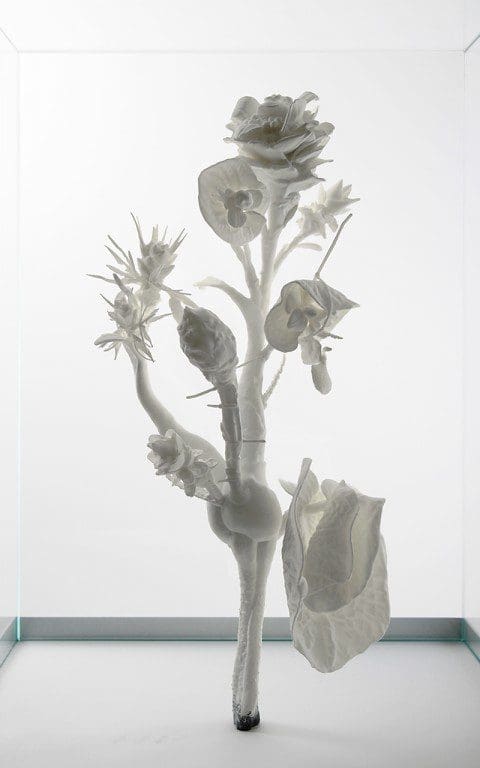 Monster Flower II, 2015. Photograph courtesy Marcin Rusak.
Monster Flower II, 2015. Photograph courtesy Marcin Rusak.
 Pages from the book showing a digital scan and the camera array. Photograph courtesy Marcin Rusak.
Pages from the book showing a digital scan and the camera array. Photograph courtesy Marcin Rusak.
So that was the research, but I wanted to go further in telling the story. So I made these printing plates, like in the 16th century, when they discovered a new species of plant they would create a drawing of it and make multiple prints of it. So I started working with an illustrator, Clara Lacy, and we did it exactly as they would have done it, so we had the blow up details with information, we acid-etched it on copper, then we made the prints – monoprints in a run of about 15 – and then we chromed the plates to make them into permanent artefacts. I also produced a book of the whole process, as I wanted to extend the story as much as possible.
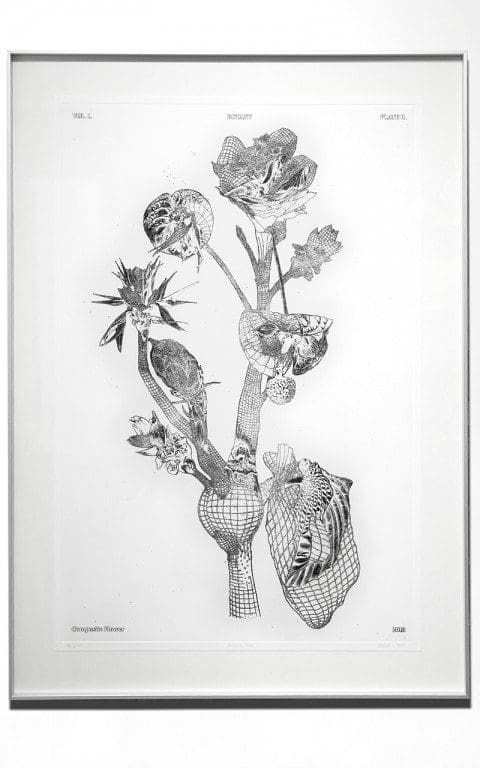 Botanical Drawing, 2015. Photograph courtesy Marcin Rusak.
Botanical Drawing, 2015. Photograph courtesy Marcin Rusak.
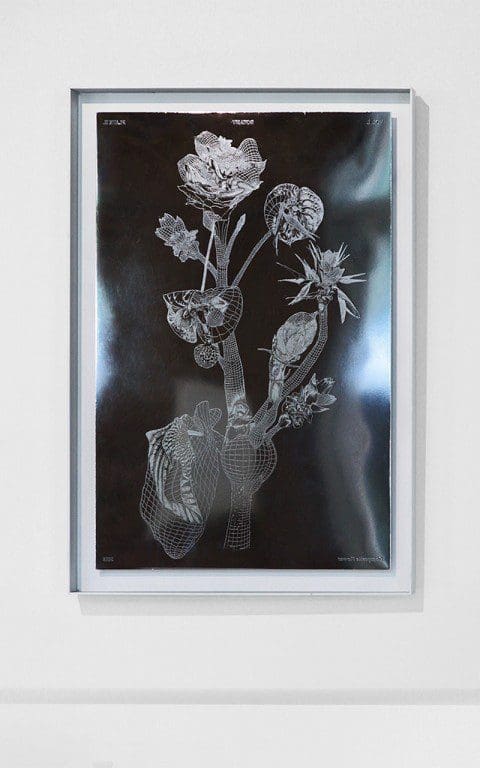 Chromed Botanical Printing Plate, 2015. Photograph courtesy Marcin Rusak.
Chromed Botanical Printing Plate, 2015. Photograph courtesy Marcin Rusak.
So that is how my practice works. Half of it is research, where I spend my time and money investigating what I’m really interested in, and then the other half is taking bits of it and translating it into ‘object’ work, which is where the recent resin work comes from. That all started with the research I was doing into aging materials. I was really interested in the ephemeral, the idea of value, the idea of things not being permanent.
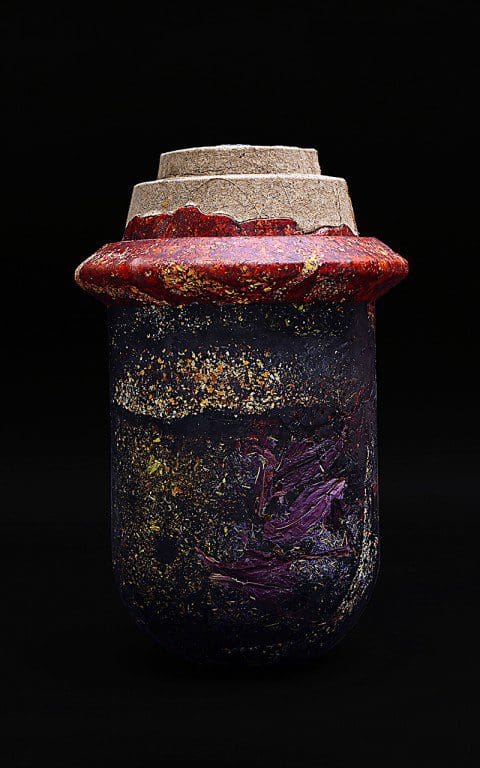 Perishable Vase II, 2015. Photograph courtesy Marcin Rusak.
Perishable Vase II, 2015. Photograph courtesy Marcin Rusak.
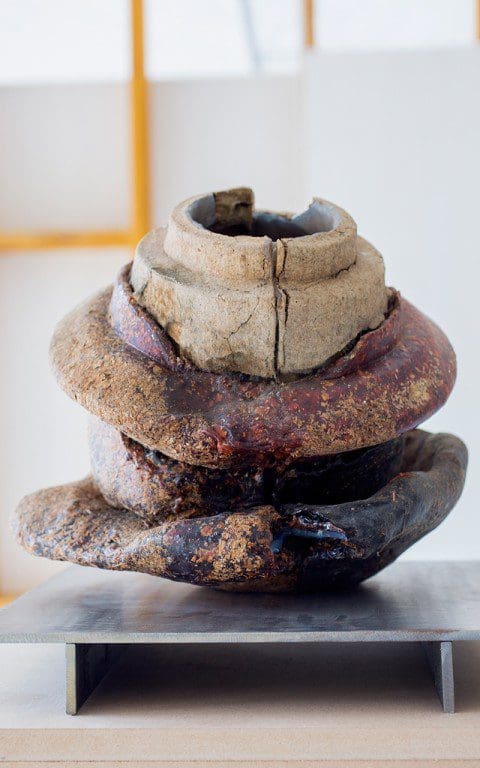 Perishable Vase II, decaying.
Perishable Vase II, decaying.
Tell me how this vase encapsulates those ideas and values.
We have so many things around us that we don’t really necessarily want to keep – we are stuck with their materiality – like a mobile phone case for example, which is useless after two years, but you are still stuck with the object. So I started thinking of how to make objects that aren’t permanent.
So you have a vase like this, which is made with organic binders, tree resins, shellac, beeswax, cooking flour, and dried flowers. This one (Perishable Vase III) is made with shellac, which is a natural resin excreted by beetles. I mix it with flowers, which I collect and dry and process and organise in ‘libraries’. Then I make this material and then I form it in moulds to create the vases. Because it is made from organic and natural materials the idea is that, if you don’t take care of it – for example if you put it outside – within a month it would just disappear. So there is this contrast where you create something which visually you might appreciate, but you have this back thought that it will disintegrate if you don’t take care of it. So I wanted to get people to think about objects by making something that is not permanent.
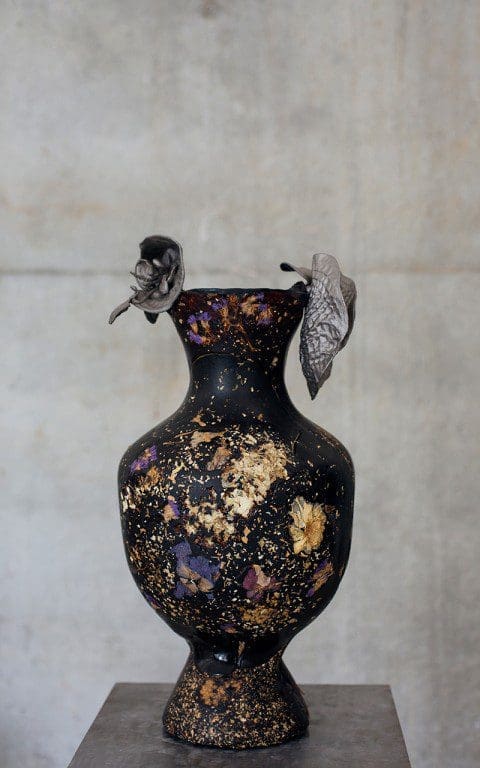 Perishable Vase III, 2015.
Perishable Vase III, 2015.
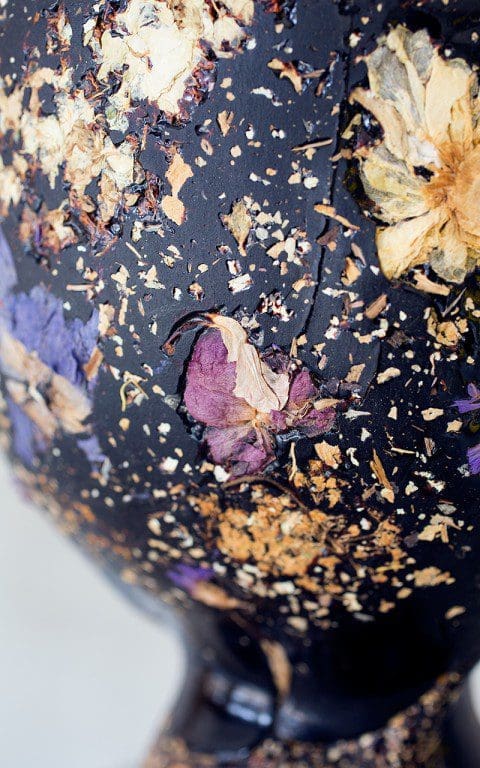 Perishable Vase III (detail).
Perishable Vase III (detail).
There’s also the idea that it is something you don’t have to have forever.
Yes. I wanted to make an inkjet printer with this technique – looking at the idea of planned obsolescence, where a printer is designed to print 5000 pages and then it breaks down and you have to buy a new one. So if you could use this material to make a printer body you could just dump it in your garden when it is finished with and it would rot. But this material is so far away technically from what you need from the body of a printer that I decided to create a more symbolic piece, which is a vase.
And then the investigation into nature is an extension of that, thinking of the process of aging, not necessarily actually disintegrating, because of course I do actually need to sell things, but I was really interested in creating a material that evolved, so that you don’t replace it, but you want to experience the change. In the way that brass or leather age and we appreciate it for what it is.
So I started working with this PhD research graduate from Kew, and we started injecting bacteria into flowers and casting them in resin. When resin cures it reaches very high temperatures, so the bacteria needed to be able to live without oxygen and at really high temperatures. So over time the bacteria destroy the flowers within the resin, but leave the form of the flower trapped in the resin. The idea was to create a material in which light would eventually replace the flowers within, like ghosts. I had this vision of this strong black resin and then light comes in and you only see the voids after the flowers have disappeared.
Then, instead of bacteria, I started using air, because air does a very similar thing. If you allow air into the resin then the flowers shrivel and die and gradually you see this halo of light around the structures. In the Flora Table you get this silvery effect. So the flowers don’t rot and go brown, they don’t disappear, they just start becoming silvery, with these voids of light around them. So a bit like a Flemish painting, but with the aging factor.
I was also interested in going back to this idea of natural decoration, how often we are inspired by nature to create decoration, but how rarely we use nature itself to create decoration.
I started casting the flowers in big blocks of resin and slicing them up and opening them almost like a cheese, and then misplacing the slices. Each of the slices in this screen comes from four different resin blocks of flowers. Sometimes I keep track of how I cut them when I reassemble them, other times they are arranged completely randomly.
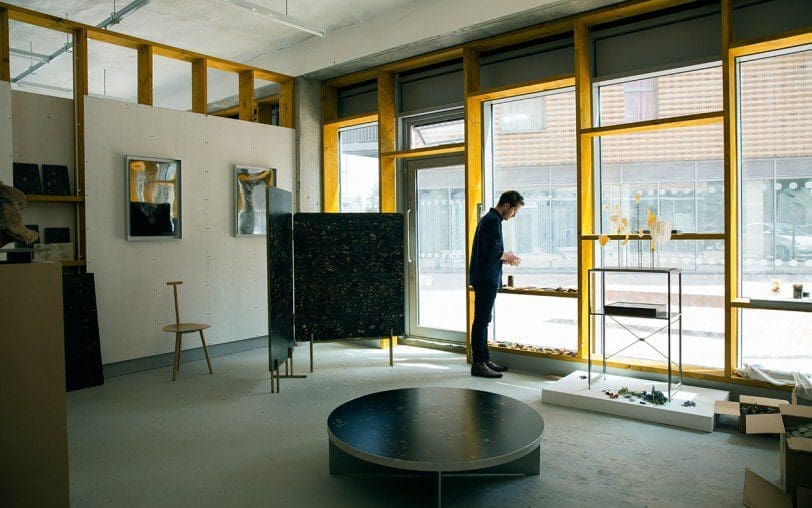 The Flora Screen can be seen behind Marcin in his new studio, a Flora Table is in the foreground.
The Flora Screen can be seen behind Marcin in his new studio, a Flora Table is in the foreground.
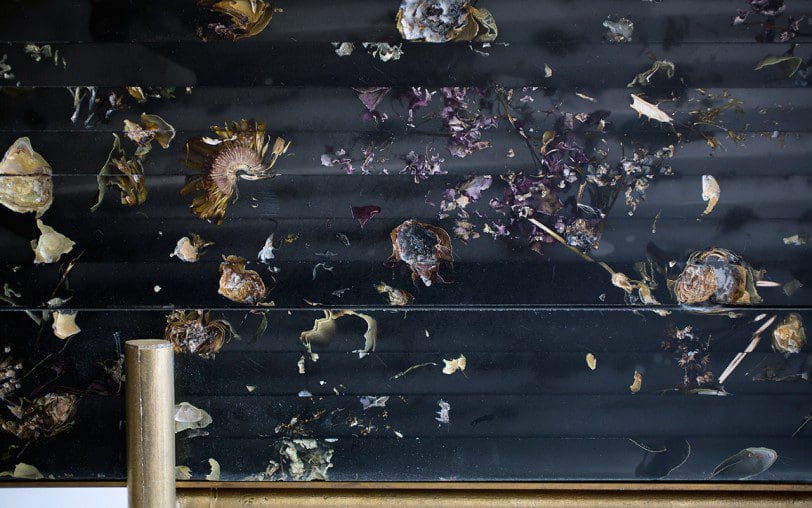 Flora Screen, 2015 (detail).
Flora Screen, 2015 (detail).
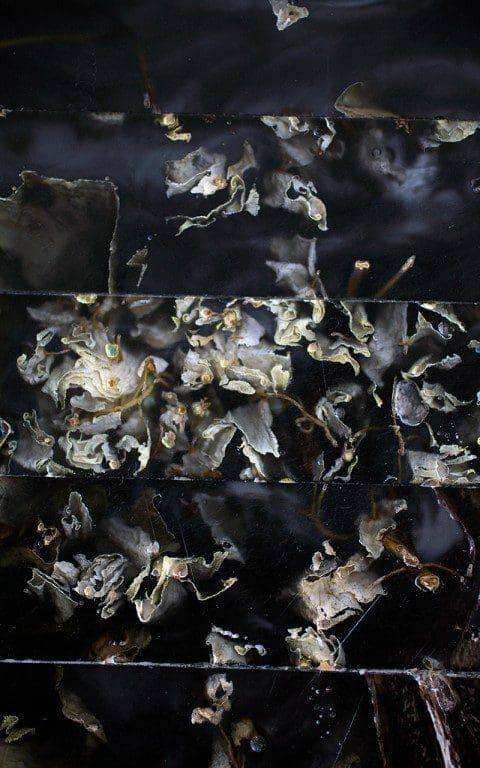 Flora Screen, 2015 (detail).
Flora Screen, 2015 (detail).
Do you fabricate all of these pieces yourself ?
I did! It was really hard work. I made these pieces for an exhibition last September, and I was late with everything. When you are coming up with a new material there is so much to learn through the process. You think you know and you keep learning. I am still learning so much from this material. I didn’t know so much about resin at the beginning, so I made these moulds and added too much catalyst, and the resin started bowing because it was shrinking too much, it was curing too quickly. So I had to do a good few runs of resin casting to get the result I wanted. Then there was so much work with cutting them and sanding and so on.
Now the process is much better. I have specialists that I go to with certain things, but I still do all the flower collection. Until recently I was also doing all the casts on my own, but because each object becomes bigger and bigger – right now I am working on a commission for a 2 metre long table – so the scale of the project requires other people, more pairs of hands. So I work with resin specialists, metal specialists. I am still very engaged with the work. With the resin casting I do all of the arrangement of the flowers. I do a few arrangements at the same time and then choose the one that I like the best. It’s a bit like painting. You choose them for their structure, but also for their colours, volumes, and then make these compositions. Once I am happy with a composition it goes in to be cast. Still during the casting there are so many things that can go differently.
I use a mix of both dried and fresh flowers. I have the size of the mould, so I know what my ‘canvas’ is, and I have all my plant libraries, which I take with me. I have times of the year when I collect a lot, and dry them and then have to keep them dry. When I need fresh flowers I get them when I need them. And then I arrange them and then there is the casting procedure.
It took me a year to get to the point where the flowers weren’t burnt or shrunk by the resin, nor for the flowers to affect the resin curing, because if you put moisture into the resin it prevents it from curing properly. It’s a very slow process and took a lot of development to get there, but I’m not going to give away my recipes!
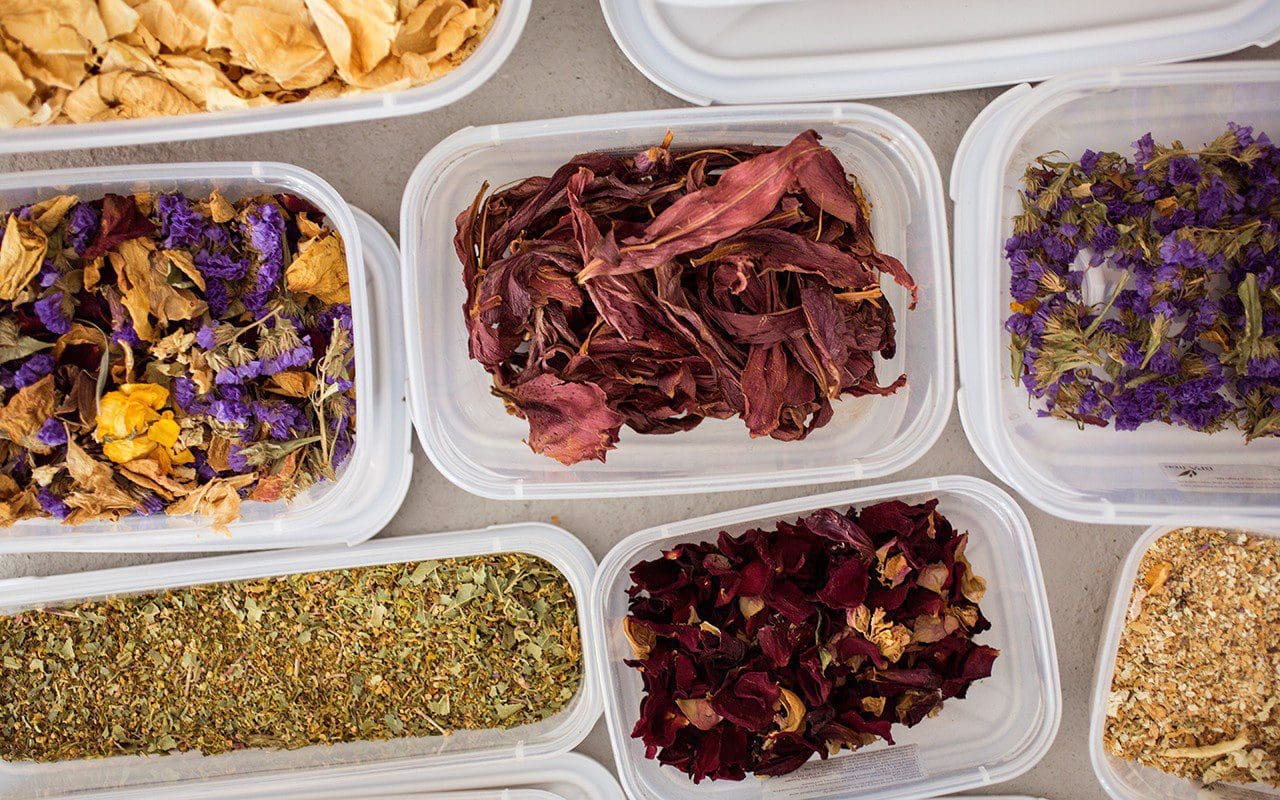
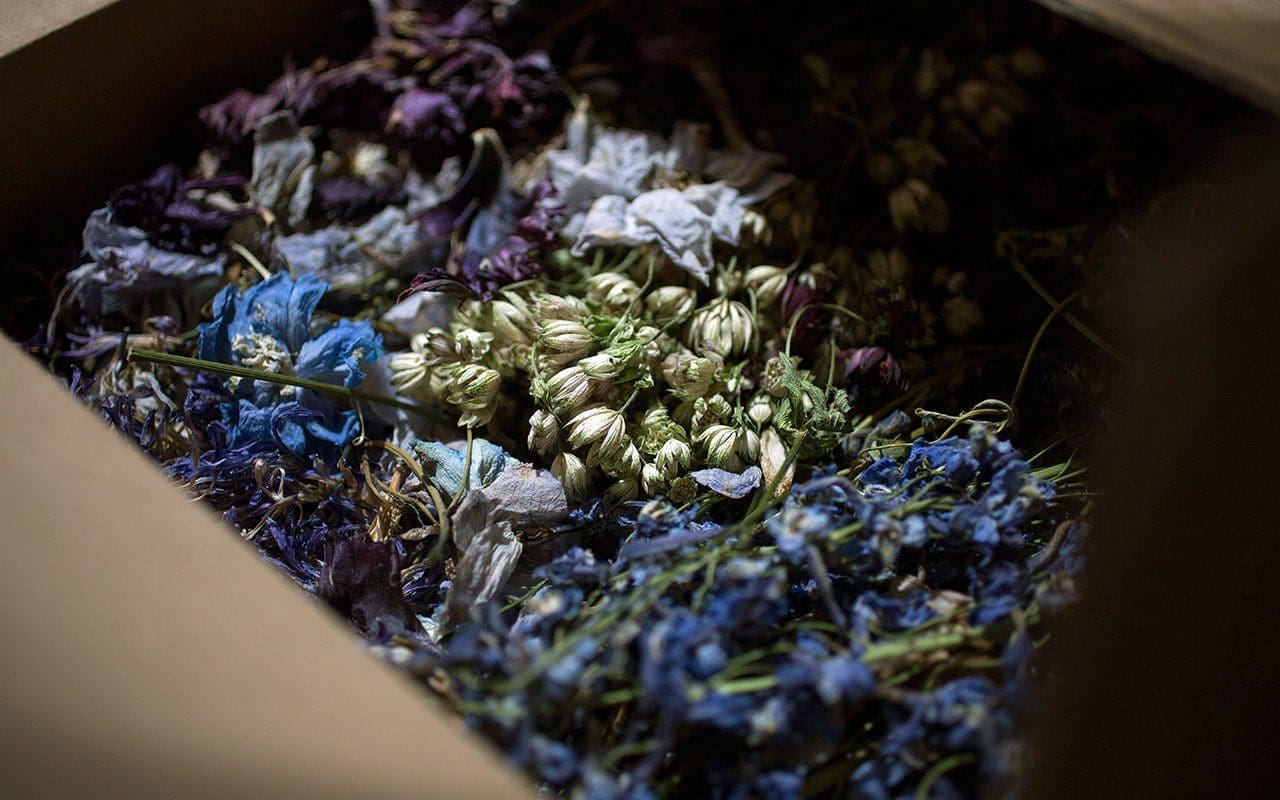 Some of Marcin’s dried flower libraries including lilies, roses, astrantia, delphinium, limonium and cornflower.
Some of Marcin’s dried flower libraries including lilies, roses, astrantia, delphinium, limonium and cornflower.
What is intriguing about your work is that it is clearly very complicated to produce and yet the pieces are very simple.
There is so much technicality that goes into it, and it requires a lot of specialists. It has also been a problem with my work that producing it was really expensive at the beginning when I was producing in a self-initiated way, rather than with commission-based work. And when you are a recent graduate you find it really hard to do, which is one of the reasons, to start with, I did everything myself.
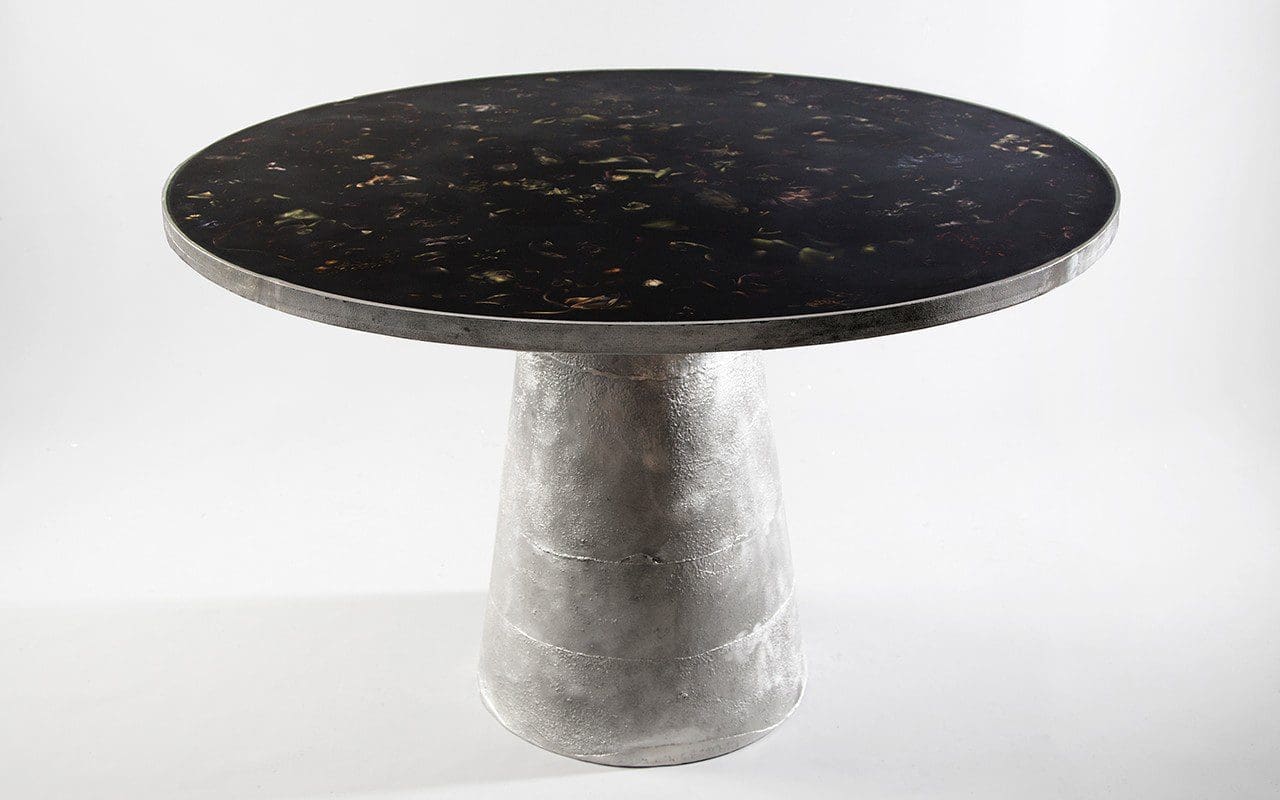 Flora Table, 2015. Photograph courtesy Marcin Rusak.
Flora Table, 2015. Photograph courtesy Marcin Rusak.
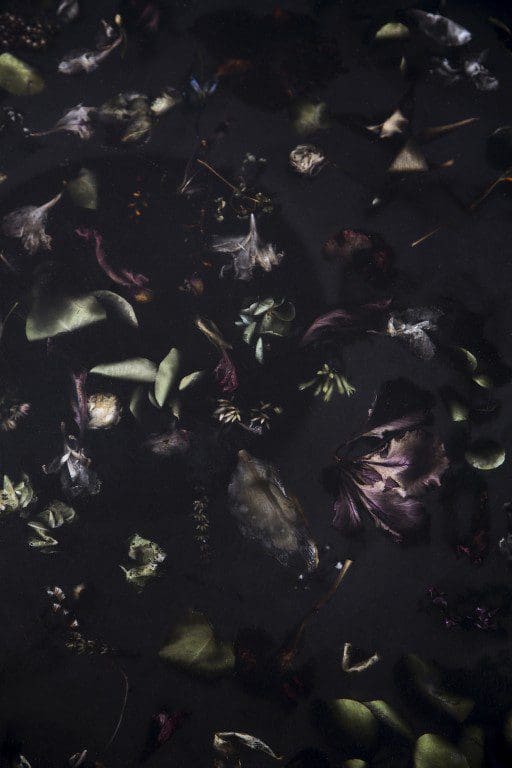 Flora Table (detail).
Flora Table (detail).
Are you primarily being commissioned to produce the furniture items at the moment ?
Yes. Actually creating the furniture work – the easiest to understand for people – has helped with the appreciation of my other work. People started getting the idea of the decaying vases much better and so I started getting commissions for these too, and now I am doing these resin pieces made in the same way as the screen, that are more like paintings. They will be framed and can also be used as wall panels. So half my work is commissioned work, and the other half is just me putting time and effort into investigating new things.
What are you working on right now ?
Right now I am working on a flower incubator. It comprises this desktop ‘machinery’ – all of the parts form a complicated system of water exchange, temperature control, hydroponic nutrition – designed to prolong the life of a cut flower to see how much longer we can possibly extend its life. So this is the opposite of the idea of constant disposable consumption. It is taking something that is already starting to decay and attempting to give it longevity.
The incubator is technically a very challenging project, and so I am having a lot of help with different specialists, so it is taking much longer than previous projects. Generally I have realised that I must take as much time as I need to develop what I want to do, rather than pushing things too quickly. It’s quite easy in this world to get trapped into working with other people’s deadlines, especially interior designers, as aesthetically the resin pieces are being seen as statement pieces for interiors. So currently I have quite a lot of enquiries from interior designers wanting to use these furniture pieces in their work.
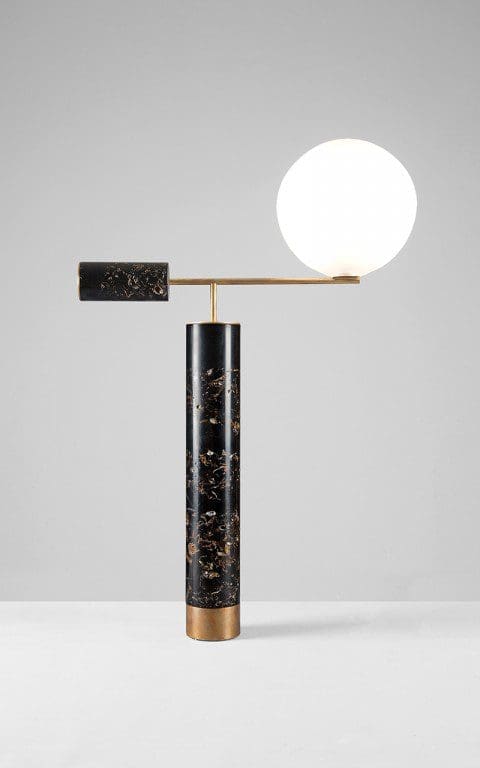 Flora Lamp, 2015. Photograph courtesy Marcin Rusak.
Flora Lamp, 2015. Photograph courtesy Marcin Rusak.
How do you manage that in terms of how people perceive your work ?
I am only just starting to realise that there are these differences between, say, the interiors world and the art world. When I started, for me it was all the same, I didn’t really know. Because I’m so interested in the idea and what these pieces are conceptually the selling outcome was something far from my mind. Now I am starting to distinguish how much work and commitment actually goes into creating a working piece of furniture. The resin material gives them an added value, but what I am most interested in is creating the value in the material itself – by the fact that it ages, or is not permanent.
So I am trying to shift my practice right now into this world where the pieces are appreciated for the conceptual idea. I spend quite a lot of time going out and talking to people, giving talks, to explain the work, because if you put a vase like this on a plinth and you just leave it as it is without a label people just say, ‘Yeah, it’s a vase.’, but if you give the story of why it was made and what it’s going to do in a couple of years they really perceive it differently. So the longer I am working the easier it is to make the work because people already understand it. At the beginning it was really hard to come up with the idea and have people understand it. The furniture pieces give people an easier point of entry, as people like them first for their visual aesthetics, and then when they get deeper they realise that there is this whole body of work. Of course, aesthetics are a very important part of my work. Not as the ultimate outcome, but more as the result of an investigation into aesthetics, either through making natural decoration or the aesthetics of things that decay and don’t last. I think aesthetics are incredibly important and we should never forget about them, but they are never the primary goal in my work.
So where do you see your work going ?
There are still two paths currently. One where it is more applied fine arts, and the other is me investigating this idea of impermanent things. I’m in a group show in September. I’m doing more of the vases for the show. And I’m thinking of making a decaying glasshouse where the front of it is so fine that it just disappears. That’s something that really stimulates me and gives me energy to work.
It’s also a lot about grabbing from the pool of inspiration from the past and mixing it with everything I am doing right now, like the story of flowers and the consumption aspect. One feeds the other, and then they start to feed themselves. So I guess I’ll see where that goes, but I’m really about thinking through making, so I have to be making to come up with things. It’s never just me thinking about making something and then doing it, they are all an outcome out of the past research, my palette of tools and materials, and you go with all of them until something starts getting somewhere and then you pick the ones that go somewhere and start working on developing them further. I’m excited to see where it’s going to go. I’m working on having a different creative head space where it’s all about making, so just letting myself make mistakes and experimenting.
Nowadays we are so keen to have ‘new, new, more, more’ all the time, I am trying not to get trapped in this way of thinking and take time to actually develop these approaches I have started as far as possible. My practice is also a lot about people being able to come and see the pieces, so I am really happy to now have a space where I can meet people and show them the work and explain the ideas. For it is one thing to see an image on the internet, but quite another to come and talk to me about where it’s coming from, and also the possibilities of what I can make for them.
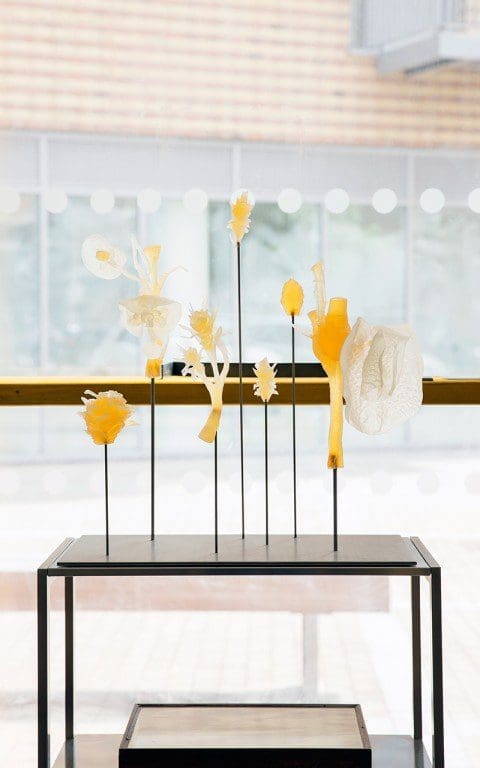 Flower Entomology, 2015.
Flower Entomology, 2015.
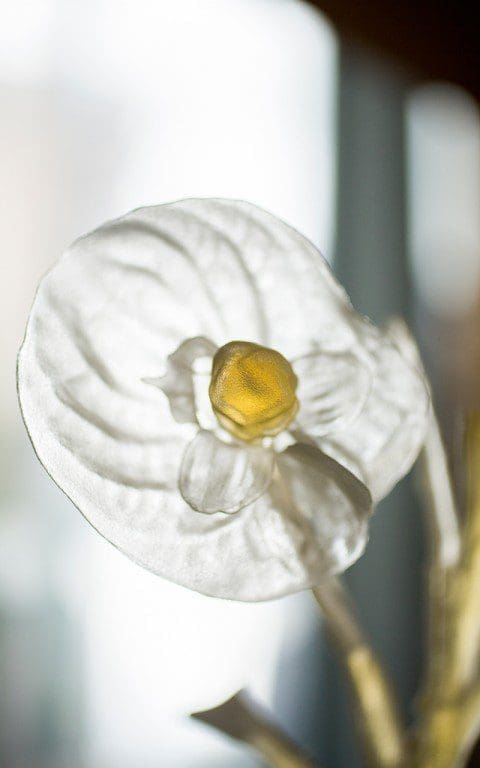 Flower Entomology (detail).
Flower Entomology (detail).
Can you tell me about your relationship to nature, gardens and flowers ?
I would say that it keeps coming more and more. I started off as a blank page where I was interested in other things, but the more I work with these objects the more I appreciate nature. I have started thinking about flowers very differently. I don’t have this need to have them around me so much, as I look at them as a kind of material, and I see so much waste that it terrifies me to even think about going to buy more of them, and I don’t have a place where I can grow them as I live in central London.
Strangely plants have become a lot more intriguing to me, also because of my investigations and my talks with plant geneticists, but on just a very personal basis they have become much more, I would say, friends, where they are just this amazing source of nature you can hold in your hand. My room-mate shares the same idea and we now have more plants in our flat than I think we do cups ! It makes home so much more relaxing, especially in London.
And if you think that my past was in this 2 acre central Warsaw garden – because not only did we have the glasshouses, we also had a very particular garden, because my grandfather grew not only flowers, but all the garden plants as well. Then I lived first in the Netherlands, a small city with not all that much nature around, and now I am in London, and I am missing it a lot, which is why I have this desire to go and be in nature every now and then.
My sister and I have also just started a business together around flowers, doing artistic flower installations in Warsaw, because first of all it’s something that she is really into – it is in her DNA, she was never trained – but she just makes these amazing compositions and arrangements, and there is a big niche there for that there, as all the florists are doing the same kind of thing. No one is really thinking of flowers in terms of them being local or seasonal, or in working on the composition almost as a sculpture or painting. We’re using the same name as my grandma used to call her flower shops, which is MÁK, which means poppy seed in Polish. We only started about 4 months ago and so I am travelling to Warsaw a lot more at the moment, because we are doing this together, as she’s very young, she’s 25, so I am trying to support her, but she is the main engine and inspiration, she does all of the compositions herself. And she dries flowers for me too. She uses lots of flowers in her installations and everything that comes back to her is being dried and re-used in my work.
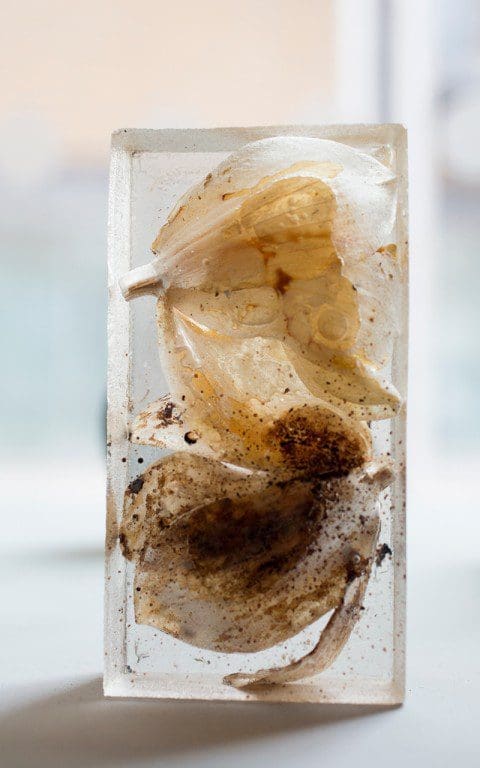 Resin and flower sample, 2015.
Resin and flower sample, 2015.
What would your grandfather think ?
I’m really curious. He was a very complicated man with a very complicated way of connecting with his family so I didn’t really know him that well, but I think he would be secretly really intrigued and interested. I sometimes wonder what it would be like if I could go home and talk to him about these things and get his knowledge. My sister is always seeking knowledge about plants and my mum tries to give us as much of her knowledge as she can, but I think my grandfather would be an amazing source. Lately I have been digging through all the family archives and going through everything, because I have been trying to find a book of his – you know when you are a grower and you discover and record things for yourself ? – so I’m trying to find these transcriptions of what he was doing.
We had four or five really big glasshouses, and it was funny as it was in central Warsaw and he sold it to a development company, who took down the glasshouses, but they promised to keep the garden, because that was his condition. But they tricked him and they took it all down and built these big buildings and only kept a tiny bit of the garden. It was really sad, but we managed to rescue all these massive trees, and they were transported to my parents house on these huge trucks. They had to wait to build the house until the trees had been planted first.
Your work straddles worlds of art, craft and design. How do you classify it ?
With the craft, I think I was kind of put there more than it was a conscious decision on my part. But it’s so close to everything. It’s hard to even name it for myself. Like, when people ask me, “So, what do you do?” I seriously have problems answering this question. And it’s not because I’m trying to be so ‘artist’ about it. It’s just, how do you explain that it could be objects that don’t last, or it could be research in the Netherlands, or it could be investigating an actual decoration and making these resin pieces, or it could be ephemeral textiles ?
It is hard these days to say what it is. I don’t feel the need, or able, to classify it. It is what it is. It is other people who need it to be classified. That is fine with people who are open, and who are prepared to listen to me explain the ideas behind it, but closed people find it harder to grasp the idea of buying something that is ephemeral. It’s hard for some people to see value in something unless everyone else does. Some people at the design fairs have said that my work shouldn’t be categorised as design, but really that is just a tag for it. How people see it is how they see it.
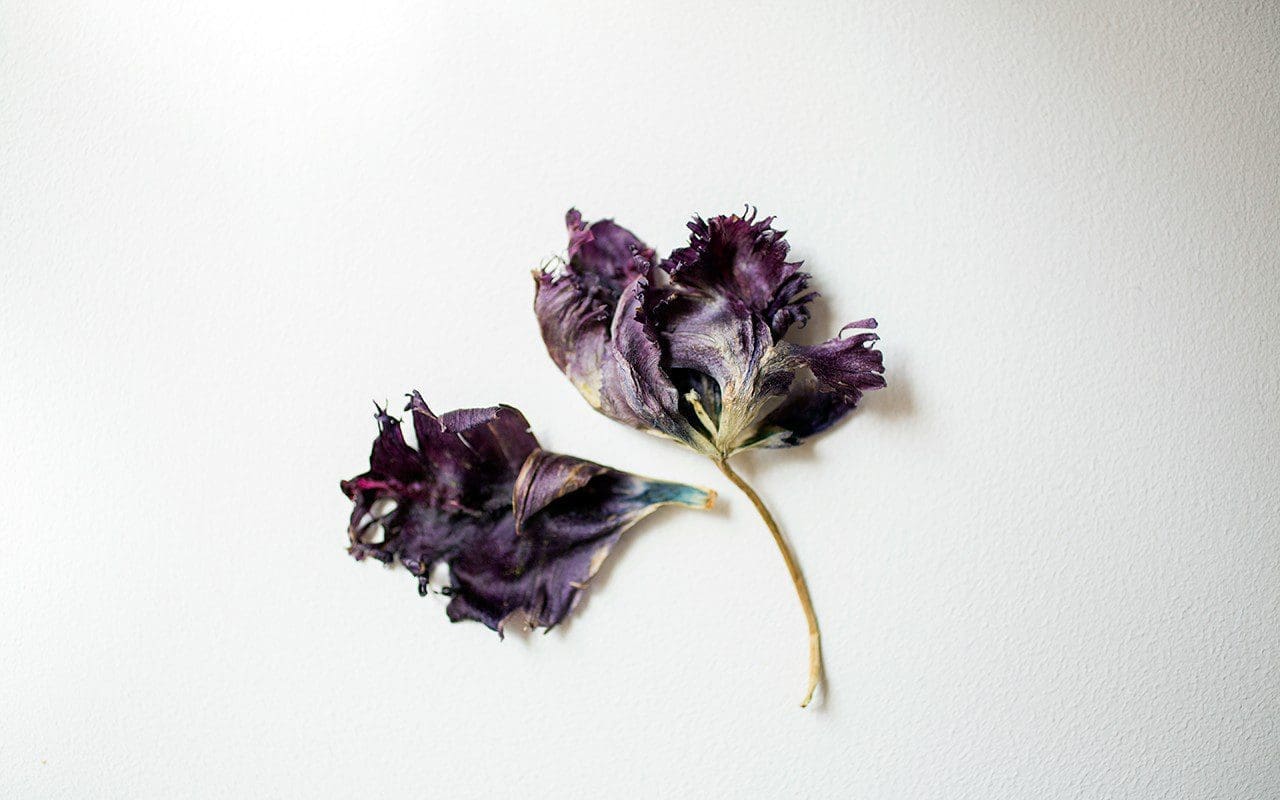
Interview: Huw Morgan / All other photographs: Emli Bendixen
We are sorry but the page you are looking for does not exist. You could return to the homepage